IEI Integration ICEFIRE-T10A TABLET PC User Manual ICEFIRE T10A UMN v1 01 20120210 4 del WWAN
IEI Integration Corp. TABLET PC ICEFIRE T10A UMN v1 01 20120210 4 del WWAN
User Manual
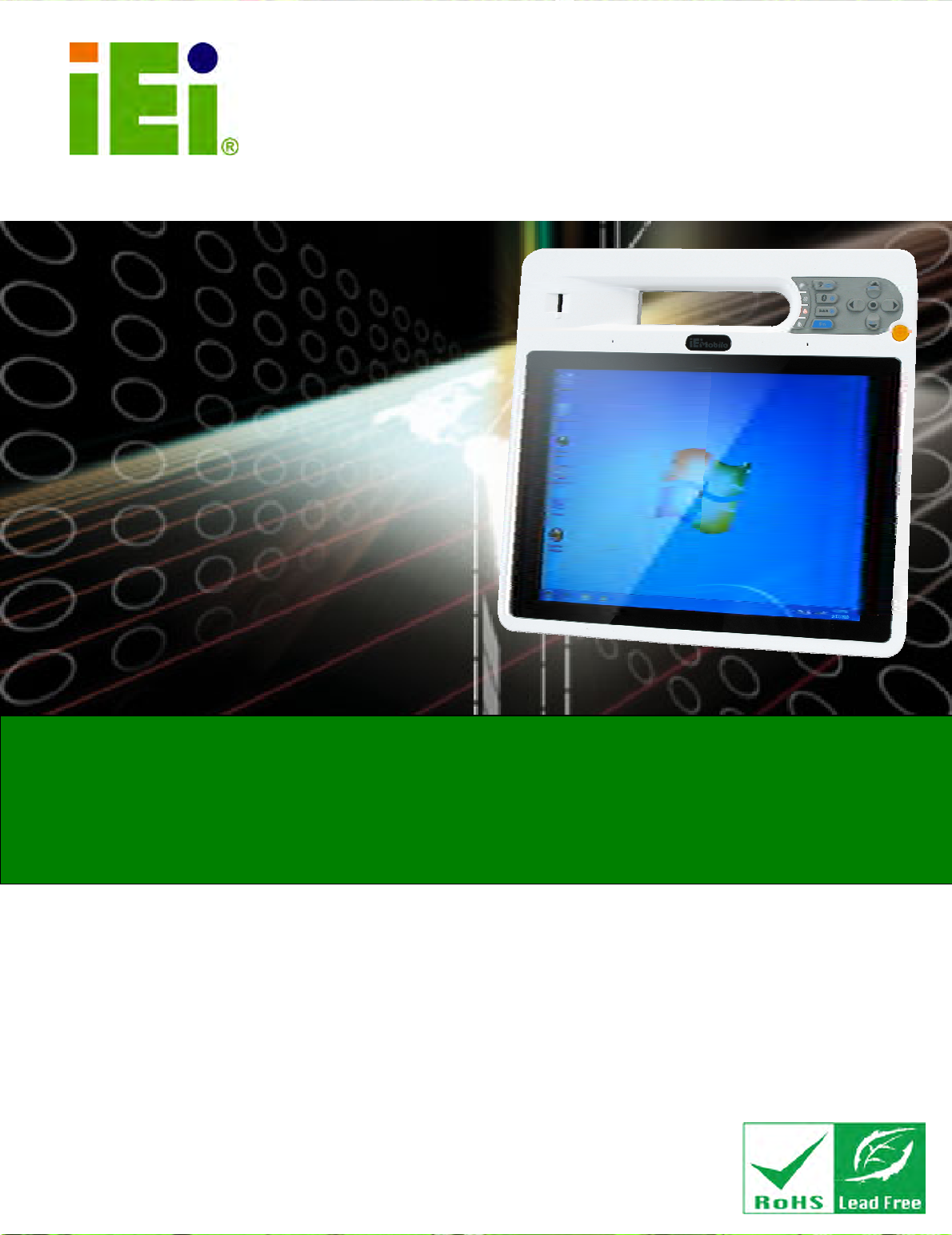
ICEFIRE-T10A Mobile Clinic Assistant
Page i
IEI Technology Corp.
User Manual
10.4
”
Mobile Clinic Assistant with
Intel
®
Atom
™
™™
™
D525
CPU
,
2 GB DDR3 SDRAM, 802.11a/b/g/n Wireless, Bluetooth,
LAN, USB, Barcode scanner, Fingerprint Reader
RoHS Compliant, IP64 Compliant Front Panel
Rev. 1.01 – 12 April, 2012
MODEL:
ICEFIRE-T10A
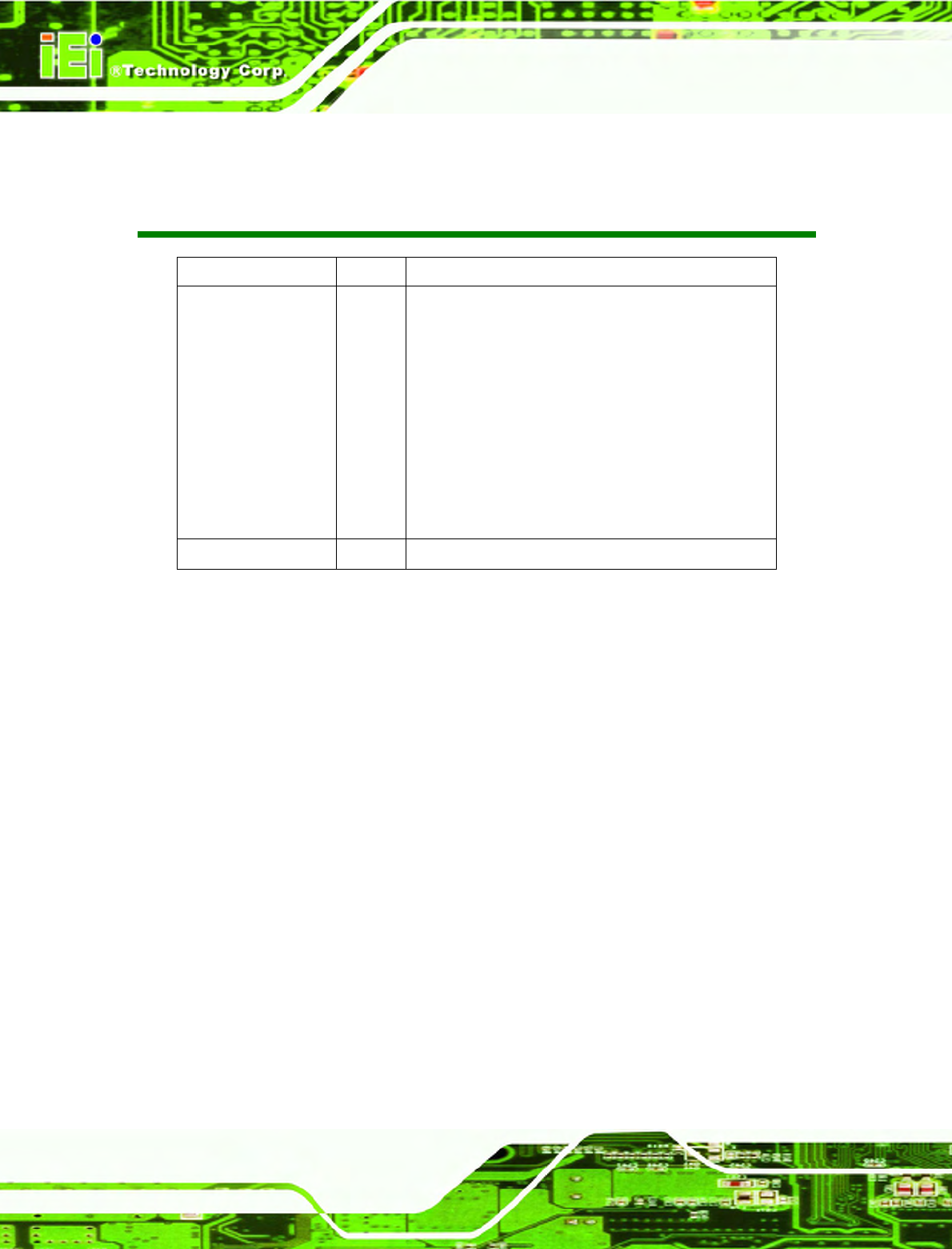
ICEFIRE-T10A Mobile Clinic Assistant
Page ii
Revision
Date Version
Changes
12 April, 2012 1.01 Added Section
252H
3.4:
253H
Smart Card Reader Installation
(Optional)
Added Section 3.7: Using RFID Reader
Added Section 3.8: Using Barcode Scanner
Added Chapter
254H
5:
255H
ICEFIRE Control Center
Modified
256H
Table 1-1: Model Variations
Modified Section 3.3:
257H
Mounting the System (Optional)
Modified
258H
Figure 3-18: Docking Station I/O Connectors
Updated Chapter 6: BIOS Setup
19 January, 2011 1.00 Initial release
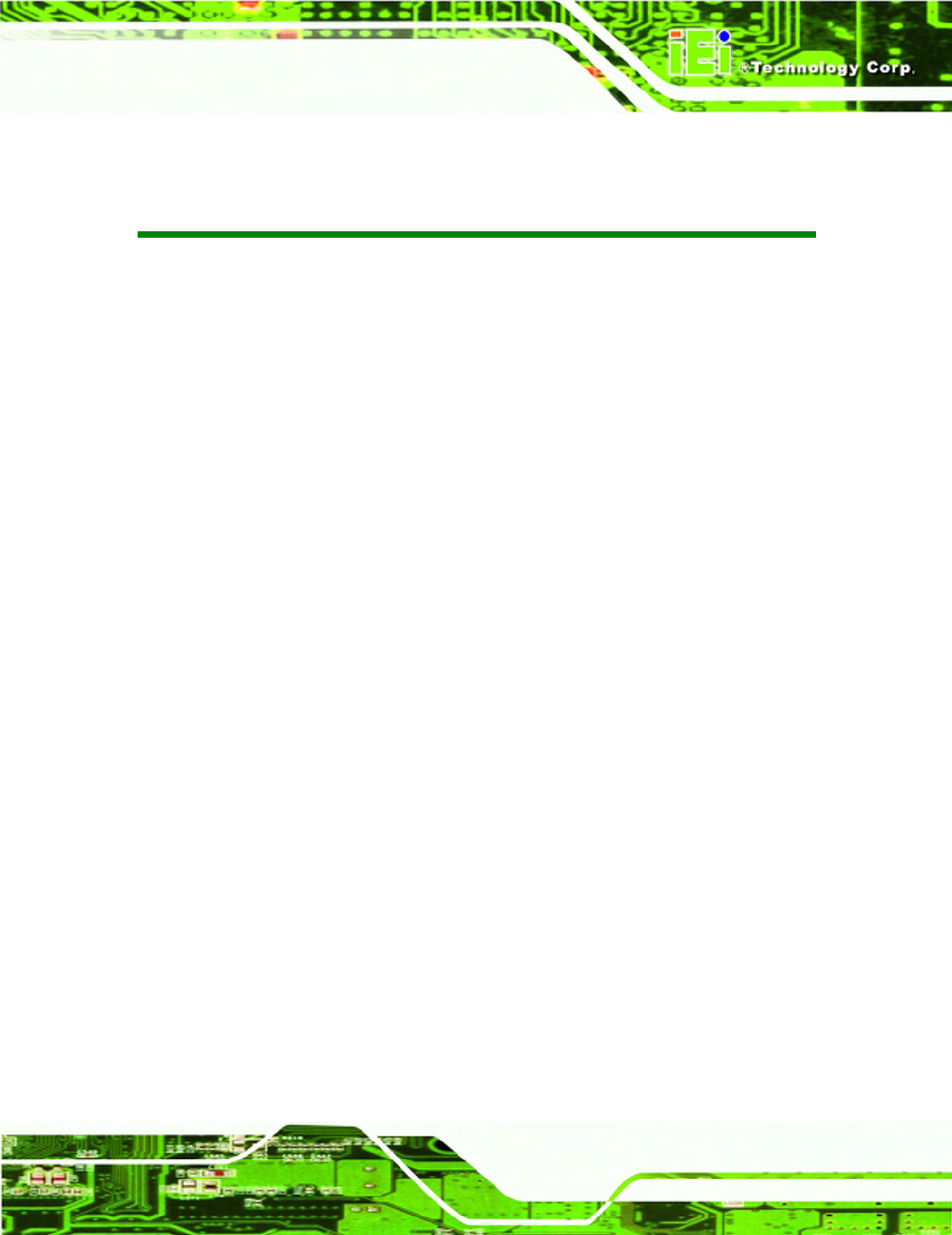
ICEFIRE-T10A Mobile Clinic Assistant
Page iii
Copyright
COPYRIGHT NOTICE
In no event will the manufacturer be liable for direct, indirect, special, incidental, or
consequential damages arising out of the use or inability to use the product or
documentation, even if advised of the possibility of such damages.
This document contains proprietary information protected by copyright. All rights are
reserved. No part of this manual may be reproduced by any mechanical, electronic, or
other means in any form without prior written permission of the manufacturer.
TRADEMARKS
All registered trademarks and product names mentioned herein are used for identification
purposes only and may be trademarks and/or registered trademarks of their respective
owners.
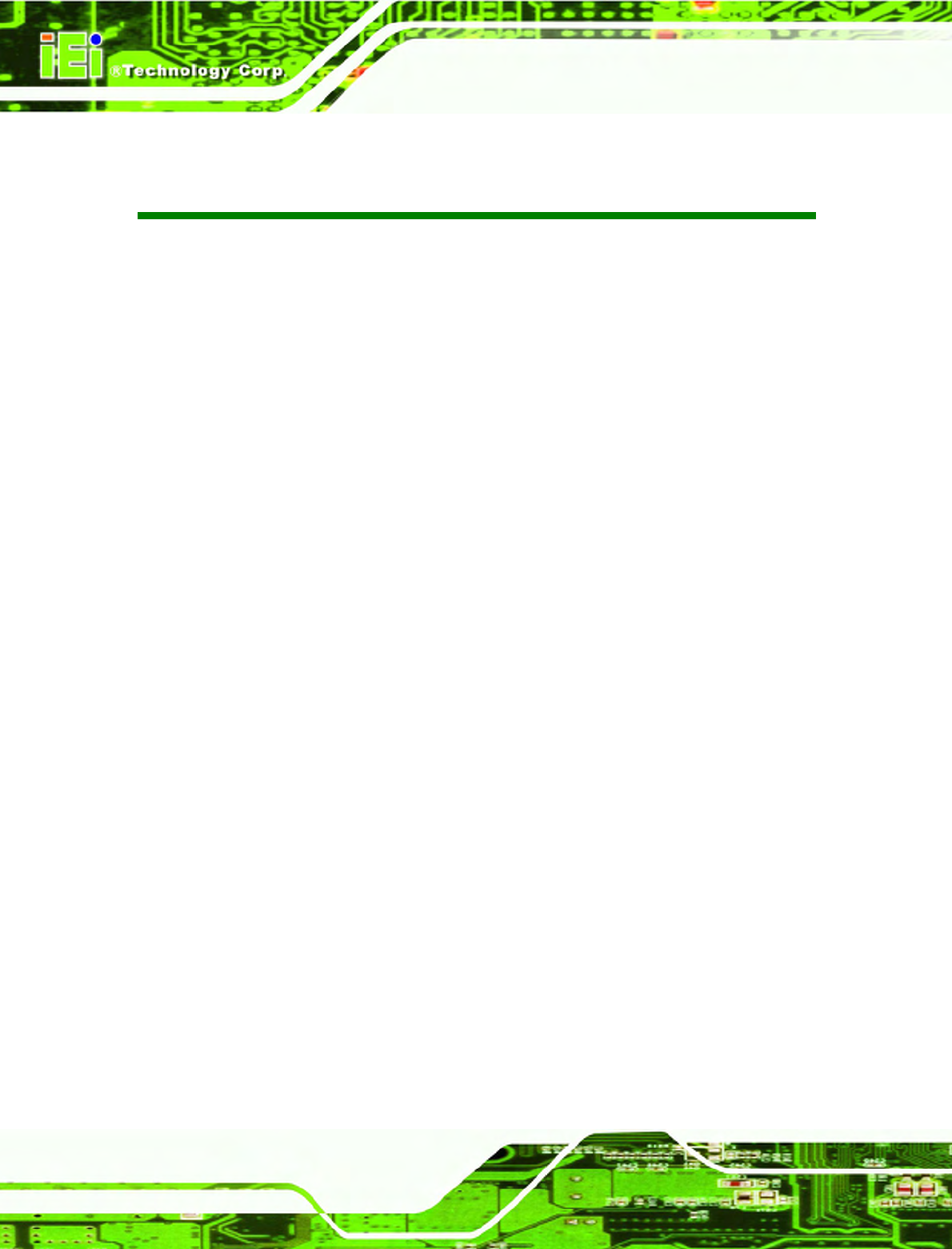
ICEFIRE-T10A Mobile Clinic Assistant
Page iv
Table of Contents
1 INTRODUCTION .......................................................................................................... 1
1.1
O
VERVIEW
.................................................................................................................. 2
1.2
F
EATURES
................................................................................................................... 3
1.3
M
ODEL
V
ARIATIONS
................................................................................................... 3
1.4
F
RONT
P
ANEL
............................................................................................................. 4
1.4.1 Buttons and Indicators ....................................................................................... 4
1.5
R
EAR
P
ANEL
............................................................................................................... 6
1.6
S
IDE
P
ANELS
.............................................................................................................. 6
1.7
T
OP
P
ANEL
................................................................................................................. 7
1.8
B
OTTOM
P
ANEL
.......................................................................................................... 7
1.9
T
ECHNICAL
S
PECIFICATIONS
...................................................................................... 8
1.10
D
IMENSIONS
............................................................................................................ 11
2 UNPACKING ............................................................................................................... 12
2.1
U
NPACK THE
T
ABLET
PC .......................................................................................... 13
2.2
P
ACKING
L
IST
........................................................................................................... 14
3 HARDWARE INSTALLATION ................................................................................. 16
3.1
B
ATTERY
I
NSTALLATION
........................................................................................... 17
3.1.1 Charge the Battery ........................................................................................... 19
3.1.1.1 Through the ICEFIRE-T10A .................................................................... 19
3.1.1.2 Through Optional Docking Station ........................................................... 20
3.3
M
OUNTING THE
S
YSTEM
(O
PTIONAL
) ...................................................................... 21
3.3.1 Docking Station ................................................................................................ 21
3.3.2 Mounting with Docking Station ....................................................................... 23
3.4
I/O
C
ONNECTORS
..................................................................................................... 24
3.4.1 LAN Connection ............................................................................................... 24
3.4.2 USB Device Connection ................................................................................... 24
3.5
S
MART
C
ARD
R
EADER
I
NSTALLATION
(O
PTIONAL
) .................................................. 25
3.6
D
OCKING
S
TATION
I/O
C
ONNECTORS
(O
PTIONAL
) ................................................... 29
3.6.1 Serial Device Connection ................................................................................ 29
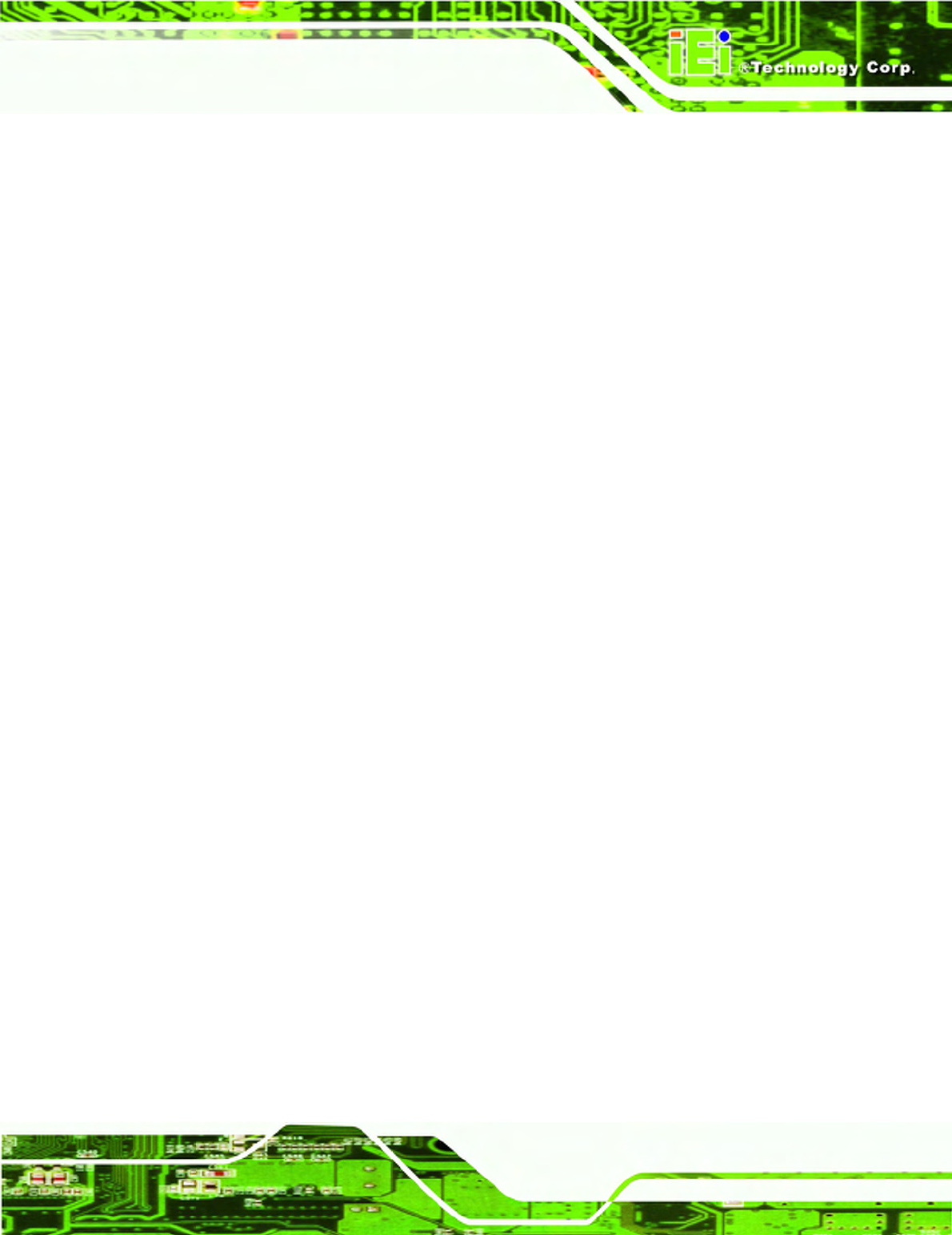
ICEFIRE-T10A Mobile Clinic Assistant
Page v
3.6.1.1 RS-232 Serial Port Pinouts ....................................................................... 30
3.6.2 VGA Monitor Connection ................................................................................ 31
3.7
P
OWER
-
UP THE
S
YSTEM
........................................................................................... 32
3.8
U
SING
RFID
R
EADER
............................................................................................... 33
3.9
U
SING
B
ARCODE
S
CANNER
...................................................................................... 36
3.9.1 Barcode Setting ................................................................................................ 39
4 DRIVER INSTALLATION ......................................................................................... 44
4.1
A
VAILABLE
S
OFTWARE
D
RIVERS
.............................................................................. 45
4.2
I
NTEL
®
G
RAPHICS
D
RIVER
...................................................................................... 45
4.3
R
EALTEK
LAN
D
RIVER
............................................................................................ 47
4.5
S
PEAKER AND
M
ICROPHONE
D
RIVER
....................................................................... 48
4.6
F
INGERPRINT
R
EADER
D
RIVER
................................................................................. 50
4.7
B
ARCODE
S
CANNER
D
RIVER
.................................................................................... 51
4.8
B
LUETOOTH
D
RIVER
................................................................................................ 52
5 ICEFIRE CONTROL CENTER ................................................................................ 54
5.1
G
ETTING
S
TARTED
................................................................................................... 55
5.2
F
EATURES
................................................................................................................. 55
5.3
M
ODULE
S
TATUS
...................................................................................................... 56
5.4
C
ALIBRATION
........................................................................................................... 57
5.5
P
ROGRAMMABLE
B
UTTONS
...................................................................................... 59
5.5.1 Action: Open Process ....................................................................................... 61
5.5.2 Action: Windows Key Action ............................................................................ 62
6 BIOS SETUP ................................................................................................................ 63
6.1
I
NTRODUCTION
......................................................................................................... 64
6.1.1 Starting Setup ................................................................................................... 64
6.1.2 Using Setup ...................................................................................................... 64
6.1.3 Getting Help ..................................................................................................... 65
6.1.4 BIOS Menu Bar ................................................................................................ 65
6.2
M
AIN
........................................................................................................................ 66
6.3
A
DVANCED
............................................................................................................... 67
6.3.1 CPU Configuration .......................................................................................... 67
6.3.2 SATA Configuration ......................................................................................... 69
6.3.3 USB Configuration ........................................................................................... 70
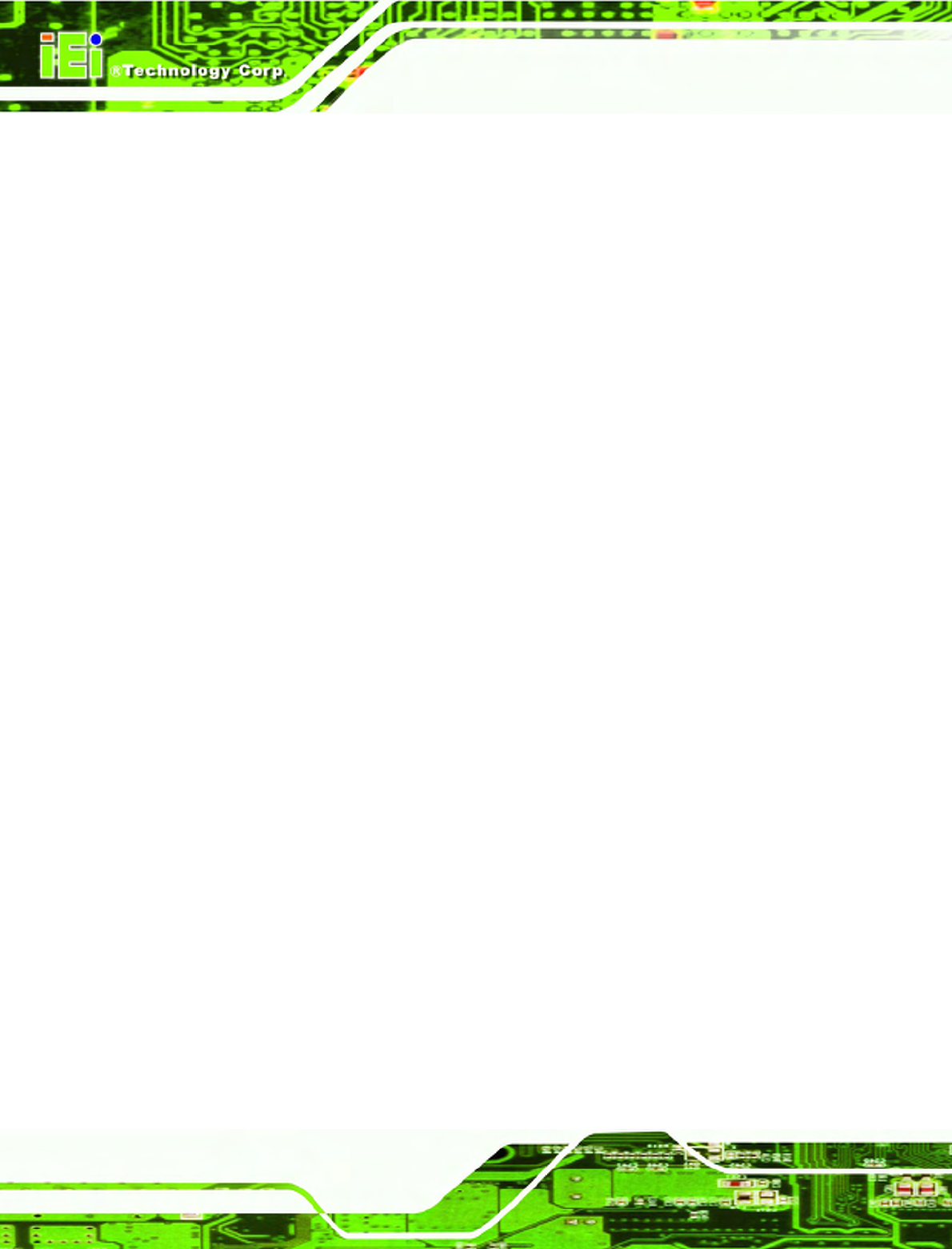
ICEFIRE-T10A Mobile Clinic Assistant
Page vi
6.3.4 H/W Monitor .................................................................................................... 71
6.3.4.1 System FAN1 Configuration ..................................................................... 72
6.3.5 IEI Feature ....................................................................................................... 74
6.4
C
HIPSET
................................................................................................................... 75
6.4.1 Host Bridge Configuration .............................................................................. 76
6.4.2 South Bridge Configuration ............................................................................. 77
6.4.3 Intel IGD SWSCI OpRegion ............................................................................. 78
6.5
B
OOT
........................................................................................................................ 80
6.6
S
ECURITY
................................................................................................................. 81
6.7
E
XIT
......................................................................................................................... 82
7 SYSTEM MAINTENANCE ....................................................................................... 84
7.1
S
YSTEM
M
AINTENANCE
I
NTRODUCTION
.................................................................. 85
7.2
M
OTHERBOARD
R
EPLACEMENT
............................................................................... 85
A SAFETY PRECAUTIONS ......................................................................................... 86
A.1
S
AFETY
P
RECAUTIONS
............................................................................................ 87
A.1.1 General Safety Precautions ............................................................................. 87
A.1.2 Anti-static Precautions .................................................................................... 88
A.1.3 Product Disposal ............................................................................................. 89
A.2
M
AINTENANCE AND
C
LEANING
P
RECAUTIONS
........................................................ 89
A.2.1 Maintenance and Cleaning .............................................................................. 89
A.2.2 Cleaning Tools ................................................................................................. 90
B ONE KEY RECOVERY ............................................................................................. 91
B.1
O
NE
K
EY
R
ECOVERY
I
NTRODUCTION
...................................................................... 92
B.1.1 System Requirement ......................................................................................... 93
B.1.2 Supported Operating System ........................................................................... 94
B.2
S
ETUP
P
ROCEDURE FOR
W
INDOWS
.......................................................................... 95
B.2.1 Hardware and BIOS Setup .............................................................................. 95
B.2.2 Create Partitions ............................................................................................. 96
B.2.3 Install Operating System, Drivers and Applications ....................................... 99
B.2.4 Build-up Recovery Partition .......................................................................... 100
B.2.5 Create Factory Default Image ....................................................................... 102
B.3
S
ETUP
P
ROCEDURE FOR
L
INUX
.............................................................................. 107
B.4
R
ECOVERY
T
OOL
F
UNCTIONS
................................................................................. 110
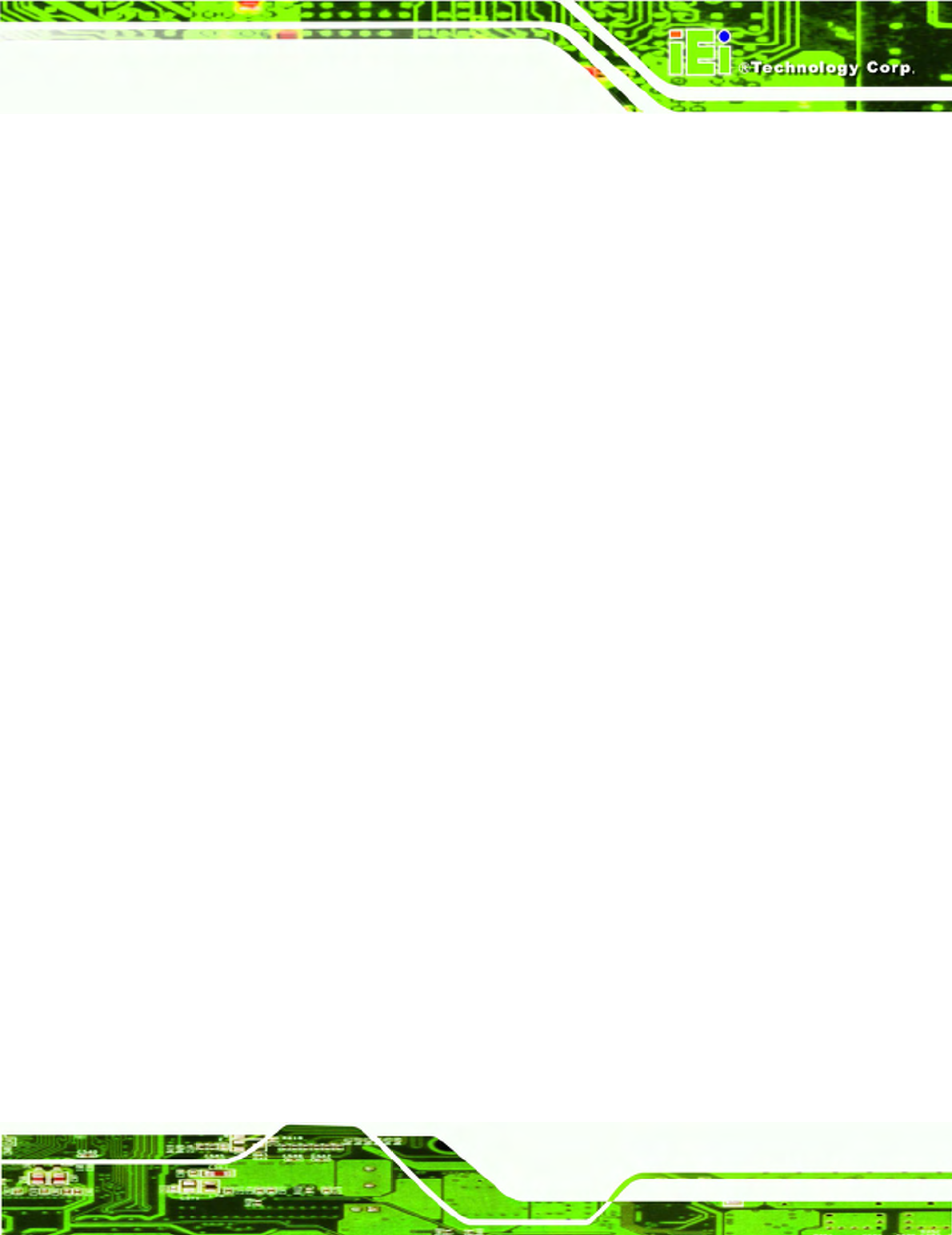
ICEFIRE-T10A Mobile Clinic Assistant
Page vii
B.4.1 Factory Restore .............................................................................................. 112
B.4.2 Backup System ................................................................................................ 113
B.4.3 Restore Your Last Backup ............................................................................... 114
B.4.4 Manual ............................................................................................................ 115
B.5
O
THER
I
NFORMATION
............................................................................................. 116
B.5.1 Using AHCI Mode or ALi M5283 / VIA VT6421A Controller ........................ 116
B.5.2 System Memory Requirement ......................................................................... 118
C BIOS OPTIONS ......................................................................................................... 119
D TERMINOLOGY ..................................................................................................... 122
E WATCHDOG TIMER ............................................................................................... 126
F HAZARDOUS MATERIALS DISCLOSURE ........................................................ 129
F.1
H
AZARDOUS
M
ATERIALS
D
ISCLOSURE
T
ABLE
FOR
IPB
P
RODUCTS
C
ERTIFIED AS
R
O
HS
C
OMPLIANT
U
NDER
2002/95/EC
W
ITHOUT
M
ERCURY
..................................... 130
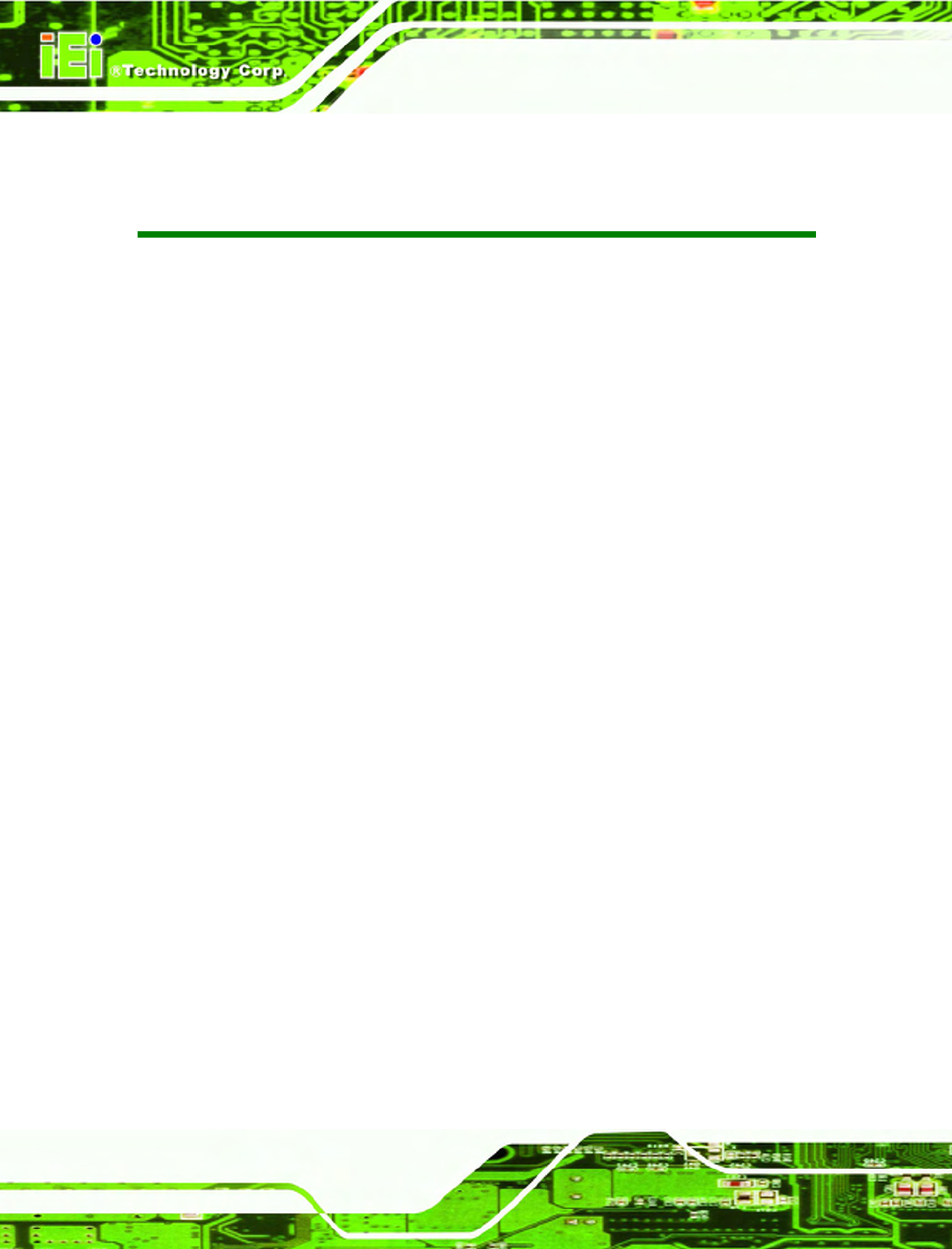
ICEFIRE-T10A Mobile Clinic Assistant
Page viii
List of Figures
Figure 1-1: ICEFIRE-T10A ......................................................................................................... 2
Figure 1-2: Front Panel ............................................................................................................. 4
Figure 1-3: Front Panel Buttons and Indicators ....................................................................... 4
Figure 1-4: Rear Panel ............................................................................................................... 6
Figure 1-5: Side Panels ............................................................................................................. 6
Figure 1-6: Top Panel ................................................................................................................ 7
Figure 1-7: Bottom Panel .......................................................................................................... 7
Figure 1-8: Dimensions (units in mm) .................................................................................... 11
Figure 3-1: Release Battery Latches ...................................................................................... 17
Figure 3-2: Battery Installation ............................................................................................... 18
Figure 3-3: Lock the Battery ................................................................................................... 18
Figure 3-4: Battery Capacity Indicators .................................................................................. 19
Figure 3-5: Windows 7 Power Management Screen .............................................................. 20
Figure 3-6: Insert Batteries to Docking Station ...................................................................... 21
Figure 3-7: Release the Stand ................................................................................................. 22
Figure 3-8: Lock the Stand ...................................................................................................... 22
Figure 3-9: Place the ICEFIRE-T10A to the Docking Station ................................................. 23
Figure 3-10: VESA Mounting Retention Screw Holes ............................................................ 23
Figure 3-11: LAN Connection ................................................................................................. 24
Figure 3-12: USB Device Connection ..................................................................................... 25
Figure 3-13: Smart Card Reader Installation .......................................................................... 26
Figure 3-14: Smart Card Reader Setting 1 .............................................................................. 26
Figure 3-15: Smart Card Reader Setting 2 .............................................................................. 27
Figure 3-16: Smart Card Reader Setting 3 .............................................................................. 27
Figure 3-17: Smart Card Reader Setting 4 .............................................................................. 28
Figure 3-18: Docking Station I/O Connectors ........................................................................ 29
Figure 3-19: Serial Device Connector ..................................................................................... 30
Figure 3-20: Serial Port Pinouts .............................................................................................. 30
Figure 3-21: VGA Connector ................................................................................................... 31
Figure 3-22: Power-up the System ......................................................................................... 32
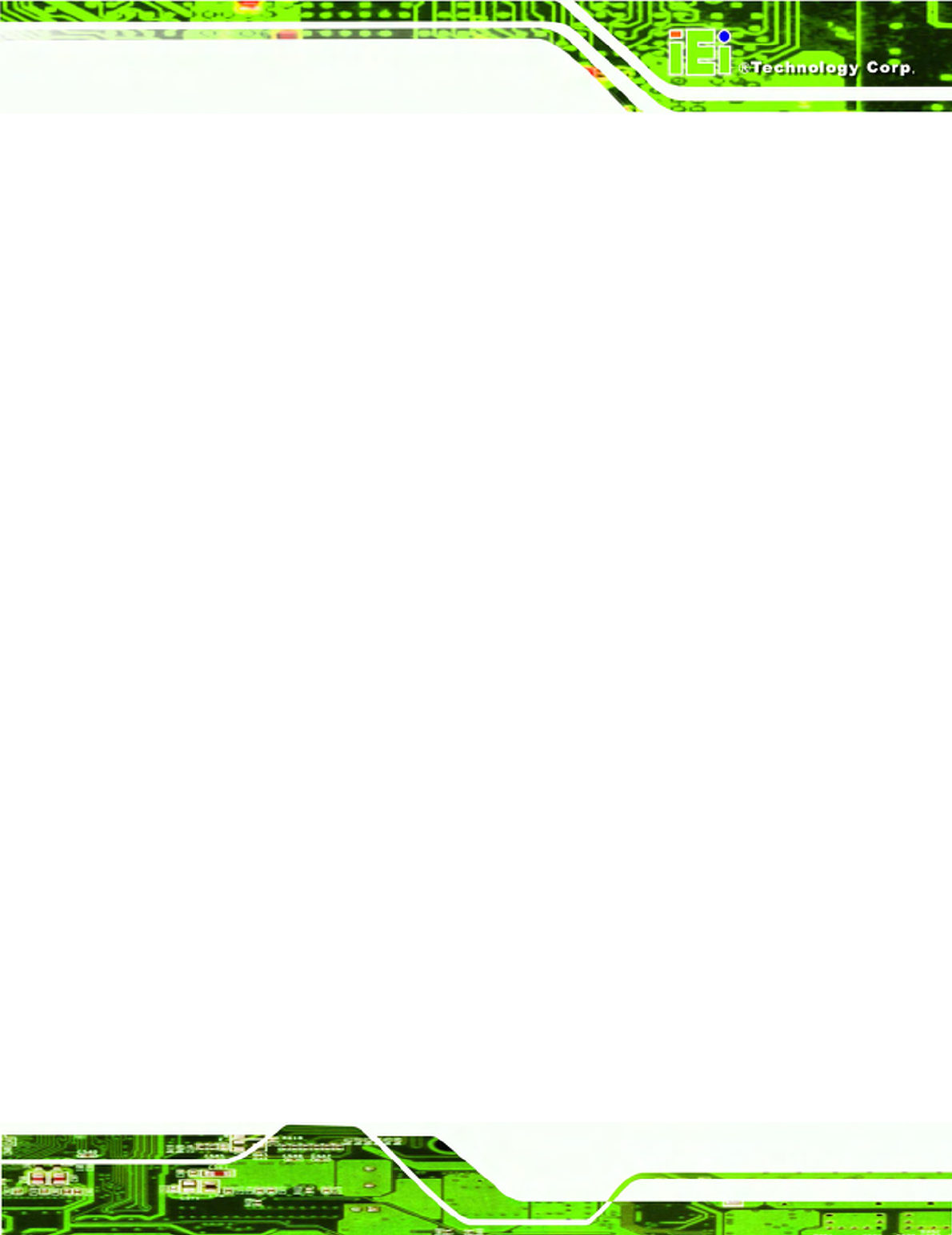
ICEFIRE-T10A Mobile Clinic Assistant
Page ix
Figure 3-23: RFID Reader On/Off Button ................................................................................ 33
Figure 3-24: IRFR-110 Icon...................................................................................................... 34
Figure 3-25: IRFR – Device Type ............................................................................................ 34
Figure 3-26: Ser Device Type Button Grayed Out .................................................................. 35
Figure 3-27: IRFR – Find Tags ................................................................................................ 35
Figure 3-28: IRFR – UIDs ......................................................................................................... 36
Figure 3-29: Barcode scanner On/Off Button ......................................................................... 36
Figure 3-30: EasySet Window ................................................................................................. 37
Figure 3-31: EasySet – Communication ................................................................................. 37
Figure 3-32: Connection Parameters Window ....................................................................... 38
Figure 3-33: Communication – Disconnect ............................................................................ 38
Figure 3-34: Barcode Information Display Area ..................................................................... 39
Figure 3-35: Barcode Parameters ........................................................................................... 40
Figure 3-36: Symbologies ....................................................................................................... 41
Figure 3-37: Operating Settings .............................................................................................. 41
Figure 3-38: Scanning/Triggering ........................................................................................... 42
Figure 3-39: Beeps/Green Indicator LED ................................................................................ 42
Figure 4-1: Graphics Driver Location ..................................................................................... 46
Figure 4-2: Graphics Media Accelerator Driver ...................................................................... 46
Figure 4-3: Realtek LAN Driver Location ................................................................................ 47
Figure 4-4: Realtek LAN InstallShield Wizard ........................................................................ 48
Figure 4-5: Speaker and Microphone Driver Location ........................................................... 49
Figure 4-6: Realtek HD Audio Driver InstallShield Wizard ..................................................... 49
Figure 4-7: Fingerprint Reader Driver Location ..................................................................... 50
Figure 4-8: Fingerprint Reader InstallShield Wizard .............................................................. 51
Figure 4-9: Barcode Scanner Driver Location ........................................................................ 52
Figure 4-10: Bluetooth Driver Location .................................................................................. 53
Figure 5-1: Control Center ...................................................................................................... 55
Figure 5-2: Module Status ....................................................................................................... 57
Figure 5-3: Calibration ............................................................................................................ 57
Figure 5-4: Tablet PC Settings ................................................................................................ 58
Figure 5-5: Calibrate Pen or Touch Input Screens ................................................................. 58
Figure 5-6: Button Actions ...................................................................................................... 59
Figure 5-7: Button Actions - Wifi ............................................................................................ 60
Figure 5-8: Action - Open Process ......................................................................................... 61
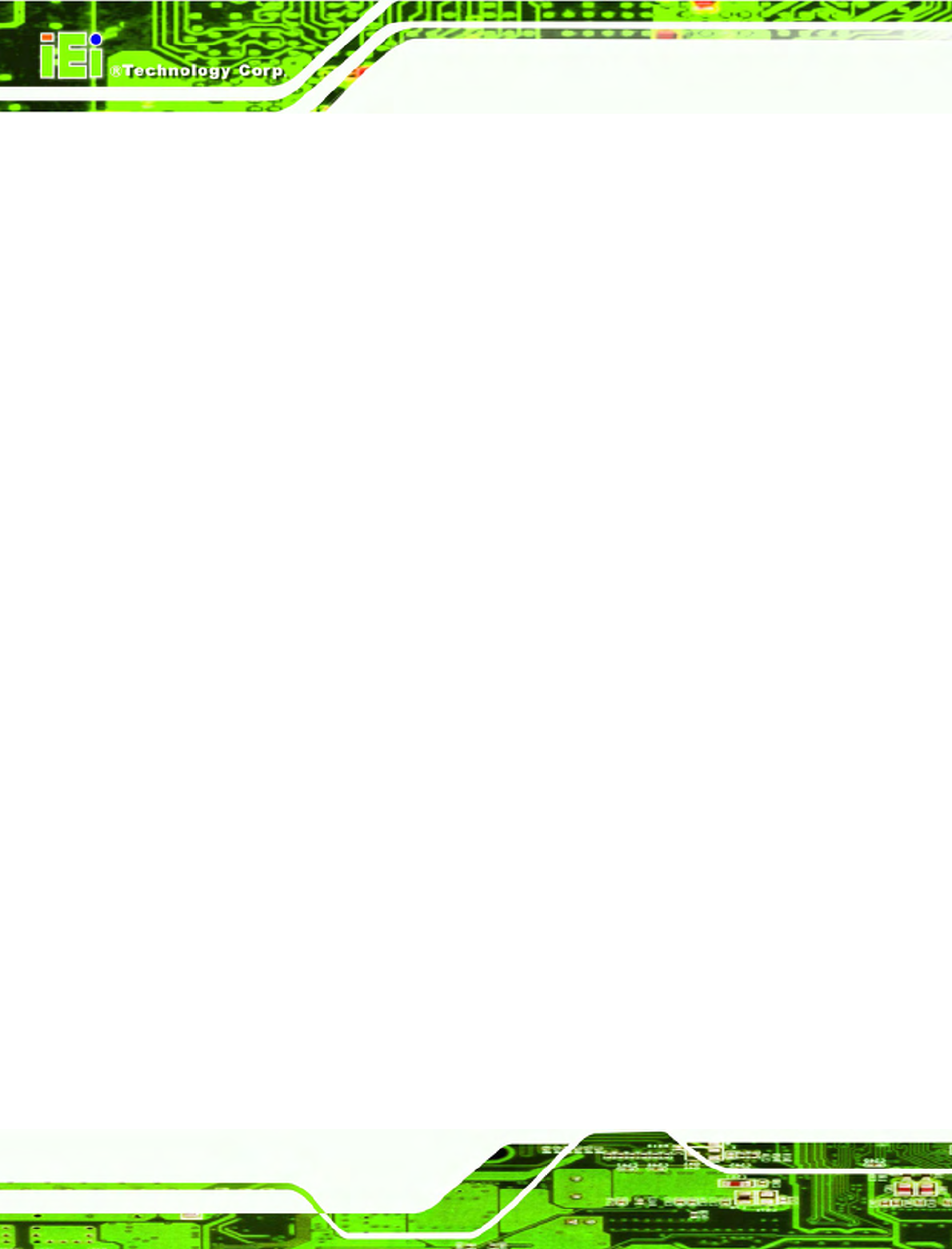
ICEFIRE-T10A Mobile Clinic Assistant
Page x
Figure 5-9: Action - Windows Key Action .............................................................................. 62
Figure B-1: IEI One Key Recovery Tool Menu ........................................................................ 92
Figure B-2: Launching the Recovery Tool ............................................................................. 96
Figure B-3: Recovery Tool Setup Menu ................................................................................. 97
Figure B-4: Command Mode ................................................................................................... 97
Figure B-5: Partition Creation Commands ............................................................................. 98
Figure B-6: Launching the Recovery Tool ........................................................................... 100
Figure B-7: System Configuration for Windows .................................................................. 100
Figure B-8: Build-up Recovery Partition .............................................................................. 101
Figure B-9: Press any key to continue ................................................................................. 101
Figure B-10: Press F3 to Boot into Recovery Mode............................................................. 102
Figure B-11: Recovery Tool Menu ........................................................................................ 102
Figure B-12: About Symantec Ghost Window ..................................................................... 103
Figure B-13: Symantec Ghost Path ...................................................................................... 103
Figure B-14: Select a Local Source Drive............................................................................. 104
Figure B-15: Select a Source Partition from Basic Drive ..................................................... 104
Figure B-16: File Name to Copy Image to ............................................................................. 105
Figure B-17: Compress Image .............................................................................................. 105
Figure B-18: Image Creation Confirmation .......................................................................... 106
Figure B-19: Image Creation Process................................................................................... 106
Figure B-20: Image Creation Complete ................................................................................ 106
Figure B-21: Press Any Key to Continue.............................................................................. 107
Figure B-22: Partitions for Linux .......................................................................................... 108
Figure B-23: System Configuration for Linux ...................................................................... 109
Figure B-24: Access menu.lst in Linux (Text Mode) ............................................................ 109
Figure B-25: Recovery Tool Menu ........................................................................................ 110
Figure B-26: Recovery Tool Main Menu ............................................................................... 111
Figure B-27: Restore Factory Default ................................................................................... 112
Figure B-28: Recovery Complete Window ........................................................................... 112
Figure B-29: Backup System ................................................................................................ 113
Figure B-30: System Backup Complete Window ................................................................. 113
Figure B-31: Restore Backup ................................................................................................ 114
Figure B-32: Restore System Backup Complete Window ................................................... 114
Figure B-33: Symantec Ghost Window ................................................................................ 115
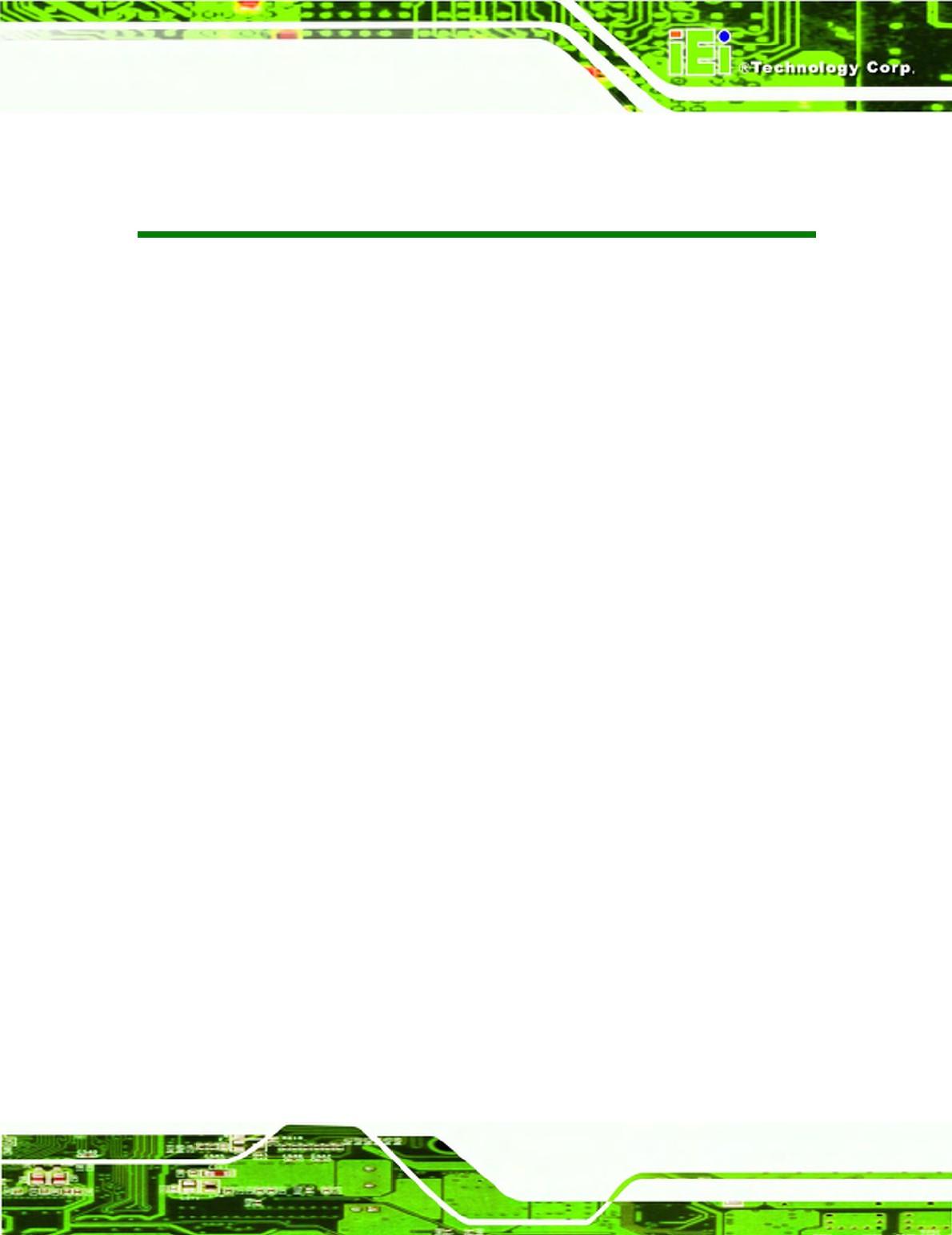
ICEFIRE-T10A Mobile Clinic Assistant
Page xi
List of Tables
Table 1-1: Model Variations ...................................................................................................... 3
Table 1-2: Technical Specifications ........................................................................................ 10
Table 2-1: Packing List ............................................................................................................ 15
Table 2-2: Optional Items ........................................................................................................ 15
Table 3-1: Serial Port Pinouts ................................................................................................. 30
Table 5-1: Action Description ................................................................................................. 61
Table 6-1: BIOS Navigation Keys ............................................................................................ 65
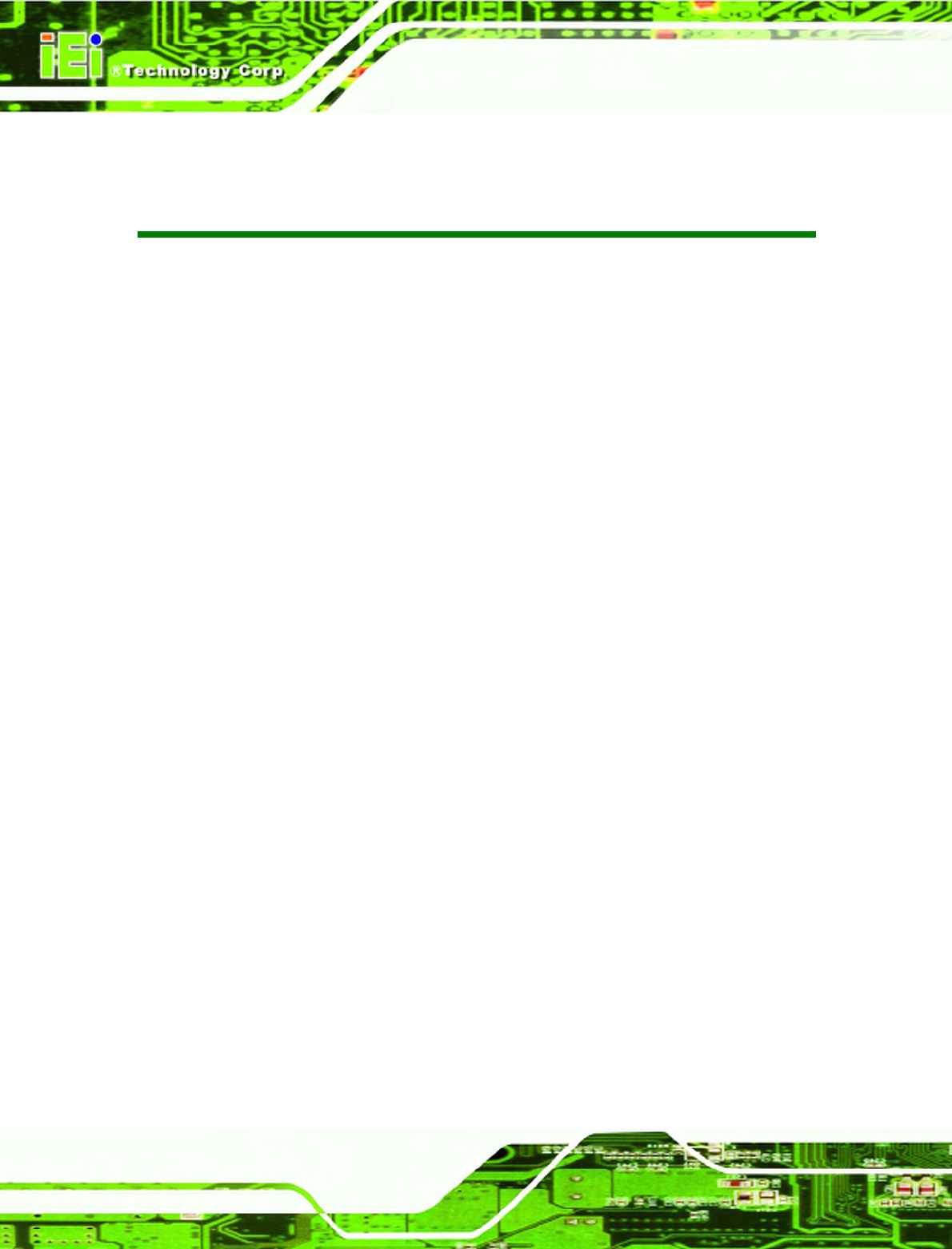
ICEFIRE-T10A Mobile Clinic Assistant
Page xii
BIOS Menus
BIOS Menu 1: Main .................................................................................................................. 66
BIOS Menu 2: Advanced ......................................................................................................... 67
BIOS Menu 3: CPU Configuration ........................................................................................... 68
BIOS Menu 4: IDE
Configuration ............................................................................................ 69
BIOS Menu 5: USB Configuration ........................................................................................... 70
BIOS Menu 6: Hardware Health Configuration ....................................................................... 71
BIOS Menu 7: Hardware Health Configuration ....................................................................... 72
BIOS Menu 8: IEI Feature ........................................................................................................ 74
BIOS Menu 9: Chipset ............................................................................................................. 75
BIOS Menu 10: Host Bridge Chipset Configuration ............................................................... 76
BIOS Menu 11:South Bridge Chipset Configuration .............................................................. 77
BIOS Menu 12: Intel IGD SWSCI OpRegion ............................................................................ 78
BIOS Menu 13: Boot ................................................................................................................ 80
BIOS Menu 14: Security .......................................................................................................... 81
BIOS Menu 15:Exit .................................................................................................................. 82
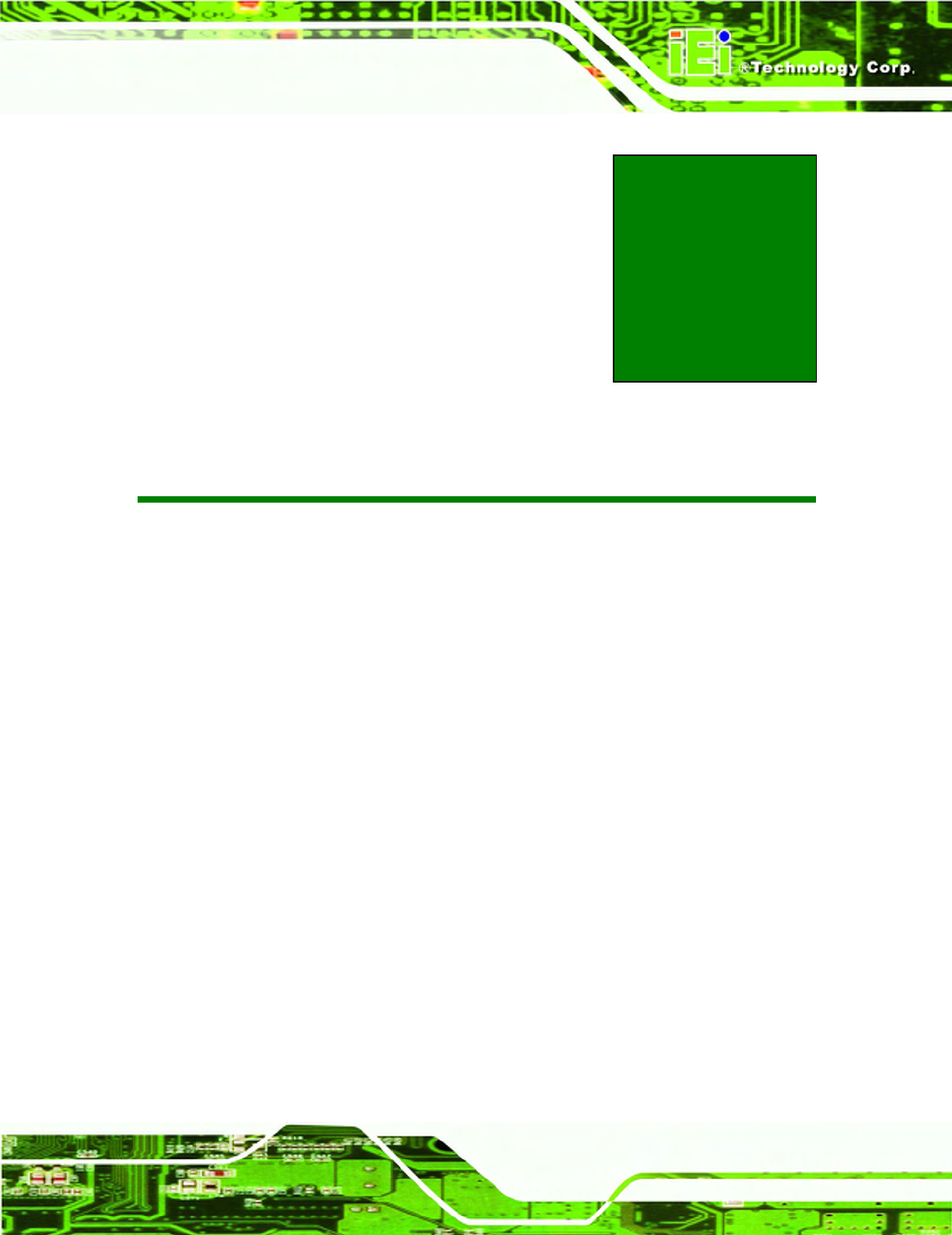
ICEFIRE-T10A Mobile Clinic Assistant
Page 1
Chapter
1
1 Introduction
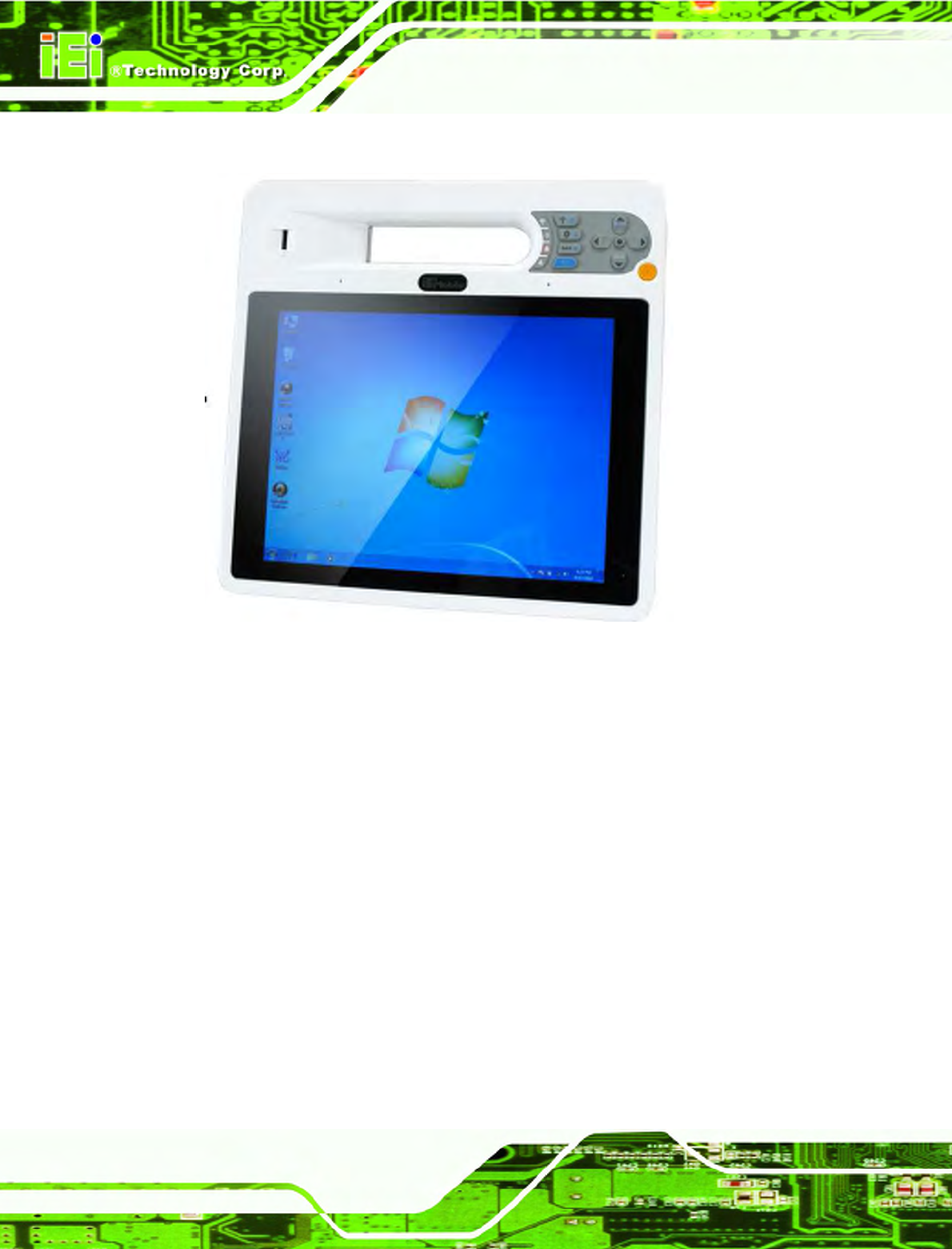
ICEFIRE-T10A Mobile Clinic Assistant
Page 2
1.1 Overview
Figure 1-1: ICEFIRE-T10A
The ICEFIRE-T10A is an industrial tablet PC with a 10.4 inch touch/digitizer screen and an
IP64 compliant front panel. The ICEFIRE-T10A features a 1.8 GHz Intel® Atom™ D525
with 2 GB 1333 MHz DDR3 SDRAM memory.
Storage needs are met by the preinstalled a 1.8” SSD with Windows 7 operating system.
Wireless networking is enabled through an 802.11a/b/g/n wireless adapter. A Bluetooth
2.1+EDR Class 2 module provides a connection to Bluetooth devices. Wired options are
always available through RJ-45 connector on the rear panel, with one USB port on the
side panel for peripherals.
A 3.0 megapixel webcam and microphone provide video conferencing capabilities. The
ICEFIRE-T10A also features a barcode scanner and an optional RFID reader for
advanced data acquisition.
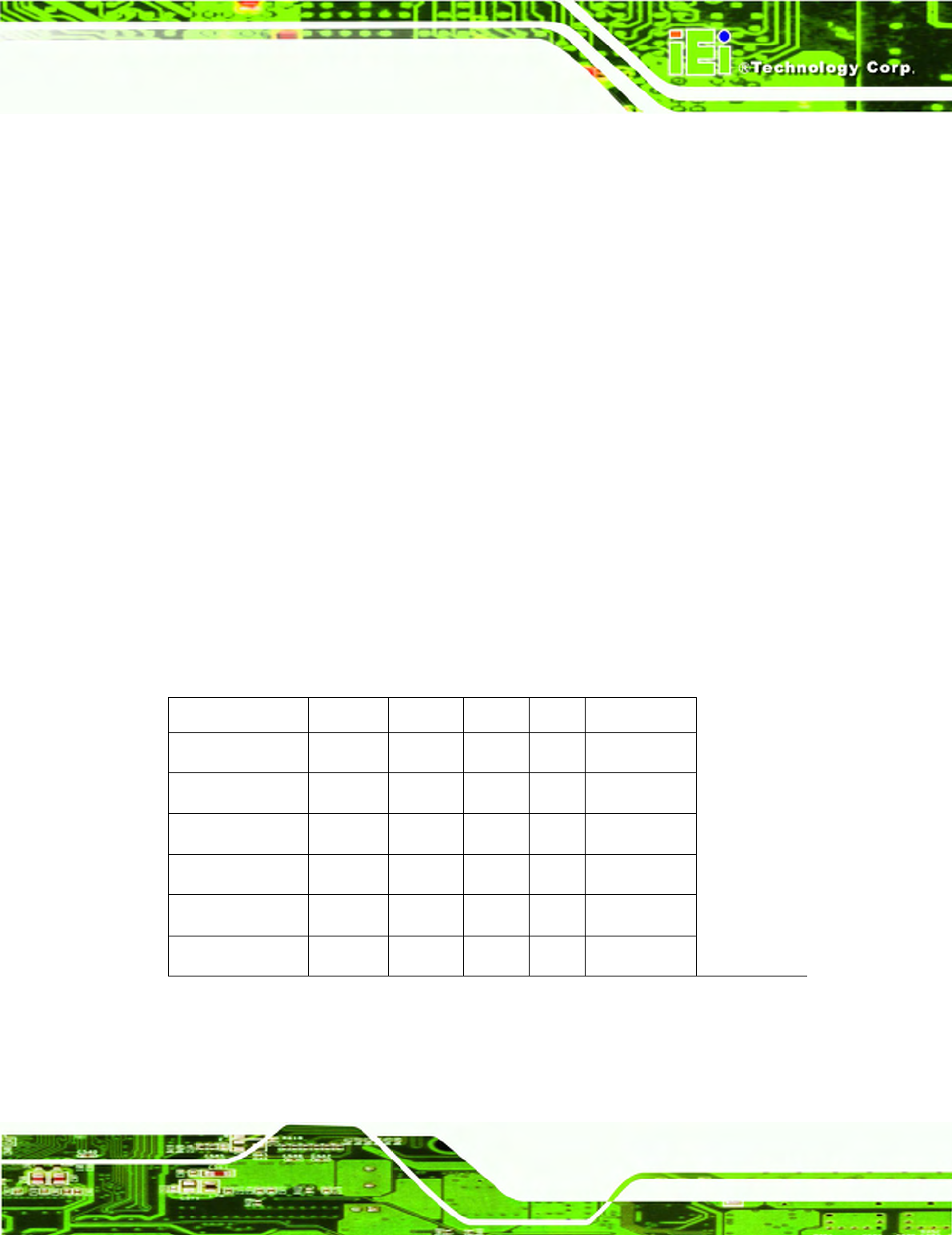
ICEFIRE-T10A Mobile Clinic Assistant
Page 3
1.2 Features
Some of the standard features of the ICEFIRE-T10A tablet PC include:
10.4” TFT XGA LCD
Dual-mode input (digitizer and resistive touch)
Two hot-swappable 1880mAh Li-ion batteries
Intel® Atom™ D525 dual-core platform
Support 1D/2D barcode scanner, RFID reader, fingerprint reader and optional
smart card reader
Support Bluetooth and Wi-Fi wireless connection
One Key Recovery
IP64 compliant front panel protection
Windows® 7 Embedded OS
RoHS compliant
1.3 Model Variations
There are six models of the ICEFIRE-T10A series. All of the models support wireless and
Bluetooth connection and are equipped with the resistive multi-touch screen. The model
numbers and model variations are listed below.
ICEFIRE-T10A Digitizer Barcode
RFID SSD OS
-HU/2G-R10 Yes 1D/2D Yes No No
-TR/2G-R10 No 1D/2D Yes No No
-ET/2G-R10 No No No No No
-HU/2G-32S-R10
Yes 1D/2D Yes 32G Windows 7
-TR/2G-32S-R10
No 1D/2D Yes 32G Windows 7
-ET/2G-32S-R10
No No No 32G Windows 7
Table 1-1: Model Variations
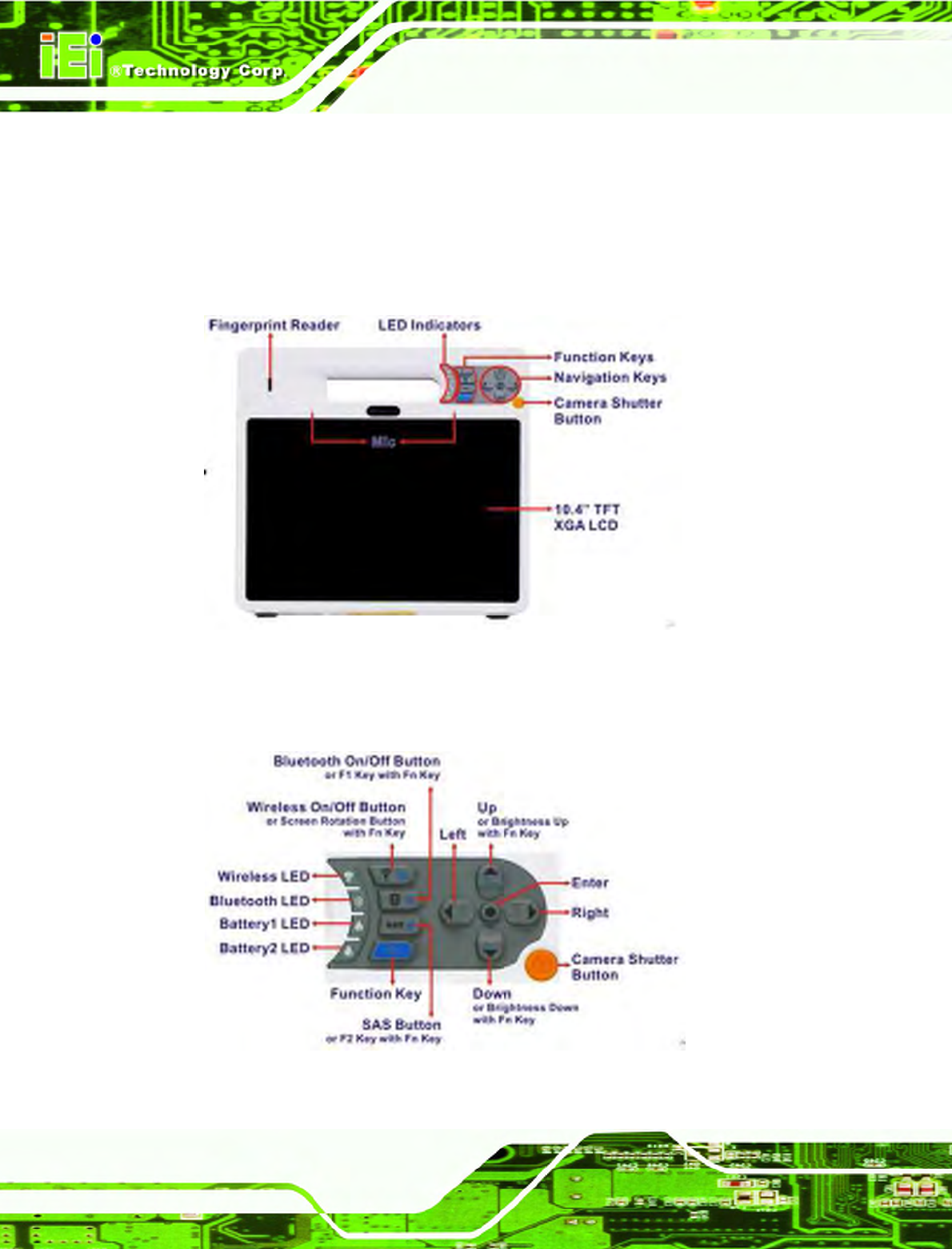
ICEFIRE-T10A Mobile Clinic Assistant
Page 4
1.4 Front Panel
The front panel of the ICEFIRE-T10A has a 10.4” TFT XGA LCD that supports dual-mode
input (digitizer and resistive touch). The ICEFIRE-T10A detects and switches the input
mode automatically. The digitizer input mode is the priority if the two input modes are used
at the same time.
Figure 1-2: Front Panel
1.4.1 Buttons and Indicators
Figure 1-3: Front Panel Buttons and Indicators
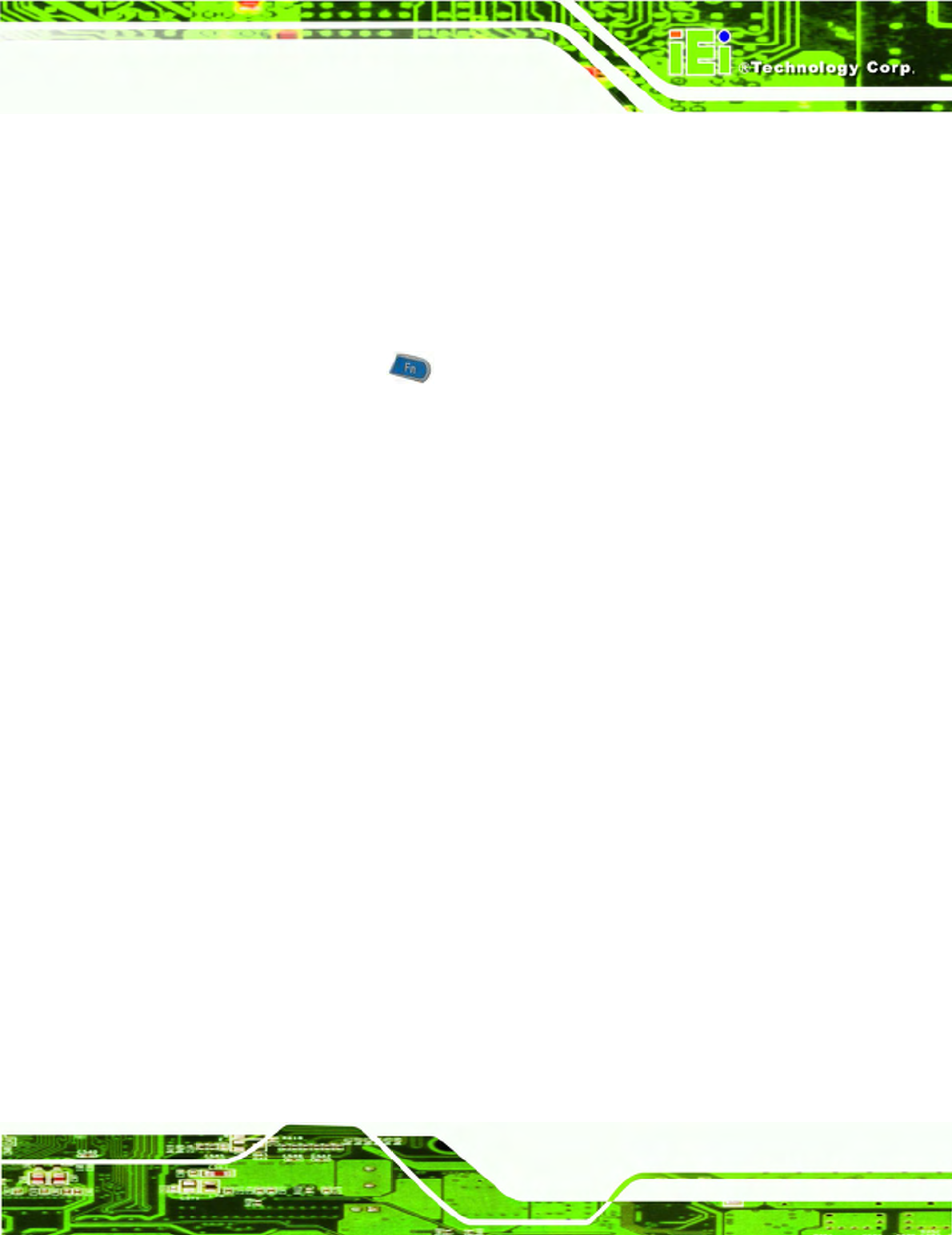
ICEFIRE-T10A Mobile Clinic Assistant
Page 5
There are several buttons and indicators on the front panel of the ICEFIRE-T10A as show
in the figure above. Following are descriptions of their functions:
Buttons
o Wireless on/off button: to enable or disable Wi-Fi connection
o Bluetooth on/off button: to enable or disable Bluetooth connection
o SAS (Secure Attention Sequence) button: CTRL-ALT-DEL
o Camera shutter button: to take a picture
Function Key
Press the function key and a key together at the same time to perform the
following functions:
o Function key + Wireless on/off button = Rotate the screen clockwise
o Function key + Bluetooth on/off button = F1. Default setting is to launch
Windows Help and Support.
o Function key + SAS button = F2. Default setting is to rename a file.
o Function key + Up = Brightness up
o Function key + Down = Brightness down
Navigation Keypad
o Up, Down
o Right, Left
o Center (select or enter)
LED Indicators
o Wireless LED: Green light blinking: Wi-Fi is enabled
o Bluetooth LED: Blue light shows Bluetooth is enabled
o Battery 1 status LED: Orange light shows the Battery 1 is being charged
o Battery 2 status LED: Orange light shows the Battery 2 is being charged
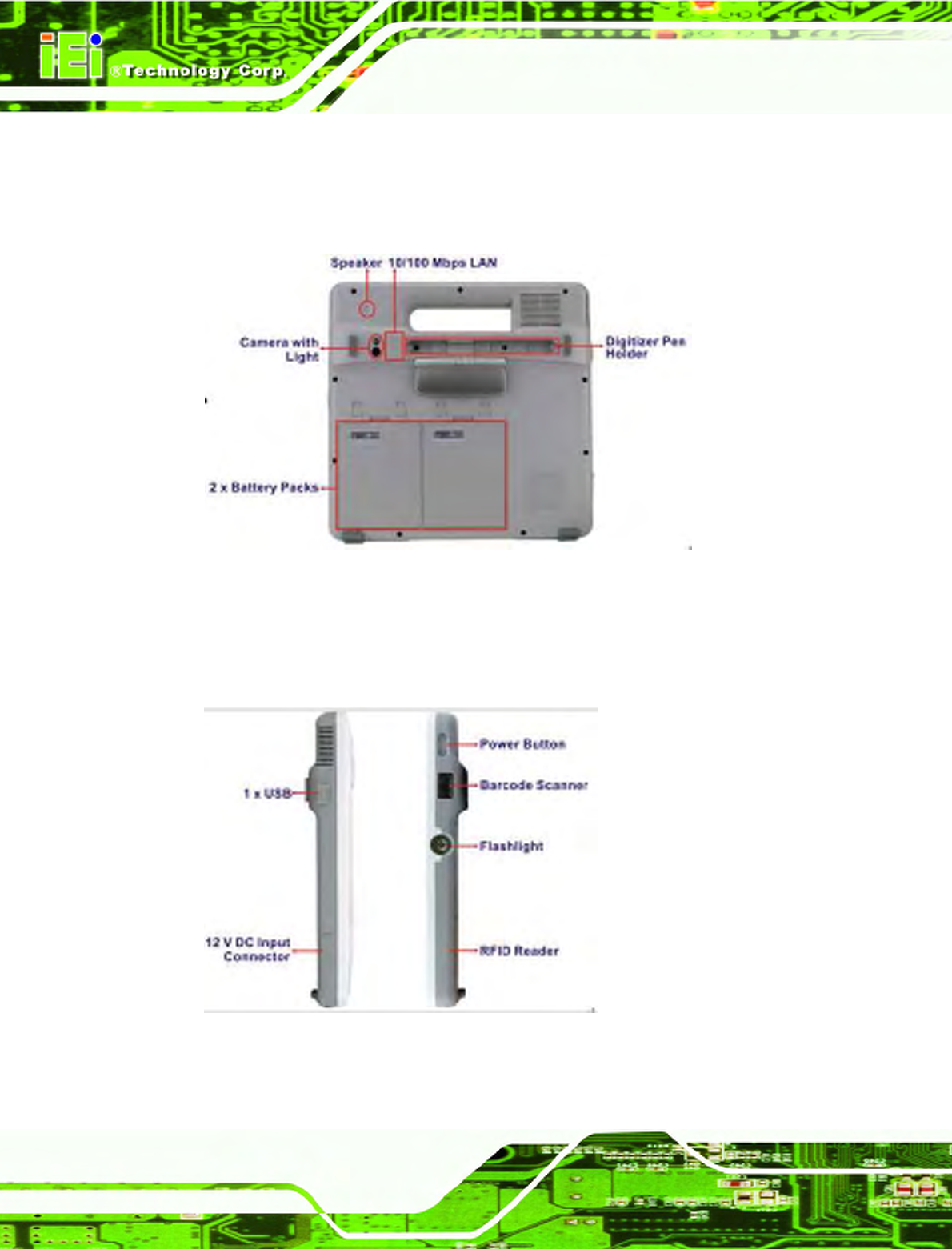
ICEFIRE-T10A Mobile Clinic Assistant
Page 6
1.5 Rear Panel
The rear panel consists of a 3 megapixel camera, 2 W speaker, LAN, digitizer pen holder
and two battery packs.
Figure 1-4: Rear Panel
1.6 Side Panels
The side panels have connectors, button and readers as shown in
405H476H
Figure 1-5.
Figure 1-5: Side Panels
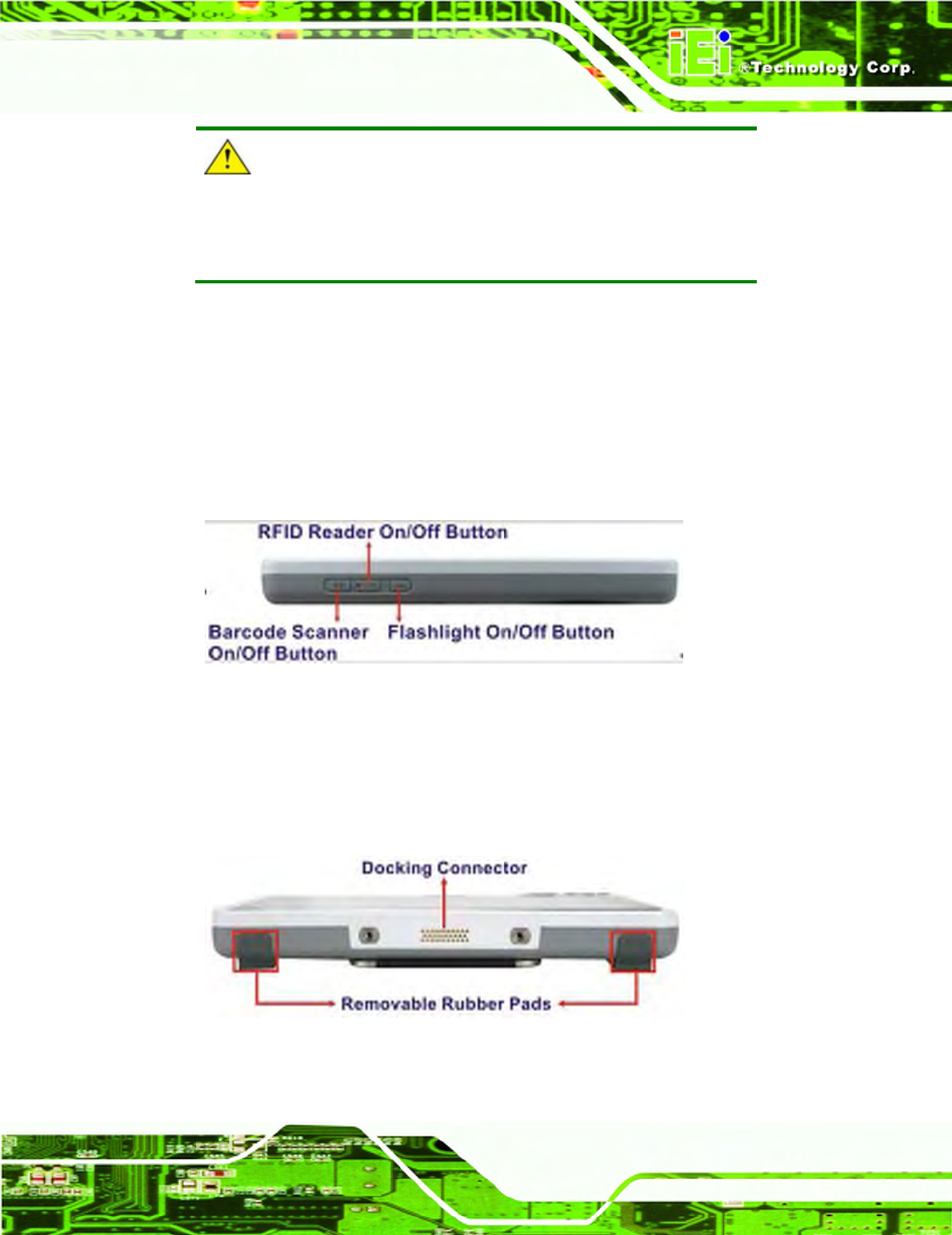
ICEFIRE-T10A Mobile Clinic Assistant
Page 7
CAUTION:
DO NOT shine the light from the flashlight and the barcode scanner in
eyes.
1.7 Top Panel
The top panel has three buttons:
Barcode scanner on/off button
RFID reader on/off button
Flashlight on/off button
Figure 1-6: Top Panel
1.8 Bottom Panel
The bottom panel has a docking connector to connect with the optional docking station.
Figure 1-7: Bottom Panel
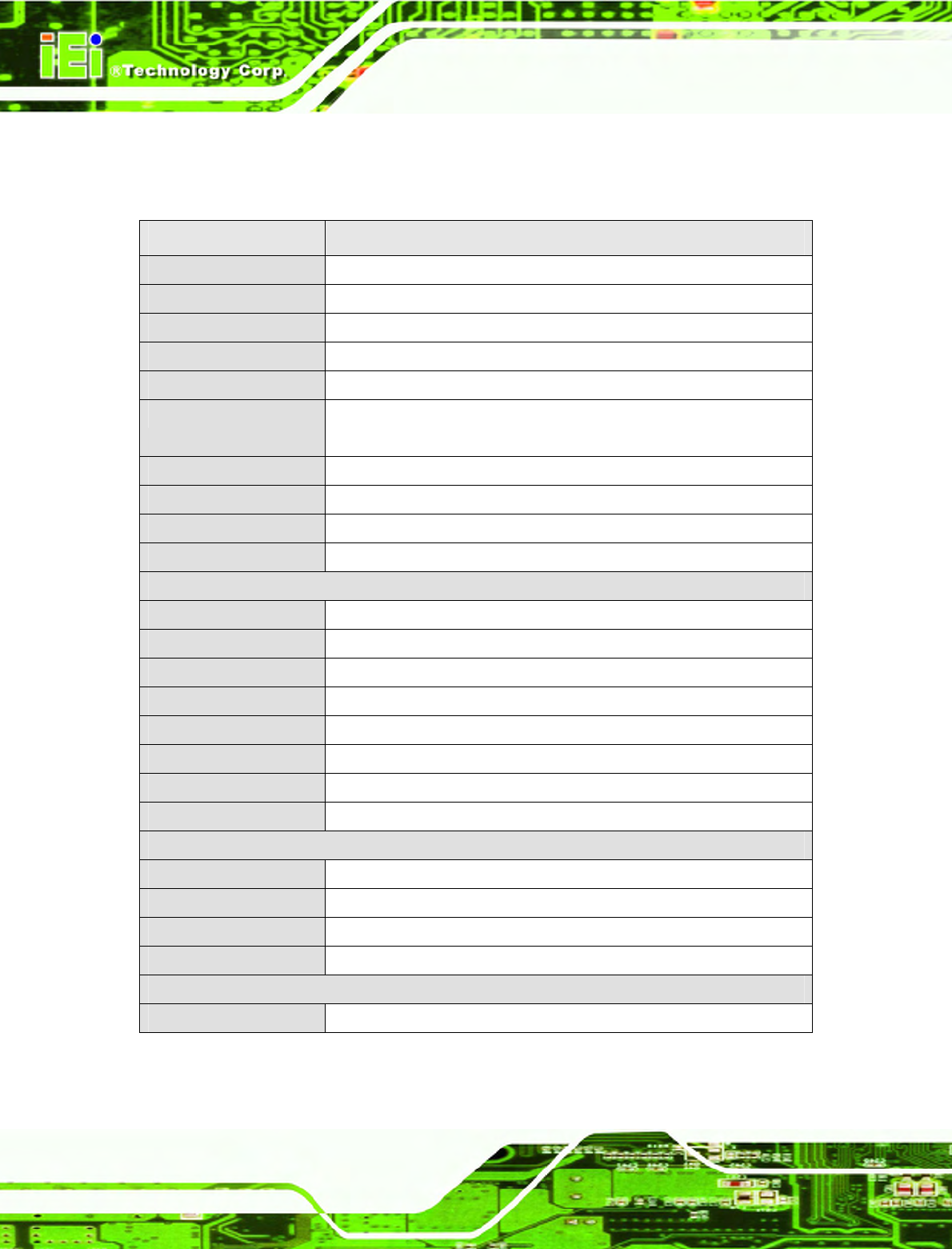
ICEFIRE-T10A Mobile Clinic Assistant
Page 8
1.9 Technical Specifications
The technical specifications for the ICEFIRE-T10A systems are listed in the table below.
System ICEFIRE-T10A
CPU 1.8 GHz Intel® Atom™ D525
Chipset Intel® ICH8M
Memory 2.0 GB 1333 MHz DDR3 SDRAM pre-installed
OS Microsoft Windows 7 Embedded
Storage 1 x 1.8” SSD
Audio 1 x 2 W Speaker
1 x Microphone
Camera 1 x 3 megapixel webcam with light
LED Flashlight 1 x LED flashlight
Barcode Scanner 1D/2D barcode scanner
Digitizer 256 levels @ full scale pressure resolution
Display
LCD 10.4” TFT LCD with resistive touchscreen supports multi-touch and gesture
Max. Resolution 1024 x 768 (XGA)
Brightness (cd/m
2
) 350
Contrast Ratio 1200:1
LCD Colors 16.2 M
Pixel Pitch 0.0685 (H) x 0.2055 (V)
Viewing Angle (H/V) 176/176
Backlight LED backlight
Communication
LAN 1 x 10/100 Mbps RJ-45
Wireless LAN 802.11a/b/g/n
Bluetooth Bluetooth 2.1 + EDR Class 2
RFID 13.56 MHz RFID compliant with ISO15693 and 14443A
Power
Power Input 12 V DC input
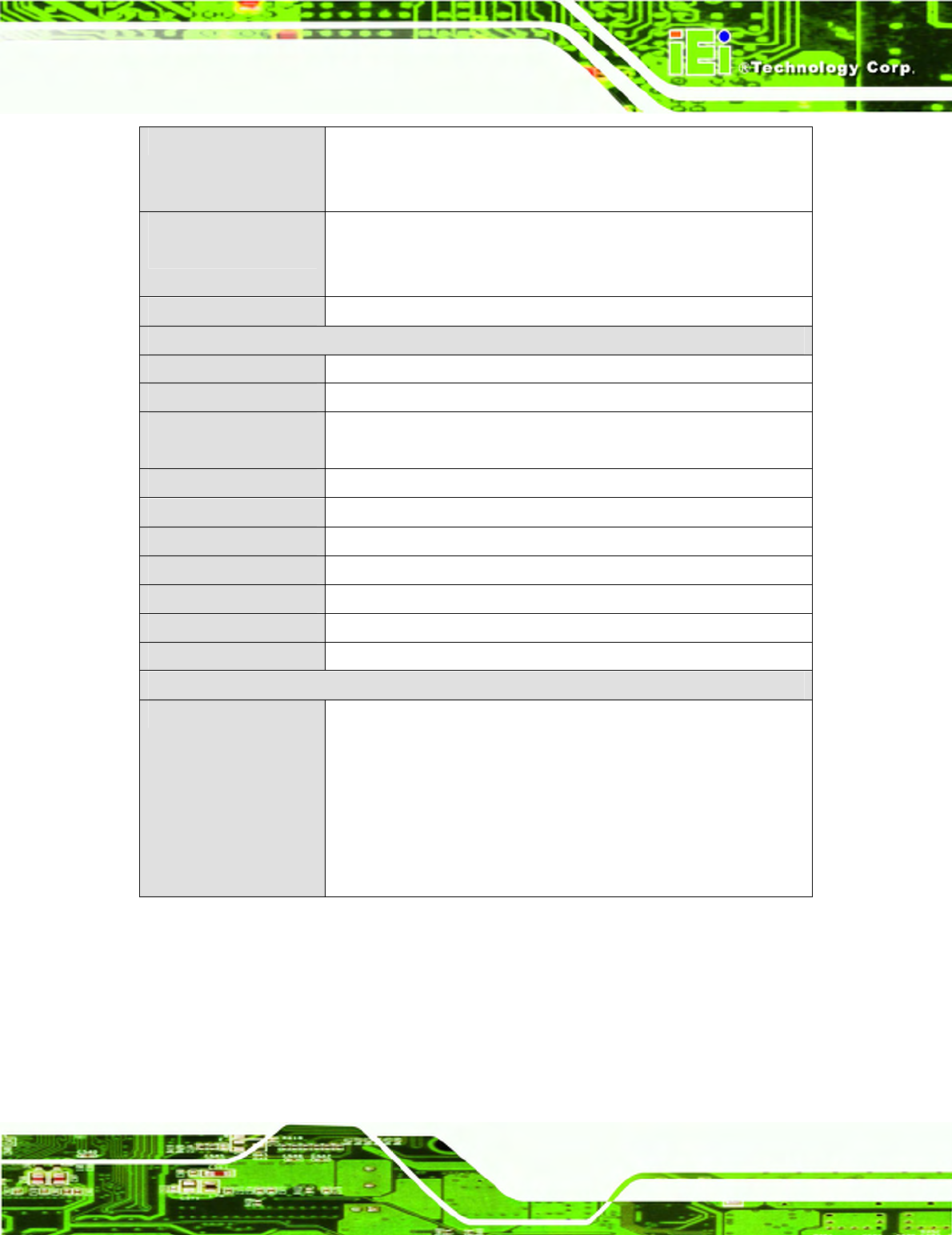
ICEFIRE-T10A Mobile Clinic Assistant
Page 9
Power Adapter Model: PMP60-12-B2
Input: 100-240Vac, 47-63Hz, 1.22-0.68AOutput: 11-13Vdc, 5.46A
Output: 12 V DC @ 5 A
Optional Docking
Power Adapter
FSP_PM90-13-2 90 W Power Adapter
Input: 100-240Vac, 47-63Hz, 1.06-0.45A
Output: 19Vdc, 4.74A.74A
Battery 2 x 11.1 V 1880 mAh Lithium Ion Battery
Physical Character
Construction Material ABS + PC plastic front frame
Mounting Mobile / optional Docking Station (VESA 75 mm x 75 mm)
Dimensions (W x H x D)
(mm)
270 x 265 x 29
Operation Temperature
0ºC ~ 40ºC
Storage Temperature -10ºC ~ 60ºC
Humidity 5% ~ 95% non-condensing
Net weight 1.788 kg with Battery pack (150 g)
IP level (front panel) IP64
Drop Survival 1.0 M
Safety CE, FCC, Medical-grade Class B
Connectors and Buttons
I/O Ports and Switches
1 x 12 V DC input connector
1 x USB 2.0
1 x Ethernet RJ-45 port
1 x RFID on/off switch
1 x Barcode scanner on/off switch
1 x Flashlight on/off switch
1 x Power button with LED
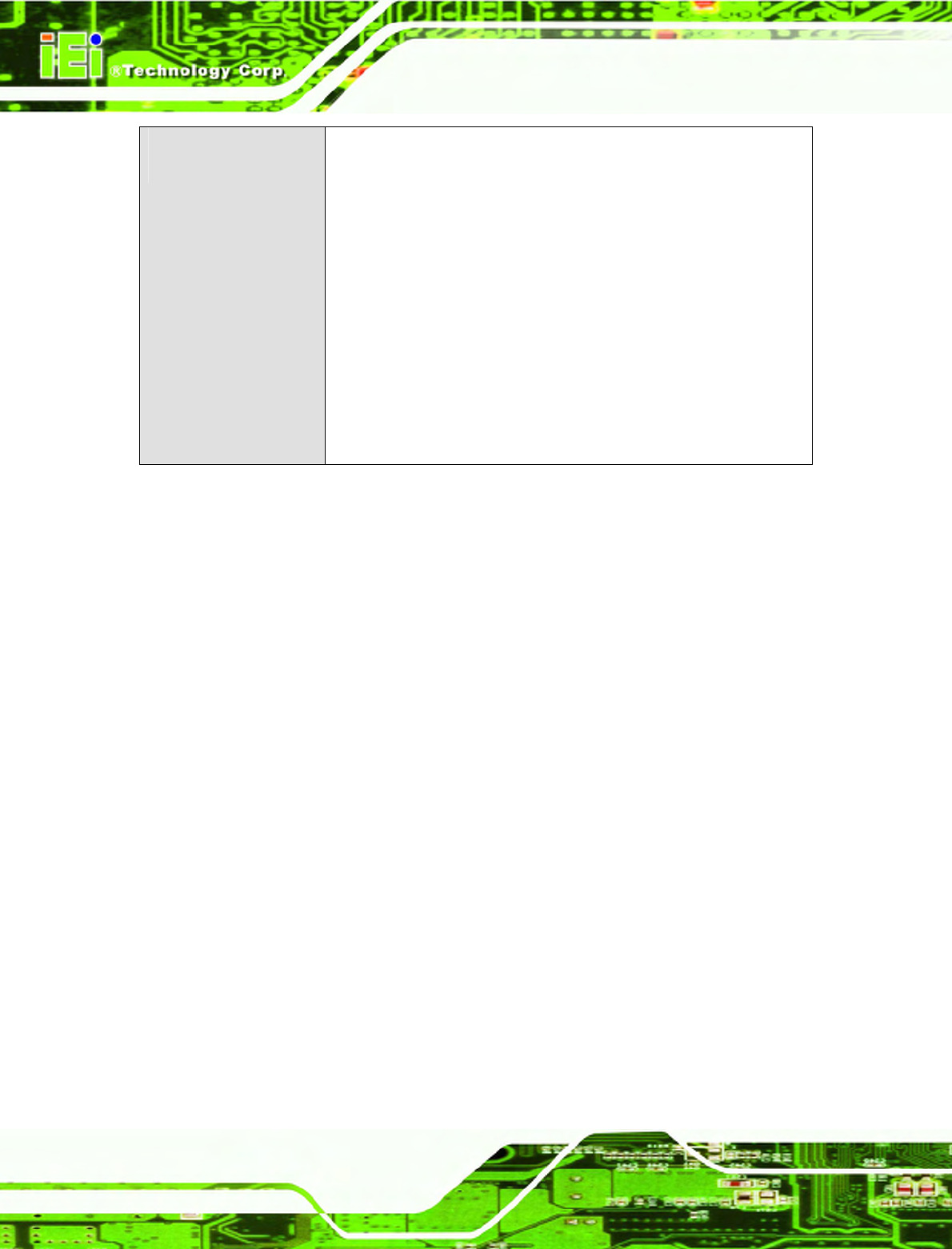
ICEFIRE-T10A Mobile Clinic Assistant
Page 10
Front Panel Buttons and
LED Indicators
1 x Five-way navigation button
1 x Wi-Fi on/off button
1 x Bluetooth on/off button
1 x SAS button
1 x Function key
1 x Camera shutter button
1 x Wi-Fi LED
1 x Bluetooth LED
2 x Battery status LED
1 x Barcode scanner
1 x RFID reader
1 x Fingerprint reader
Table 1-2: Technical Specifications
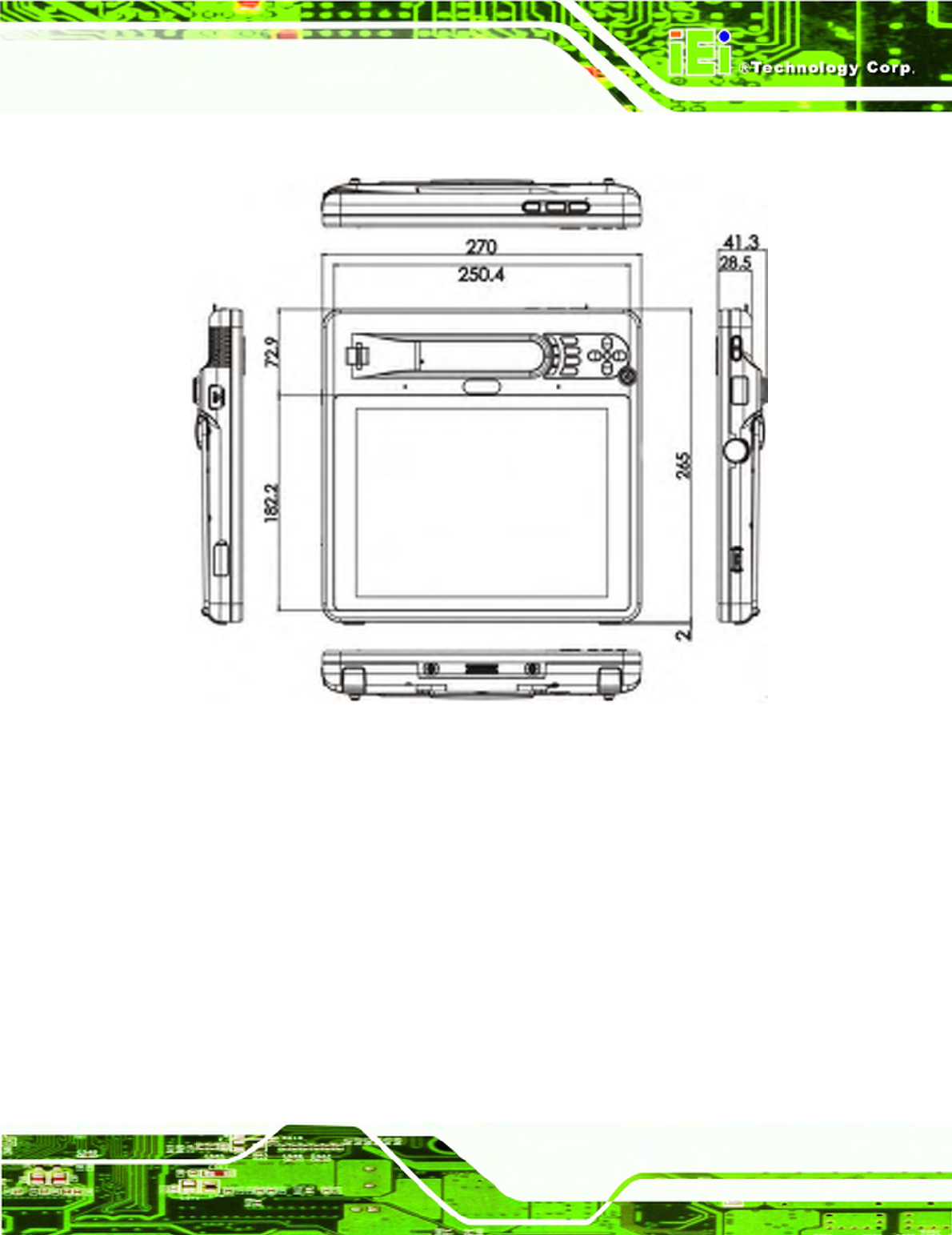
ICEFIRE-T10A Mobile Clinic Assistant
Page 11
1.10 Dimensions
Figure 1-8: Dimensions (units in mm)
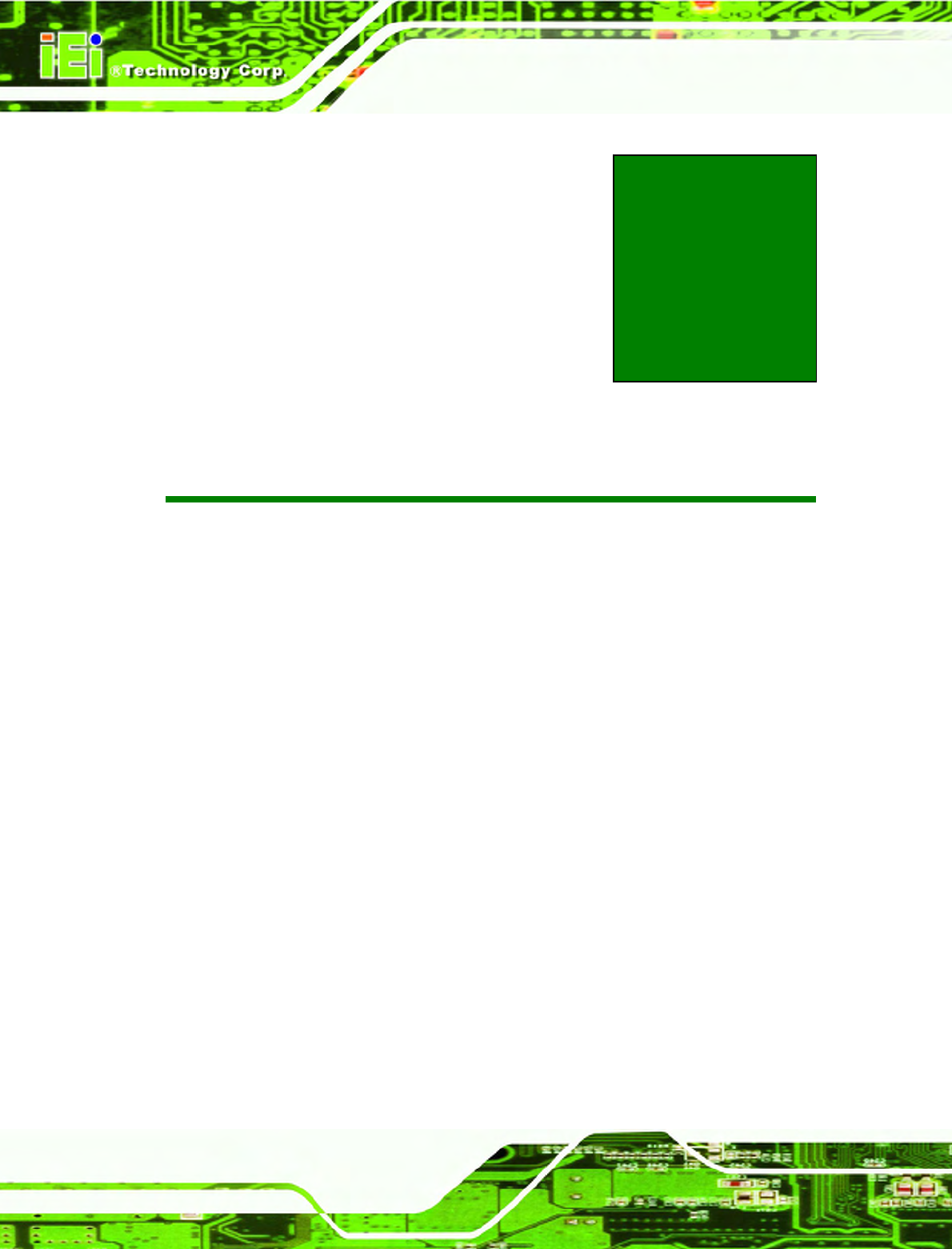
ICEFIRE-T10A Mobile Clinic Assistant
Page 12
Chapter
2
2 Unpacking
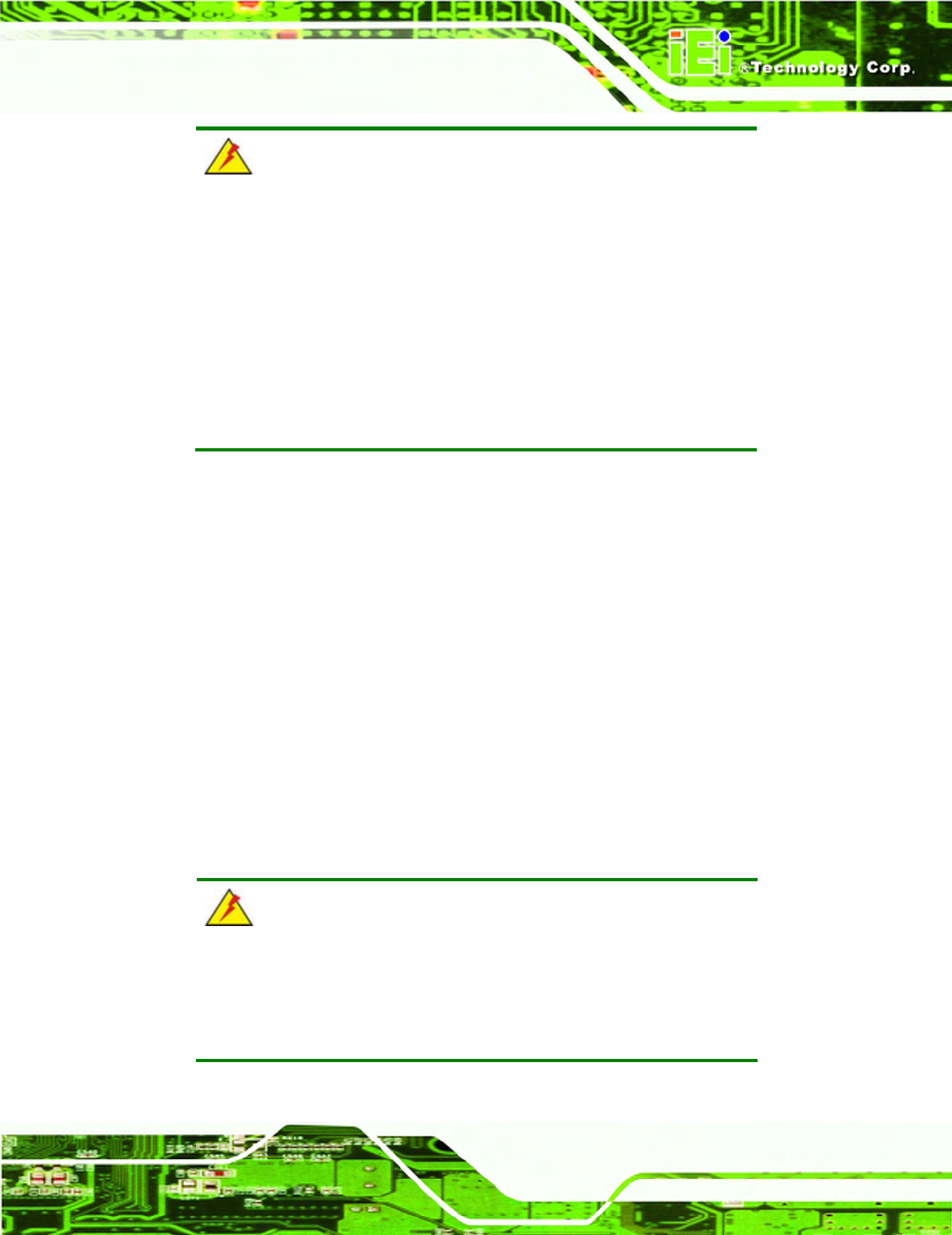
ICEFIRE-T10A Mobile Clinic Assistant
Page 13
WARNING:
When installing the ICEFIRE-T10A, make sure to:
Turn the power off: Chance of electrocution. Turn off the monitor
and unplug it from the power supply.
Only let certified engineers change the hardware settings:
Incorrect settings can cause irreparable damage to the product.
Take anti-static precautions: Electrostatic discharge can destroy
electrical components and injure the user. Users must ground
themselves using an anti-static wristband or similar device.
The installation steps below should be followed in order.
Step 1: Unpack the tablet PC
Step 2: Check all the required parts are included
Step 3: Install and charge the battery packs
Step 4: Connect peripheral devices to the side panels of the tablet PC
Step 5: Connect the power cable
Step 6: Configure the system Step 0:
2.1 Unpack the Tablet PC
To unpack the tablet PC, follow the steps below:
WARNING!
Only remove the protective plastic cover stuck to the front screen after
installation. The plastic layer protects the monitor surface during
installation process.
Step 1: Carefully cut the tape sealing the box. Only cut deep enough to break the tape.
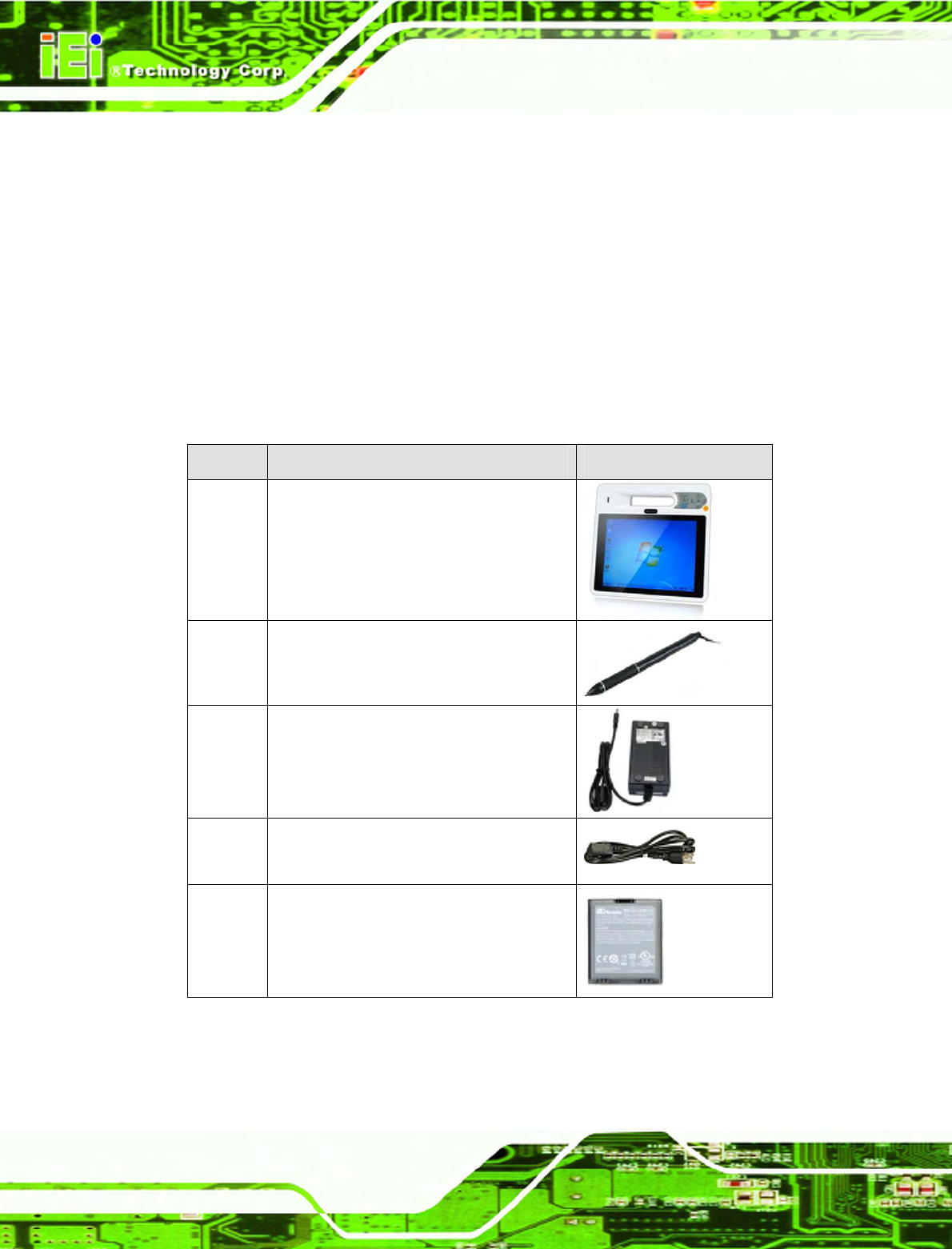
ICEFIRE-T10A Mobile Clinic Assistant
Page 14
Step 2: Open the outside box.
Step 3: Carefully cut the tape sealing the box. Only cut deep enough to break the tape.
Step 4: Open the inside box.
Step 5: Lift the table PC out of the boxes.
Step 6: Remove the peripheral parts box from the main box. Step 0:
2.2 Packing List
The ICEFIRE-T10A tablet PC is shipped with the following components:
Quantity
Item Image
1 ICEFIRE-T10A tablet PC
1 Digitizer pen attached on the rear panel
(P/N: 7Z000-UP7110E63C1-RS)
1 Medical-grade 60 W power adapter
(P/N: 63040-010060-020-RS)
1 Power cable
2 Battery pack
(P/N: 31603-000016-RS)
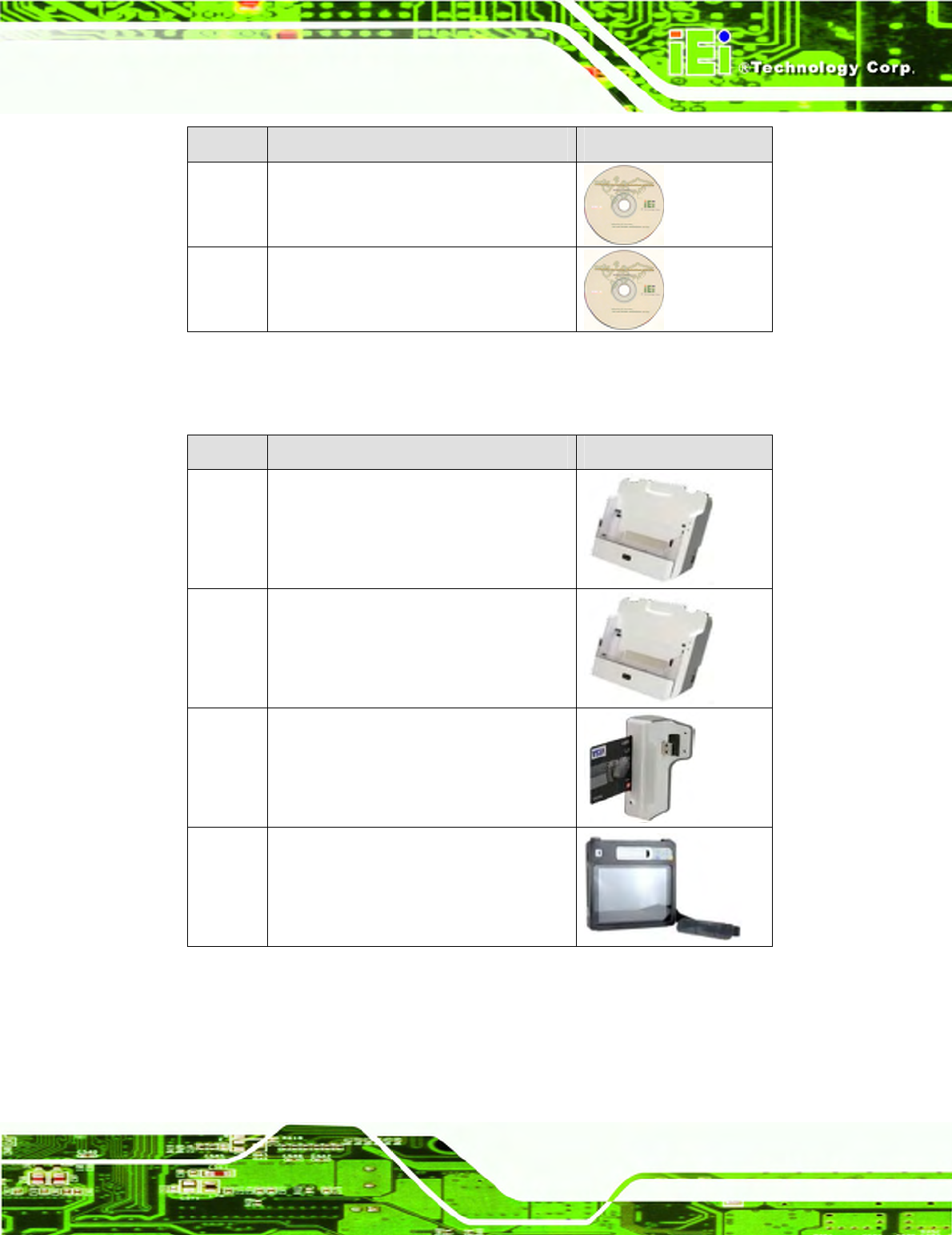
ICEFIRE-T10A Mobile Clinic Assistant
Page 15
Quantity
Item Image
1 Utility CD
(P/N: 7B000-000552-RS)
1 One Key Recovery CD
(P/N: IEI-7B000-000478-RS)
Table 2-1: Packing List
These optional items are also available.
Quantity
Item Image
1 Docking station with Medical grade power
adapter
(P/N: ICEFIRE-T10A-DS01-R10)
1 Docking station
(P/N: ICEFIRE-T10A-DS02-R10)
1 Smart card reader
(P/N: ICEFIRE-T10A-SCR01-R10)
1 Carrying bag
(P/N: ICEFIRE-CB01-R10)
Table 2-2: Optional Items
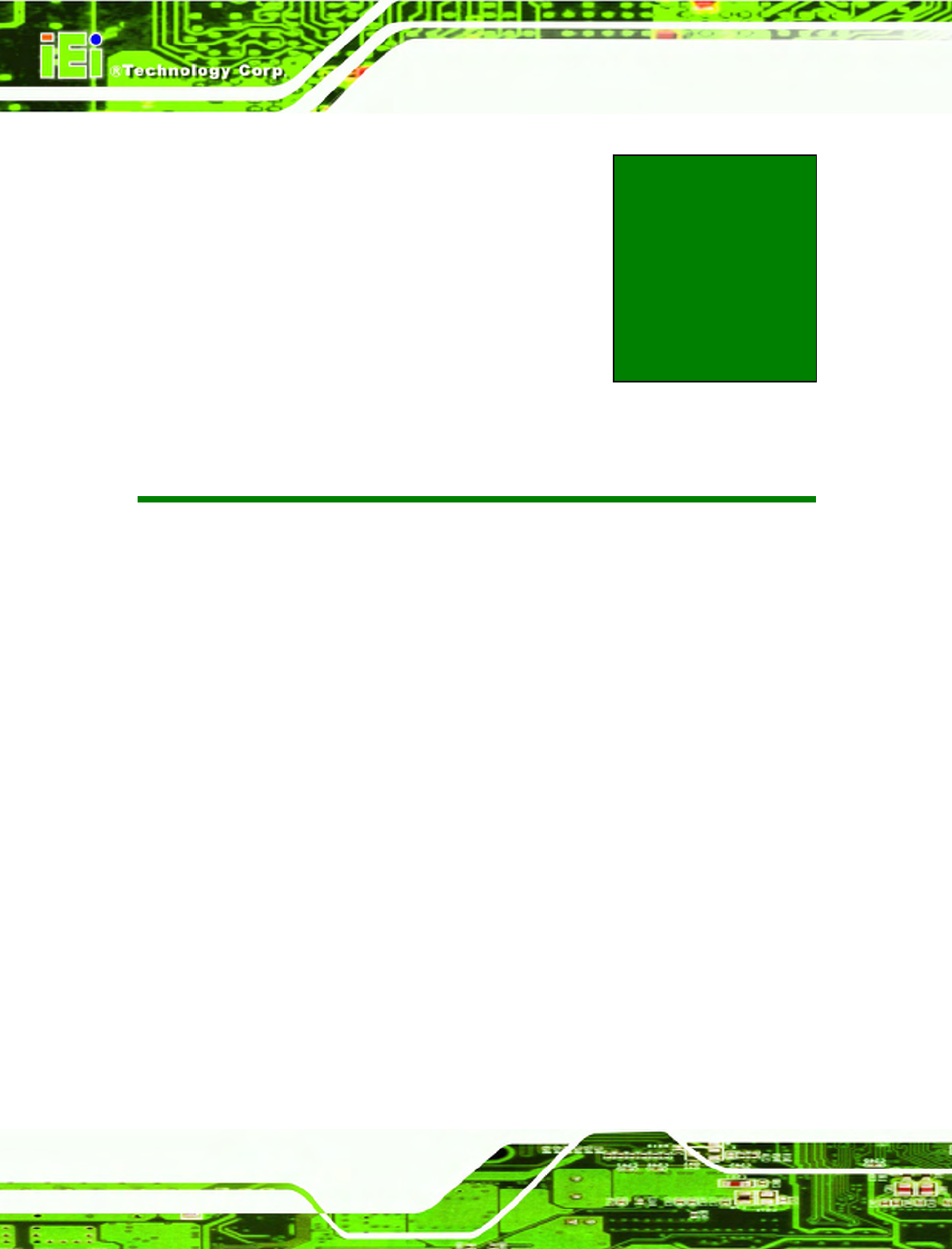
ICEFIRE-T10A Mobile Clinic Assistant
Page 16
Chapter
3
3 Hardware Installation
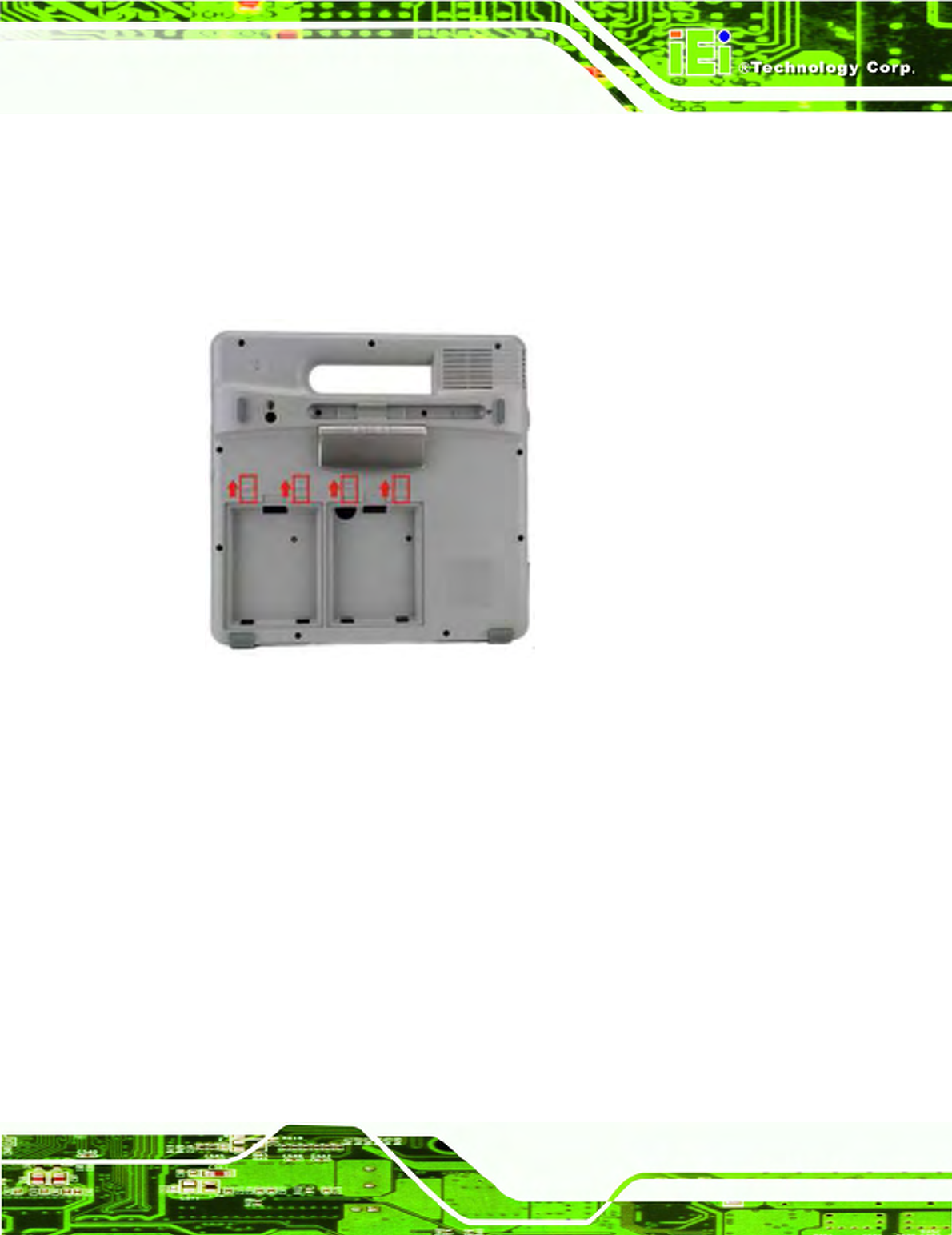
ICEFIRE-T10A Mobile Clinic Assistant
Page 17
3.1 Battery Installation
This section covers the installation of the battery pack.
Step 1: Make sure the battery latches are released. If not, unlock them by sliding latches
to the top.
Figure 3-1: Release Battery Latches
Step 2: Install a battery pack as shown in
406H477H
Figure 3-2.
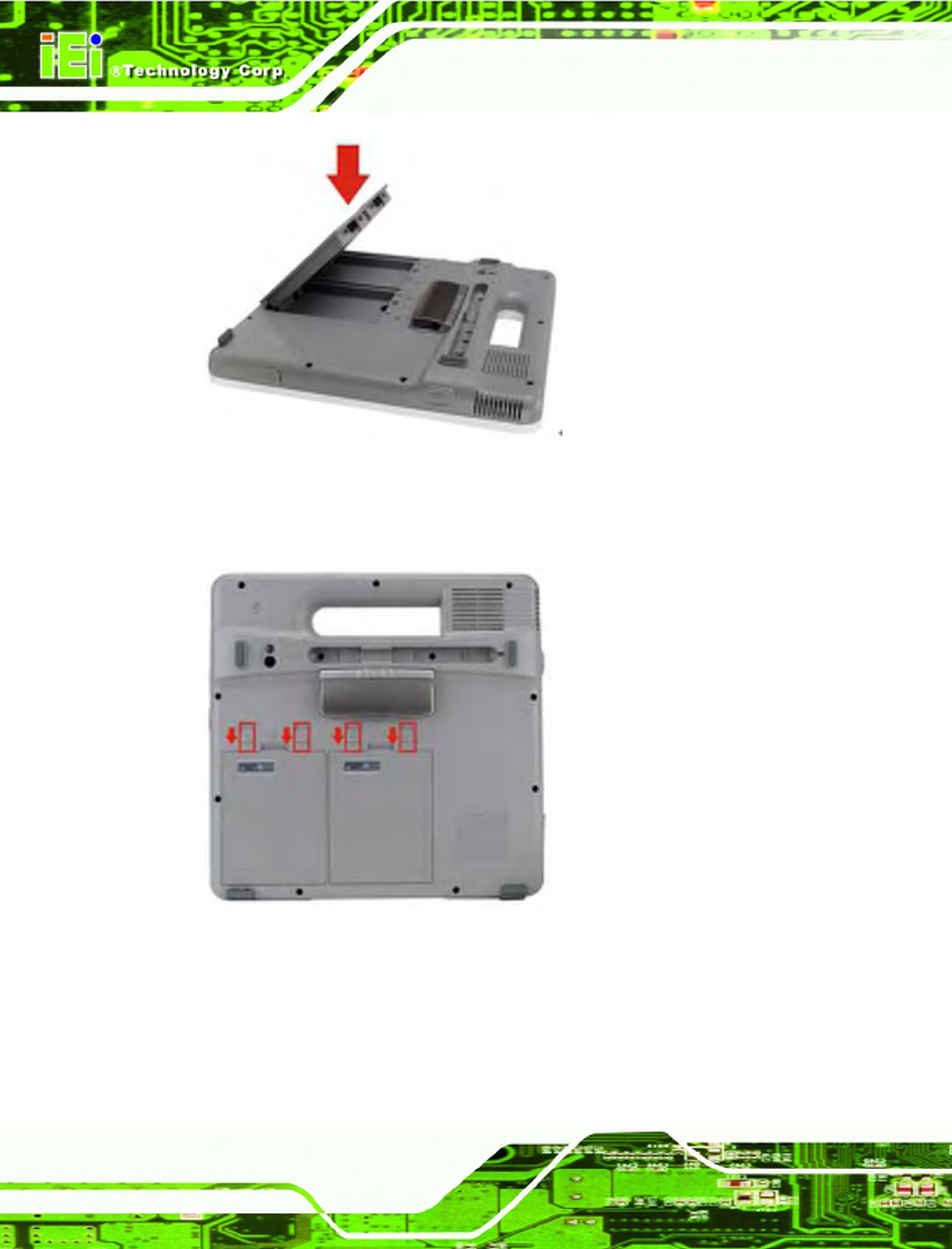
ICEFIRE-T10A Mobile Clinic Assistant
Page 18
Figure 3-2: Battery Installation
Step 3: Lock the battery by sliding the battery latches down to the battery.
Figure 3-3: Lock the Battery
Step 4: To view the battery capacity, push the battery capacity button on the battery.
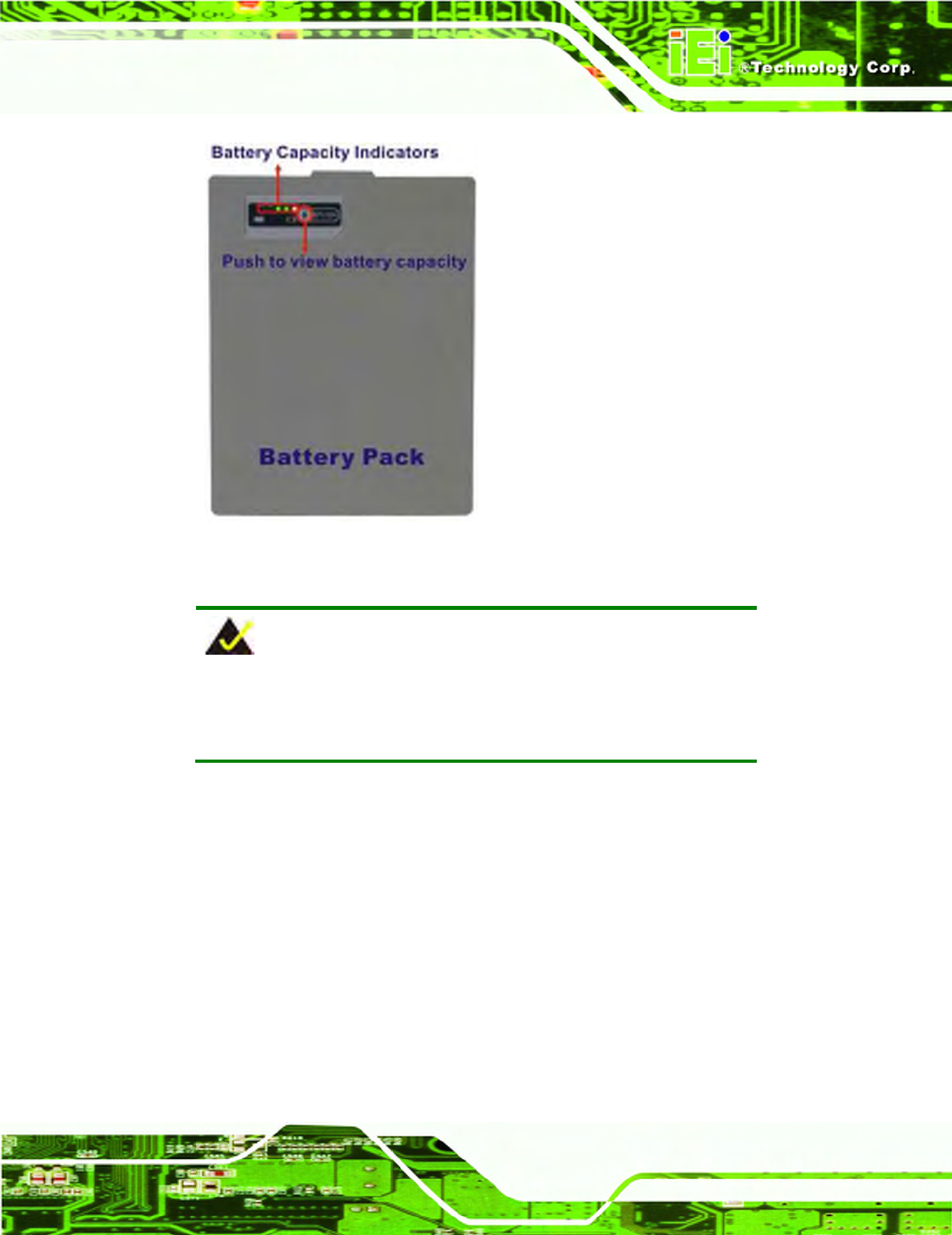
ICEFIRE-T10A Mobile Clinic Assistant
Page 19
Figure 3-4: Battery Capacity Indicators
NOTE:
The two batteries are hot swappable which means the user can replace
the battery with a fully charged battery without turning off the system.
3.1.1 Charge the Battery
The battery packs can be charged through the ICEFIRE-T10A or the optional docking
station.
3.1.1.1 Through the ICEFIRE-T10A
To charge the battery packs through the ICEFIRE-T10A, follow the steps below.
Step 1: Install the battery in the ICEFIRE-T10A (refer to Section
407H478H
3.1).
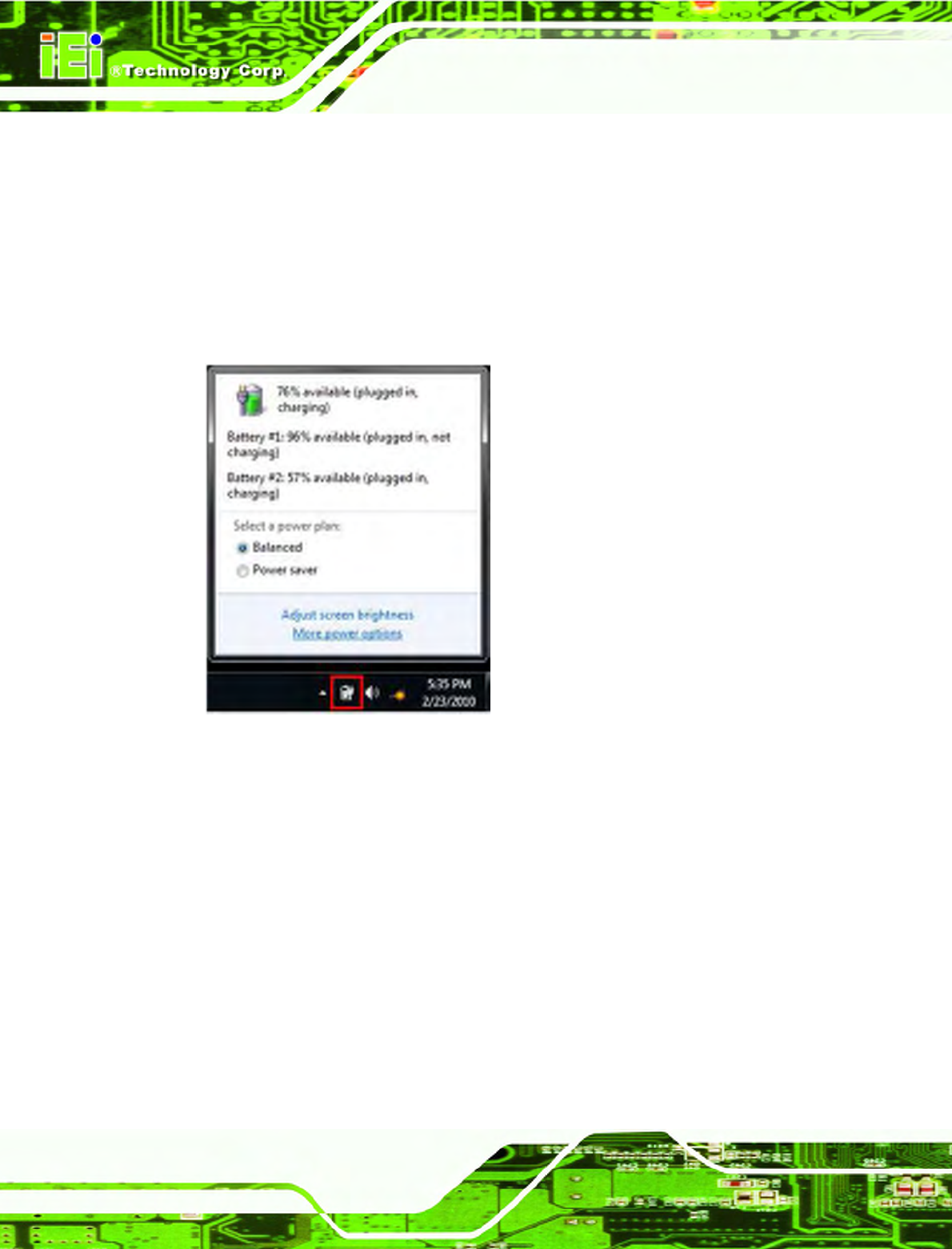
ICEFIRE-T10A Mobile Clinic Assistant
Page 20
Step 2: Connect the ICEFIRE-T10A with a power source through a power cable and the
power adapter.
Step 3: Turn on the ICEFIRE-T10A.
Step 4: The system starts to charge the battery packs. The battery capacity can be
checked via the capacity indicators on the battery (
408H479H
Figure 3-4) or via the
Windows 7 power management screen (
480H
Figure 3-5).
Figure 3-5: Windows 7 Power Management Screen
3.1.1.2 Through Optional Docking Station
To charge the battery packs through the optional docking station, follow the steps below.
Step 1: Insert the battery packs into the docking station as shown in
481H
Figure 3-6.
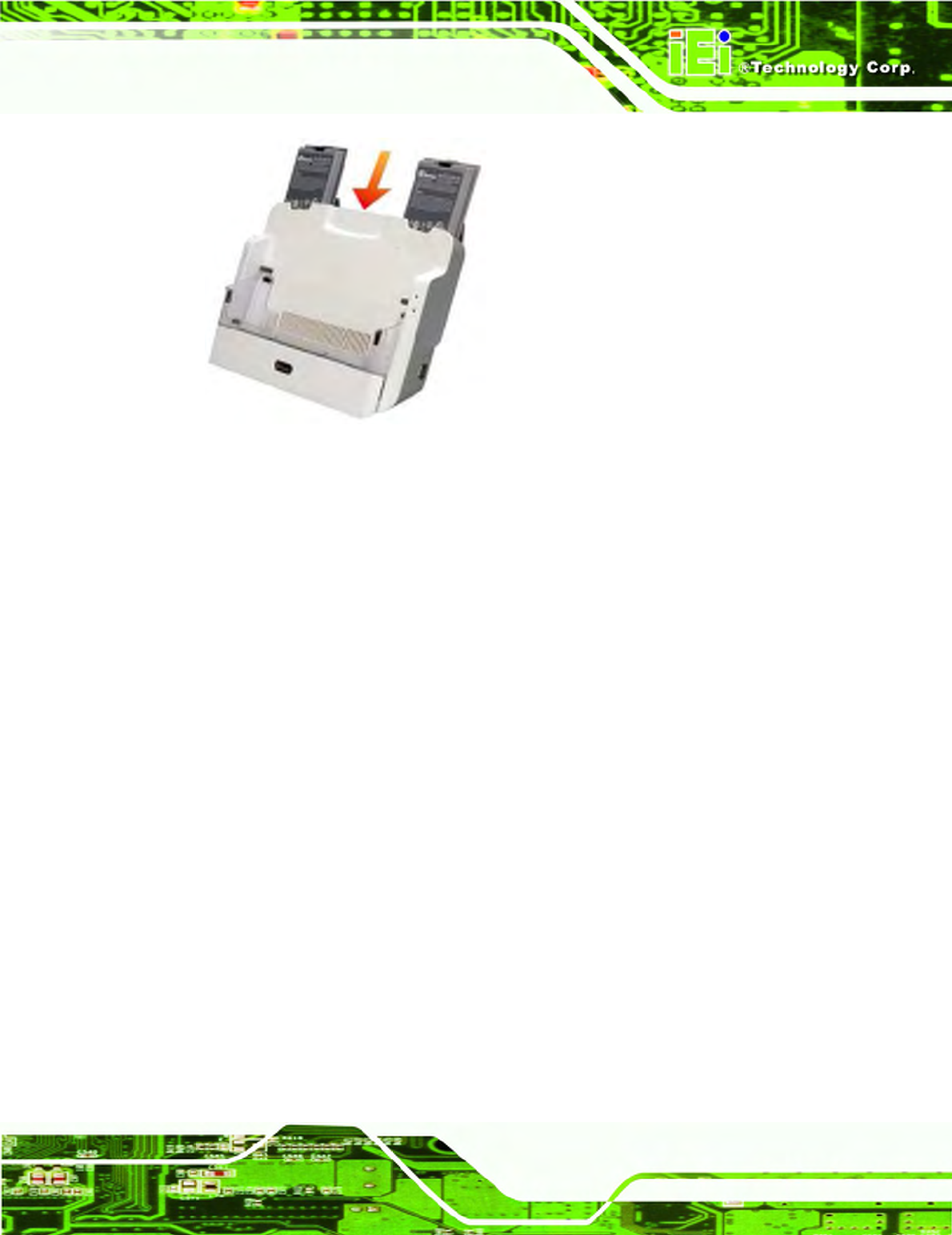
ICEFIRE-T10A Mobile Clinic Assistant
Page 21
Figure 3-6: Insert Batteries to Docking Station
Step 2: Connect the docking station with a power source through a power cable and the
power adapter.
Step 3: The docking station starts to charge the batteries.
3.2 Mounting the System (Optional)
The following installation options are available:
Docking Station
Wall mounting with optional Docking Station
The installation instructions are described in sections below.
3.2.1 Docking Station
To place the ICEFIRE-T10A on the optional docking station, follow the steps below.
Step 1: Release the docking station stand on the rear panel by unlocking the two
latches.
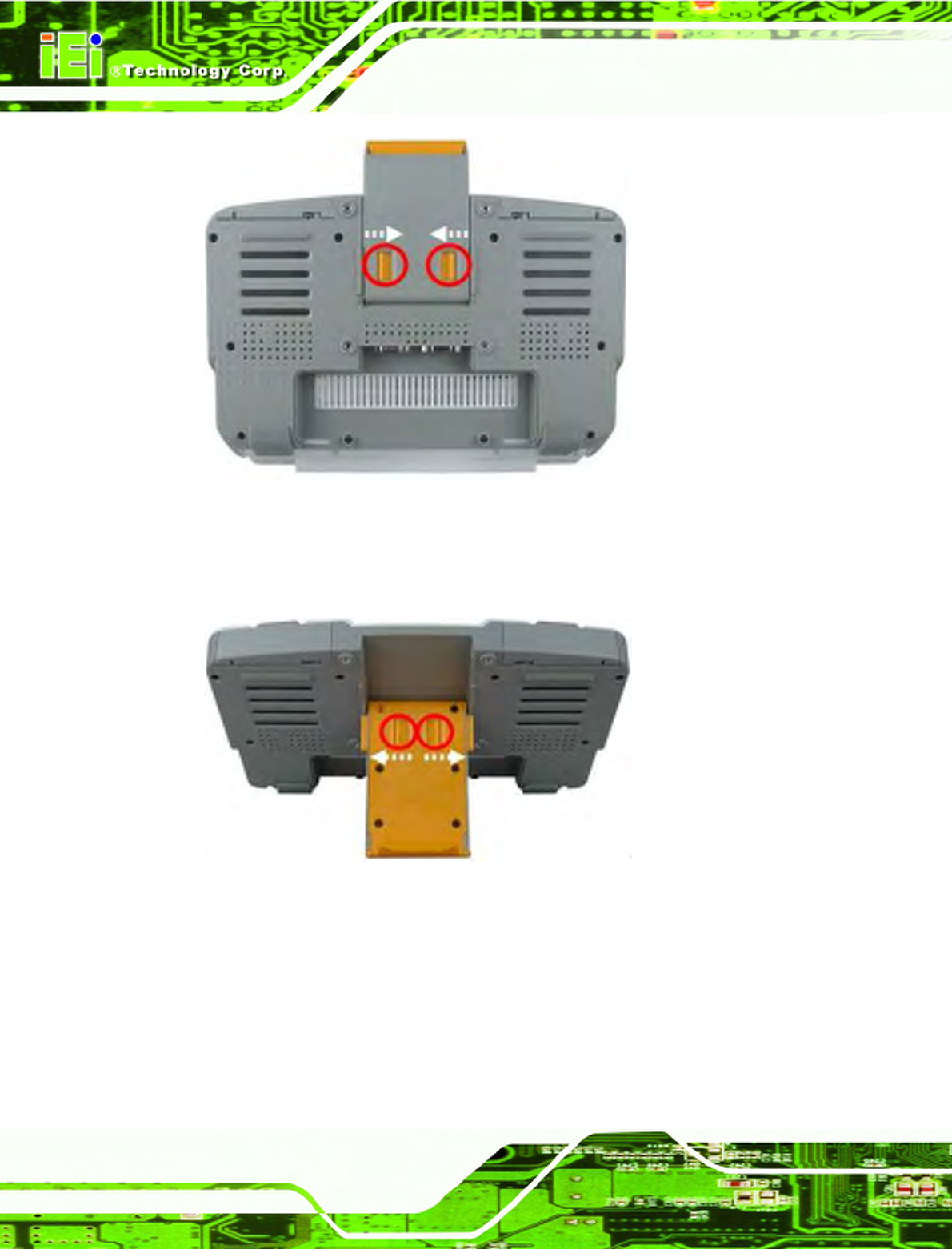
ICEFIRE-T10A Mobile Clinic Assistant
Page 22
Figure 3-7: Release the Stand
Step 2: Move the stand downward. Slide the two latches again to lock the stand into
place.
Figure 3-8: Lock the Stand
Step 3: Insert the ICEFIRE-T10A into the docking station. Step 0:
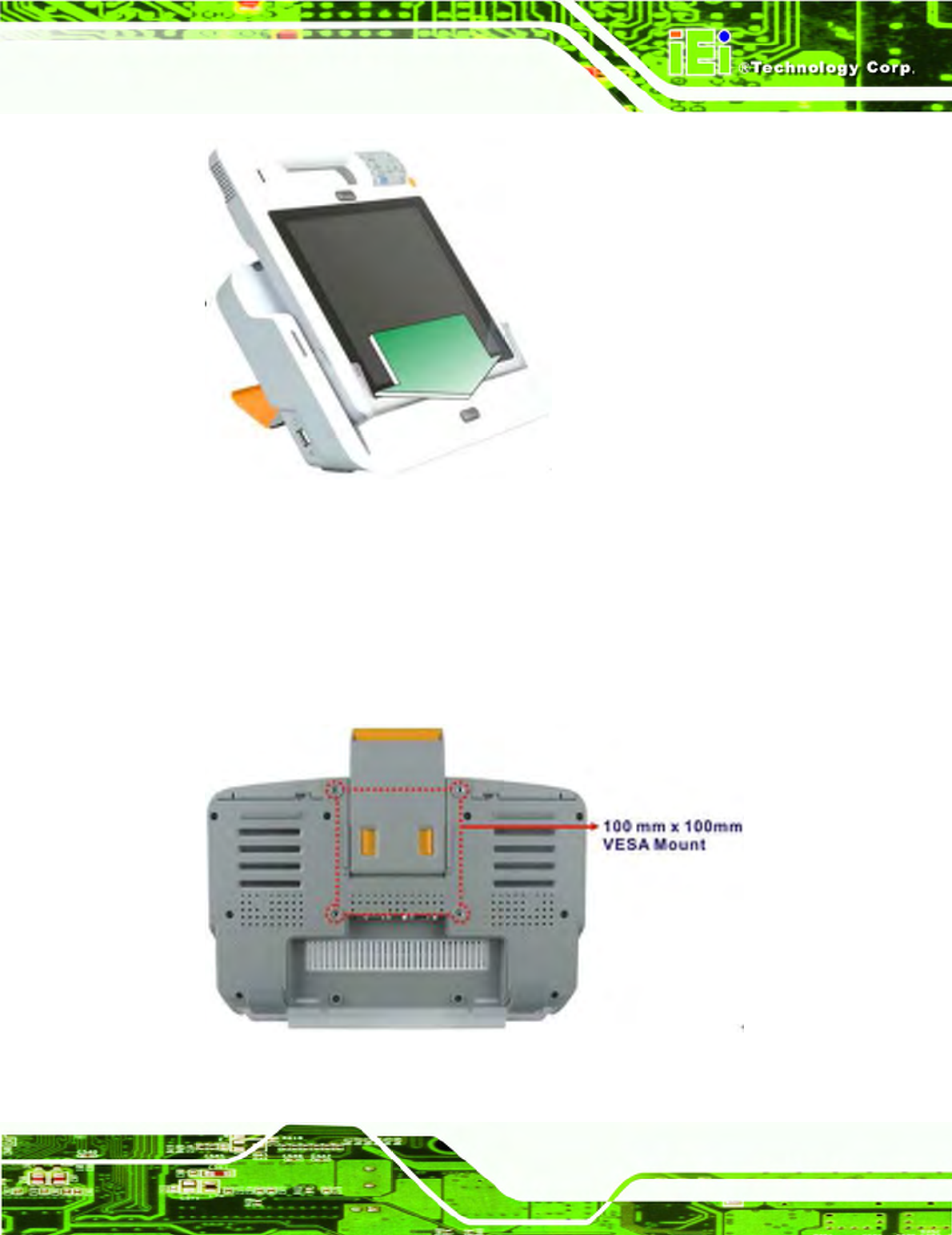
ICEFIRE-T10A Mobile Clinic Assistant
Page 23
Figure 3-9: Place the ICEFIRE-T10A to the Docking Station
3.2.2 Mounting with Docking Station
The optional docking station of the ICEFIRE-T10A can be installed on any VESA
compliant mounting device. The VESA mount retention screw holes of the docking station
are shown in
483H
Figure 3-10. Follow the instructions in the user manual of the mounting
device to mount the docking station securely.
Figure 3-10: VESA Mounting Retention Screw Holes
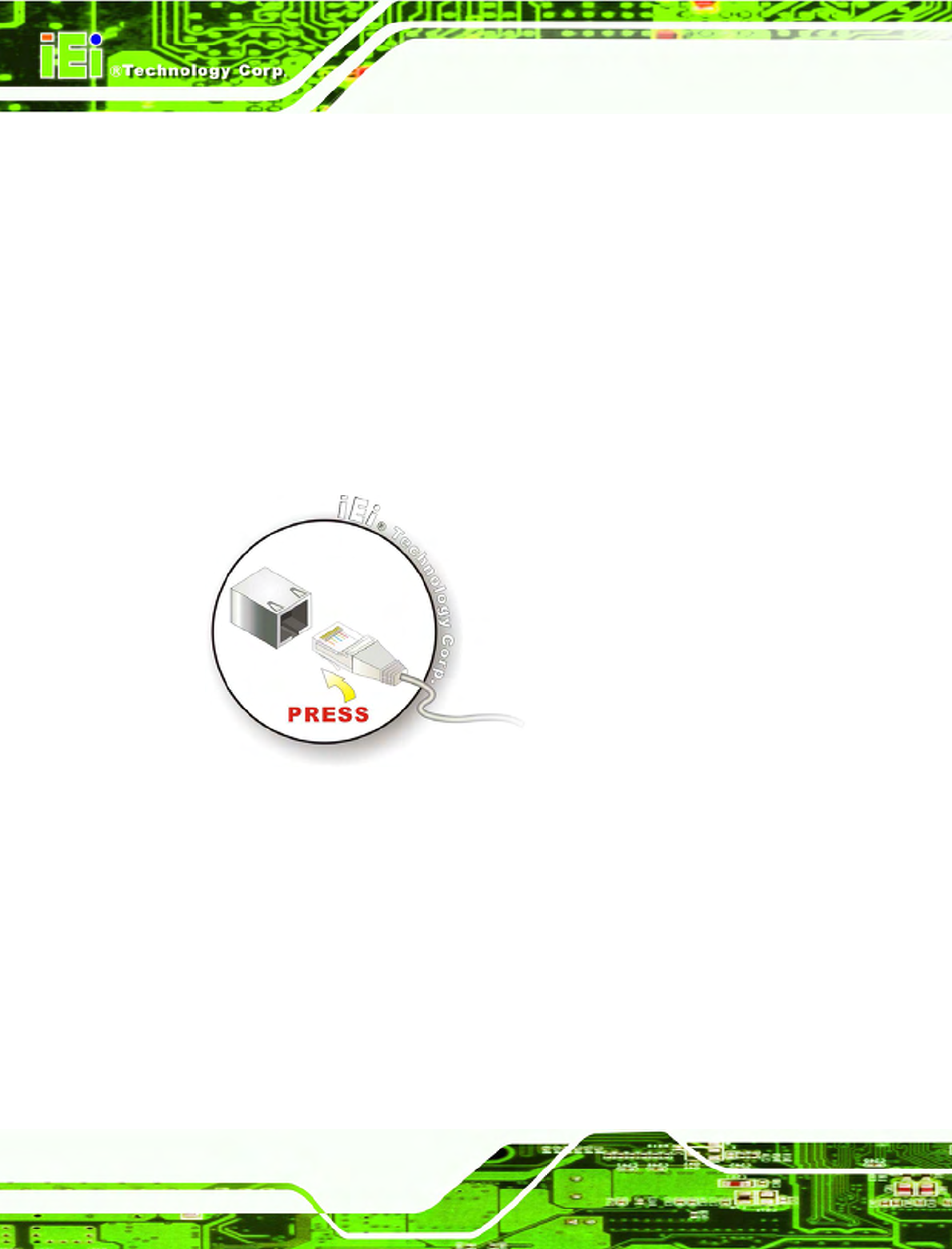
ICEFIRE-T10A Mobile Clinic Assistant
Page 24
3.3 I/O Connectors
3.3.1 LAN Connection
The RJ-45 connectors enable connection to an external network. To connect a LAN cable
with an RJ-45 connector, please follow the instructions below.
Step 1: Locate the RJ-45 connector on the rear panel. The locations of the USB
connectors are shown in
409H484H
Figure 1-4 in Chapter 1.
Step 2: Open the rubber cover.
Step 3: Align the connectors. Align the RJ-45 connector on the LAN cable with one of
the RJ-45 connectors on the bottom panel. See
410H485H
Figure 3-11.
Figure 3-11: LAN Connection
Step 4: Insert the LAN cable RJ-45 connector. Once aligned, gently insert the LAN
cable RJ-45 connector into the onboard RJ-45 port. Step 0:
3.3.2 USB Device Connection
There is one USB 2.0 connector located on the right side of the ICEFIRE-T10A. To
connect a USB 2.0 or USB 1.1 device, please follow the instructions below.
Step 1: Located the USB connector. The location of the USB connector is shown
in
411H486H
Figure 1-5.
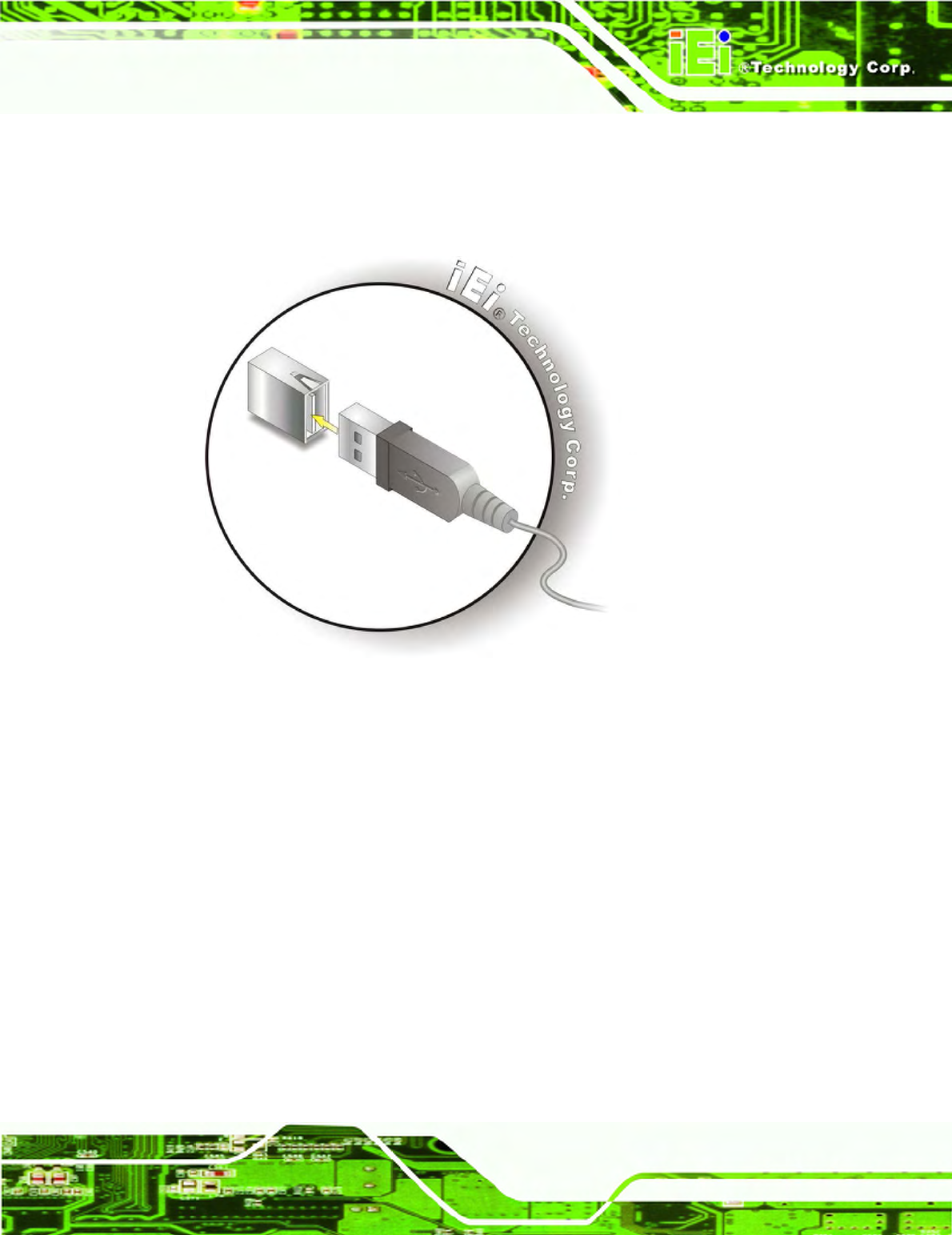
ICEFIRE-T10A Mobile Clinic Assistant
Page 25
Step 2: Open the rubber cover.
Step 3: Align the connectors. Align the USB device connector with the connector on
the ICEFIRE-T10A. See figure below.
Figure 3-12: USB Device Connection
Step 4: Insert the device connector. Once aligned, gently insert the USB device
connector into the on-board connector. Step 0:
3.4 Smart Card Reader Installation (Optional)
To install the optional smart card reader, please follow the steps below.
Step 1: Locate the USB port on the right side panel.
Step 2: Connect the smart card reader to the USB port on the side panel (
487H
Figure 3-13).
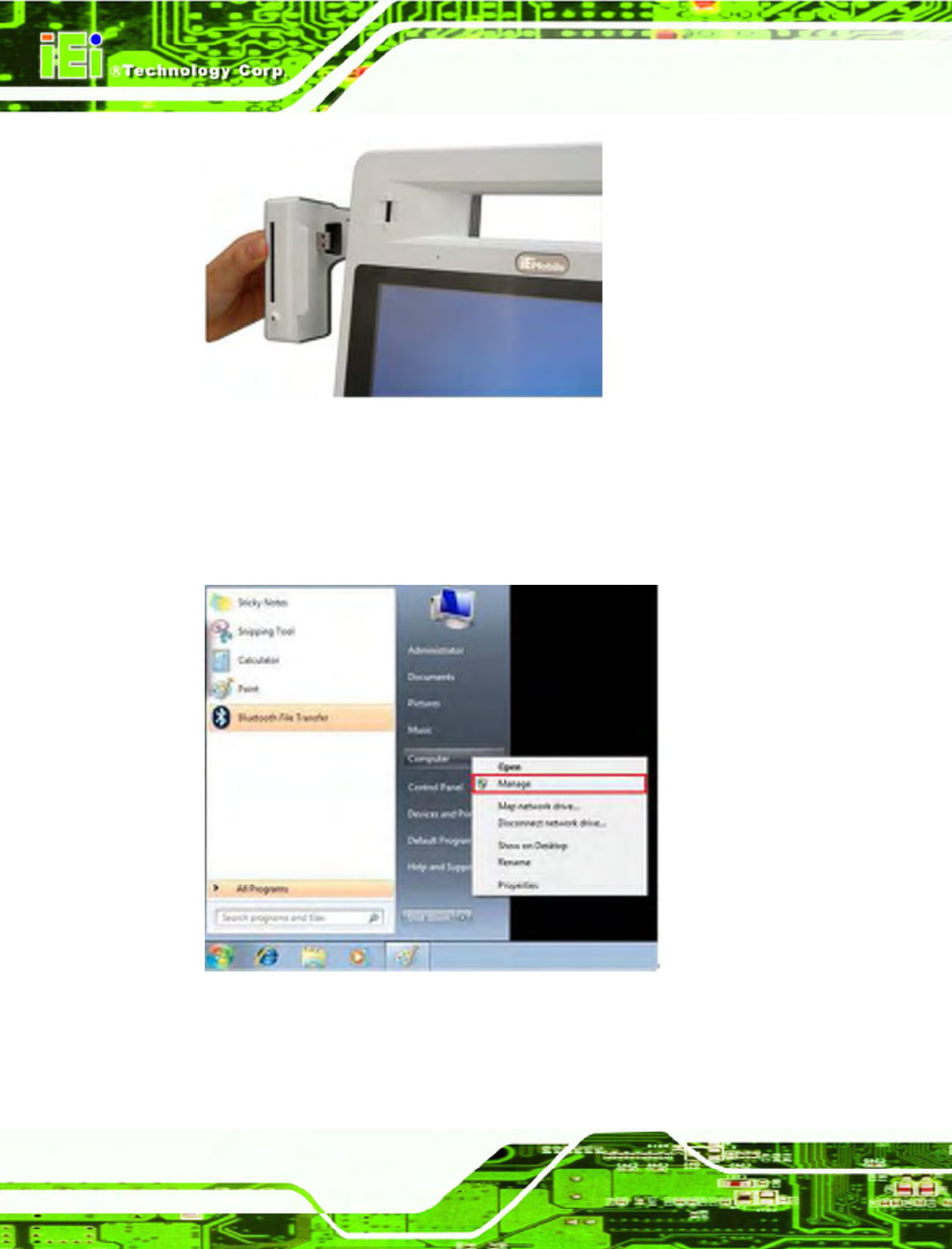
ICEFIRE-T10A Mobile Clinic Assistant
Page 26
Figure 3-13: Smart Card Reader Installation
Step 3: Turn on the ICEFIRE-T10A (refer to Section
488H
3.6).
Step 4: Right click “Computer” from the start menu and select “Manage”.
Figure 3-14: Smart Card Reader Setting 1
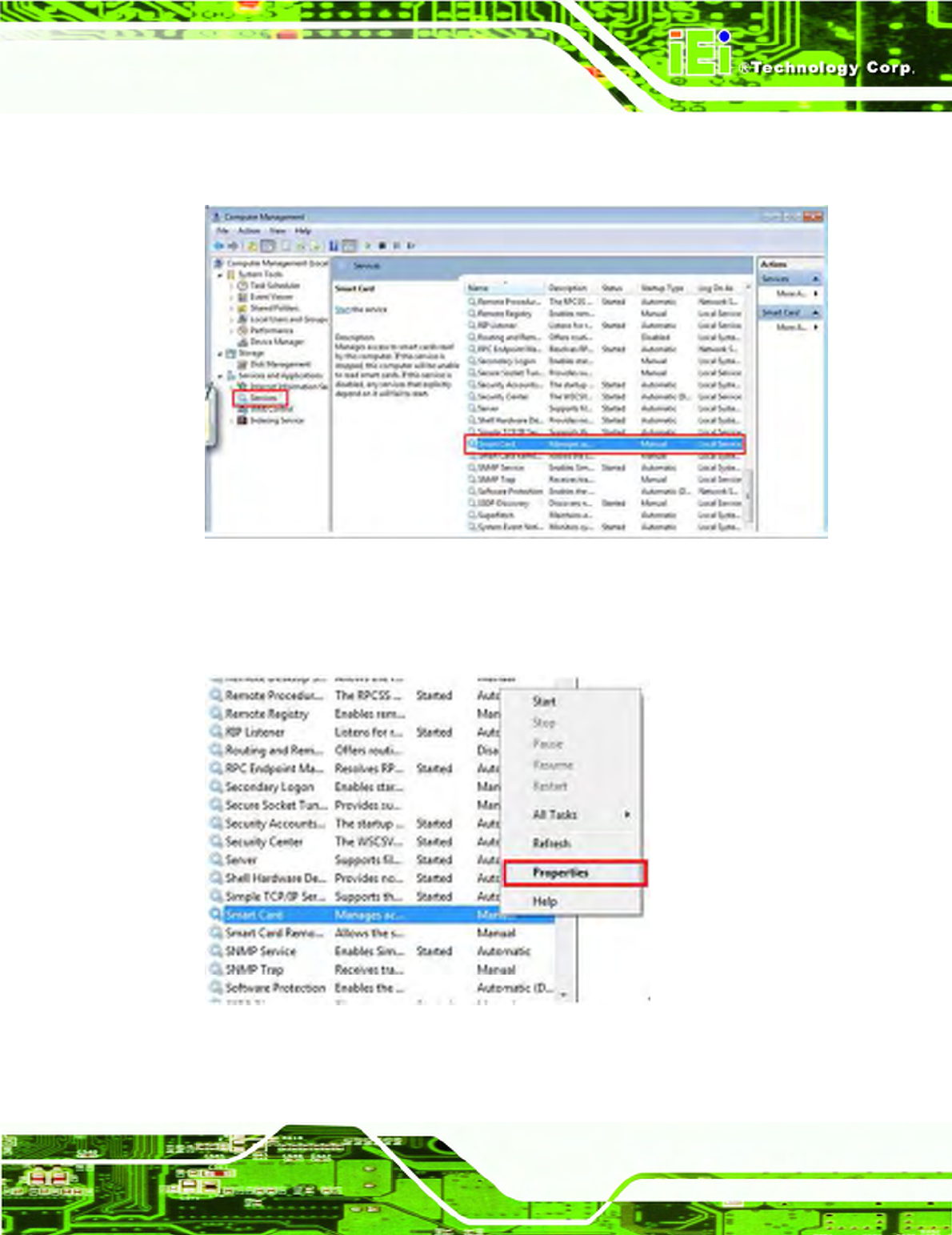
ICEFIRE-T10A Mobile Clinic Assistant
Page 27
Step 5: The Computer Management window appears. Select “Service” from the left
panel. Look for “Smart Card” in the service list.
Figure 3-15: Smart Card Reader Setting 2
Step 6: Right click “Smart Card” and select “Properties”.
Figure 3-16: Smart Card Reader Setting 3
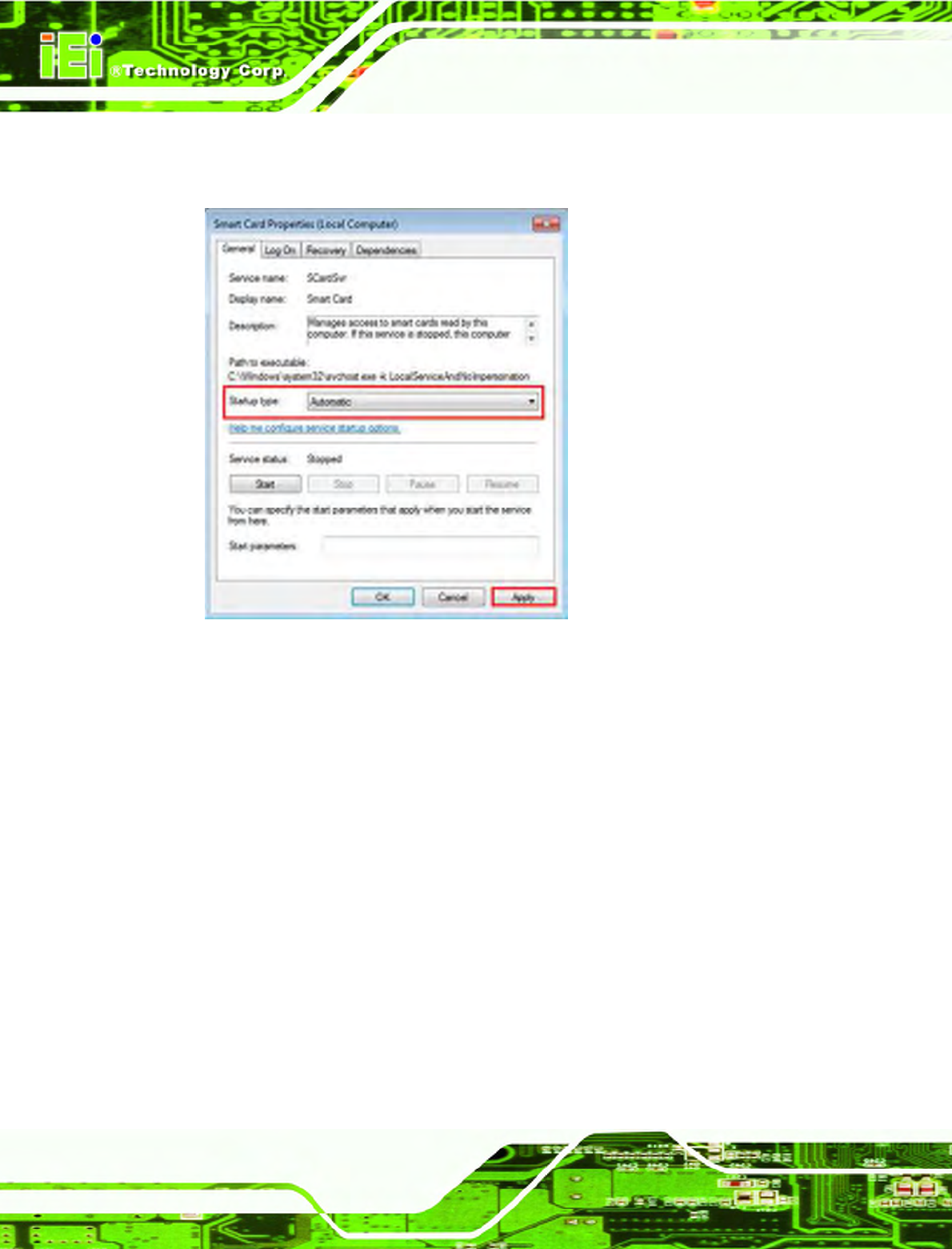
ICEFIRE-T10A Mobile Clinic Assistant
Page 28
Step 7: The Smart Card Properties window appears. Change the Startup type to
“Automatic”. Click Apply. Click OK to exit the properties window. Step 0:
Figure 3-17: Smart Card Reader Setting 4
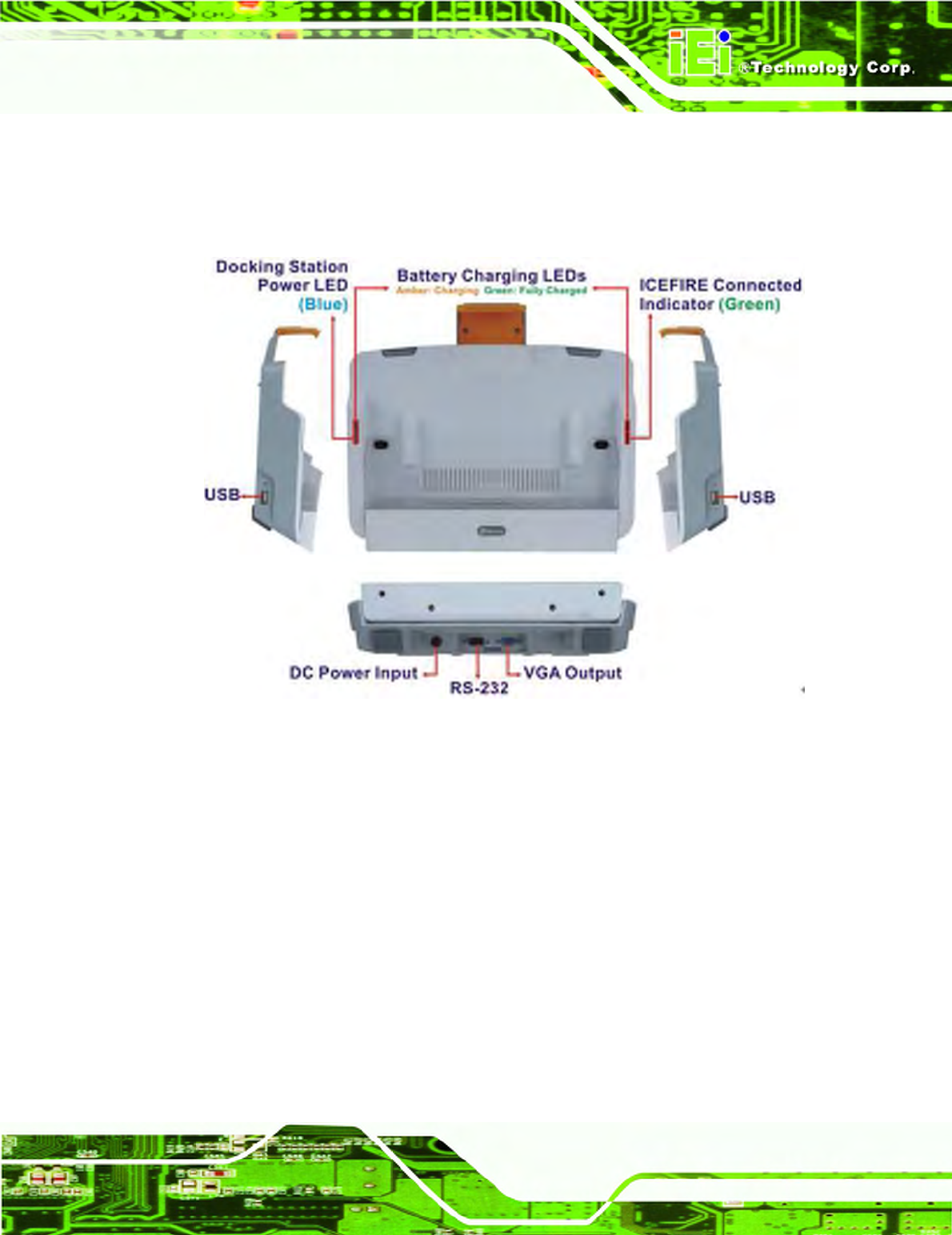
ICEFIRE-T10A Mobile Clinic Assistant
Page 29
3.5 Docking Station I/O Connectors (Optional)
The I/O connectors on the rear panel of the ICEFIRE-T10A Docking Station extend the
capabilities of the tablet PC but are not essential for operation (except power).
Figure 3-18: Docking Station I/O Connectors
3.5.1 Serial Device Connection
The ICEFIRE-T10A Docking Station has a male DB-9 serial device connector on the
bottom panel. The serial device connector is for connecting a RS-232 serial device. Follow
the steps below to connect a serial device to the tablet PC.
Step 1: Locate the DB-9 connector. The location of the DB-9 connector is shown
in
412H489H
Figure 3-18.
Step 2: Insert the serial connector. Insert the DB-9 connector of a serial device into
the DB-9 connector on the bottom panel. See
413H490H
Figure 3-19.
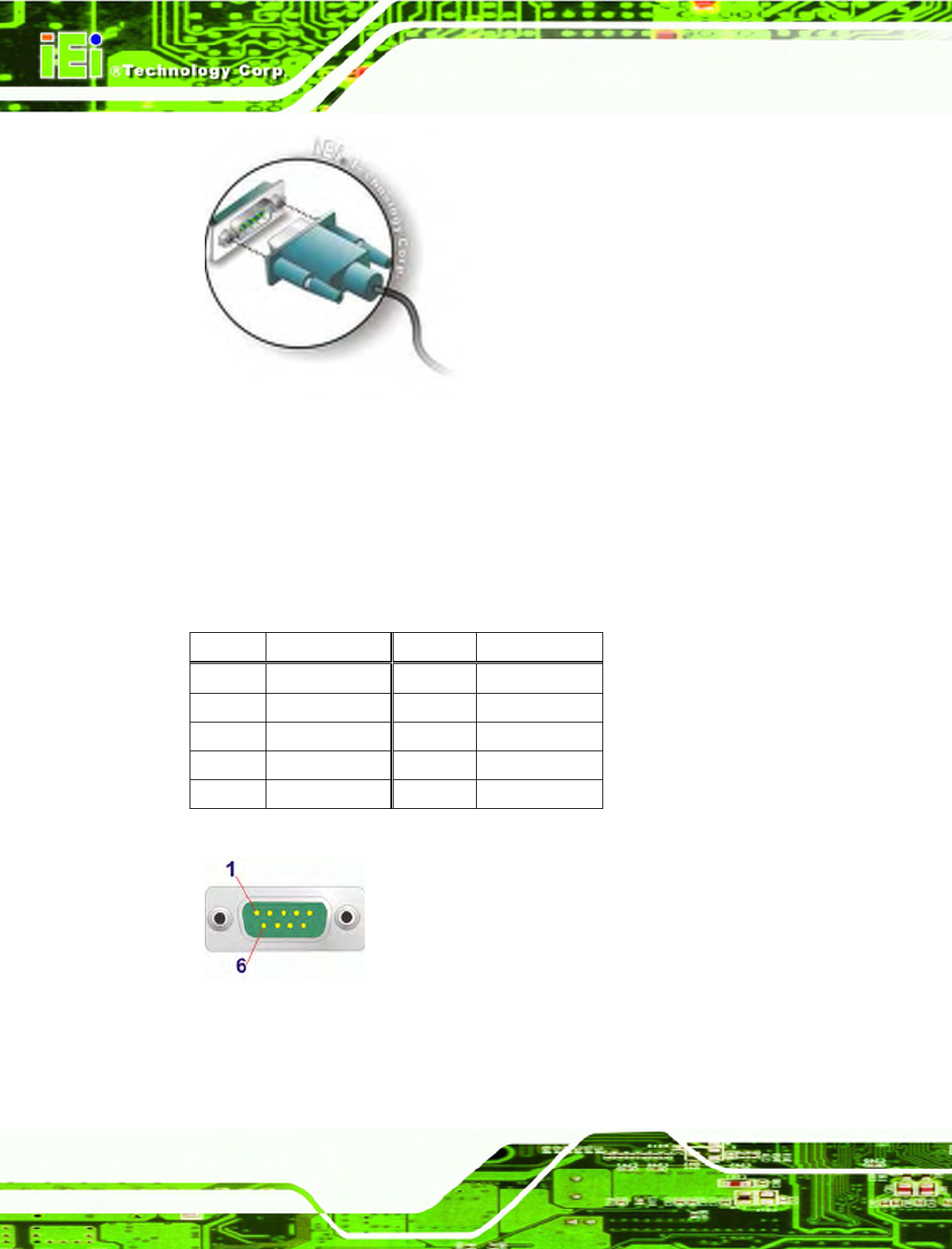
ICEFIRE-T10A Mobile Clinic Assistant
Page 30
Figure 3-19: Serial Device Connector
Step 3: Secure the connector. Secure the serial device connector to the external
interface by tightening the two retention screws on either side of the connector.
Step 0:
3.5.1.1 RS-232 Serial Port Pinouts
Following are the RS-232 serial port pinouts.
Pin Description Pin Description
1 DCD 6 DSR
2 RX 7 RTS
3 TX 8 CTS
4 DTR 9 RI
5 GND
Table 3-1: Serial Port Pinouts
Figure 3-20: Serial Port Pinouts
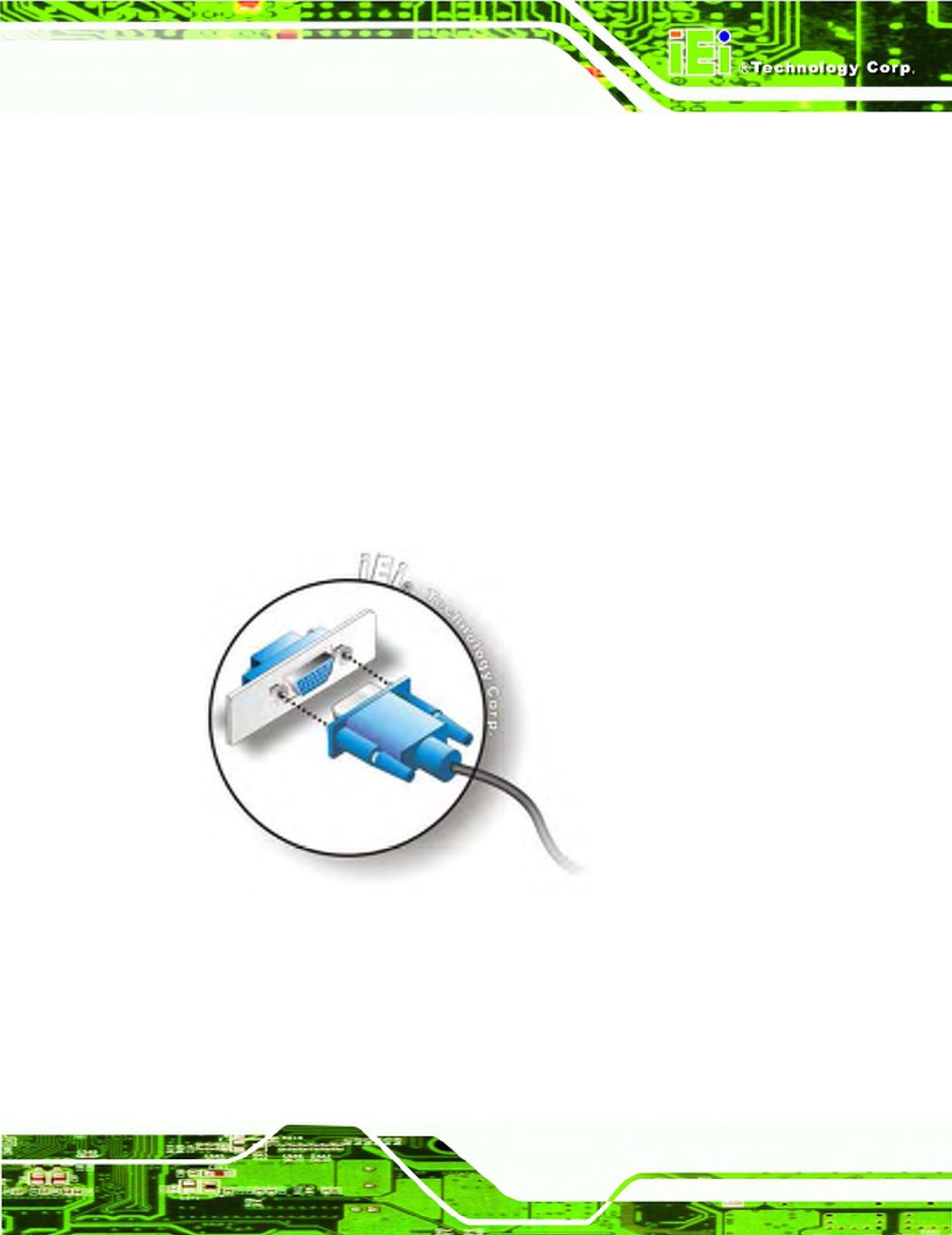
ICEFIRE-T10A Mobile Clinic Assistant
Page 31
3.5.2 VGA Monitor Connection
The ICEFIRE-T10A Docking Station has a single female DB-15 connector on the bottom
peripheral interface panel. The DB-15 connector is connected to a CRT or VGA monitor.
To connect a second monitor to the ICEFIRE-T10A, please follow the instructions below.
Step 1: Locate the female DB-15 connector. The location of the female DB-15
connector is shown in
414H491H
Figure 3-18.
Step 2: Align the VGA connector. Align the male DB-15 connector on the VGA screen
cable with the female DB-15 connector on the external peripheral interface.
Step 3: Insert the VGA connector. Once the connectors are properly aligned with the
insert the male connector from the VGA screen into the female connector on the
ICEFIRE-T10A. See
415H492H
Figure 3-21.
Figure 3-21: VGA Connector
Step 4: Secure the connector. Secure the DB-15 VGA connector from the VGA
monitor to the external interface by tightening the two retention screws on either
side of the connector. Step 0:
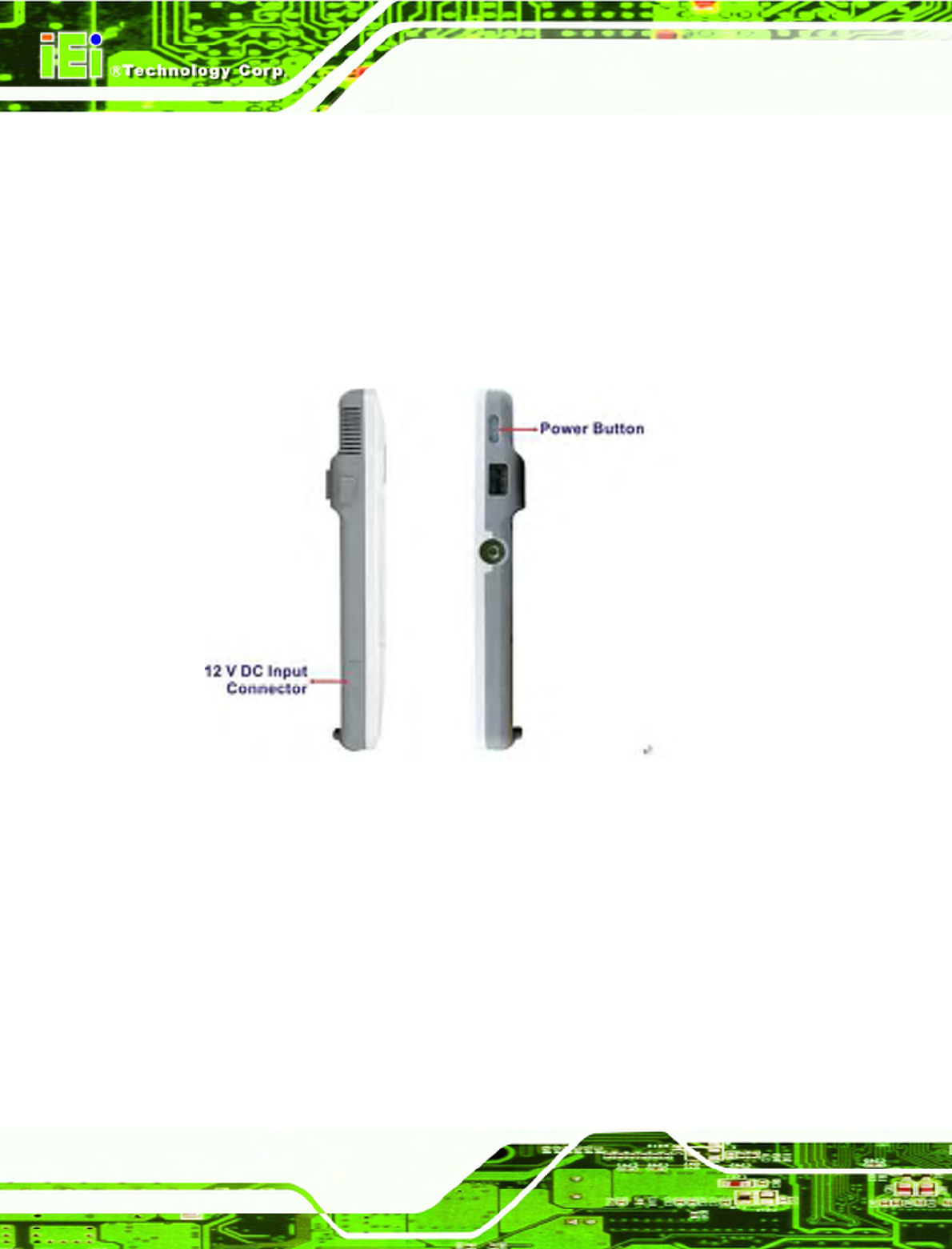
ICEFIRE-T10A Mobile Clinic Assistant
Page 32
3.6 Power-up the System
The power cable connects the power adapter to the power outlet. The power adapter and
power cable are required for operation of the ICEFIRE-T10A.
Step 1: Connect the power adapter to the ICEFIRE-T10A.
Step 2: Connect the power cable to the included power adapter.
Step 3: Connect the power cable to the power outlet.
Figure 3-22: Power-up the System
Step 4: Push the power button for one second to boot up the system. The green LED on
the button turns on. Step 0:
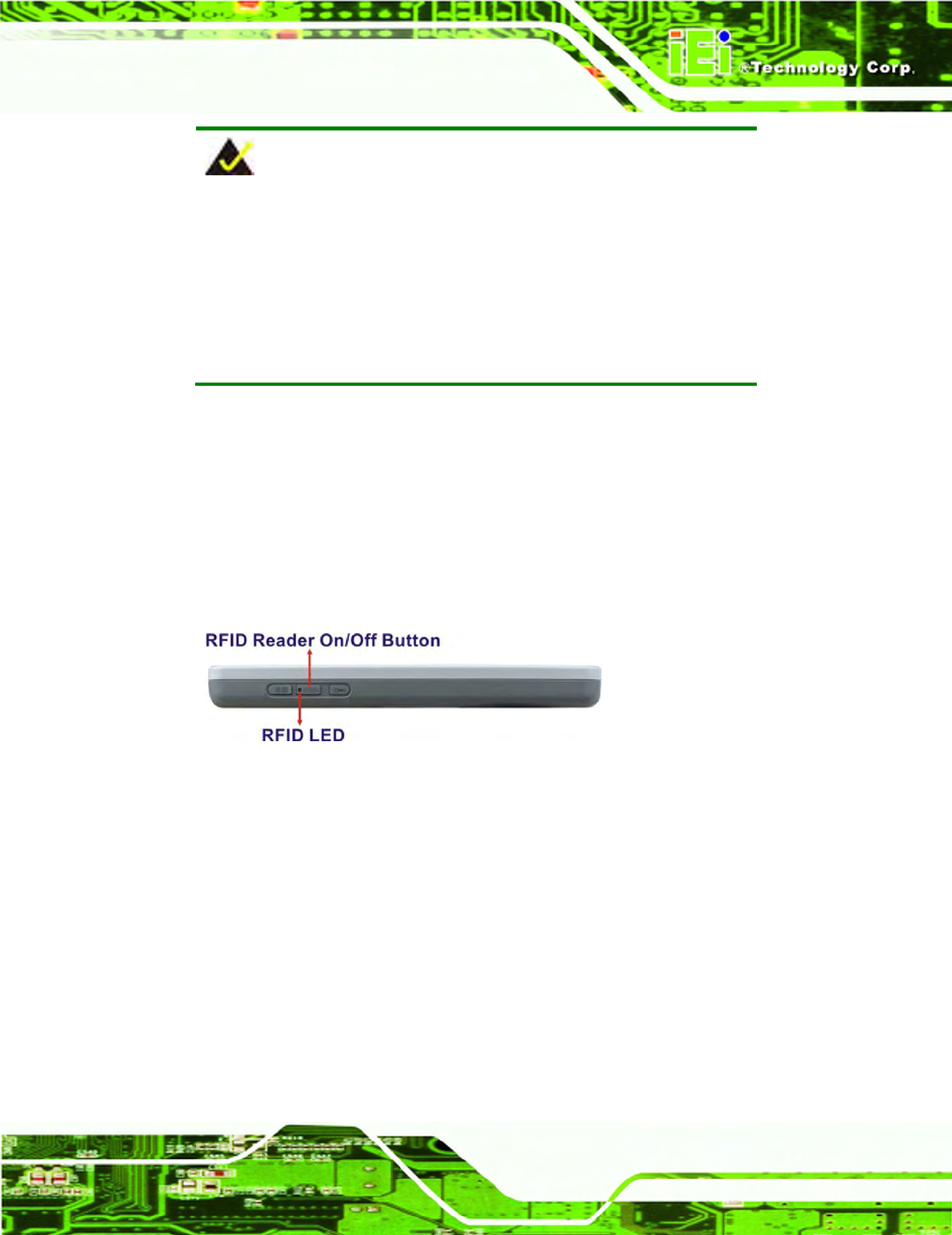
ICEFIRE-T10A Mobile Clinic Assistant
Page 33
NOTE:
Push the power button again to suspend the system or to resume from
the suspend mode. The solid green LED lights on when the system is
in suspend mode.
Push the power button for 2-3 seconds to shut down the system. The
green LED turns off.
3.7 Using RFID Reader
There is a RFID reader on the side panel (Figure 1-5). To enable the RFID reader, follow
the steps below.
Step 1: Push the RFID reader button on the top panel to turn on the RFID reader. The
blue LED on the button lights on.
Figure 3-23: RFID Reader On/Off Button
Step 2: Double click the IRFR-110 icon on the desktop.
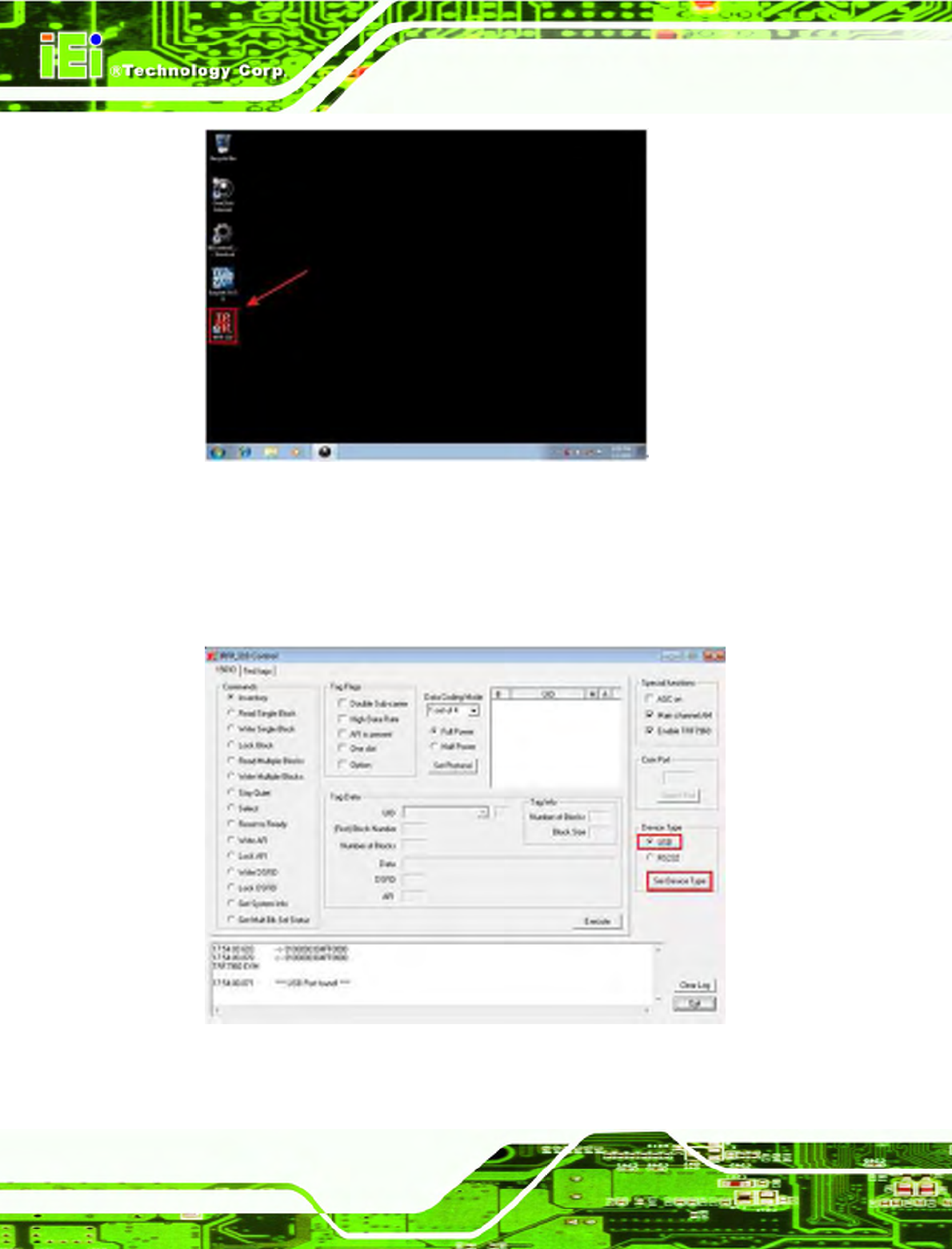
ICEFIRE-T10A Mobile Clinic Assistant
Page 34
Figure 3-24: IRFR-110 Icon
Step 3: The IRFR-110 window appears.
Step 4: Select USB and click the “Ser Device Type” button (Figure 3-25).
Figure 3-25: IRFR – Device Type
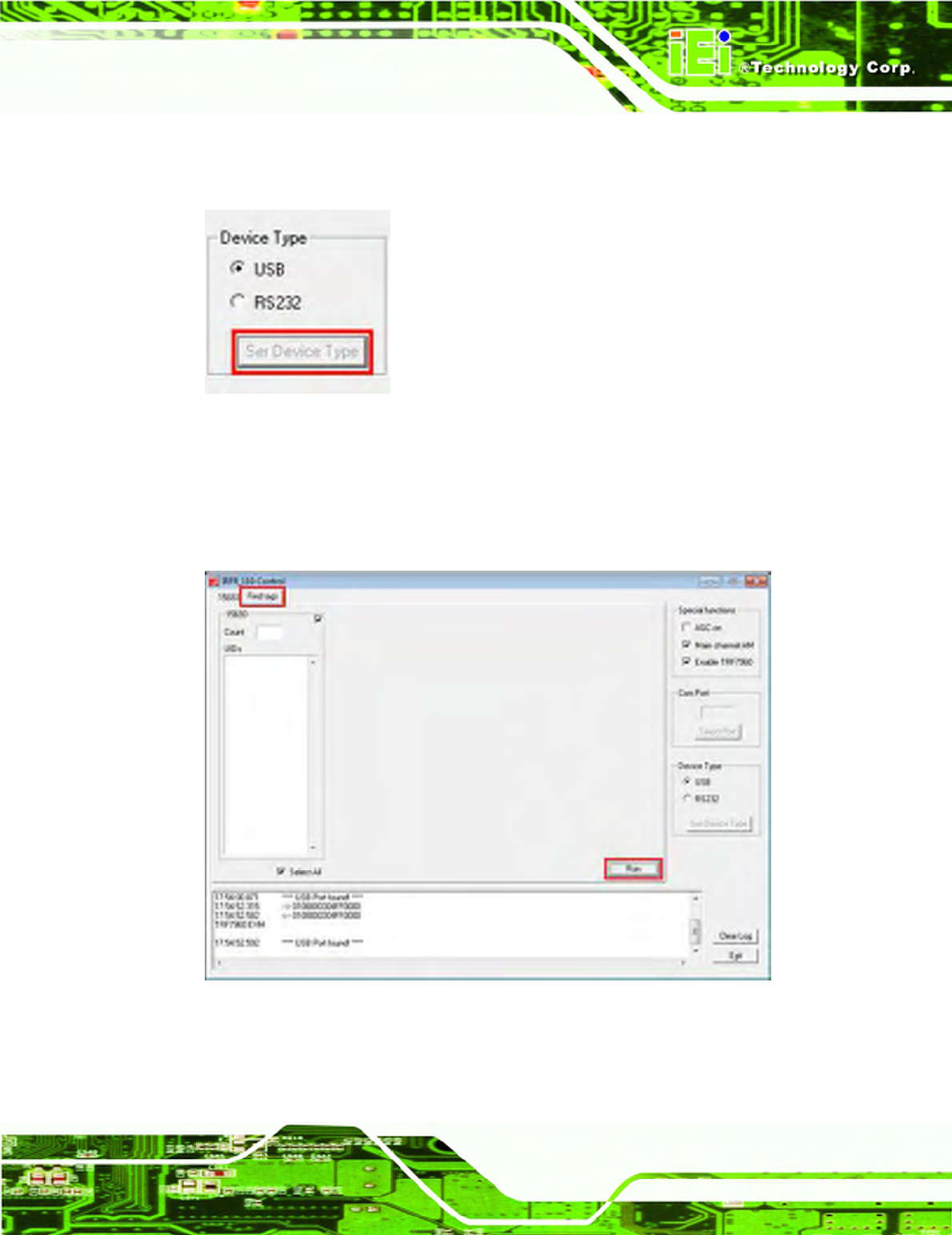
ICEFIRE-T10A Mobile Clinic Assistant
Page 35
Step 5: The “Ser Device Type” button is disabled (grayed out) to indicate that the RFID
reader is connected (Figure 3-26).
Figure 3-26: Ser Device Type Button Grayed Out
Step 6: Select the Find tags tab and click the Run button to enable the RFID reader
(Figure 3-27).
Figure 3-27: IRFR – Find Tags
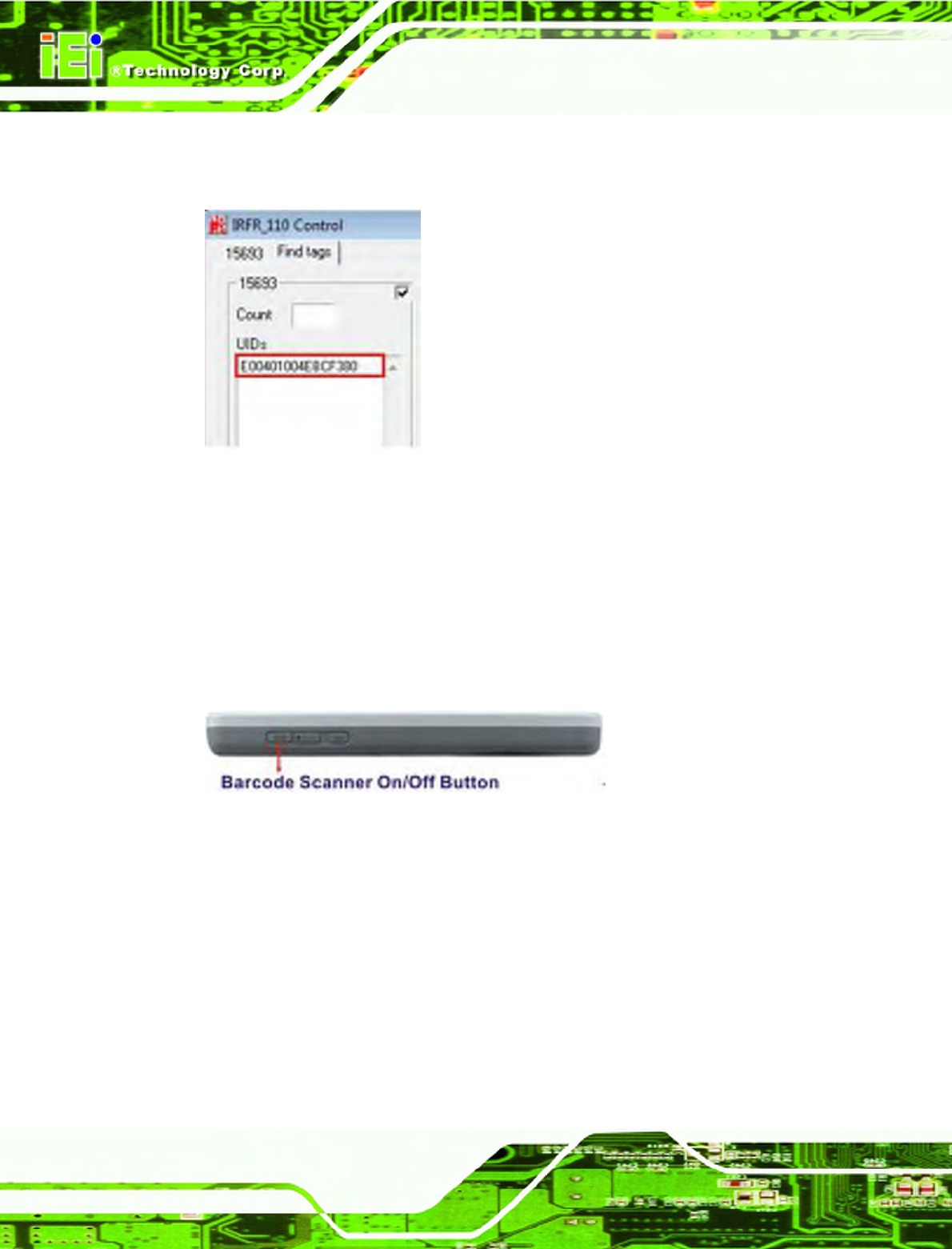
ICEFIRE-T10A Mobile Clinic Assistant
Page 36
Step 7: Use the RFID reader to read a RFID card, then the card number will be shown in
the UIDs column (Figure 3-28).
Figure 3-28: IRFR – UIDs
3.8 Using Barcode Scanner
There is a barcode scanner on the side panel (Figure 1-5). To use the barcode scanner,
follow the steps below.
Step 1: Push the barcode scanner button on the top panel to turn on the barcode
scanner. The LED of the barcode scanner on the side panel lights on.
Figure 3-29: Barcode scanner On/Off Button
Step 2: Launch EasySet from the system Start menu. The EasySet window appears
(Figure 3-30).
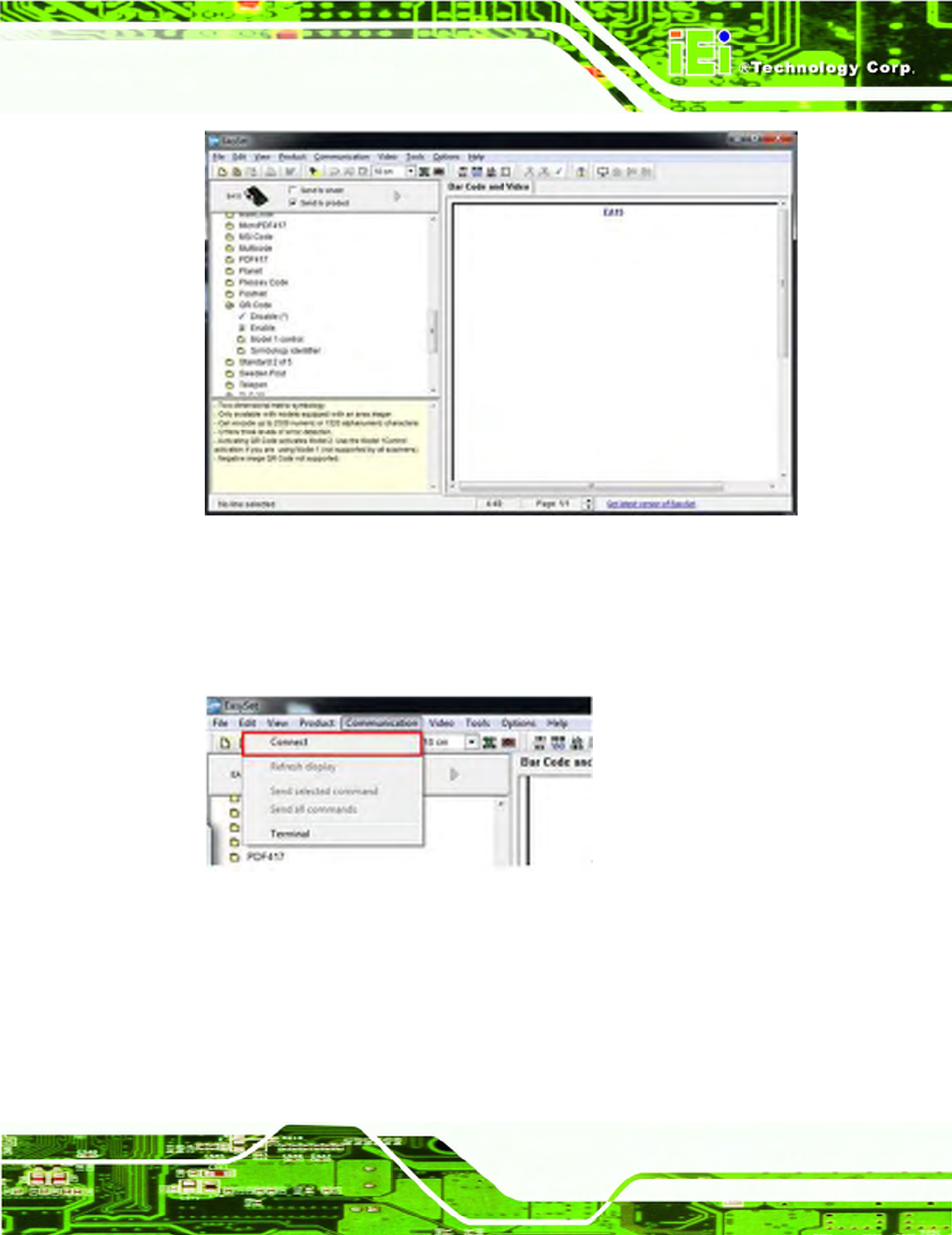
ICEFIRE-T10A Mobile Clinic Assistant
Page 37
Figure 3-30: EasySet Window
Step 3: Click Communication on the tool bar and select Connect from the drop-down
menu (Figure 3-31).
Figure 3-31: EasySet – Communication
Step 4: The Connection parameters window appears. Select COM2 (default) and click
Apply (Figure 3-32).
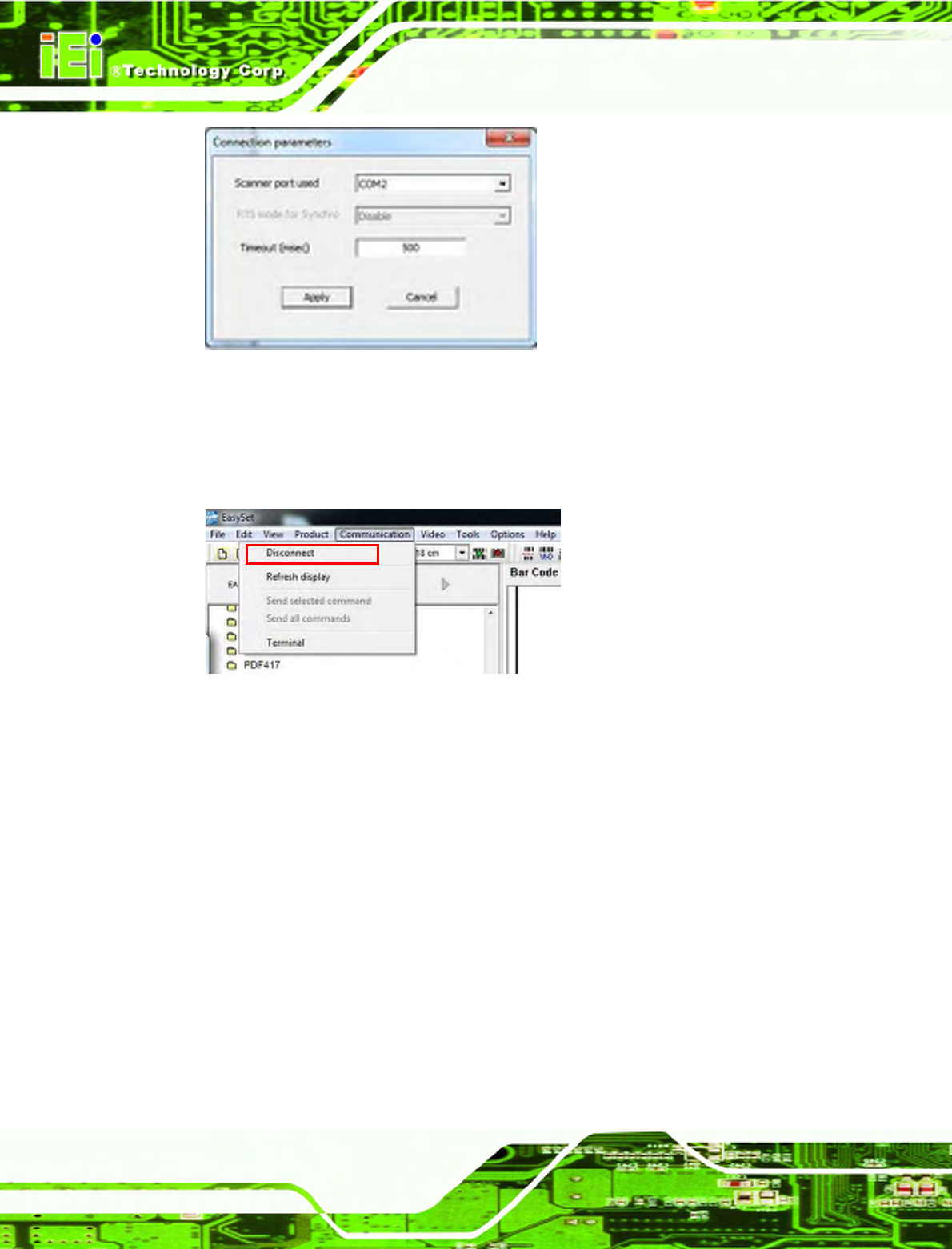
ICEFIRE-T10A Mobile Clinic Assistant
Page 38
Figure 3-32: Connection Parameters Window
Step 5: To check if the barcode scanner is connected to the EasySet, click
Communication again and see if the original option (Connect) has been
changed to Disconnect.
Figure 3-33: Communication – Disconnect
Step 6: To read the barcode information scanned by the reader, select Terminal from
the Communication drop-down menu. The barcodes will be displayed on the
right side (Figure 3-34). Step 0:
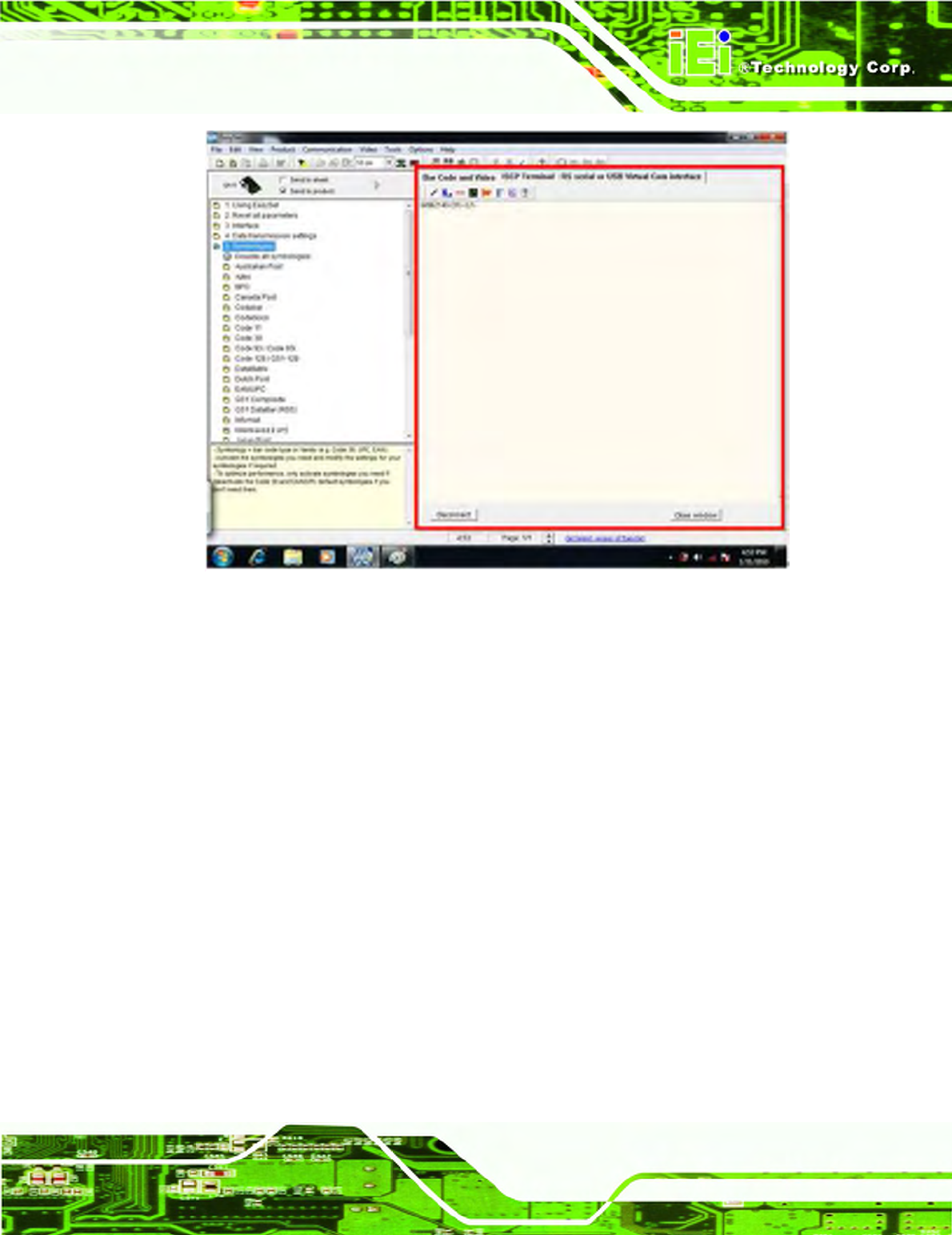
ICEFIRE-T10A Mobile Clinic Assistant
Page 39
Figure 3-34: Barcode Information Display Area
3.8.1 Barcode Setting
All of the barcode parameters can be modified through EasySet. To be able to modify the
parameters, please make sure to connect the EasySet with the barcode scanner (refer to
Section 3.8). Follow the steps below to modify the parameters.
Step 1: The left side of the EasySet window (Figure 3-35) displays all parameters that
can be configured.
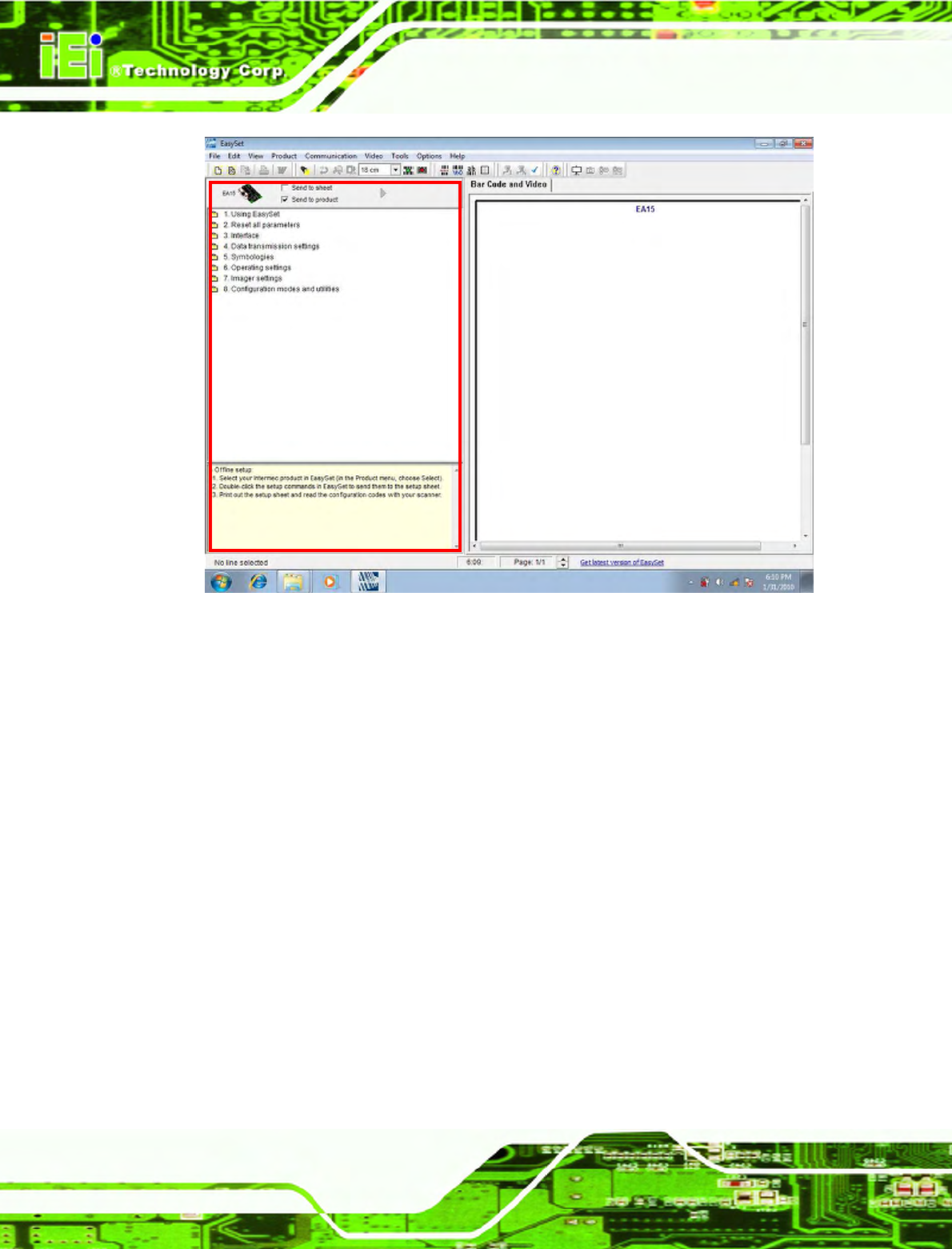
ICEFIRE-T10A Mobile Clinic Assistant
Page 40
Figure 3-35: Barcode Parameters
Step 2: Use the Symbologies section to setup the format that can be read by the
barcode scanner (EA15). In the default setting, only the PDF417 format of 2-D
barcodes is enabled. If other formats are needed, the user must enable them
here. Take Aztec as an example. The Aztec is disabled (the Disable option is
checked). Double click the Enable option to enable Aztec format. See Figure
3-36.
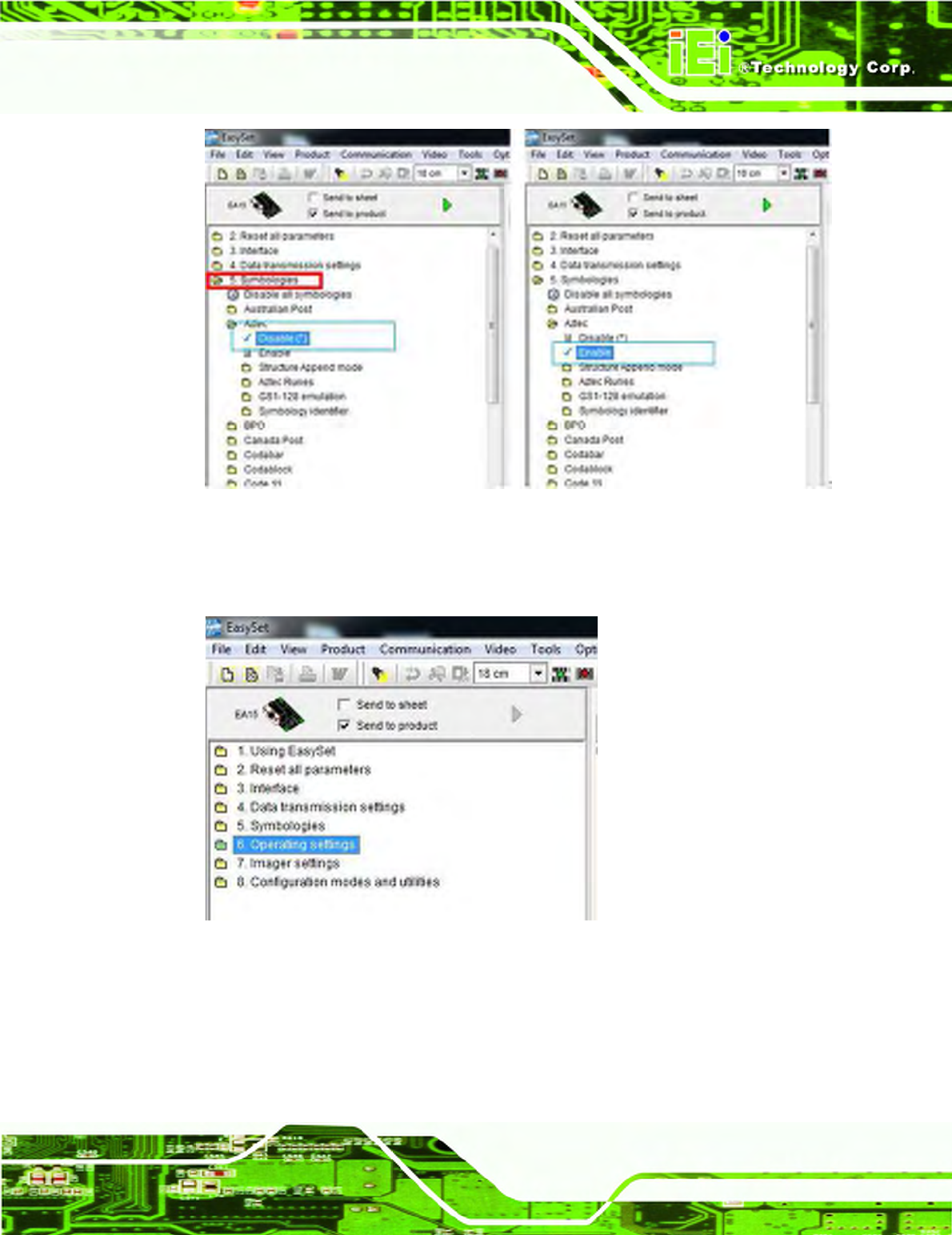
ICEFIRE-T10A Mobile Clinic Assistant
Page 41
Figure 3-36: Symbologies
Step 3: Use the Operating settings section to configure barcode triggering modes,
decoding security and beeps, etc.
Figure 3-37: Operating Settings
Step 4: In the Scanning/Triggering section of operating settings, the user can set the
triggering mode, continuous, level, etc.
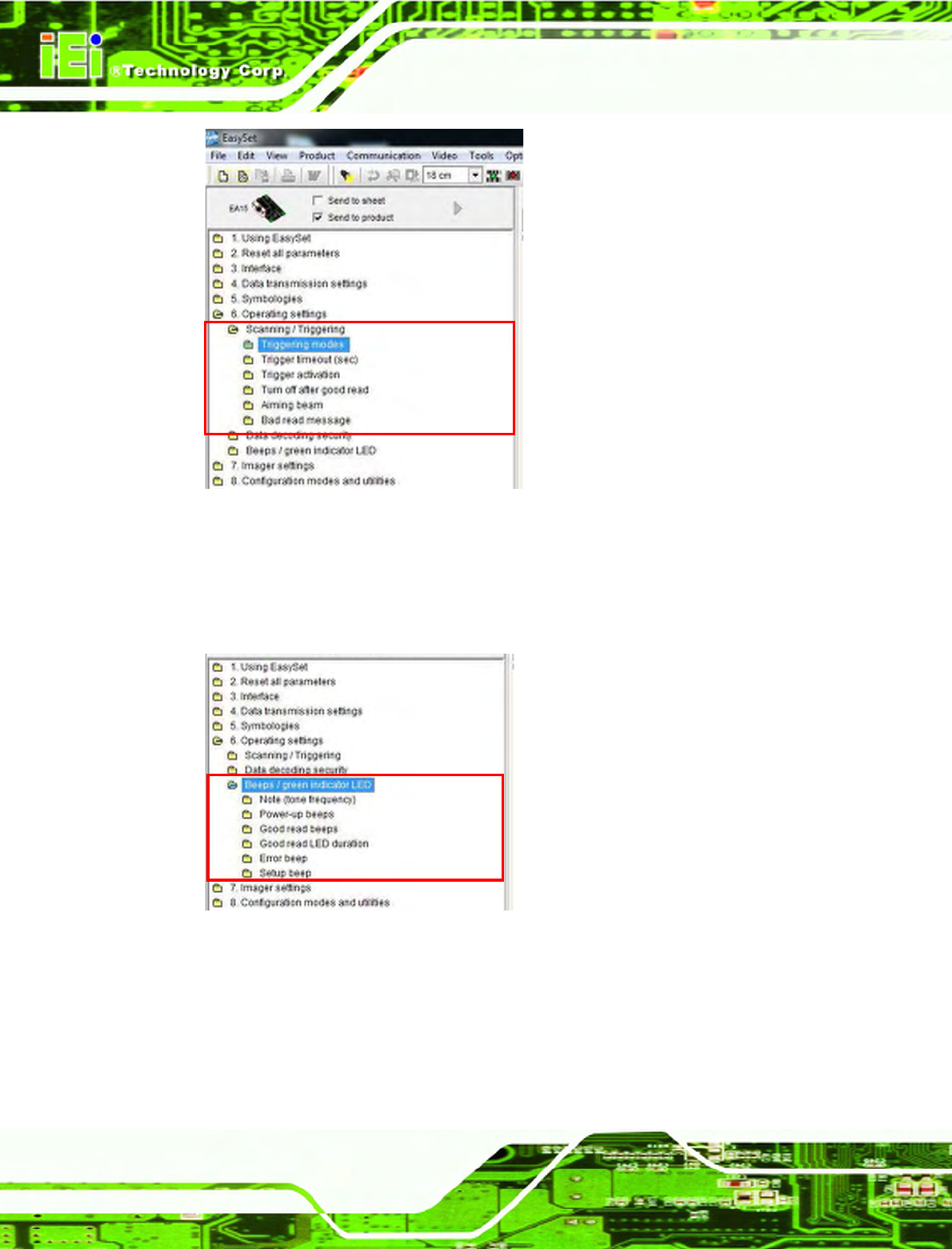
ICEFIRE-T10A Mobile Clinic Assistant
Page 42
Figure 3-38: Scanning/Triggering
Step 5: In the Beeps/green indicator LED section of operating settings, the user can
configure the beep sound of the barcode scanner. Step 0:
Figure 3-39: Beeps/Green Indicator LED
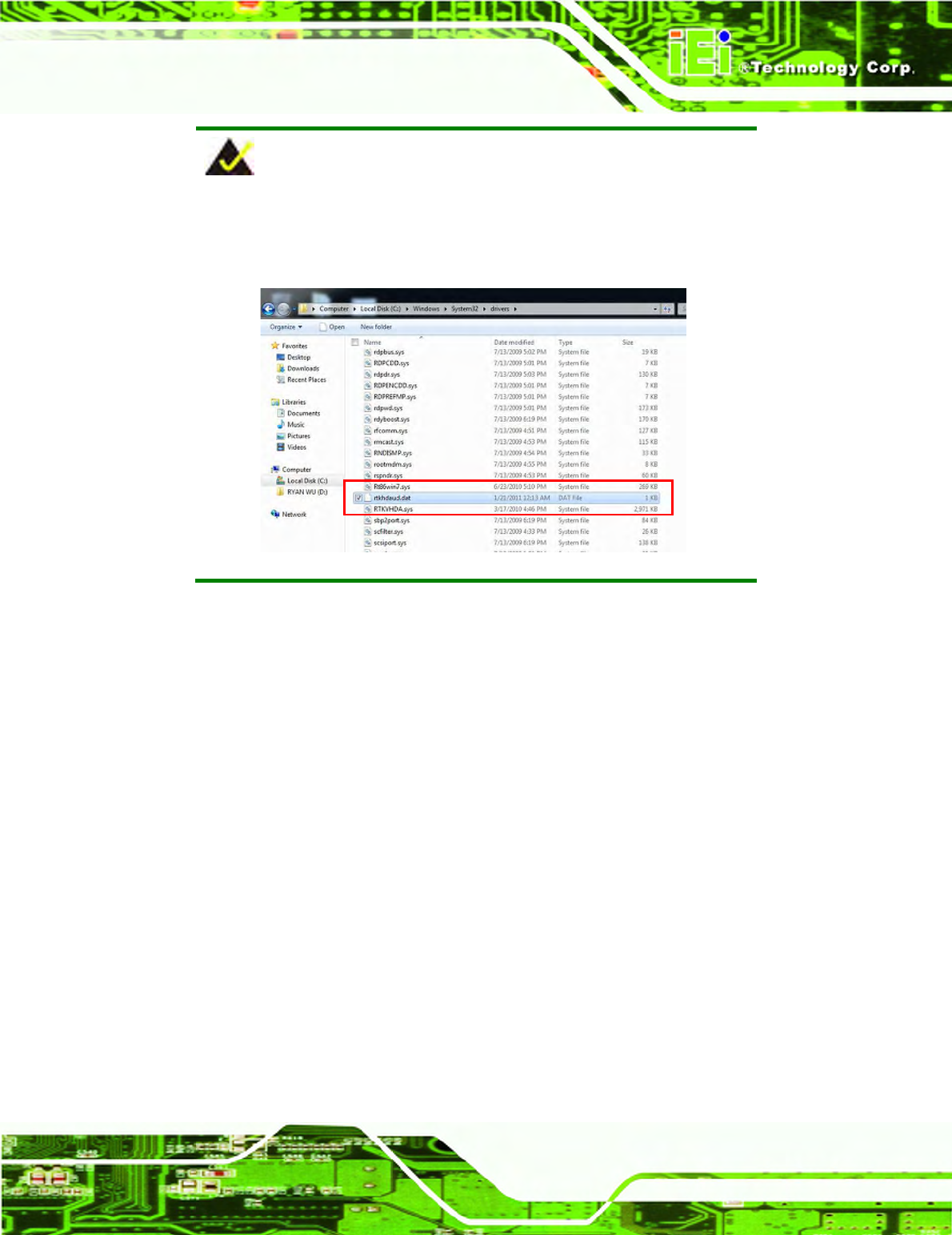
ICEFIRE-T10A Mobile Clinic Assistant
Page 43
NOTE:
If no beep sound, please check if the “rtkhdaud.dat” file is in
C:\windows\system32\drivers
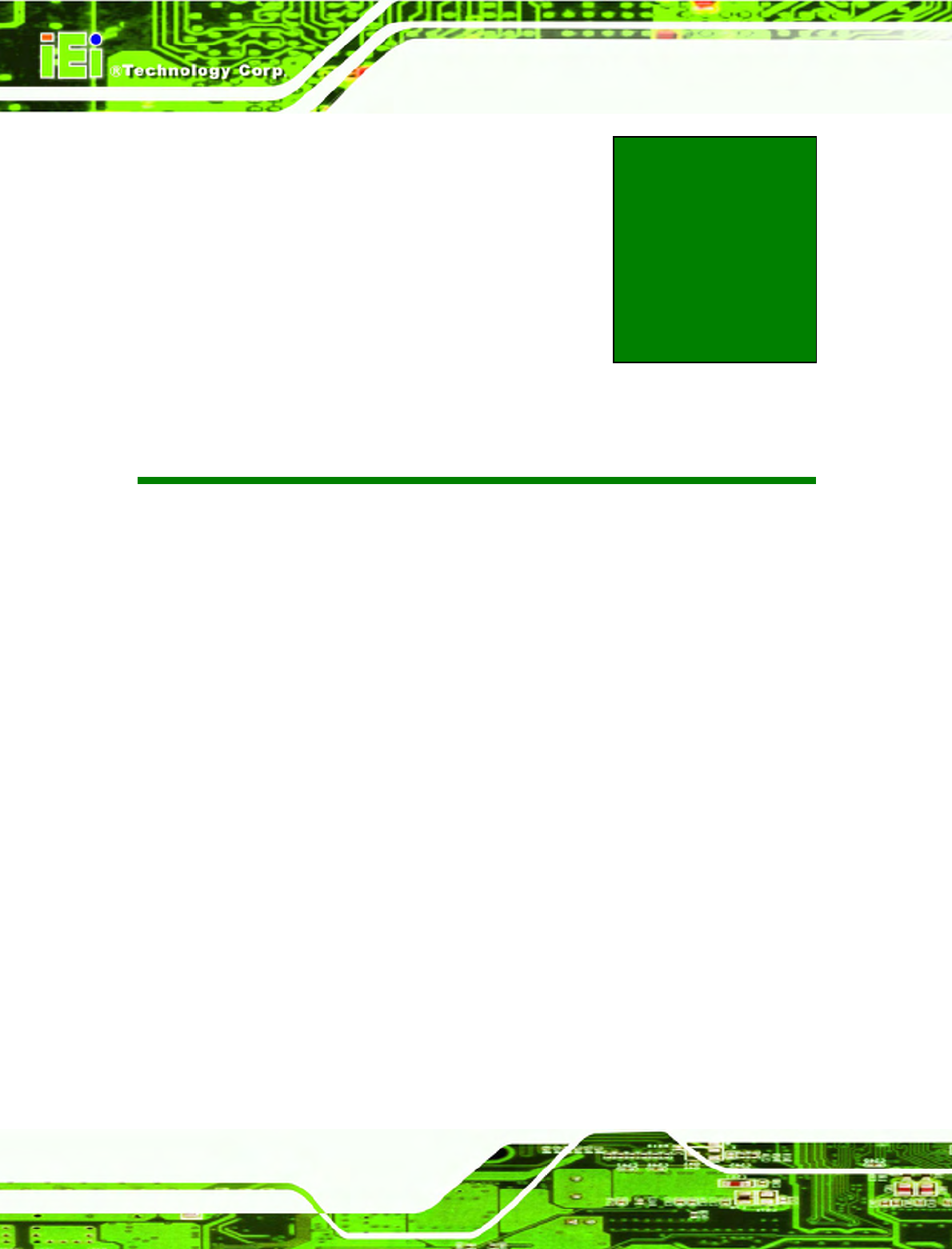
ICEFIRE-T10A Mobile Clinic Assistant
Page 44
Chapter
4
4 Driver Installation
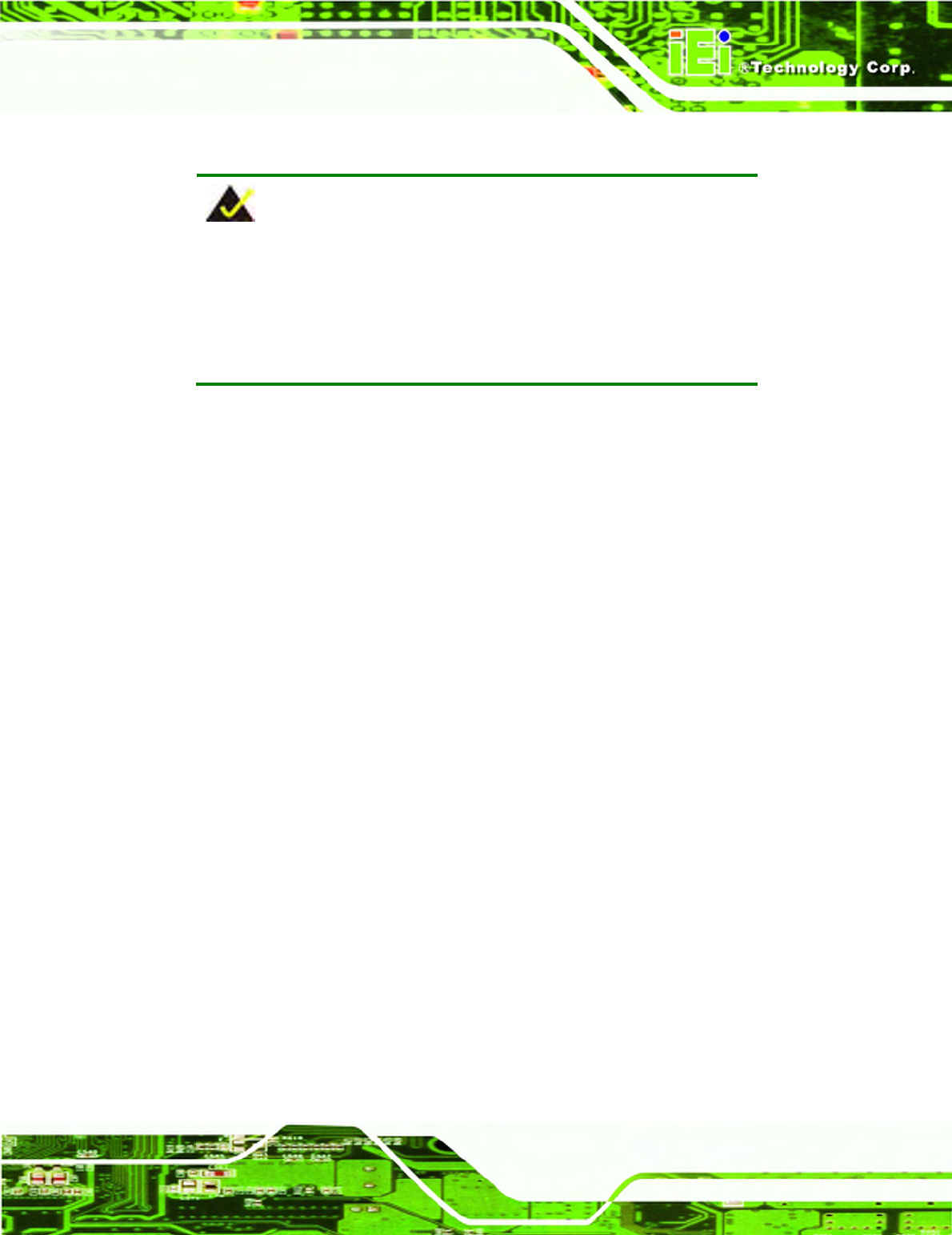
ICEFIRE-T10A Mobile Clinic Assistant
Page 45
4.1 Available Software Drivers
NOTE:
The contents of the driver folder (ICEFIRE-T10A Driver) may vary
throughout the life cycle of the product and is subject to change without
prior notice. Visit the IEI website or contact technical support for the
latest updates.
The following drivers can be installed on the system:
Graphics driver
LAN driver
Audio driver
Fingerprint reader driver
Barcode scanner driver
Bluetooth driver
All drivers are located in “ICEFIRE-T10A Driver” folder of the system. Installation
instructions are given below.
4.2 Intel® Graphics Driver
To install the graphics driver, please follow the steps below.
Step 1: Select Graphics from the list in
416H493H
Figure 4-1.
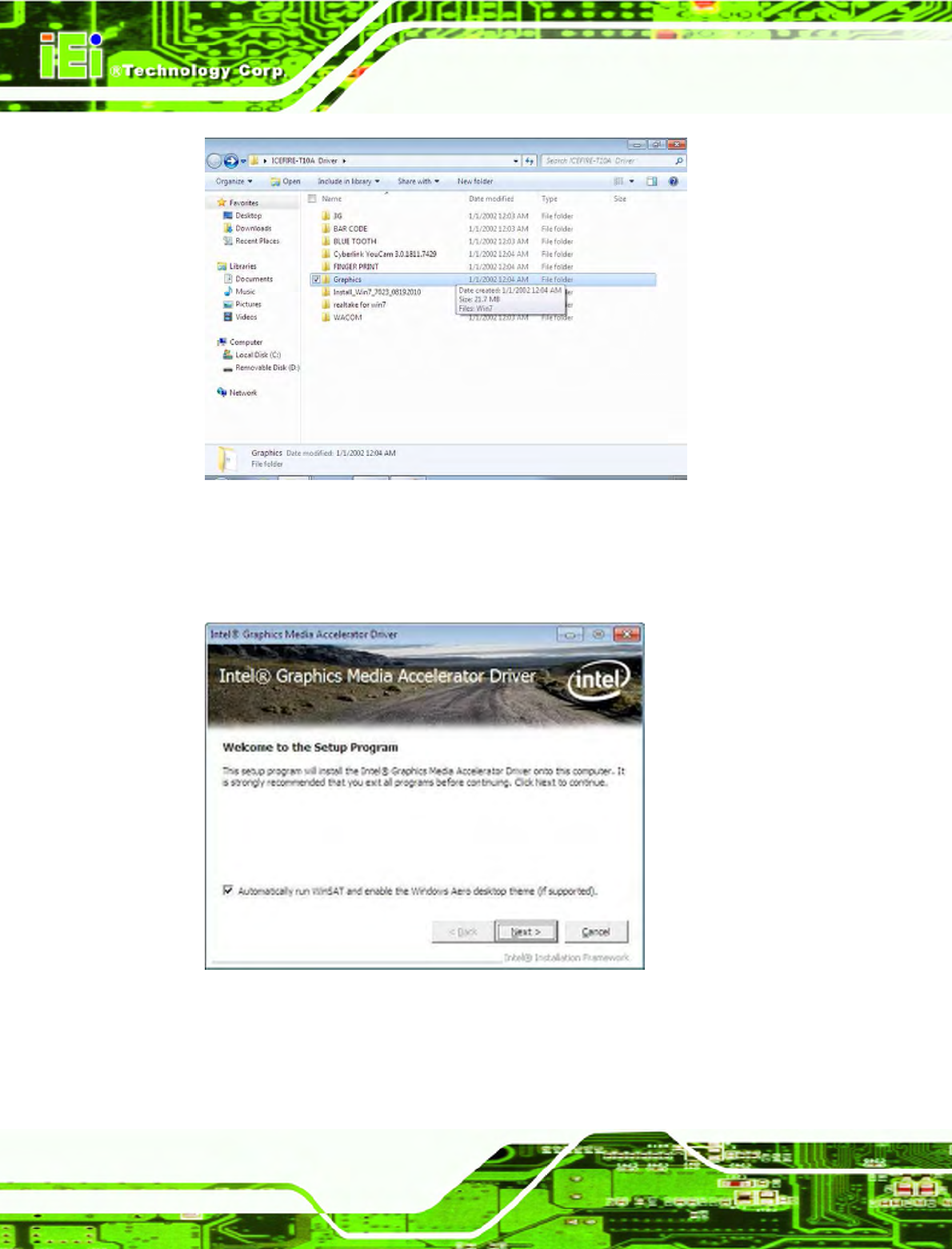
ICEFIRE-T10A Mobile Clinic Assistant
Page 46
Figure 4-1: Graphics Driver Location
Step 2: Double click the setup file in the folder. The Graphics Media Accelerator
Driver welcome screen appears (
417H494H
Figure 4-2).
Figure 4-2: Graphics Media Accelerator Driver
Step 3: Follow the step-by-step instruction of the installation wizard to install the
graphics driver.
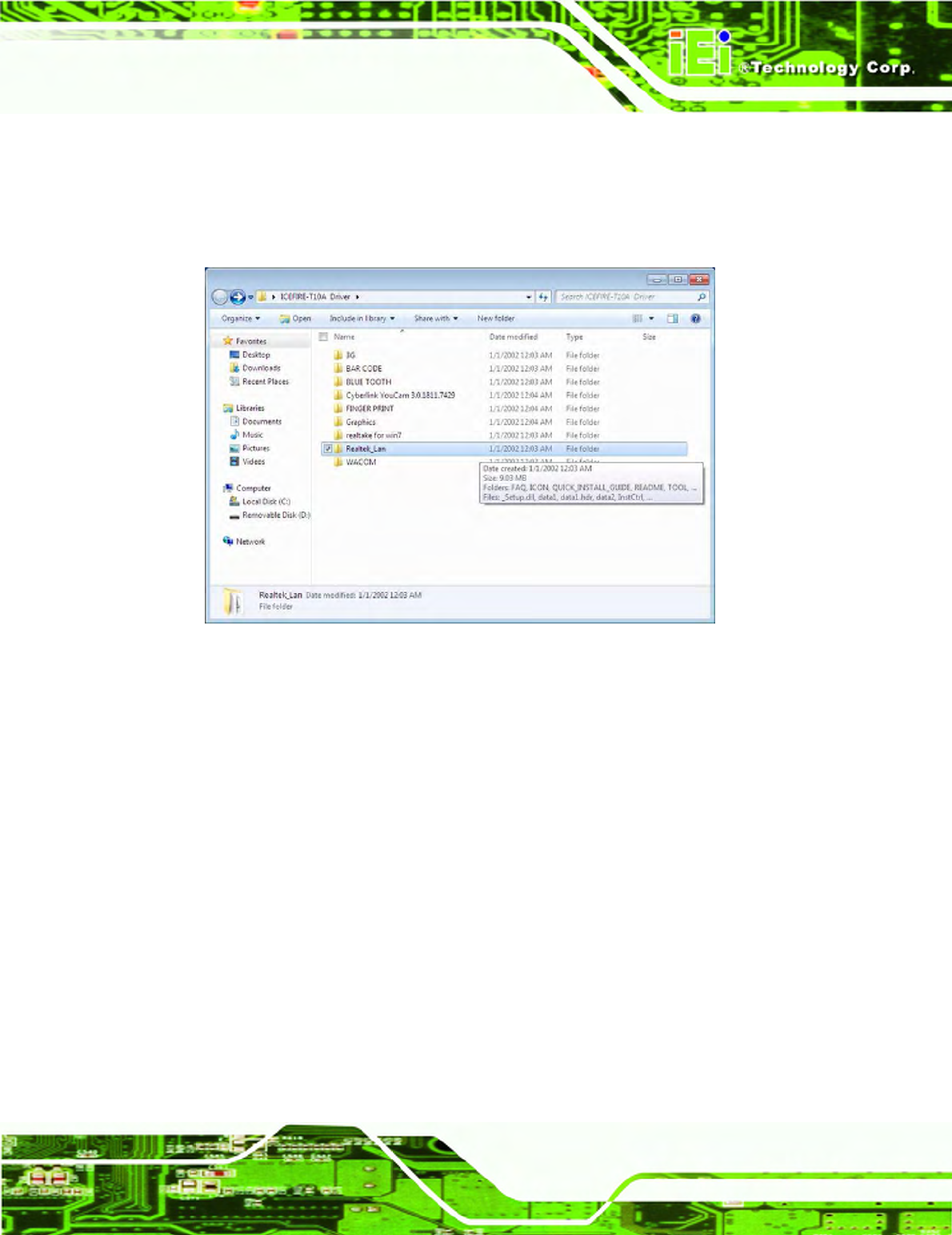
ICEFIRE-T10A Mobile Clinic Assistant
Page 47
4.3 Realtek LAN Driver
To install the Realtek LAN driver, please follow the steps below.
Step 1: Select Realtek_Lan from the list in
418H495H
Figure 4-3.
Figure 4-3: Realtek LAN Driver Location
Step 2: Double click the setup file in the folder. The InstallShield Wizard screen appears
(
419H496H
Figure 4-4).
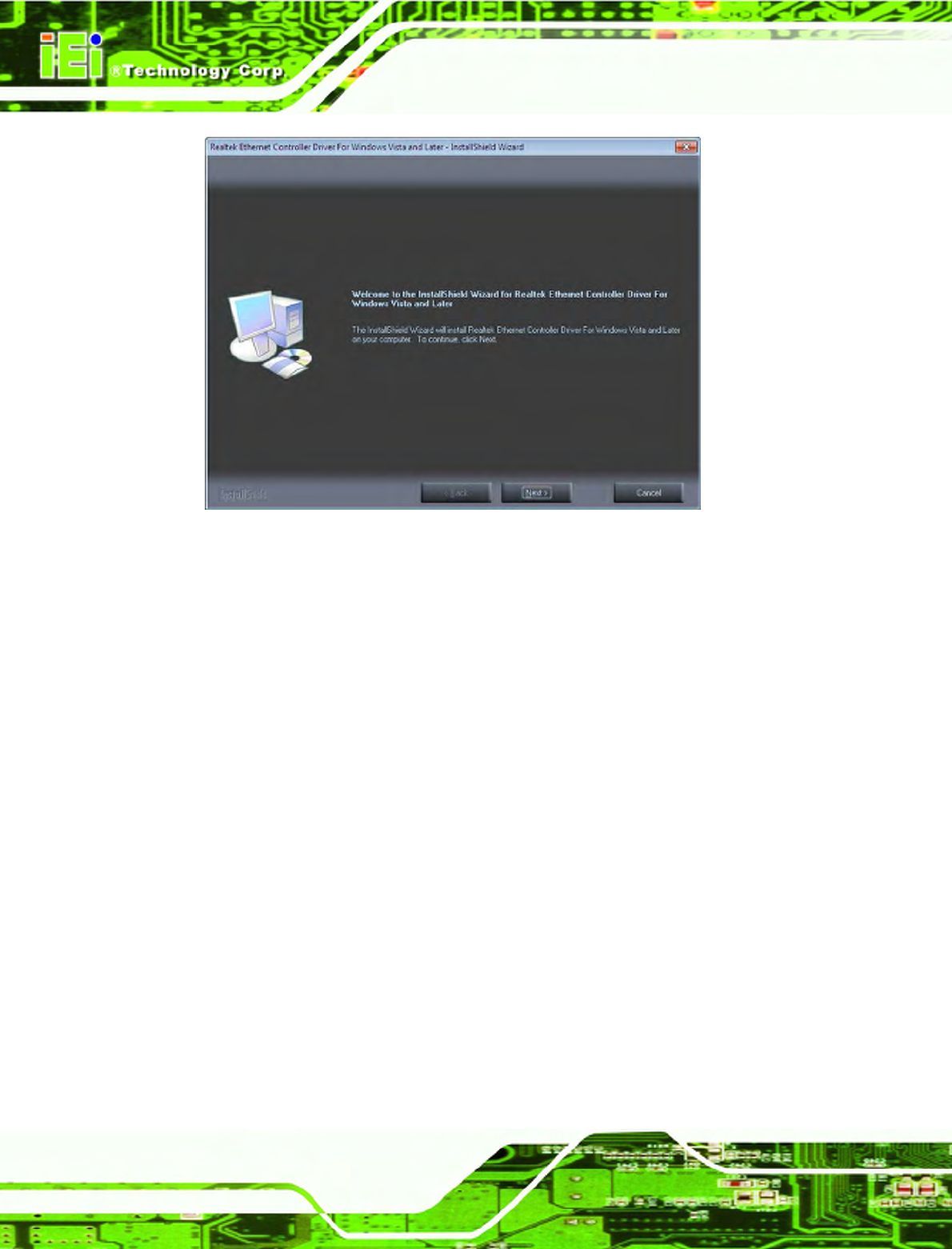
ICEFIRE-T10A Mobile Clinic Assistant
Page 48
Figure 4-4: Realtek LAN InstallShield Wizard
Step 3: Follow the step-by-step instruction of the installation wizard to install the LAN
driver.
4.4 Speaker and Microphone Driver
To install the driver for the speaker and the microphone, please follow the steps below.
Step 1: Select realtake for win7 from the list in
422H499H
Figure 4-3.
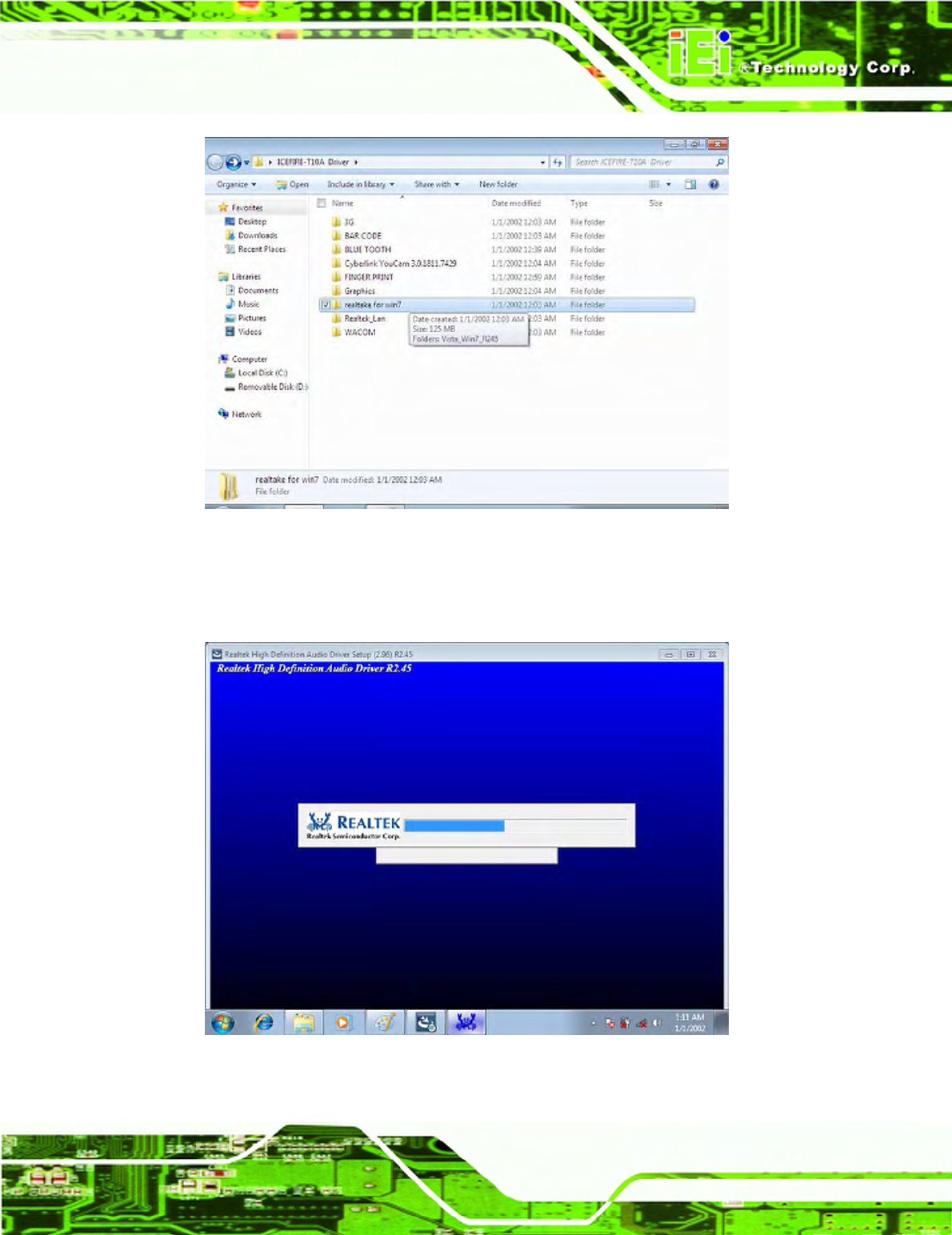
ICEFIRE-T10A Mobile Clinic Assistant
Page 49
Figure 4-5: Speaker and Microphone Driver Location
Step 2: Double click the setup file in the folder. The InstallShield Wizard screen
appears (
423H500H
Figure 4-4).
Figure 4-6: Realtek HD Audio Driver InstallShield Wizard
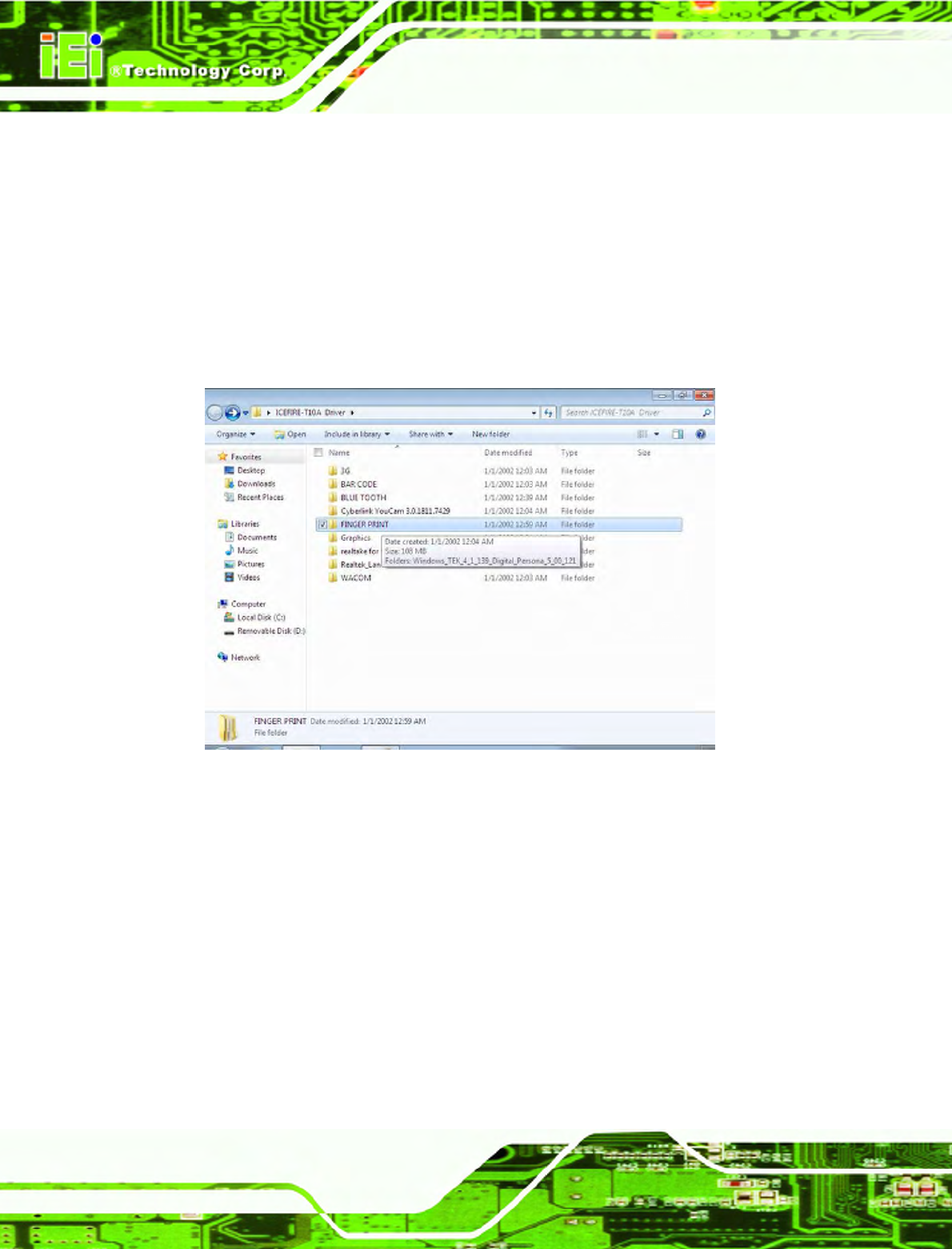
ICEFIRE-T10A Mobile Clinic Assistant
Page 50
Step 3: Follow the step-by-step instruction of the installation wizard to install the HD
Audio driver.
4.5 Fingerprint Reader Driver
To install the fingerprint reader driver, please follow the steps below.
Step 1: Select FINGER PRINT from the list in
426H501H
Figure 4-3.
Figure 4-7: Fingerprint Reader Driver Location
Step 2: Double click the setup file in the folder. The InstallShield Wizard screen appears
(
427H502H
Figure 4-4).
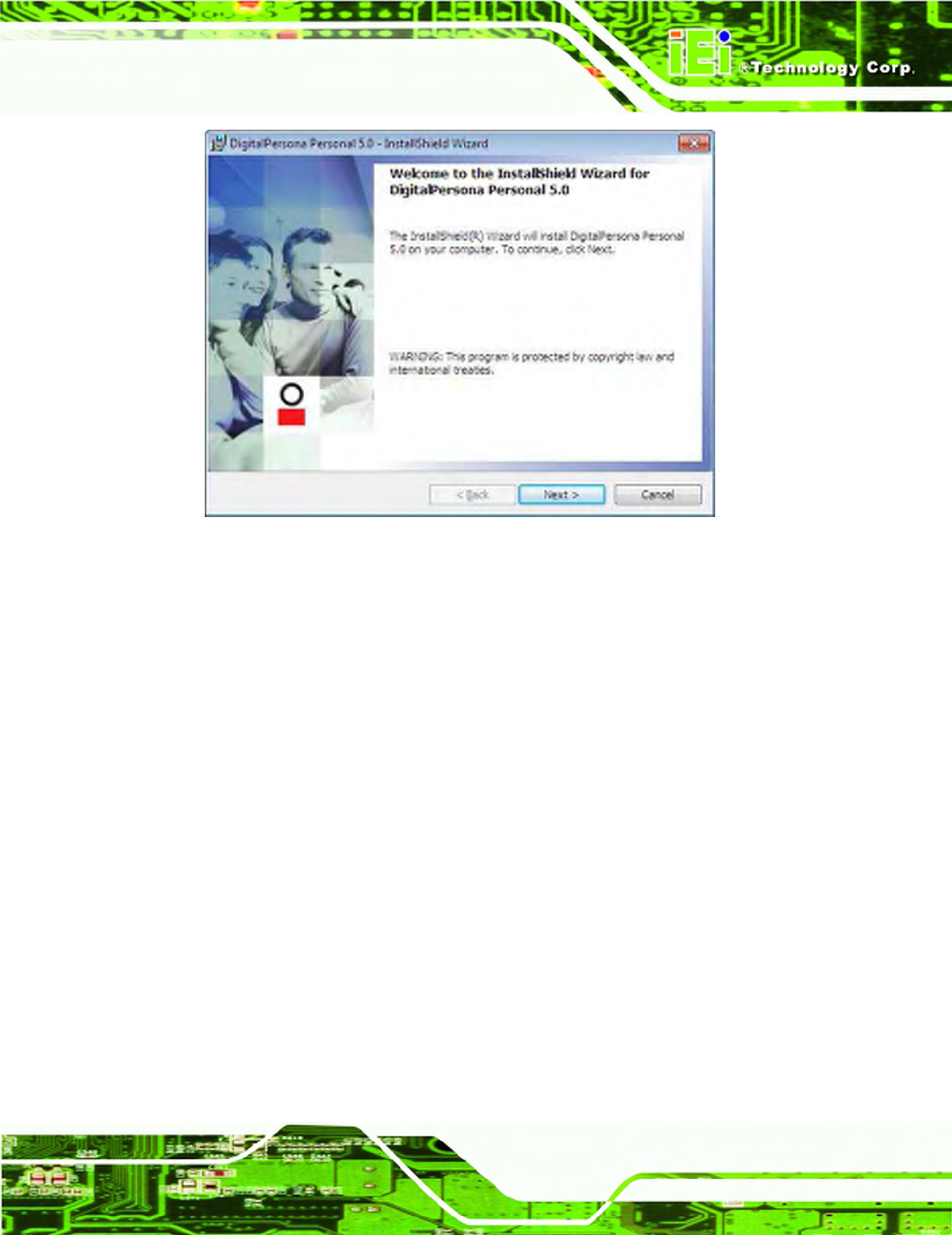
ICEFIRE-T10A Mobile Clinic Assistant
Page 51
Figure 4-8: Fingerprint Reader InstallShield Wizard
Step 3: Follow the step-by-step instruction of the installation wizard to install the
fingerprint reader driver.
4.6 Barcode Scanner Driver
To install the barcode scanner driver, please follow the steps below.
Step 1: Select BAR CODE from the list in
428H503H
Figure 4-3.
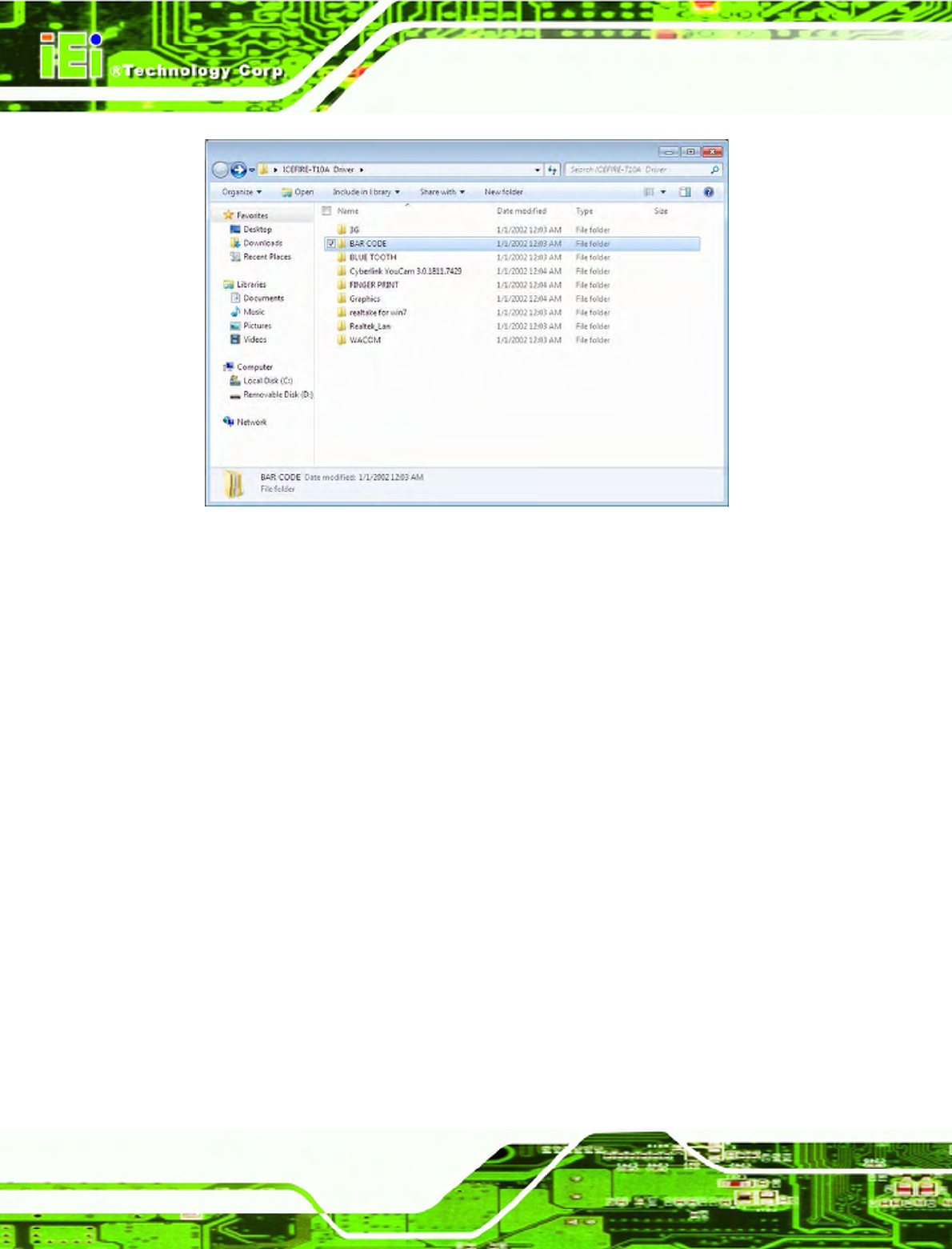
ICEFIRE-T10A Mobile Clinic Assistant
Page 52
Figure 4-9: Barcode Scanner Driver Location
Step 2: Double click the setup file in the folder. The InstallShield Wizard screen appears.
Follow the step-by-step instruction of the installation wizard to install the barcode
scanner driver.
4.7 Bluetooth Driver
To install the Bluetooth driver, please follow the steps below.
Step 1: Turn on the Bluetooth by pushing the Bluetooth on/off button on the front
panel.
Step 2: Select BTW_6.2.0.9600_vista_w7_20090721 from the BLUE TOOTH folder as
shown in
429H504H
Figure 4-3.
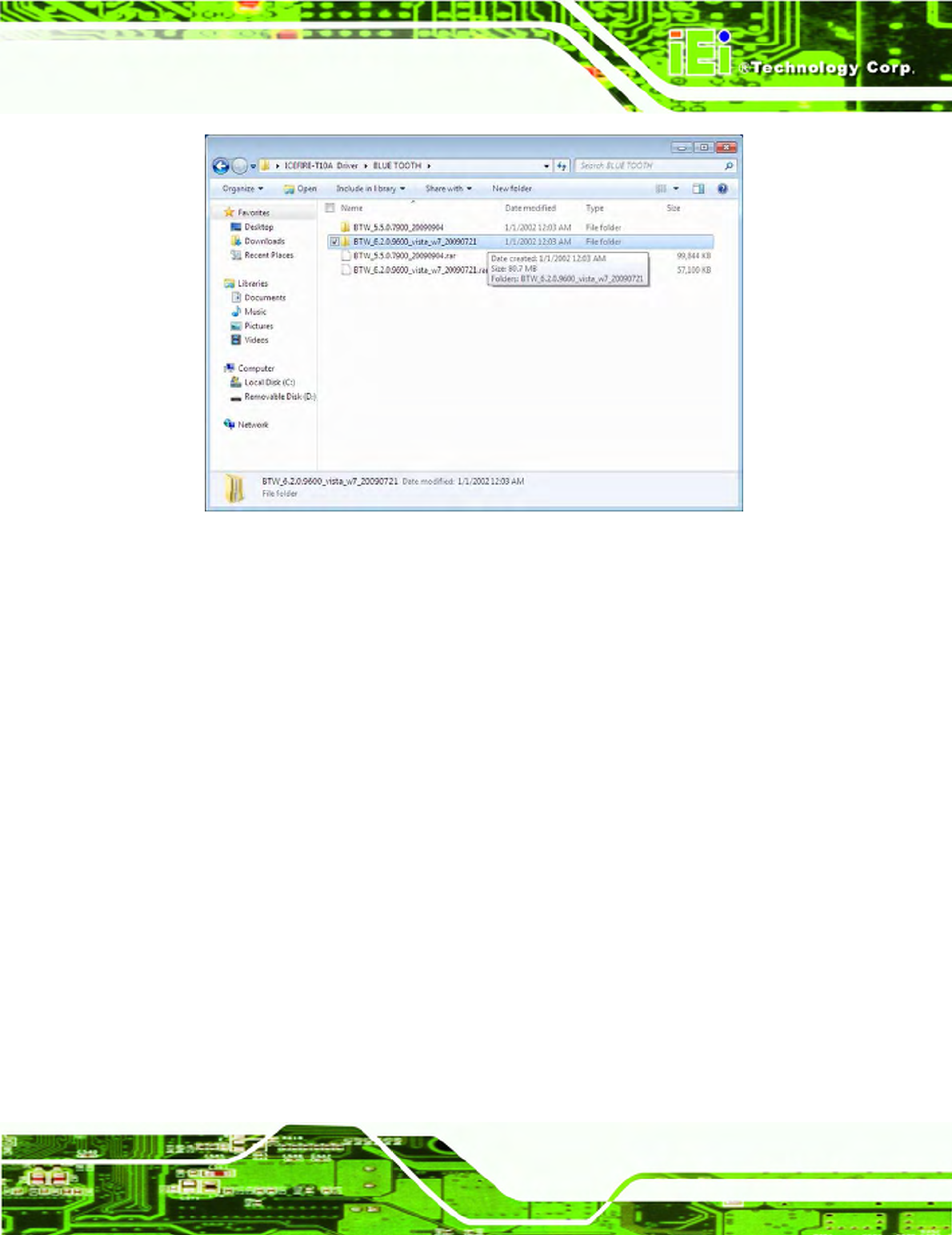
ICEFIRE-T10A Mobile Clinic Assistant
Page 53
Figure 4-10: Bluetooth Driver Location
Step 3: Double click the setup file in the folder. The InstallShield Wizard screen appears.
Follow the step-by-step instruction of the installation wizard to install the
Bluetooth driver.
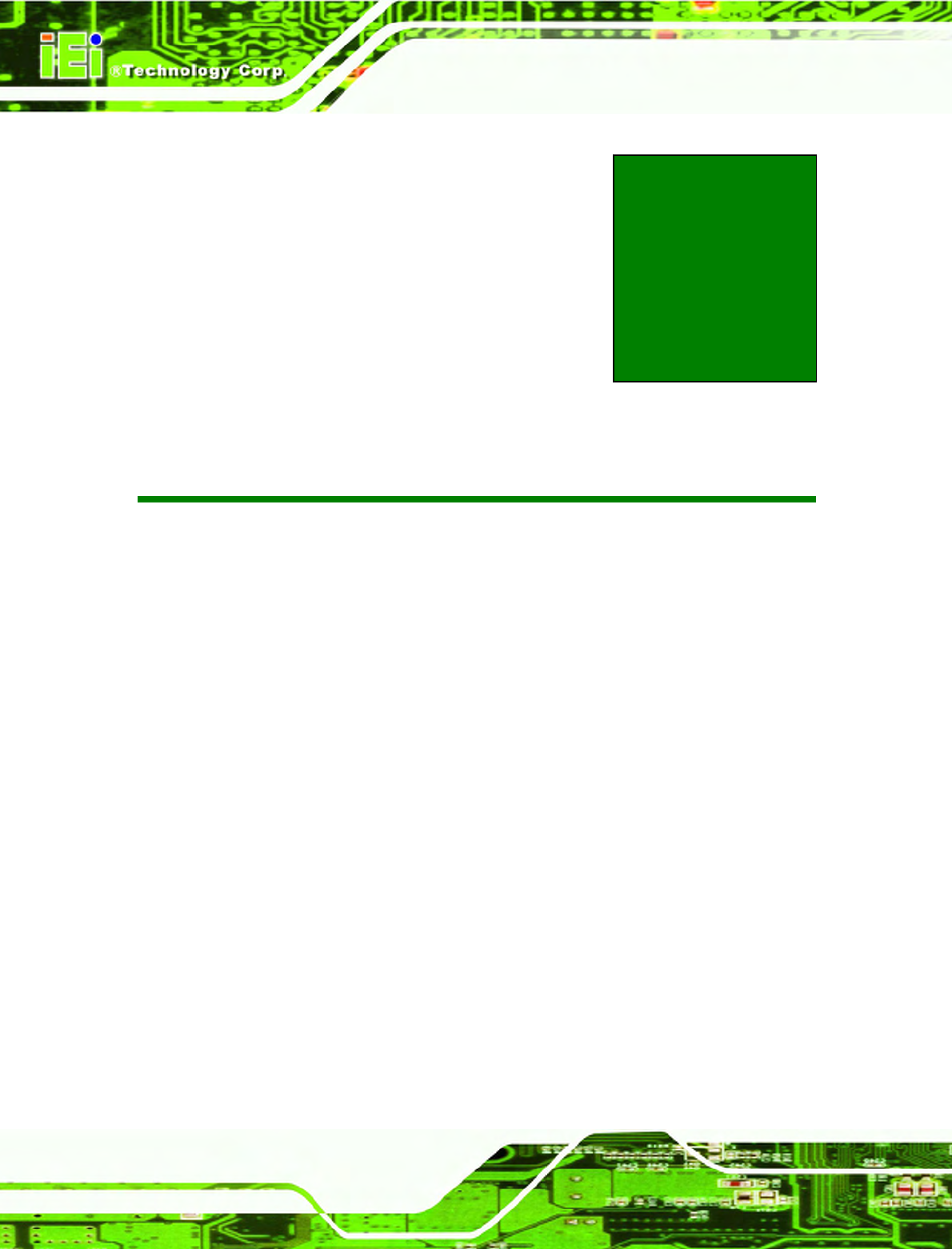
ICEFIRE-T10A Mobile Clinic Assistant
Page 54
Chapter
5
5 ICEFIRE Control Center
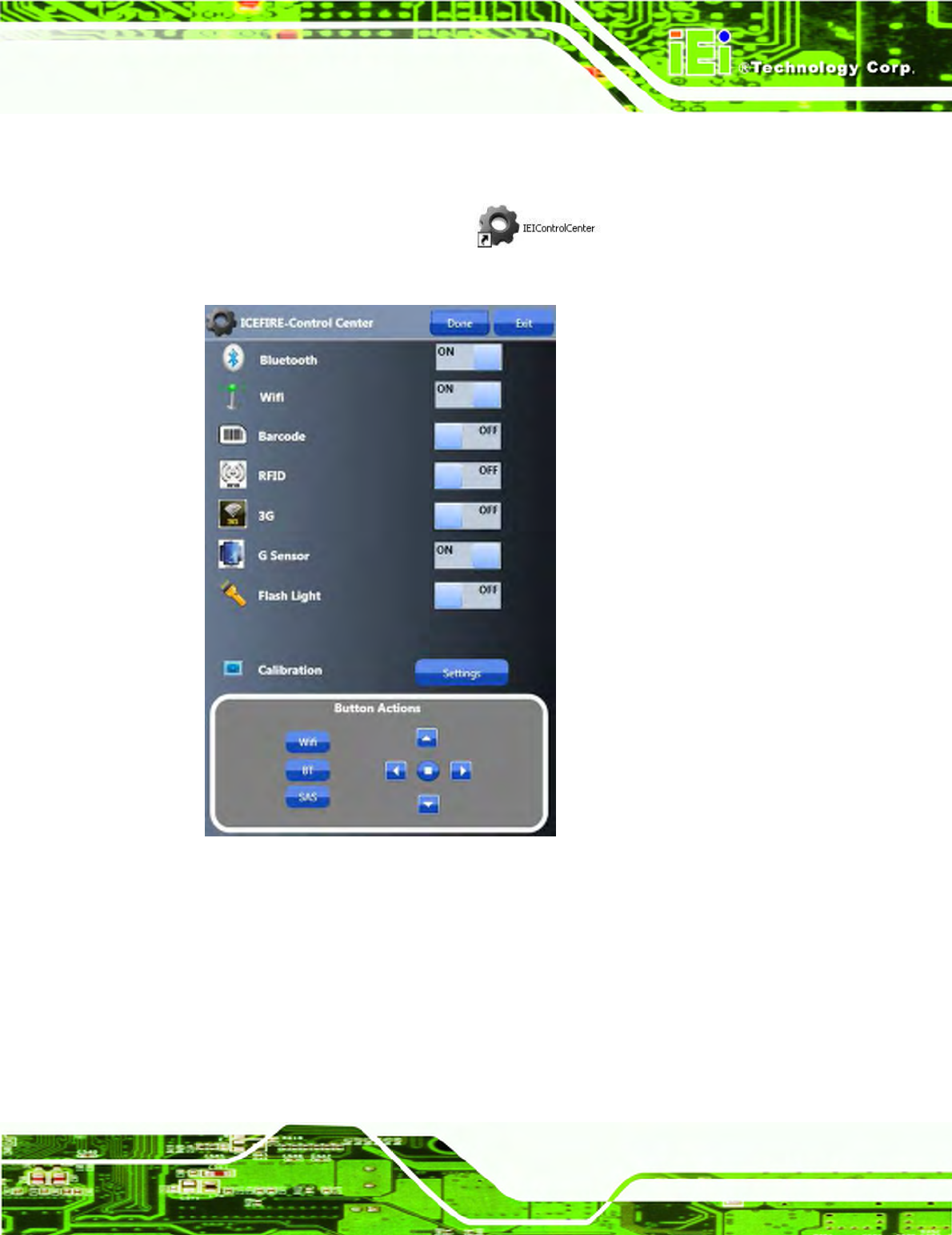
ICEFIRE-T10A Mobile Clinic Assistant
Page 55
5.1 Getting Started
The ICEFIRE control center puts many tasks and common settings in a single window. To
launch Control Center, click the icon
on the desktop. The Control
Center interface is shown below.
Figure 5-1: Control Center
5.2 Features
The Control Center has following features
Module status
Calibration
Programmable button actions
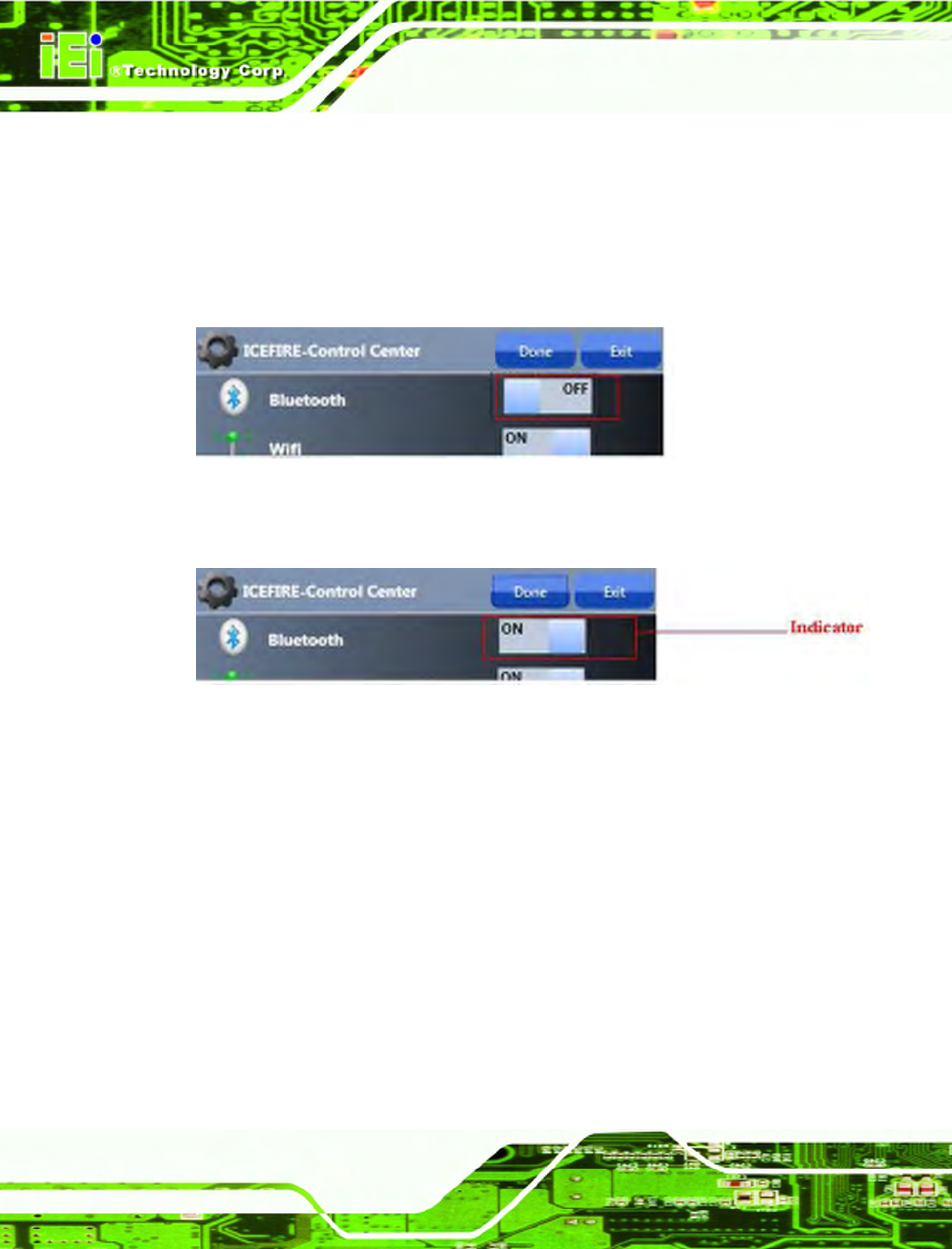
ICEFIRE-T10A Mobile Clinic Assistant
Page 56
5.3 Module Status
The user can use this feature to check status and turn on or turn off the hardware modules,
such as Bluetooth or Wi-Fi. Take Bluetooth as an example, the following section describes
how to turn on or turn off the Bluetooth.
The indicator shows Bluetooth is off. Click the indicator to switch on Bluetooth.
The indicator shows Bluetooth module is on. The Bluetooth-enabled device can be used
with the ICEFIRE-T10A.
Repeat the same steps to turn on or turn off other modules listed in
505H
Figure 5-2.
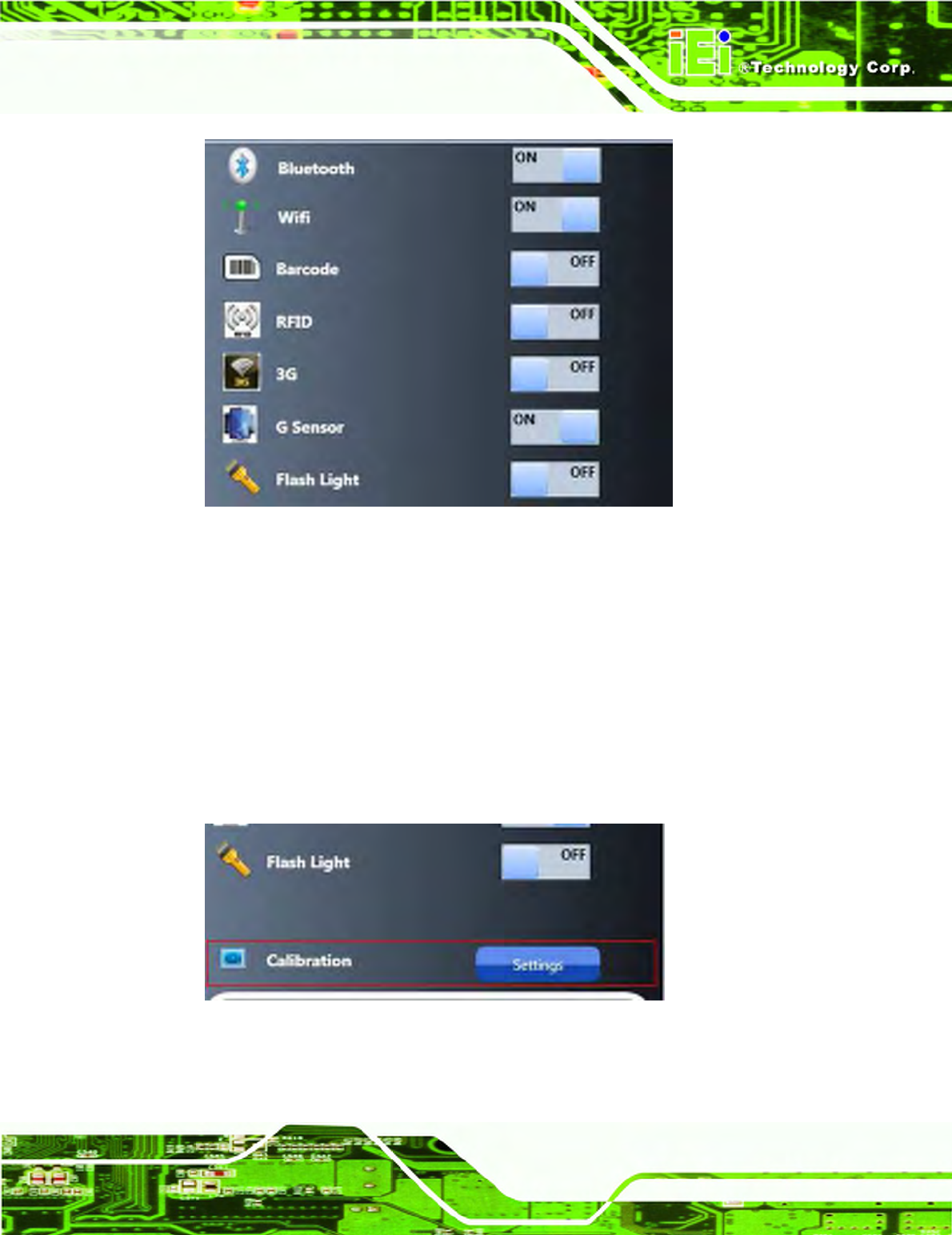
ICEFIRE-T10A Mobile Clinic Assistant
Page 57
Figure 5-2: Module Status
5.4 Calibration
Using a digitizer or touch to interact with the ICEFIRE-T10A is more frequent than using a
mouse and keyboard. The user should calibrate the digitizer and touch for the first time
using the system and whenever the touch point does not align properly.
To calibrate digitizer and touch, please follow the steps below:
Step 1: Click the settings button on the control center.
Figure 5-3: Calibration
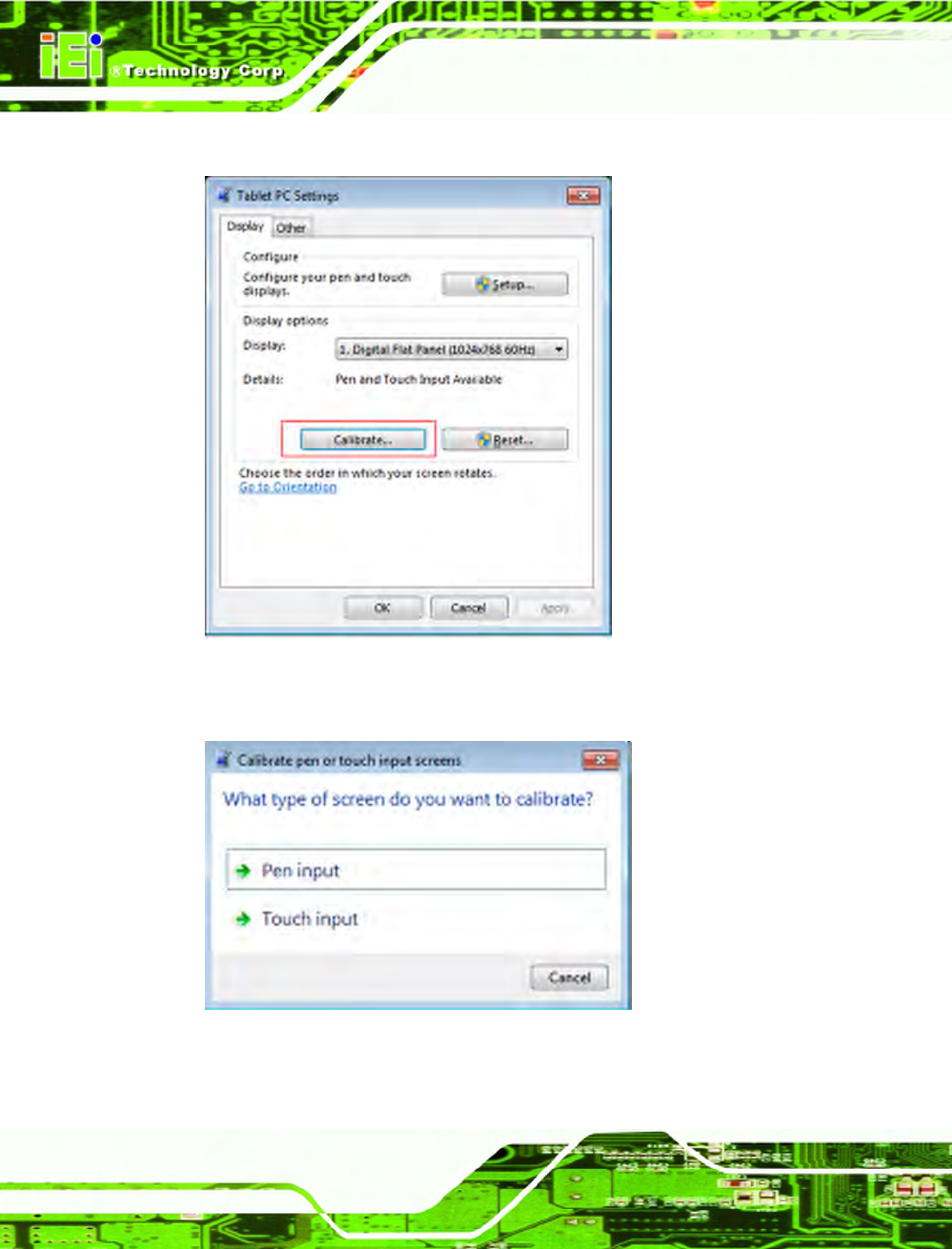
ICEFIRE-T10A Mobile Clinic Assistant
Page 58
Step 2: Tablet PC Settings window appears. Click the Calibrate button.
Figure 5-4: Tablet PC Settings
Step 3: Select the input type to calibrate.
Figure 5-5: Calibrate Pen or Touch Input Screens
Step 4: Follow the instructions in the calibration program to calibrate.
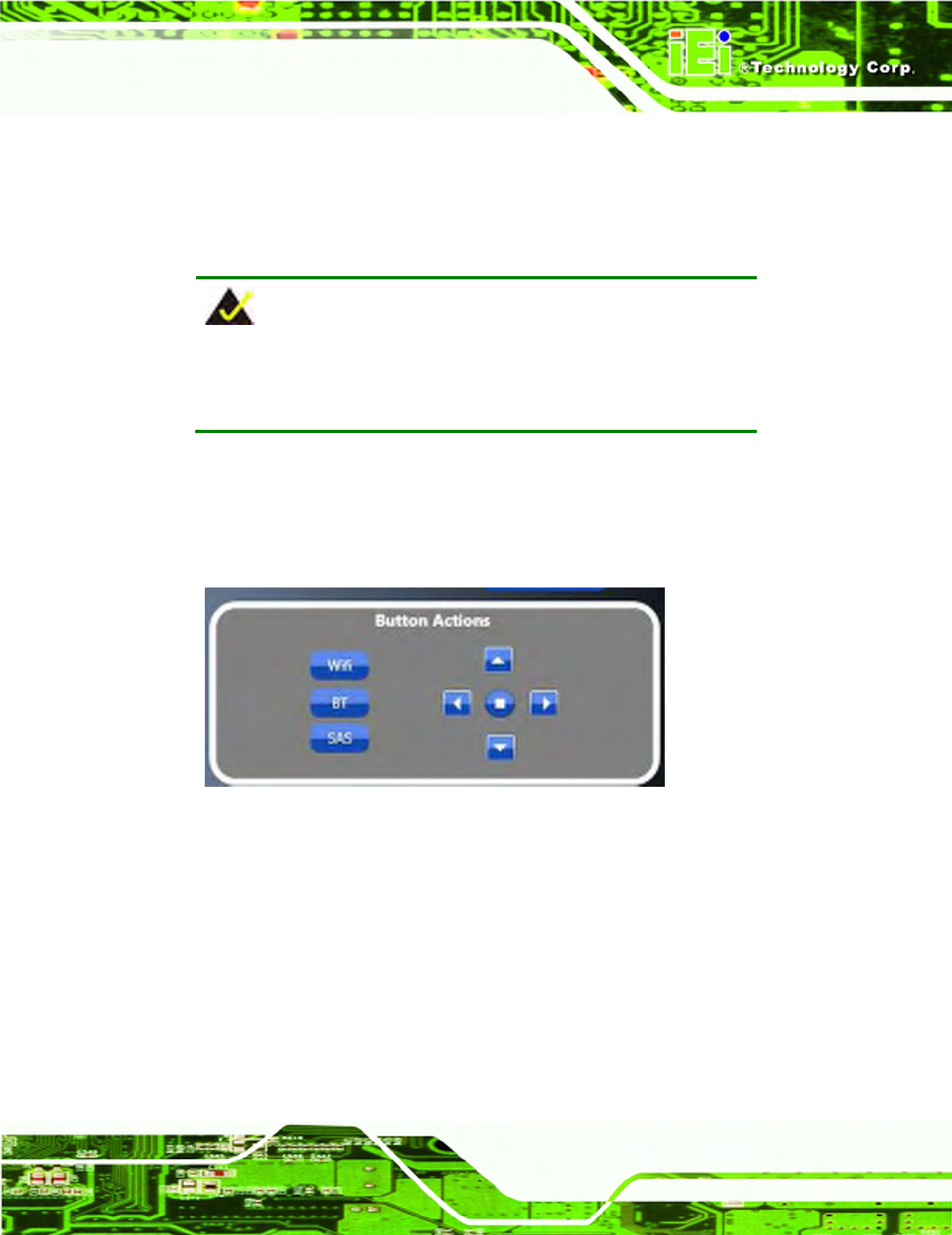
ICEFIRE-T10A Mobile Clinic Assistant
Page 59
5.5 Programmable Buttons
As become more familiar with the ICEFIRE-T10A, the user may want to customize the
keys on the front panel. The user can configure the keys to launch the favorite program,
run a command or enter a key combination.
NOTE:
The buttons and function keys on the front panel are disabled when the
Control Center is launched by the user.
To configure the front panel buttons, follow the steps below:
Step 1: Launch the Control Center. In the Button Actions section, select the button you
want to configure the action.
Figure 5-6: Button Actions
Step 2: Take Wifi as an example. Click the wifi button.The button configuration window
appears (
506H
Figure 5-7). The button configuration window has two sections.
Wifi
Fn+Wifi (Function key and wifi key should be pressed together)
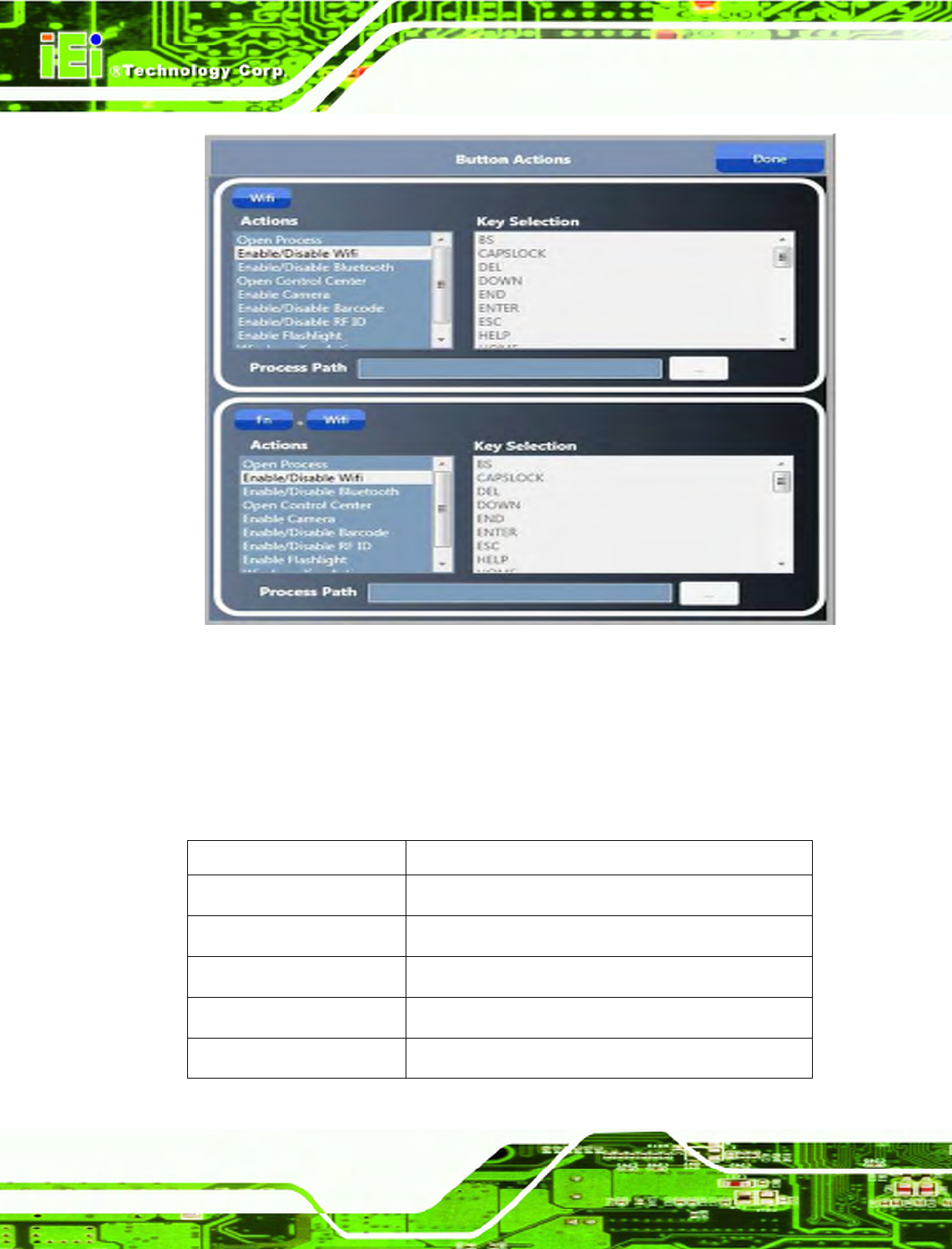
ICEFIRE-T10A Mobile Clinic Assistant
Page 60
Figure 5-7: Button Actions - Wifi
Step 3: Both sections have a list of action to be performed. Select one action from the
list.
Step 4: Once settings are completed click the “Done” button to save the settings.
Other actions are described in the table below: Step 0:
Action Description
Open Process Execute process specified by user (see Section
507H
5.5.1)
Enable/Disable Wi-Fi Turn on/off Wi-Fi
Enable/Disable Bluetooth Turn on/off Bluetooth
Open Control Center Open control center to change settings
Enable Camera Open camera application
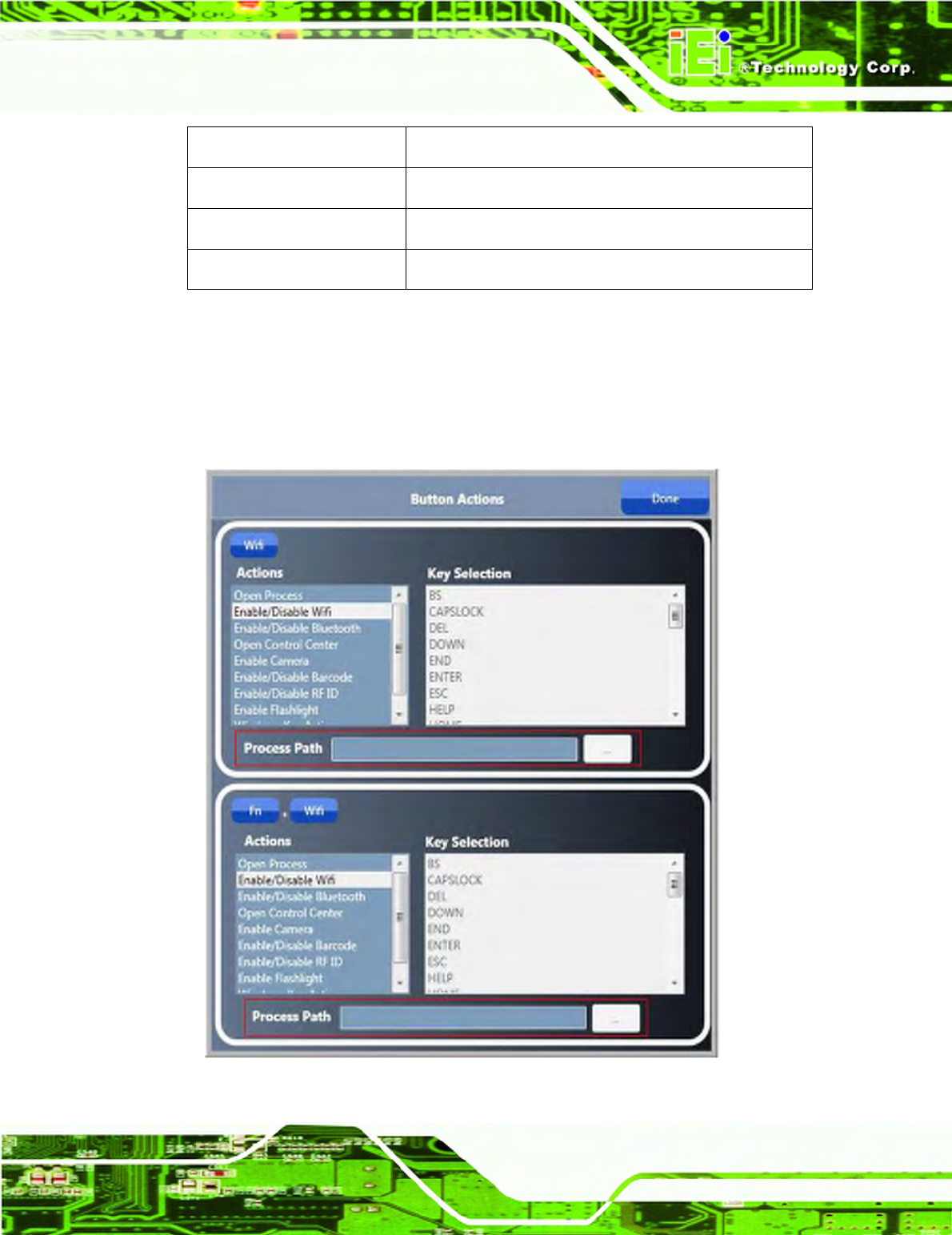
ICEFIRE-T10A Mobile Clinic Assistant
Page 61
Enable/Disable Barcode Execute barcode reading
Enable/Disable RFID Execute RFID reading
Enable Flashlight Execute flashlight
Windows Key Action Execute windows key actions (see Section
508H
5.5.2)
Table 5-1: Action Description
5.5.1 Action: Open Process
If Open Process action is selected, a path of the executable file has to be specified. Refer
to the following diagram.
Figure 5-8: Action - Open Process
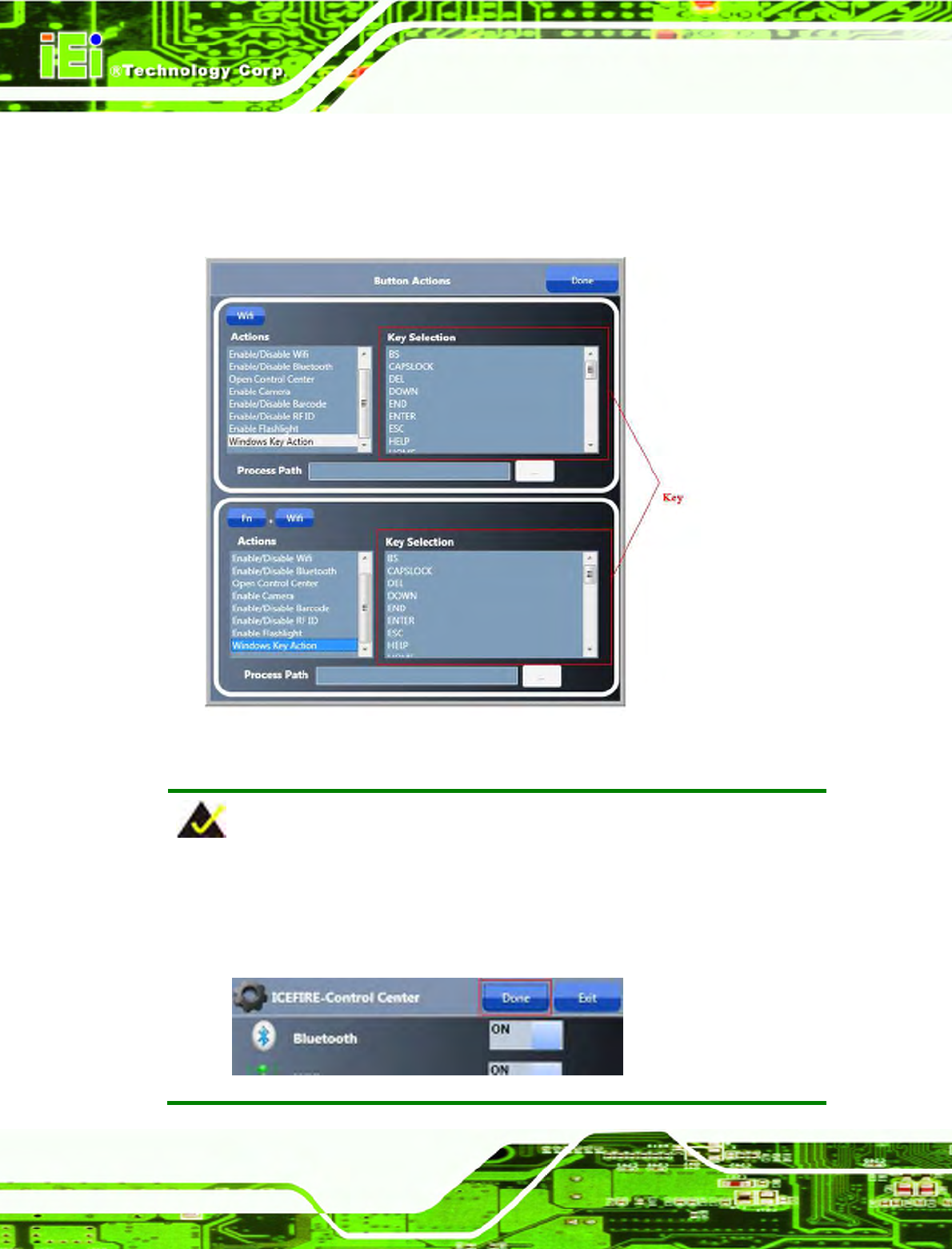
ICEFIRE-T10A Mobile Clinic Assistant
Page 62
5.5.2 Action: Windows Key Action
If Windows Key Action is selected, the user has to select any one of windows key from
“Key Selection” list (
509H
Figure 5-9).
Figure 5-9: Action - Windows Key Action
NOTE:
After changing the settings, please click the Done button to perform all actions
specified by user. Default actions will be performed if click Exit button to exit the
control center.
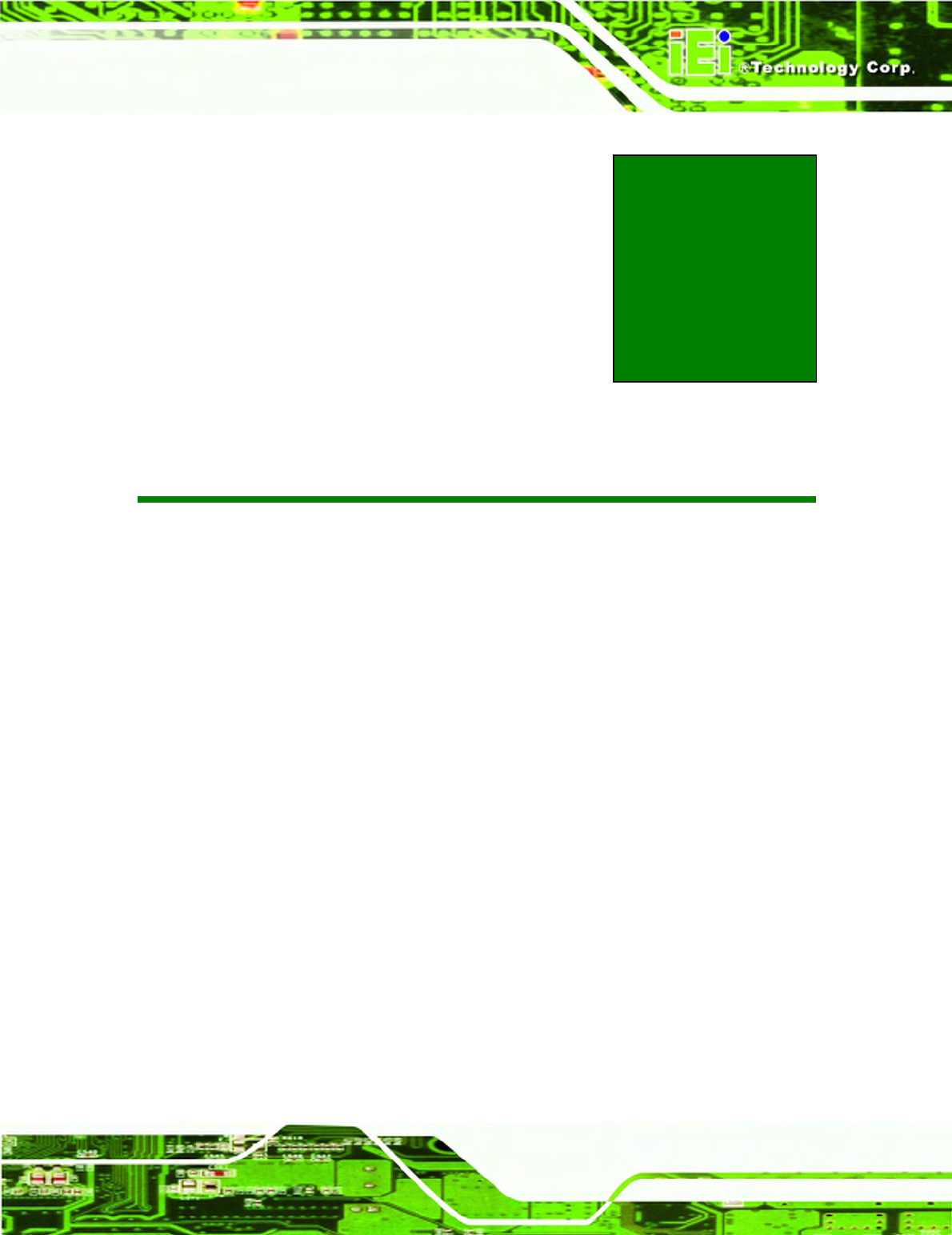
ICEFIRE-T10A Mobile Clinic Assistant
Page 63
Chapter
6
6 BIOS Setup
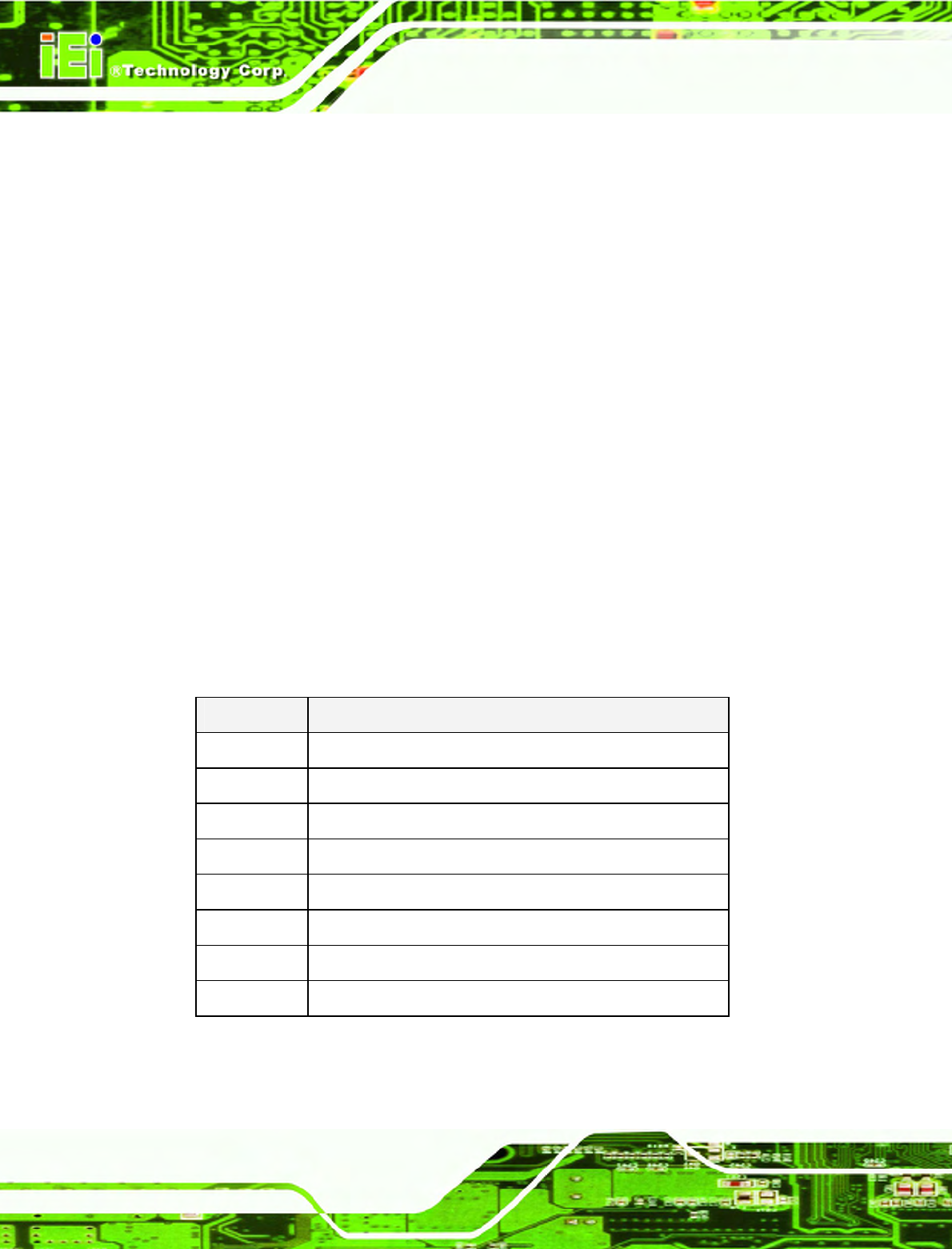
ICEFIRE-T10A Mobile Clinic Assistant
Page 64
6.1 Introduction
The BIOS is programmed onto the BIOS chip. The BIOS setup program allows changes to
certain system settings. This chapter outlines the options that can be changed.
6.1.1 Starting Setup
The UEFI BIOS is activated when the computer is turned on. The setup program can be
activated in one of two ways.
1. Press the DELETE
key as soon as the system is turned on or
2. Press the DELETE key when the “Press DELETE to enter SETUP” message
appears on the screen. 0.
If the message disappears before the DELETE key is pressed, restart the computer and
try again.
6.1.2 Using Setup
Use the arrow keys to highlight items, press E
NTER
to select, use the PageUp and
PageDown keys to change entries, press F1 for help and press E
SC
to quit. Navigation
keys are shown in.
Key Function
Up arrow Move to the item above
Down arrow Move to the item below
Left arrow Move to the item on the left hand side
Right arrow Move to the item on the right hand side
+ Increase the numeric value or make changes
- Decrease the numeric value or make changes
Page up Move to the next page
Page down Move to the previous page
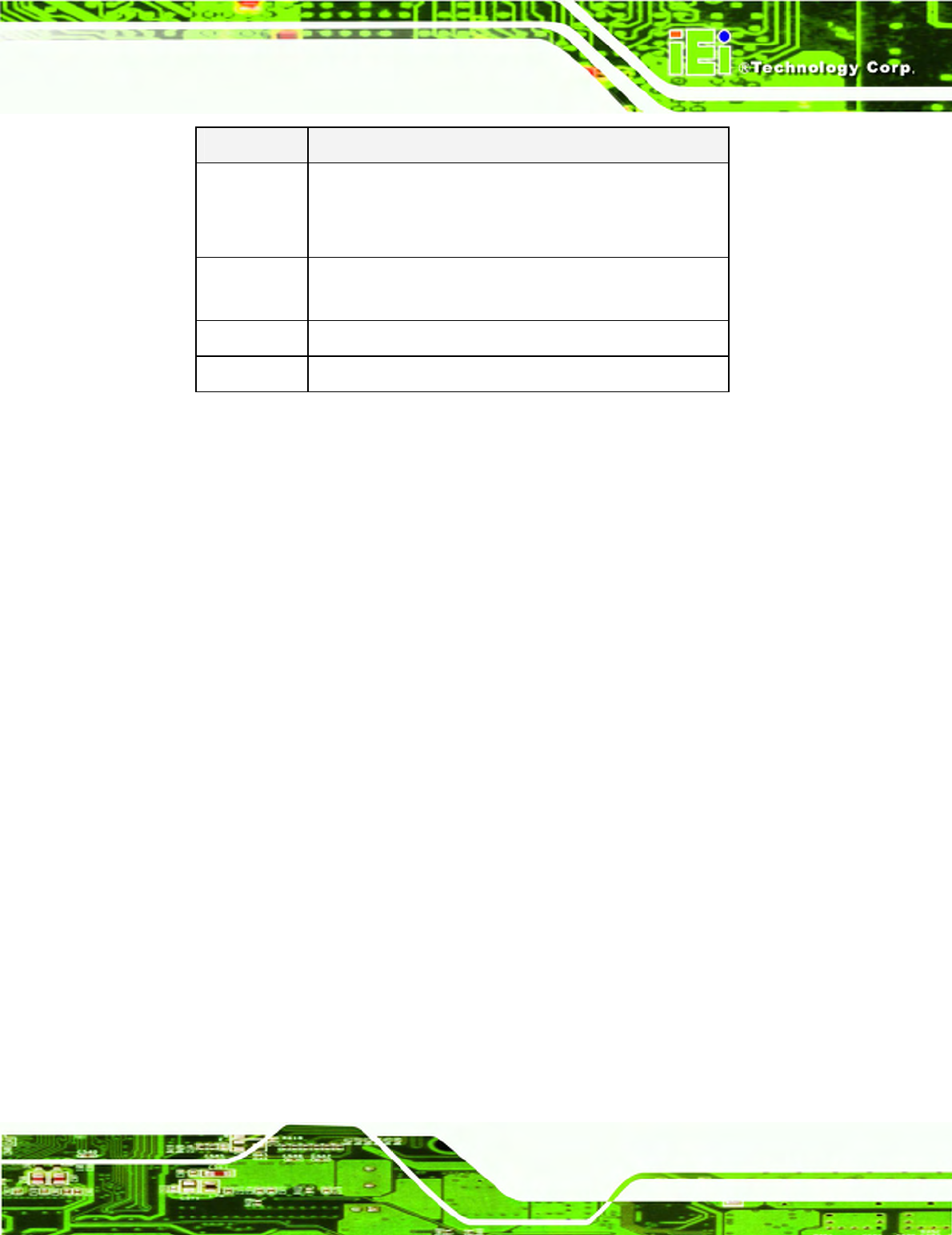
ICEFIRE-T10A Mobile Clinic Assistant
Page 65
Key Function
Esc Main Menu – Quit and do not save changes into CMOS
Status Page Setup Menu and Option Page Setup Menu --
Exit current page and return to Main Menu
F1 General help, only for Status Page Setup Menu and Option
Page Setup Menu
F9 Load optimized defaults
F10 Save changes and Exit BIOS
Table 6-1: BIOS Navigation Keys
6.1.3 Getting Help
When F1 is pressed a small help window describing the appropriate keys to use and the
possible selections for the highlighted item appears. To exit the Help Window press E
SC
or
the F1 key again.
6.1.4 BIOS Menu Bar
The menu bar on top of the BIOS screen has the following main items:
Main – Changes the basic system configuration.
Advanced – Changes the advanced system settings.
Chipset – Changes the chipset settings.
Boot – Changes the system boot configuration.
Security – Sets User and Supervisor Passwords.
Save & Exit – Selects exit options and loads default settings
The following sections completely describe the configuration options found in the menu
items at the top of the BIOS screen and listed above.
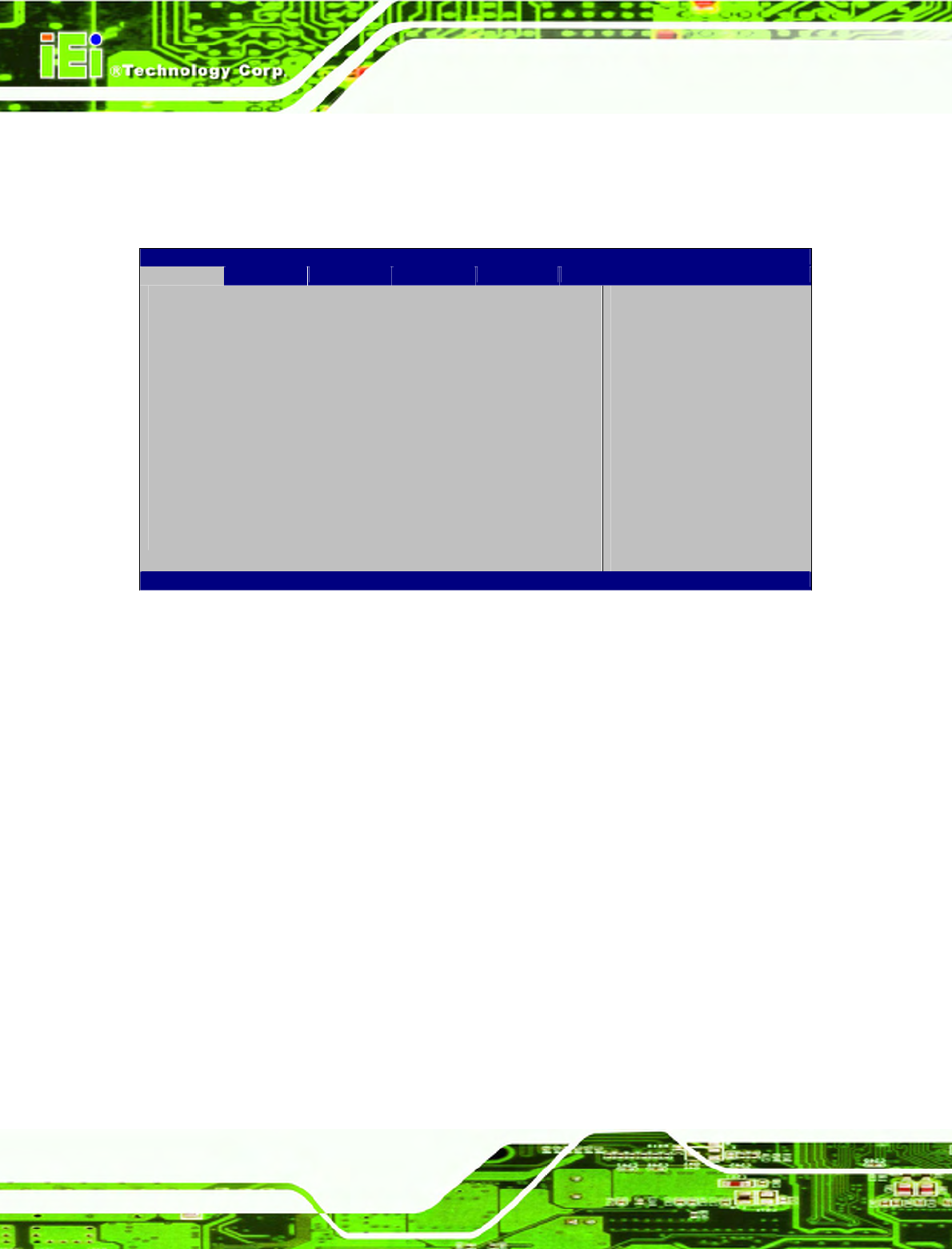
ICEFIRE-T10A Mobile Clinic Assistant
Page 66
6.2 Main
The Main BIOS menu (
430H510H
BIOS Menu 1) appears when the BIOS Setup program is entered.
The Main menu gives an overview of the basic system information.
Aptio Setup Utility – Copyright (C) 2011 American Megatrends, Inc.
Main Advanced
Chipset
Boot Security
Save & Exit
BIOS Information
BIOS Vendor American Megatrends
Core Version 4.6.4.0 0.20
Compliency UEFI 2.0
Project Version H514AR15.ROM
Build Date and Time 11/03/2010 15:39:09
iWDD Vendor ICP
iWDD Version H514ER15.bin
System Date [Tue 07/04/2011]
System Time [14:20:27]
Access Level Administrator
Set the Time. Use Tab to
switch between Time
elements.
----------------------
: Select Screen
↑ ↓: Select Item
Enter Select
F1 General Help
F2 Previous Values
F3 Optimized Defaults
F4 Save
ESC Exit
Version 2.11.1210. Copyright (C) 2011 American Megatrends, Inc.
BIOS Menu 1: Main
BIOS Information
The BIOS Information lists a brief summary of the BIOS. The fields in BIOS Information
cannot be changed. The items shown in the system overview include:
BIOS Vendor: Installed BIOS vendor
Core Version: Current BIOS version
Project Version: the board version
Build Date: Date the current BIOS version was made
The System Overview field also has two user configurable fields:
System Date [xx/xx/xx]
Use the System Date option to set the system date. Manually enter the day, month and
year.
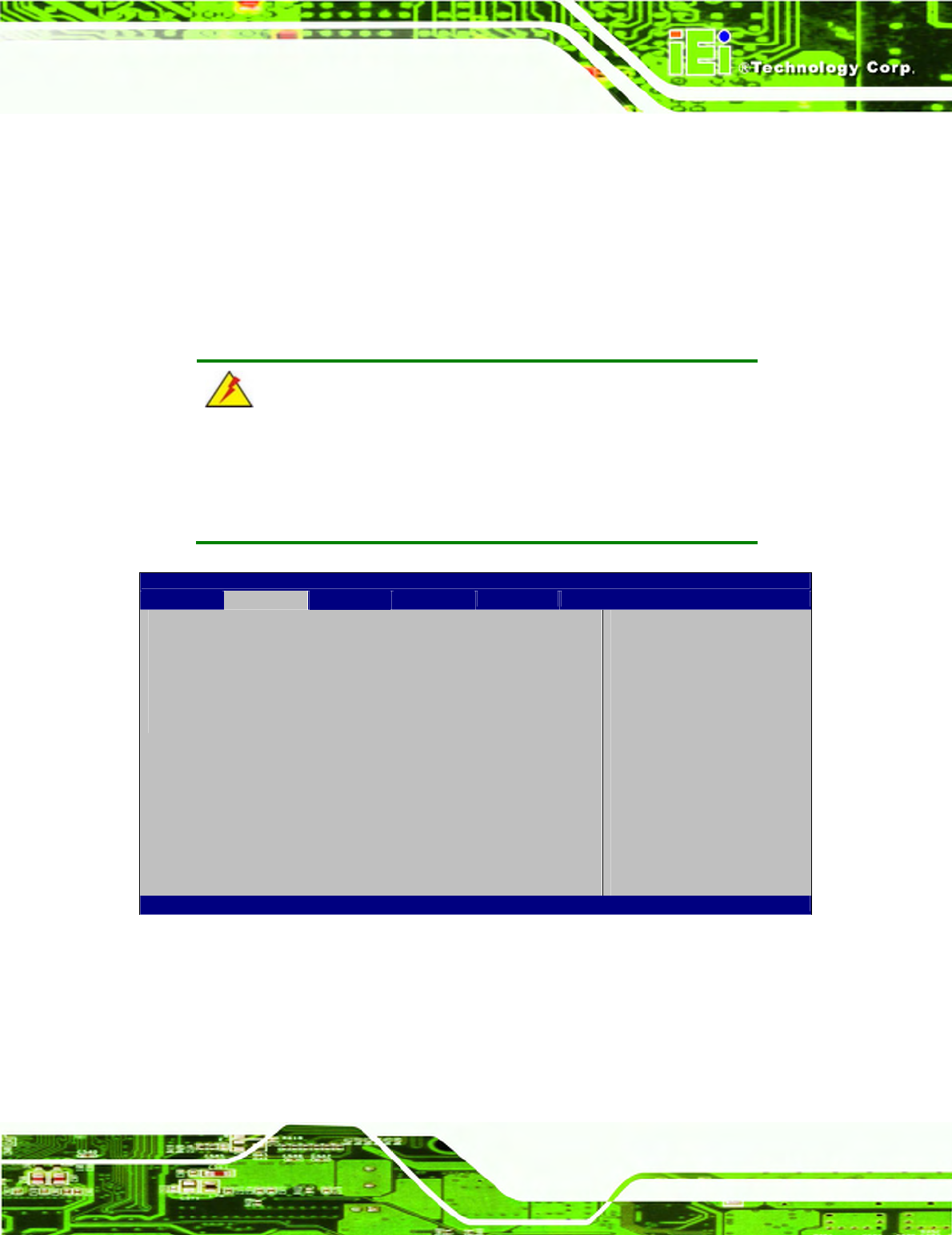
ICEFIRE-T10A Mobile Clinic Assistant
Page 67
System Time [xx:xx:xx]
Use the System Time option to set the system time. Manually enter the hours, minutes
and seconds.
6.3 Advanced
Use the Advanced menu (
431H511H
BIOS Menu 2) to configure the CPU and peripheral devices
through the following sub-menus:
WARNING!
Setting the wrong values in the sections below may cause the system
to malfunction. Make sure that the settings made are compatible with
the hardware.
Aptio Setup Utility – Copyright (C) 2011 American Megatrends, Inc.
Main Advanced
Chipset
Boot Security
Save & Exit
> CPU Configuration
> IDE Configuration
> USB Configuration
> H/M Monitor
> iEi Feature
System ACPI Parameters
----------------------
: Select Screen
↑ ↓: Select Item
Enter Select
F1 General Help
F2 Previous Values
F3 Optimized
Defaults
F4 Save
ESC Exit
Version 2.11.1210. Copyright (C) 2011 American Megatrends, Inc.
BIOS Menu 2: Advanced
6.3.1 CPU Configuration
Use the CPU Configuration menu (
432H512H
BIOS Menu 3) to view detailed CPU specifications
and configure the CPU.
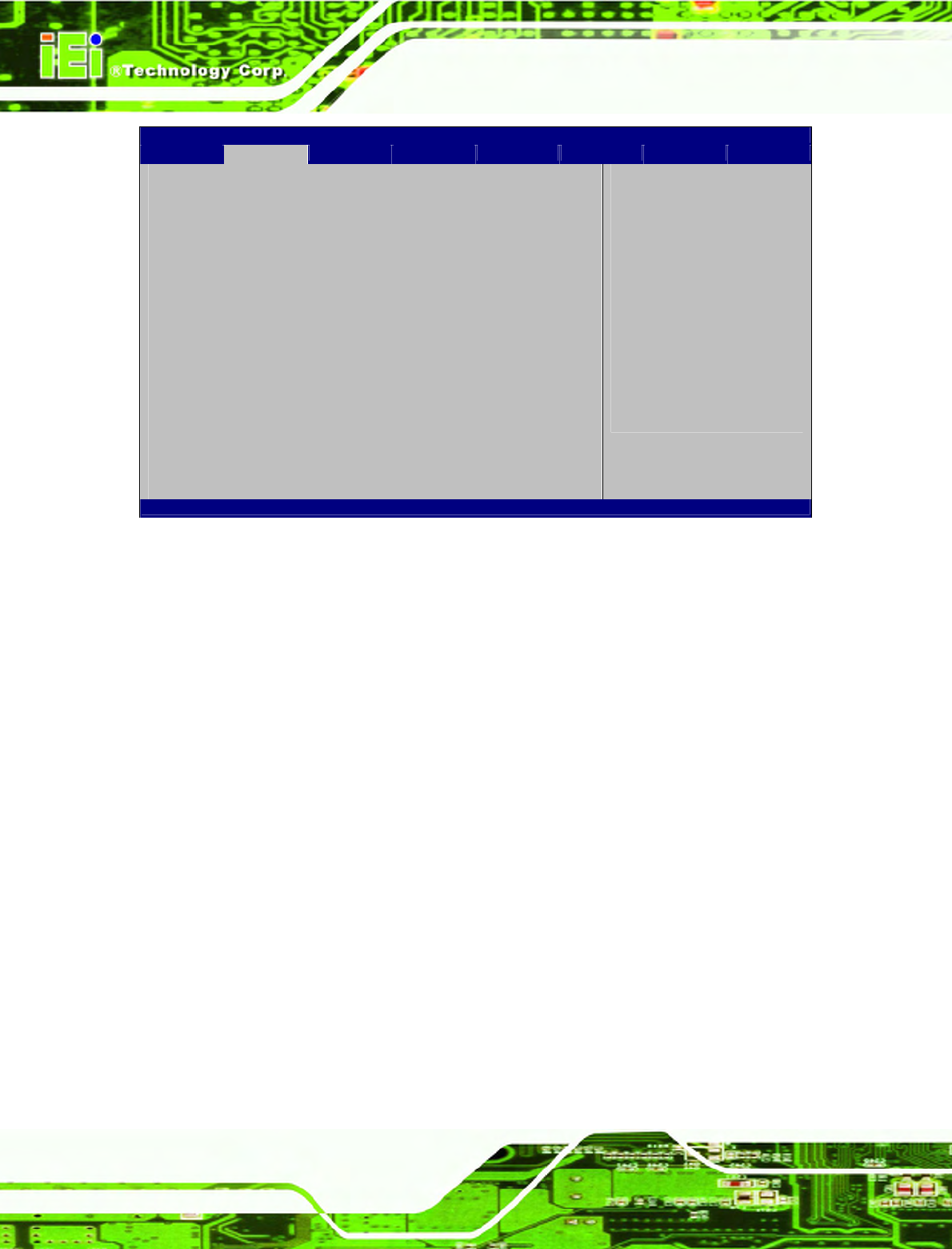
ICEFIRE-T10A Mobile Clinic Assistant
Page 68
Aptio Setup Utility – Copyright (C) 2011 American Megatrends, Inc.
Advanced
CPU Configuration
Processor Type Intel(R) Atom(TM) CPU
EMT64 Supported
Processor Speed 1800 MHz
System But Speed 800 MHz
Ratio Status 9
Actual Ratio 9
Processor Stepping 106ca
Microcode Revision 263
L1 Cache RAM 2x56 k
L2 Cache RAM 2x512 k
Processor Cores Dual
Hyper-Threading Supported
Hyper-Threading [Enabled]
----------------------
: Select Screen
↑ ↓: Select Item
Enter Select
F1 General Help
F2 Previous Values
F3 Optimized
Defaults
F4 Save
ESC Exit
Version 2.11.1210. Copyright (C) 2011 American Megatrends, Inc.
BIOS Menu 3: CPU Configuration
The CPU Configuration menu (
433H513H
BIOS Menu 3) lists the following CPU details:
Processor Type: Lists the brand name of the CPU being used
EMT64: Indicates if the EM64T is supported by the CPU.
Processor Speed: Lists the CPU processing speed
System Bus Speed: Lists the system bus speed
Processor Stepping: Lists the CPU processing stepping
Microcode Revision: Lists the microcode revision
L1 Cache RAM: Lists the CPU L1 cache size
L2 Cache RAM: Lists the CPU L2 cache size
Processor Cores: Lists the number of the processor core
Hyper-Threading: Indicates if the Intel® HT Technology is supported by the
CPU.
Hyper Threading [Disabled]
Use the Hyper Threading to enable or disable the CPU hyper threading function.
Disabled D
EFAULT
Disables the use of hyper threading technology
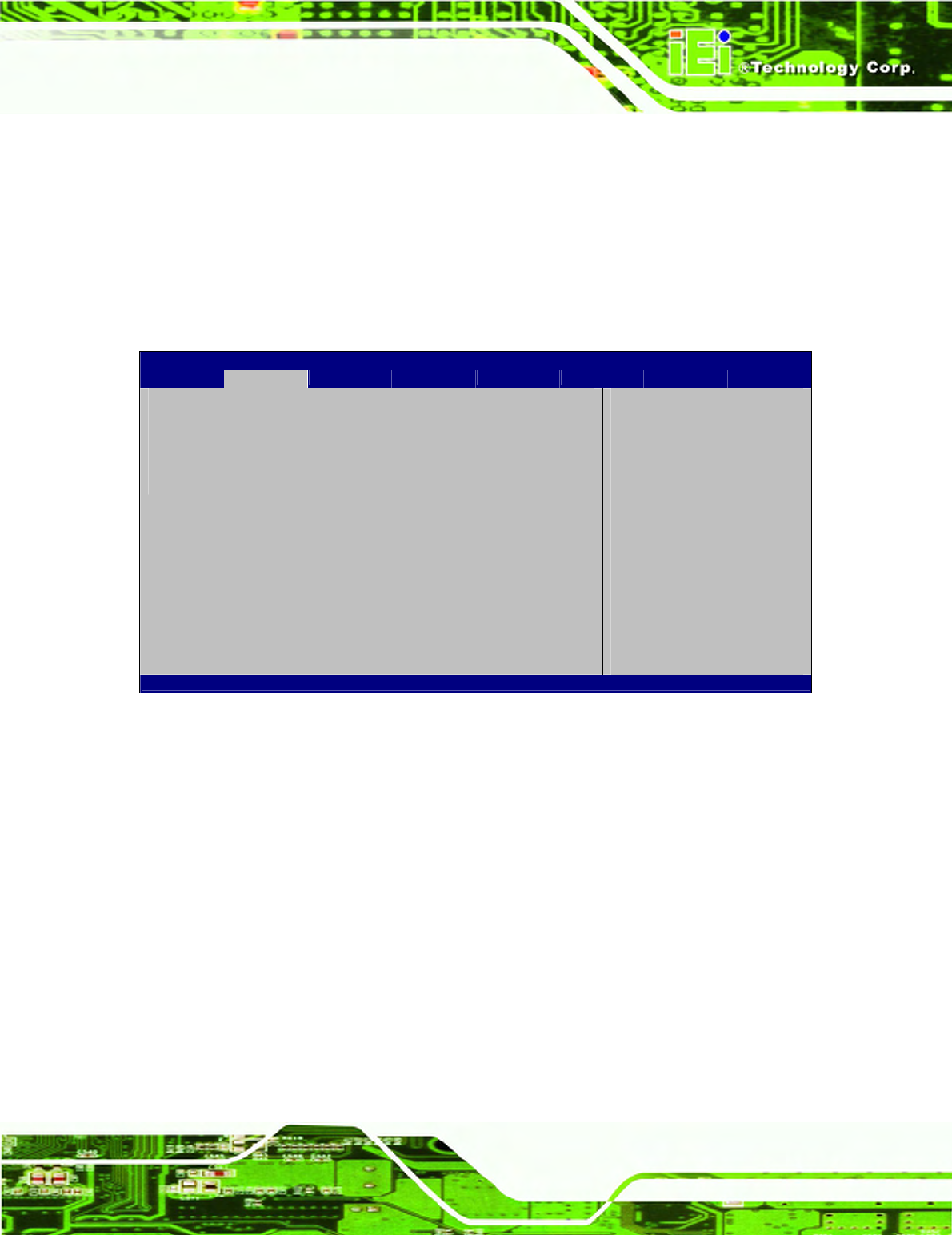
ICEFIRE-T10A Mobile Clinic Assistant
Page 69
Enabled
Enables the use of hyper threading technology
6.3.2 SATA Configuration
Use the SATA Configuration menu (
434H514H
BIOS Menu 4) to change and/or set the
configuration of the SATA devices installed in the system.
Aptio Setup Utility – Copyright (C) 2011 American Megatrends, Inc.
Advanced
SATA Port0 FiD 1.8 SATA10 (31.9G
ATA Or IDE Configuration [Enhanced]
Configure SATA as [IDE]
(1) IDE Mode. (2) AHCI
Mode. (3) RAID Mode.
---------------------
: Select Screen
↑ ↓: Select Item
Enter Select
F1 General Help
F2 Previous Values
F3 Optimized
Defaults
F4 Save
ESC Exit
Version 2.11.1210. Copyright (C) 2011 American Megatrends, Inc.
BIOS Menu 4: IDE
Configuration
ATA Or IDE Configurations [Ehanced]
Use the ATA Or IDE Configurations option to configure the ATA/IDE controller.
Disabled Disables the on-board ATA/IDE controller.
Enhanced D
EFAULT
Configures the on-board ATA/IDE controller to be in
Enhanced mode. In this mode, IDE channels and SATA
channels are separated. This mode supports up to 6
storage devices. Some legacy OS do not support this
mode.
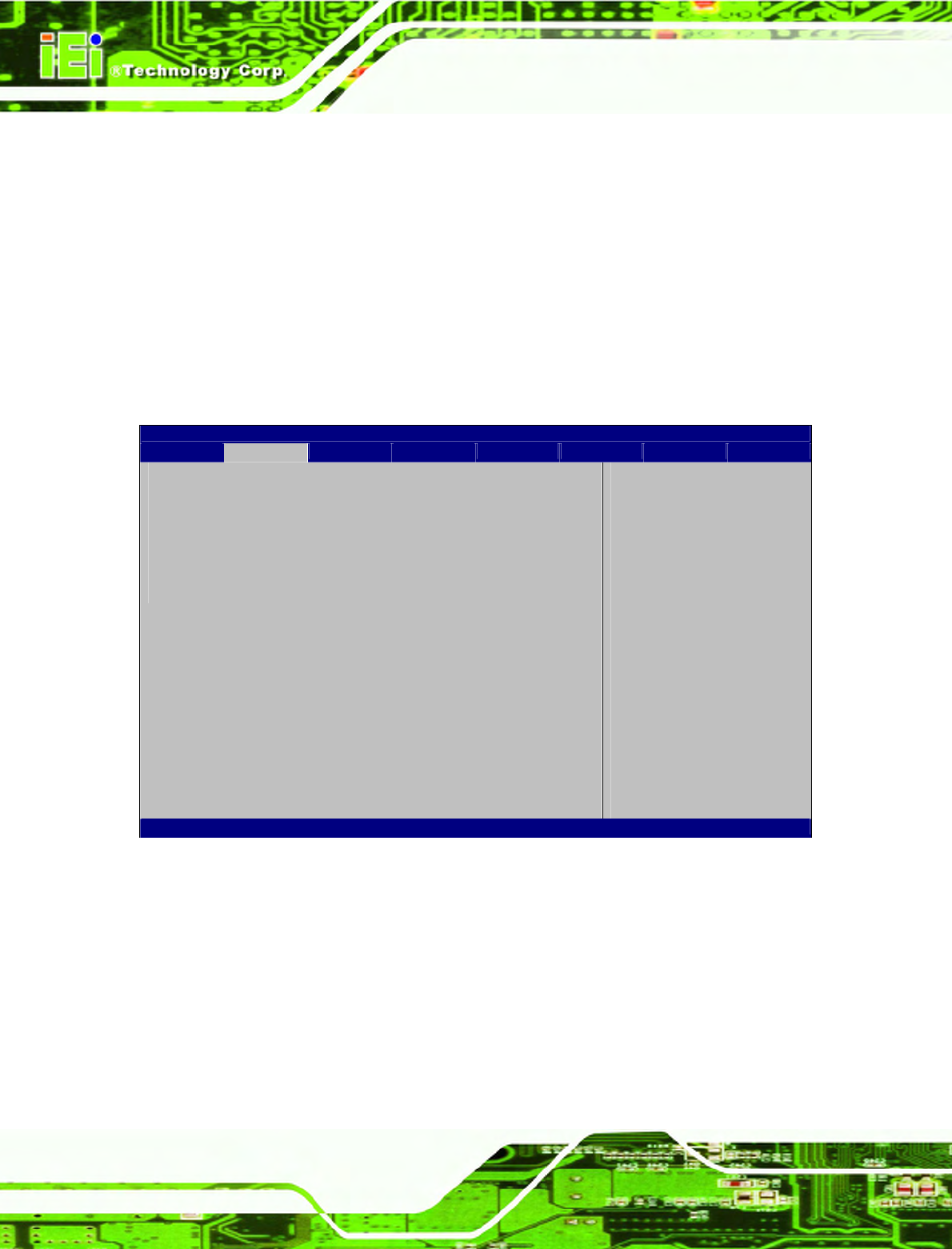
ICEFIRE-T10A Mobile Clinic Assistant
Page 70
Configure SATA as [IDE]
Use the Configure SATA as option to configure SATA devices as normal IDE devices.
IDE D
EFAULT
Configures SATA devices as normal IDE device.
AHCI Configures SATA devices as AHCI device.
6.3.3 USB Configuration
Use the USB Configuration menu (
435H515H
BIOS Menu 5) to read USB configuration information
and configure the USB settings.
Aptio Setup Utility – Copyright (C) 2011 American Megatrends, Inc.
Advanced
USB Configuration
USB Devices:
1 Keyboard, 2 Hubs
Legacy USB Support [Enabled]
Enables Legacy USB
support. AUTO option
disables legacy
support
if no USB devices are
connected. DISABLE
option will keep USB
devices available only
for EFI applications.
---------------------
: Select Screen
↑ ↓: Select Item
Enter Select
F1 General Help
F2 Previous Values
F3 Optimized
Defaults
F4 Save
ESC Exit
Version 2.11.1210. Copyright (C) 2011 American Megatrends, Inc.
BIOS Menu 5: USB Configuration
USB Devices
The USB Devices Enabled field lists the USB devices that are enabled on the system
Legacy USB Support [Enabled]
Use the Legacy USB Support BIOS option to enable USB mouse and USB keyboard
support. Normally if this option is not enabled, any attached USB mouse or USB keyboard
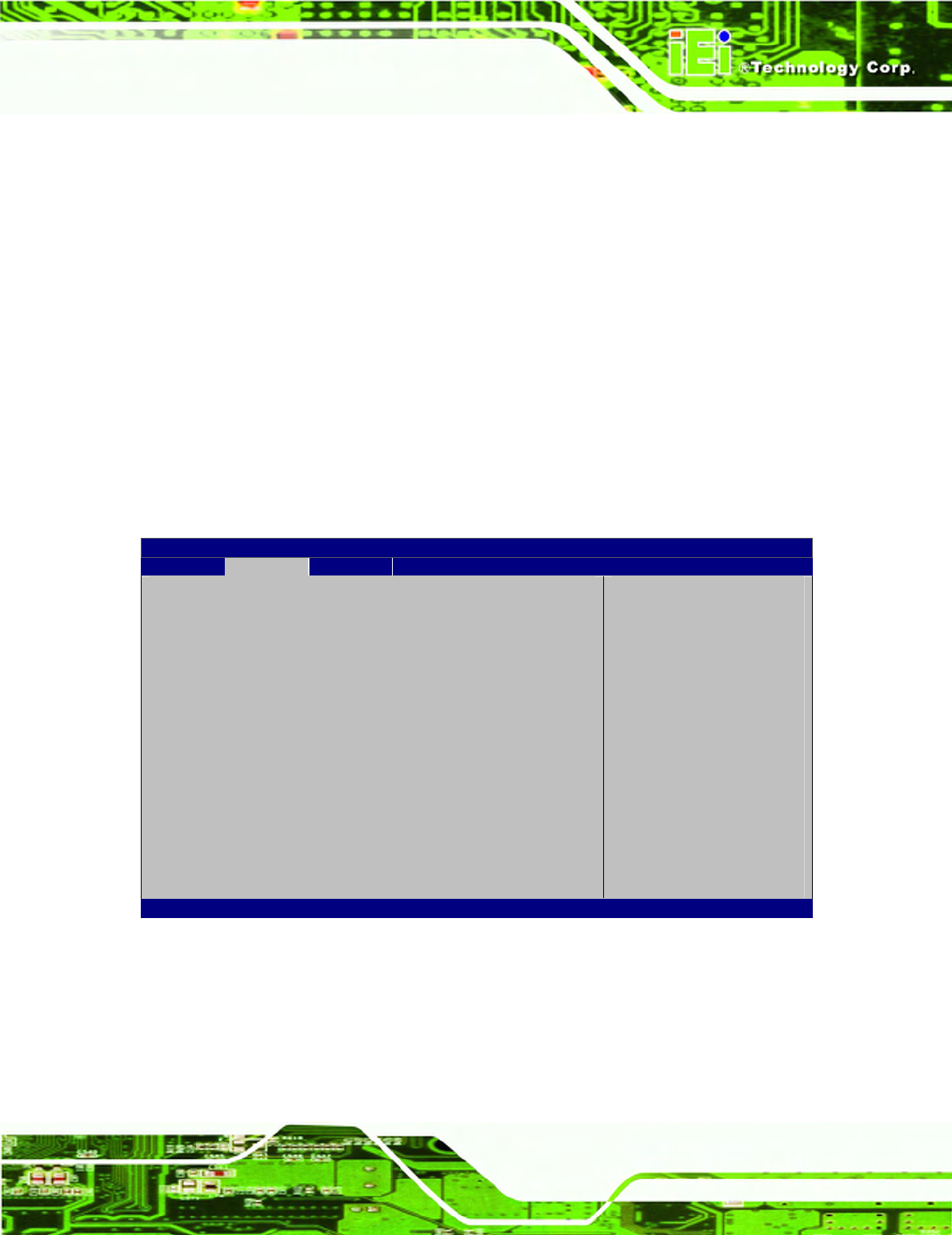
ICEFIRE-T10A Mobile Clinic Assistant
Page 71
does not become available until a USB compatible operating system is fully booted with all
USB drivers loaded. When this option is enabled, any attached USB mouse or USB
keyboard can control the system even when there is no USB driver loaded onto the
system.
Enabled D
EFAULT
Legacy USB support enabled
Disabled Legacy USB support disabled
Auto Legacy USB support disabled if no USB devices are
connected
6.3.4 H/W Monitor
The H/W Monitor menu (
436H516H
BIOS Menu 6) shows the operating temperature, fan speeds and
system voltages.
Aptio Setup Utility – Copyright (C) 2011 American Megatrends, Inc.
Advanced
CPU Temperature :+66 C
Accuracy: 1. -5 ~ +10 degree around 100 degree.
2. -10 ~ +15 degree around 50 degree.
SYS Temperature :+55 C
System FAN1 Speed :5644 RPM
> System FAN1 Configuration
---------------------
: Select Screen
↑ ↓: Select Item
Enter Select
F1 General Help
F2 Previous Values
F3 Optimized
Defaults
F4 Save
ESC
Exit
Version 2.11.1210. Copyright (C) 2011 American Megatrends, Inc.
BIOS Menu 6: Hardware Health Configuration
PC Health Status
The following system parameters and values are shown. The system parameters that are
monitored are:
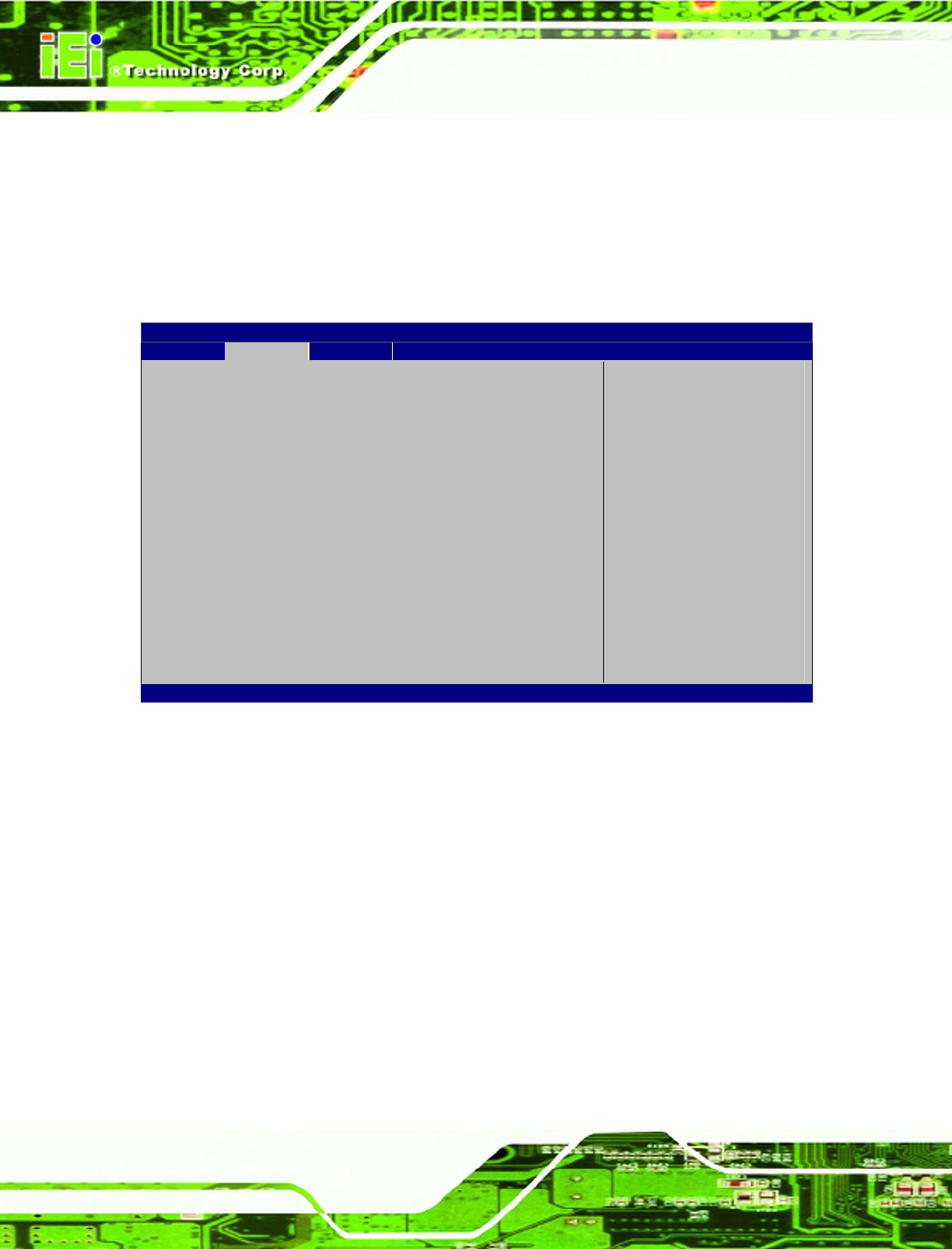
ICEFIRE-T10A Mobile Clinic Assistant
Page 72
CPU Temperature
System Temperature
System Fan Speed
6.3.4.1 System FAN1 Configuration
The System FAN1 Configuration menu (
436517H
BIOS Menu 7) configures the system fan (FAN1).
Aptio Setup Utility – Copyright (C) 2011 American Megatrends, Inc.
Advanced
PC Health Status
CPU Smart Fan control [Auto Mode by PWM]
Temperature Of Start 70
Temperature of Off 60
Start PWM 100
Slope (PWM) [1 (PWM)]
---------------------
: Select Screen
↑ ↓: Select Item
Enter Select
F1 General Help
F2 Previous Values
F3 Optimized
Defaults
F4 Save
ESC Exit
Version 2.11.1210. Copyright (C) 2011 American Megatrends, Inc.
BIOS Menu 7: Hardware Health Configuration
Mode Setting [Full On Mode]
Use the Mode Setting option to configure the second fan.
Full Mode D
EFAULT
Fan is on all the time
Manual Mode
by PWM
The fan spins at the speed set in:
Manual Setting
Auto Mode by
PWM
The fan adjusts its speed using these settings:
Temperature of Start
Temperature of Off
Start PWM
Slope (PWM)
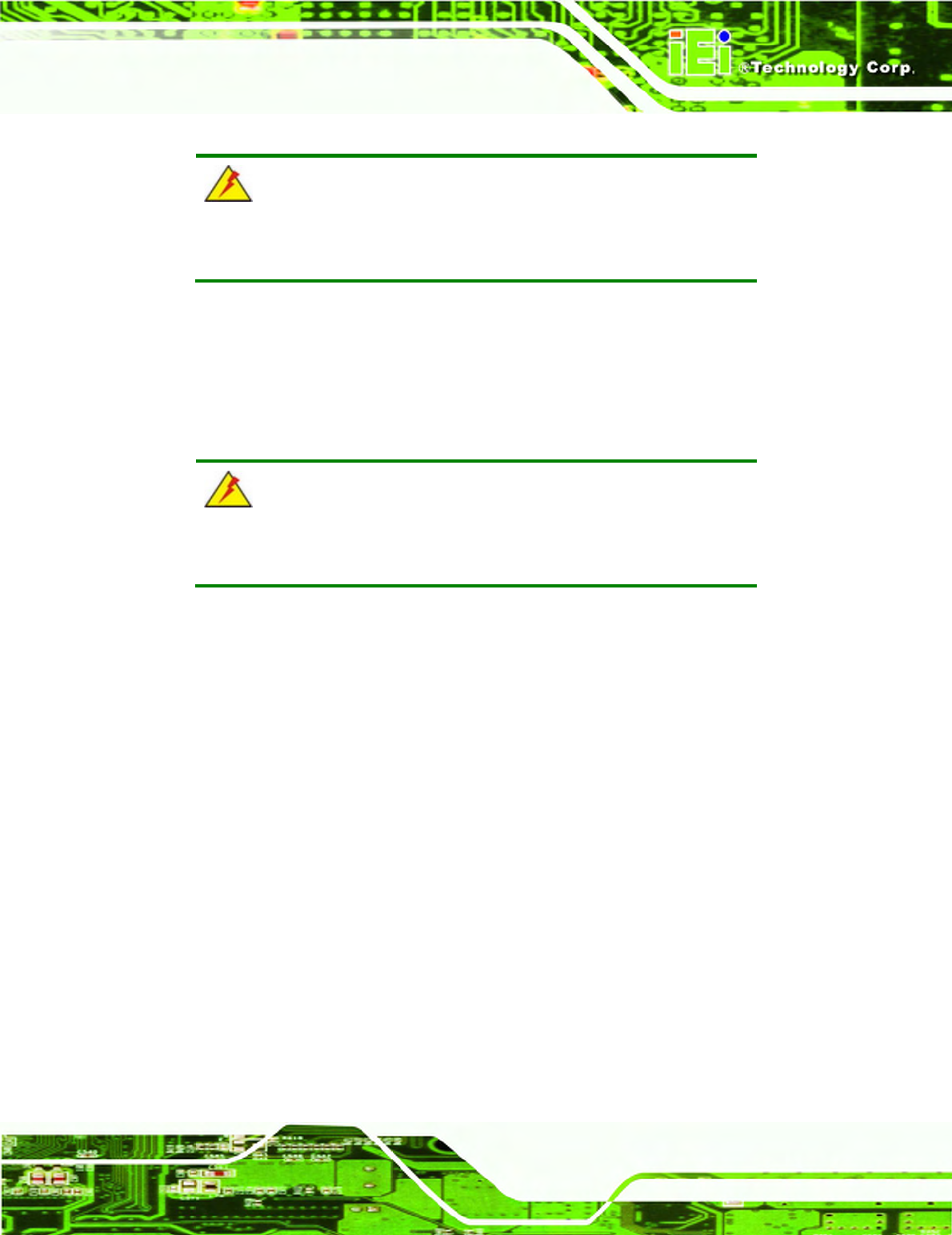
ICEFIRE-T10A Mobile Clinic Assistant
Page 73
Temperature of Start [070]
WARNING:
CPU failure can result if this value is set too high
When the fan is off, it will only start when the temperature exceeds this setting.
Minimum Value: 0°C
Maximum Value: 100°C
Temperature of Off [060]
WARNING:
CPU failure can result if this value is set too high
The fan will turn off if the temperature falls below this value.
Minimum Value: 0°C
Maximum Value: 100°C
Start PWM [100]
This is the initial speed of the fan when it first starts spinning.
PWM Minimum Mode: 0
PWM Maximum Mode: 100
Slope PWM [1 PWM]
A bigger value will increase the fan speed in big amounts. A smaller value will increase the
speed more gradually.
0 PWM
1 PWM
2 PWM
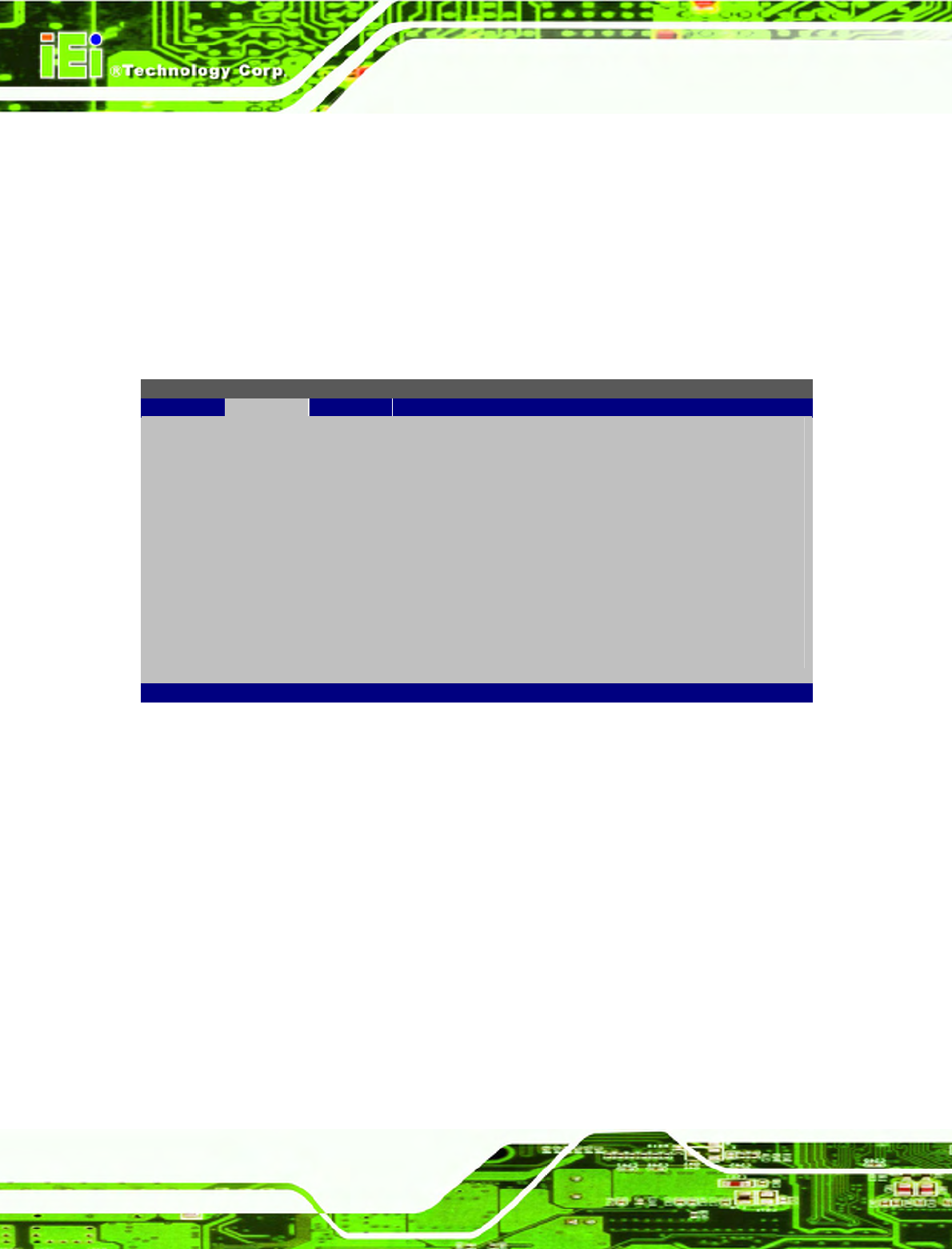
ICEFIRE-T10A Mobile Clinic Assistant
Page 74
4 PWM
8 PWM
16 PWM
32 PWM
64 PWM
6.3.5 IEI Feature
Use the IEI Feature menu (
518H
BIOS Menu 8) to configure One Key Recovery function.
BIOS SETUP UTILITY
Main Advanced
PCIPNP Boot Security
Chipset
Exit
iEi Feature
Auto Recovery Function [Disabled]
Select Screen
↑ ↓ Select Item
Enter Go to SubScreen
F1 General Help
F10 Save and Exit
ESC Exit
v02.61 ©Copyright 1985-2006, American Megatrends, Inc.
BIOS Menu 8: IEI Feature
Auto Recovery Function [Disabled]
Use the Auto Recovery Function BIOS option to enable or disable the auto recovery
function of the IEI One Key Recovery.
Disabled D
EFAULT
Auto recovery function disabled
Enabled Auto recovery function enabled
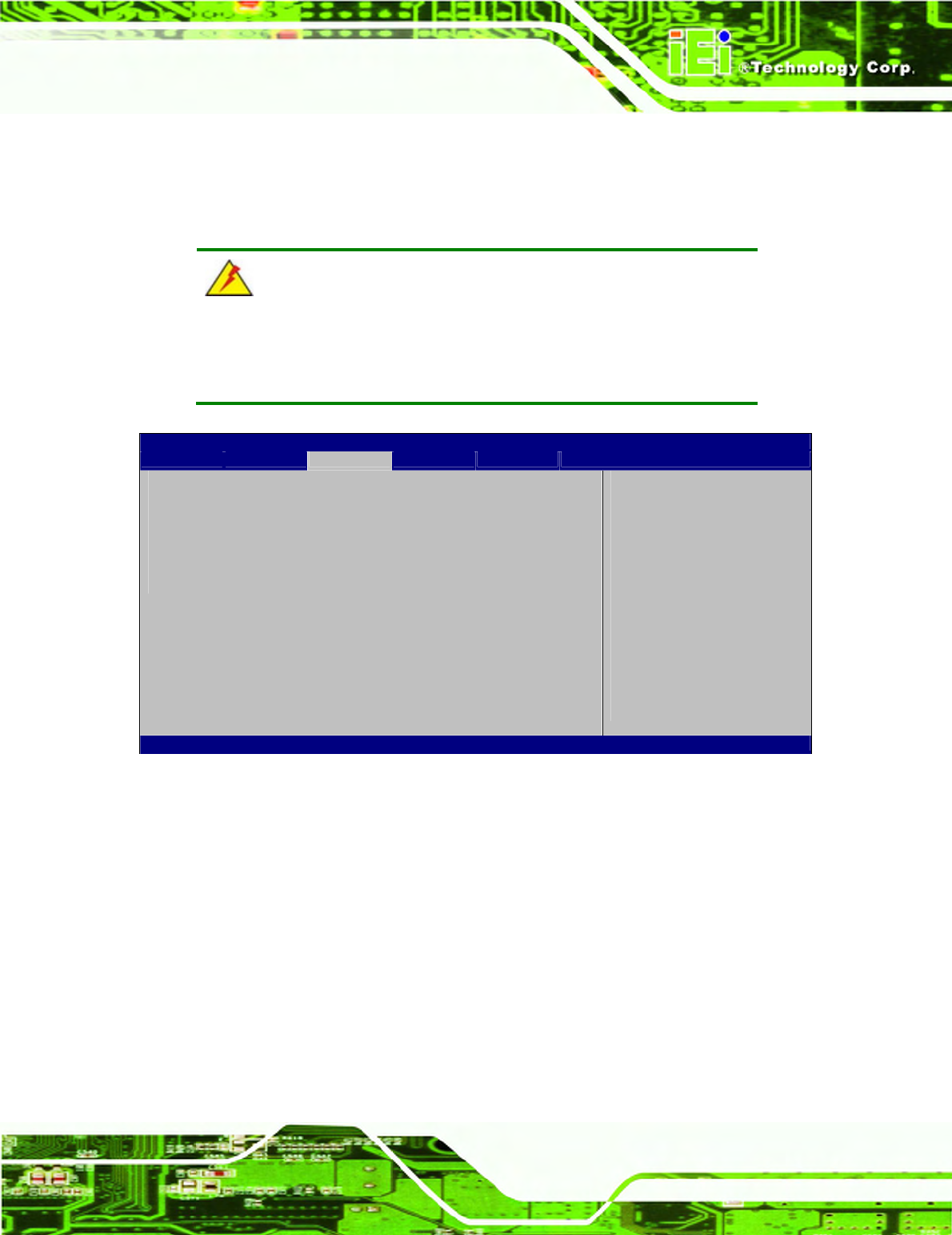
ICEFIRE-T10A Mobile Clinic Assistant
Page 75
6.4 Chipset
Use the Chipset menu (
437H519H
BIOS Menu 9) to access the Northbridge and Southbridge
configuration menus
WARNING!
Setting the wrong values for the Chipset BIOS selections in the Chipset
BIOS menu may cause the system to malfunction.
Aptio Setup Utility – Copyright (C) 2011 American Megatrends, Inc.
Main Advanced
Chipset
Boot Security
Save & Exit
RTL8102 PXE Boot [Disabled]
> Host Bridge
> South Bridge
> Intel IGD SWSCI OpRegion
North Bridge Parameters
---------------------
: Select Screen
↑ ↓: Select Item
Enter Select
F1 General Help
F2 Previous Values
F3 Optimized
Defaults
F4 Save
ESC Exit
Version 2.11.1210. Copyright (C) 2011 American Megatrends, Inc.
BIOS Menu 9: Chipset
RTL8102 PXE Boot [Disabled]
Use the RTL8102 PXE Boot option to enable or disable the boot option for GbE devices.
Disabled D
EFAULT
Disables the RTL8102 PXE Boot option
Enabled Enables the RTL8102 PXE Boot option
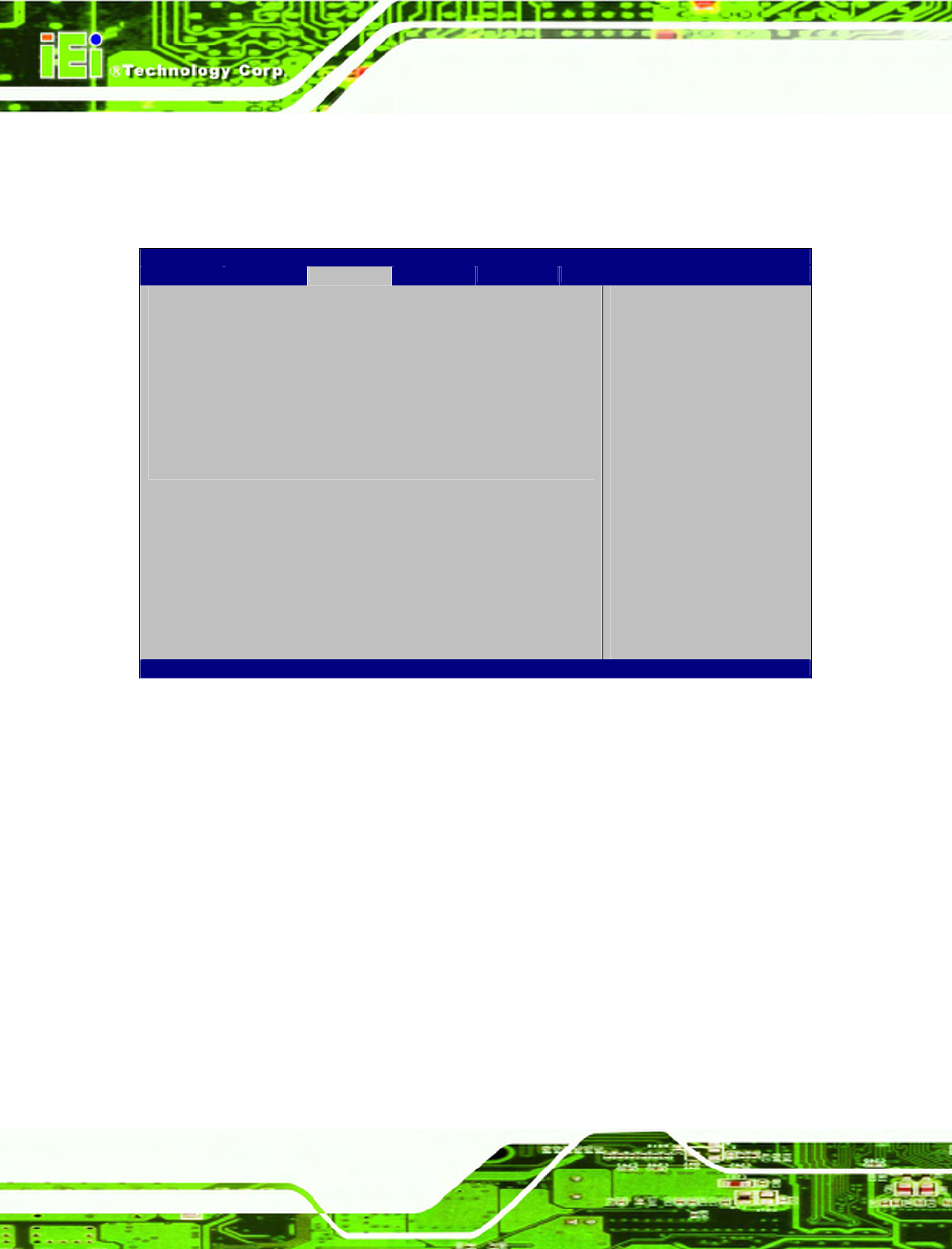
ICEFIRE-T10A Mobile Clinic Assistant
Page 76
6.4.1 Host Bridge Configuration
Use the Host Bridge Configuration menu (
520H
BIOS Menu 10) to configure the Northbridge
chipset.
Aptio Setup Utility – Copyright (C) 2011 American Megatrends, Inc.
Chipset
******* Memory Information *******
Memory Frequency 800 Mhz
Total Memory 2048 MB
DIMM#0 2048 MB
Select which graphics
controller to use as the
primary boot device.
---------------------
: Select Screen
↑ ↓: Select Item
Enter Select
F1 General Help
F2 Previous Values
F3 Optimized
Defaults
F4 Save
ESC
Exit
Version 2.11.1210. Copyright (C) 2011 American Megatrends, Inc.
BIOS Menu 10: Host Bridge Chipset Configuration
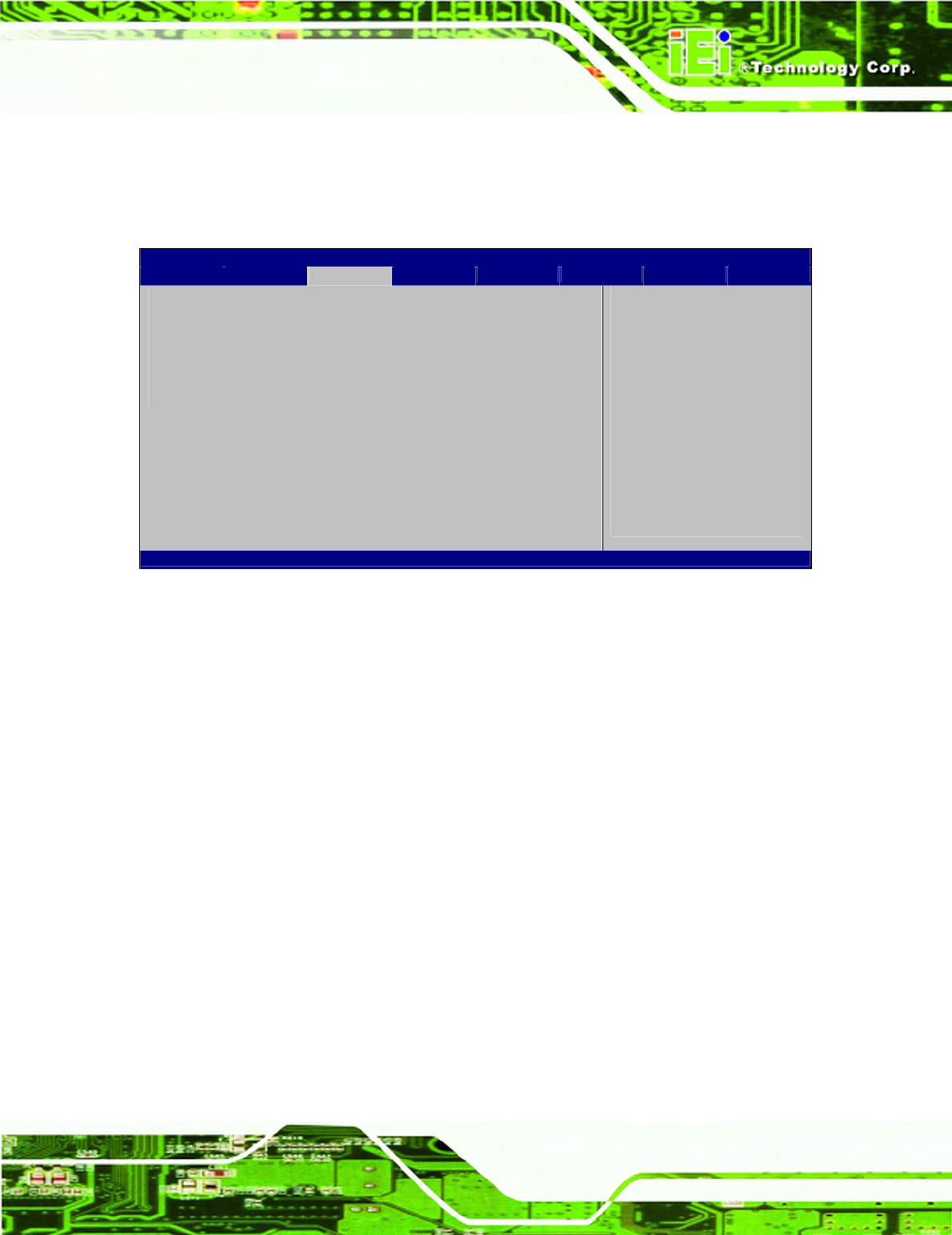
ICEFIRE-T10A Mobile Clinic Assistant
Page 77
6.4.2 South Bridge Configuration
Use the South Bridge Configuration menu (
438H521H
BIOS Menu 11) to configure the
Southbridge chipset.
Aptio Setup Utility – Copyright (C) 2011 American Megatrends, Inc.
Chipset
HD Audio Controller [Enabled]
USB Function [Enabled]
USB 2.0 (EHCI) Support [Enabled]
Set Spread Spectrum function [Disabled]
HD Audio Controller
---------------------
: Select Screen
↑ ↓: Select Item
Enter Select
F1 General Help
F2 Previous Values
F3 Optimized
Defaults
F4 Save
ESC Exit
Version 2.11.1210. Copyright (C) 2011 American Megatrends, Inc.
BIOS Menu 11:South Bridge Chipset Configuration
HD Audio Controller [Enabled]
Use the HD Audio Controller option to enable or disable the High Definition Audio
controller.
Enabled D
EFAULT
The onboard High Definition Audio controller
automatically detected and enabled
Disabled
The onboard High Definition Audio controller is disabled
USB Function [Enabled]
Use the USB Function BIOS option to enable or disable USB function support.
Disabled USB function support disabled
Enabled D
EFAULT
USB function support enabled
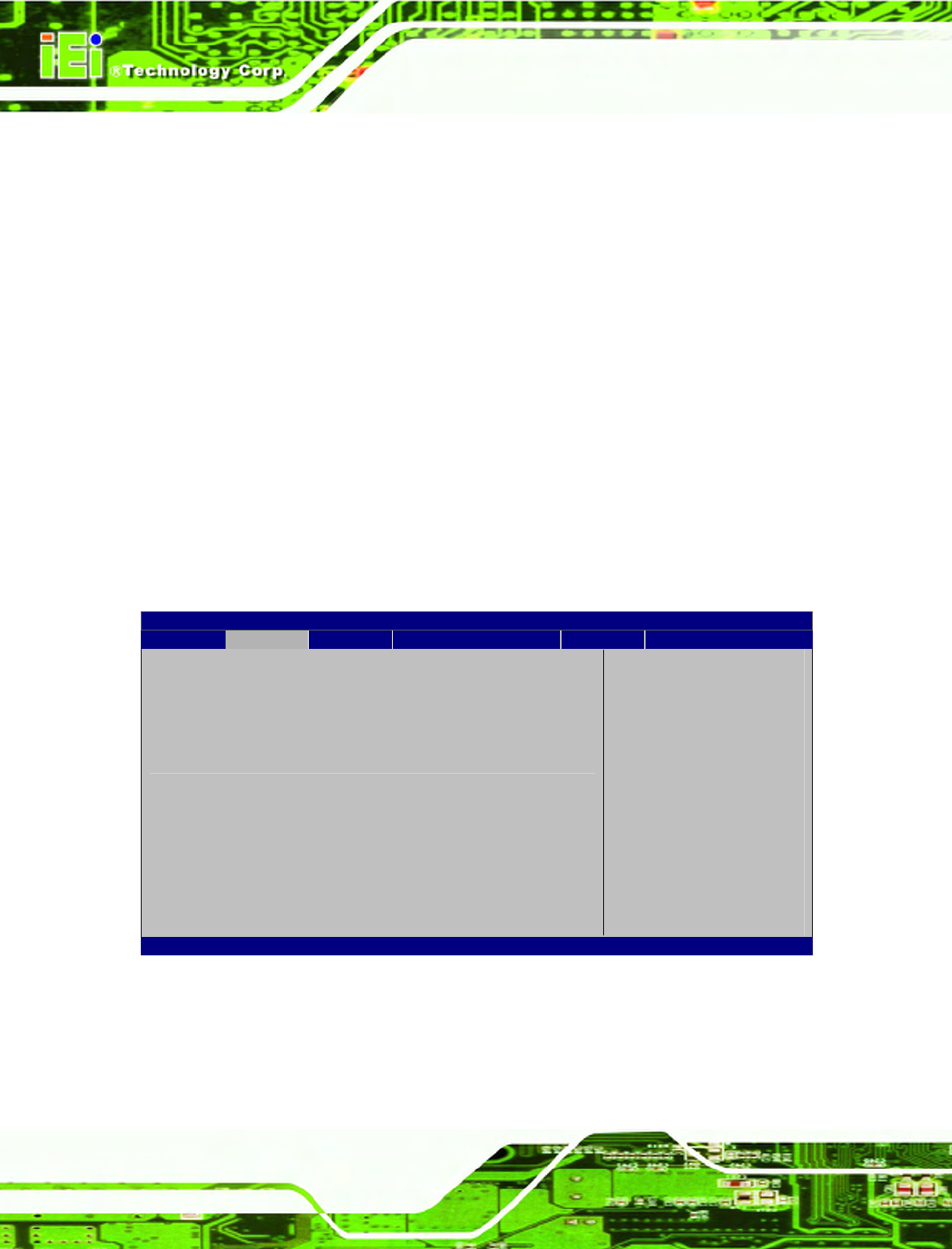
ICEFIRE-T10A Mobile Clinic Assistant
Page 78
USB 2.0 (EHCI) Support [Enabled]
Use the USB 2.0 (EHCI) Support BIOS option to enable or disable the USB 2.0 controller.
Enabled D
EFAULT
USB 2.0 controller enabled
Disabled USB 2.0 controller disabled
Set Spread Spectrum Function [Disabled]
The Set Spread Spectrum Function option can help to improve CPU EMI issues.
Disabled
D
EFAULT
The spread spectrum mode is disabled
Enabled The spread spectrum mode is enabled
6.4.3 Intel IGD SWSCI OpRegion
Use the Intel IGD SWSCI OpRegion menu to configure the video device connected to the
system.
Aptio Setup Utility – Copyright (C) 2011 American Megatrends, Inc.
Advanced
Intel IGD SWSCI OpRegion Configuration
DVMT Mode Select [DVMT Mode]
DVMT/Fixed Memory [Maximum]
IGD - Boot Type [VBIOS Default]
Select DVMT/FIXED Mode
Memory size used by
Internal Graphics Device
---------------------
: Select Screen
↑ ↓: Select Item
Enter Select
F1 General Help
F2 Previous Values
F3 Optimized
Defaults
F4 Save
ESC Exit
Version 2.11.1210. Copyright (C) 2011 American Megatrends, Inc.
BIOS Menu 12: Intel IGD SWSCI OpRegion
DVMT Mode Select [DVMT Mode]
Use the DVMT Mode Select option to select the Intel Dynamic Video Memory Technology
(DVMT) operating mode.
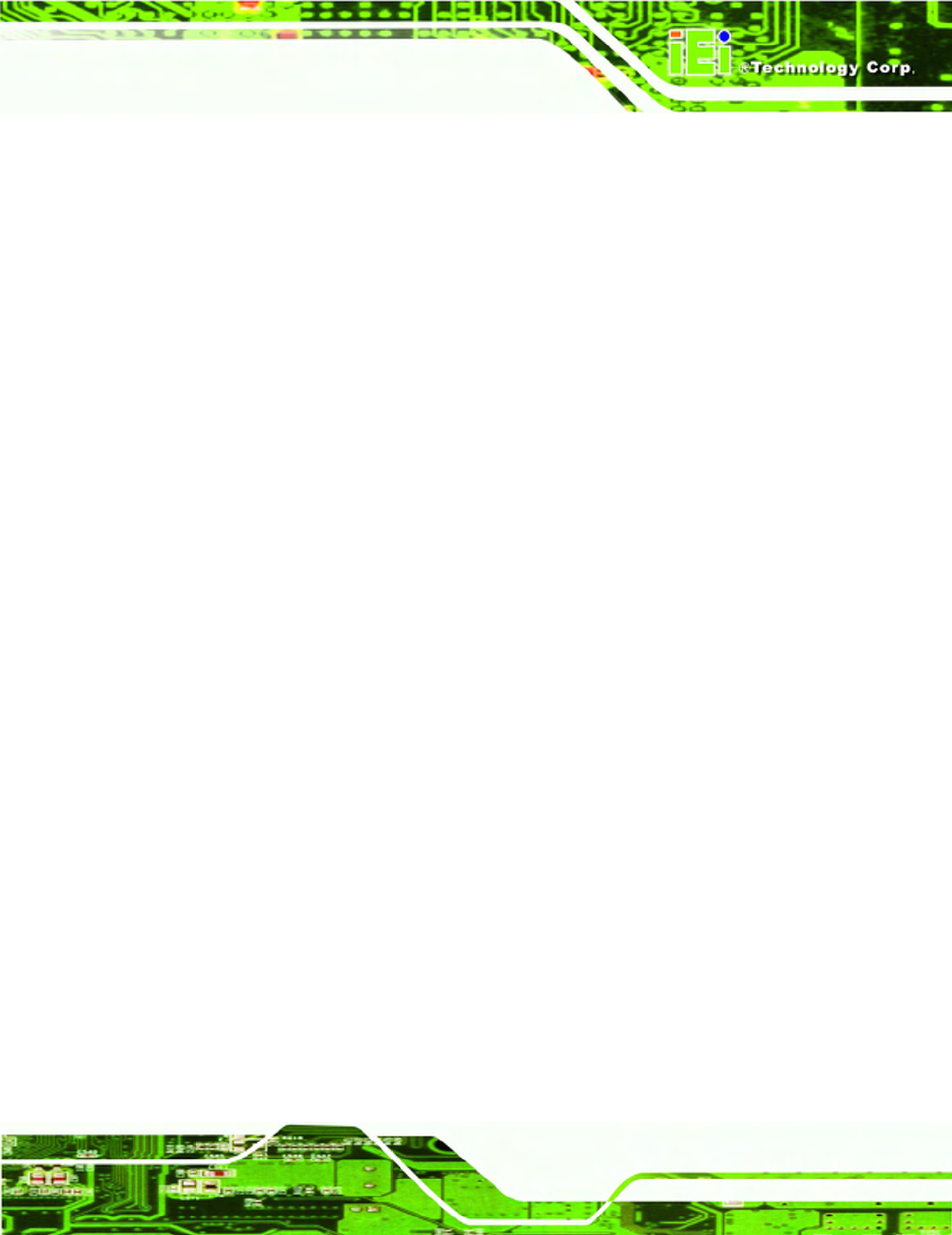
ICEFIRE-T10A Mobile Clinic Assistant
Page 79
Fixed Mode
A fixed portion of graphics memory is reserved as graphics
memory.
DVMT Mode
D
EFAULT
Graphics memory is dynamically allocated according to the
system and graphics needs.
DVMT/FIXED Memory [Maximum]
Use the DVMT/FIXED Memory option to specify the maximum amount of memory that
can be allocated as graphics memory. Configuration options are listed below.
128 MB
256 MB
Maximum Default
IGD - Boot Type [VBIOS Default]
Use the IGD - Boot Type option to select the display device used by the system when it
boots. Configuration options are listed below.
VBIOS Default
D
EFAULT
CRT (Docking use)
LFP
CRT + LFP (Docking use)
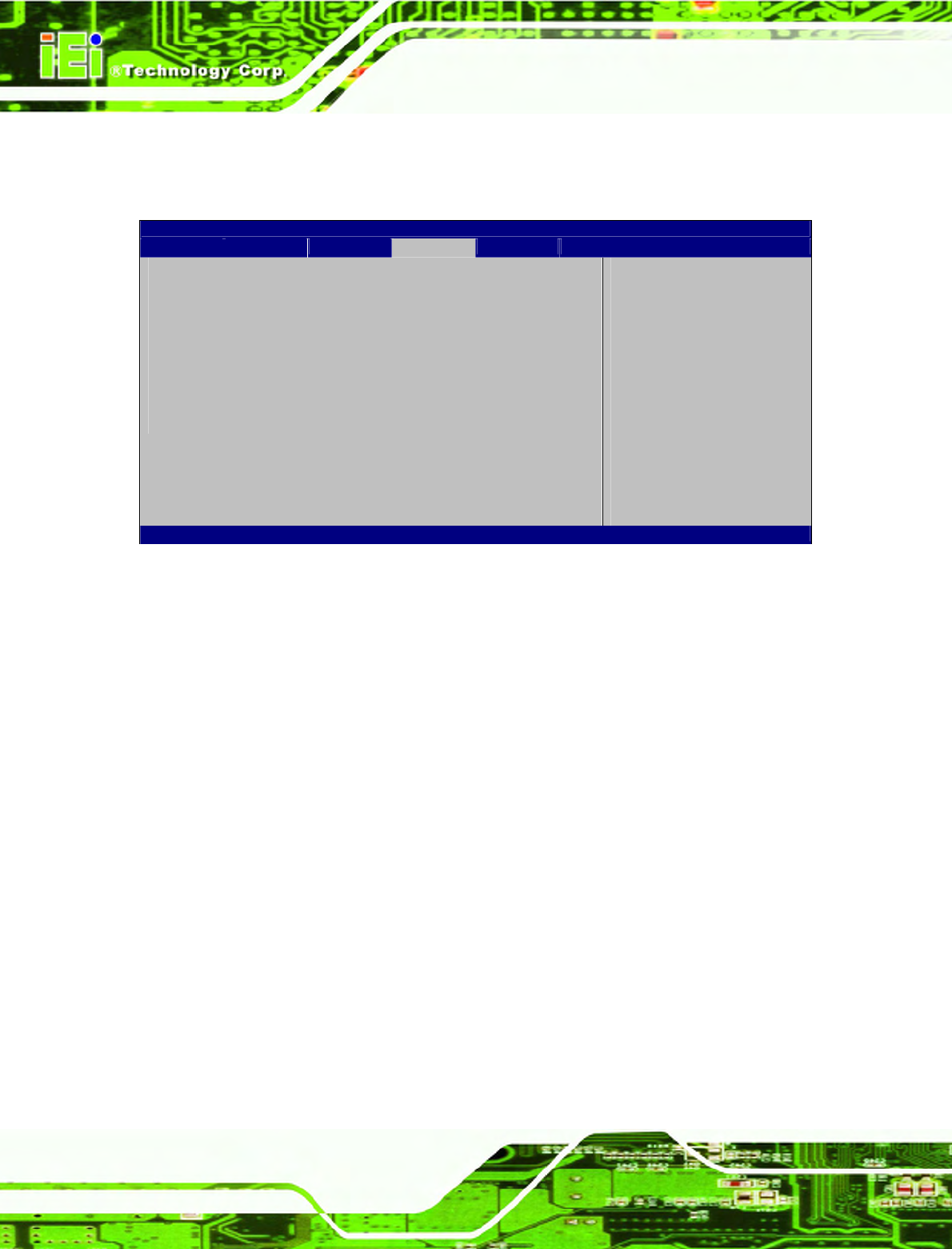
ICEFIRE-T10A Mobile Clinic Assistant
Page 80
6.5 Boot
Use the Boot menu (
439H522H
BIOS Menu 13) to configure system boot options.
Aptio Setup Utility – Copyright (C) 2011 American Megatrends, Inc.
Main Advanced
Chipset
Boot Security
Save & Exit
Boot Configuration
Boot NumLock State [On]
Quiet Boot [Enabled]
Boot Option Priorities
Boot Option #1 [SATA: FiD 1.8 SATA..]
Hard Drive BBS Priorities
Enables/Disables Quiet
Boot option
---------------------
: Select Screen
↑ ↓: Select Item
Enter Select
F1 General Help
F2 Previous Values
F3 Optimized
Defaults
F4 Save
ESC
Exit
Version 2.11.1210. Copyright (C) 2011 American Megatrends, Inc.
BIOS Menu 13: Boot
Bootup NumLock State [On]
Use the Bootup NumLock State BIOS option to specify if the number lock setting must
be modified during boot up.
On D
EFAULT
Allows the Number Lock on the keyboard to be
enabled automatically when the computer system
boots up. This allows the immediate use of the
10-key numeric keypad located on the right side of
the keyboard. To confirm this, the Number Lock LED
light on the keyboard is lit.
Off Does not enable the keyboard Number Lock
automatically. To use the 10-keys on the keyboard,
press the Number Lock key located on the upper
left-hand corner of the 10-key pad. The Number
Lock LED on the keyboard lights up when the
Number Lock is engaged.
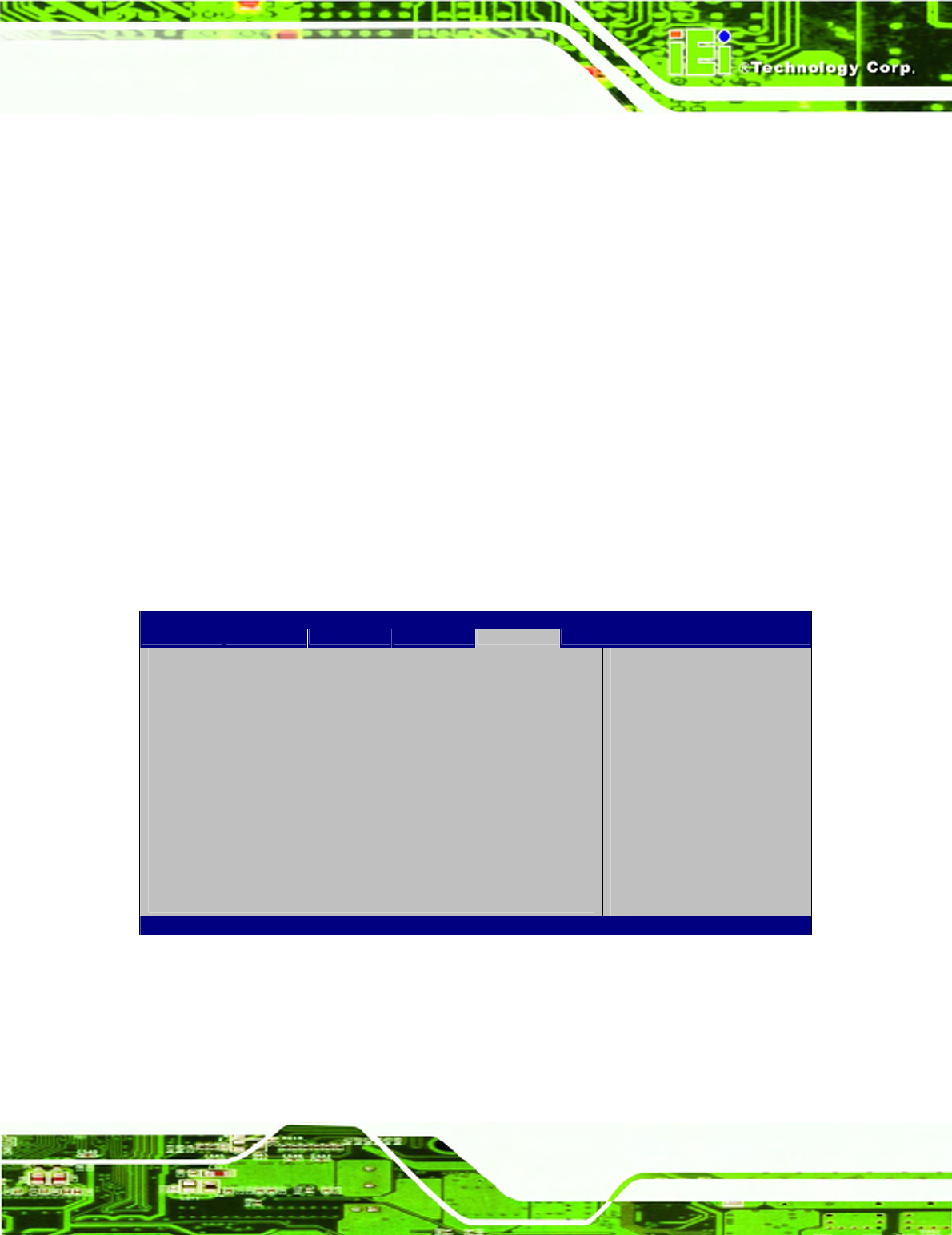
ICEFIRE-T10A Mobile Clinic Assistant
Page 81
Quiet Boot [Enabled]
Use the Quiet Boot BIOS option to select the screen display when the system boots.
Disabled Normal POST messages displayed
Enabled D
EFAULT
OEM Logo displayed instead of POST messages
Boot Option #1 [SATA: FiD 1.8 SATA…]
Use the Boot Option #1 option to specify the boot priority from the available devices.
Hard Drive BBS Priorities
Use the Hard Drive BBS Priorities option to set the order of the legacy devices in this
group.
6.6 Security
Use the Security menu (
440H523H
BIOS Menu 14) to set system and user passwords.
Aptio Setup Utility – Copyright (C) 2011 American Megatrends, Inc.
Main Advanced
Chipset
Boot Security
Save & Exit
Password Description
If ONLY the Administrator’s password is set,
then this only limits access to Setup and is
only asked for when entering Setup
If ONLY the User’s password is set, then this
is a power on password and must be entered to
boot or enter Setup. In Setup the User will
have Administrator rights.
Administrator Password
User Password
Set Setup Administrator
Password
---------------------
: Select Screen
↑ ↓: Select Item
Enter Select
F1 General Help
F2 Previous Values
F3 Optimized
Defaults
F4 Save
ESC
Exit
Version 2.11.1210. Copyright (C) 2011 American Megatrends, Inc.
BIOS Menu 14: Security
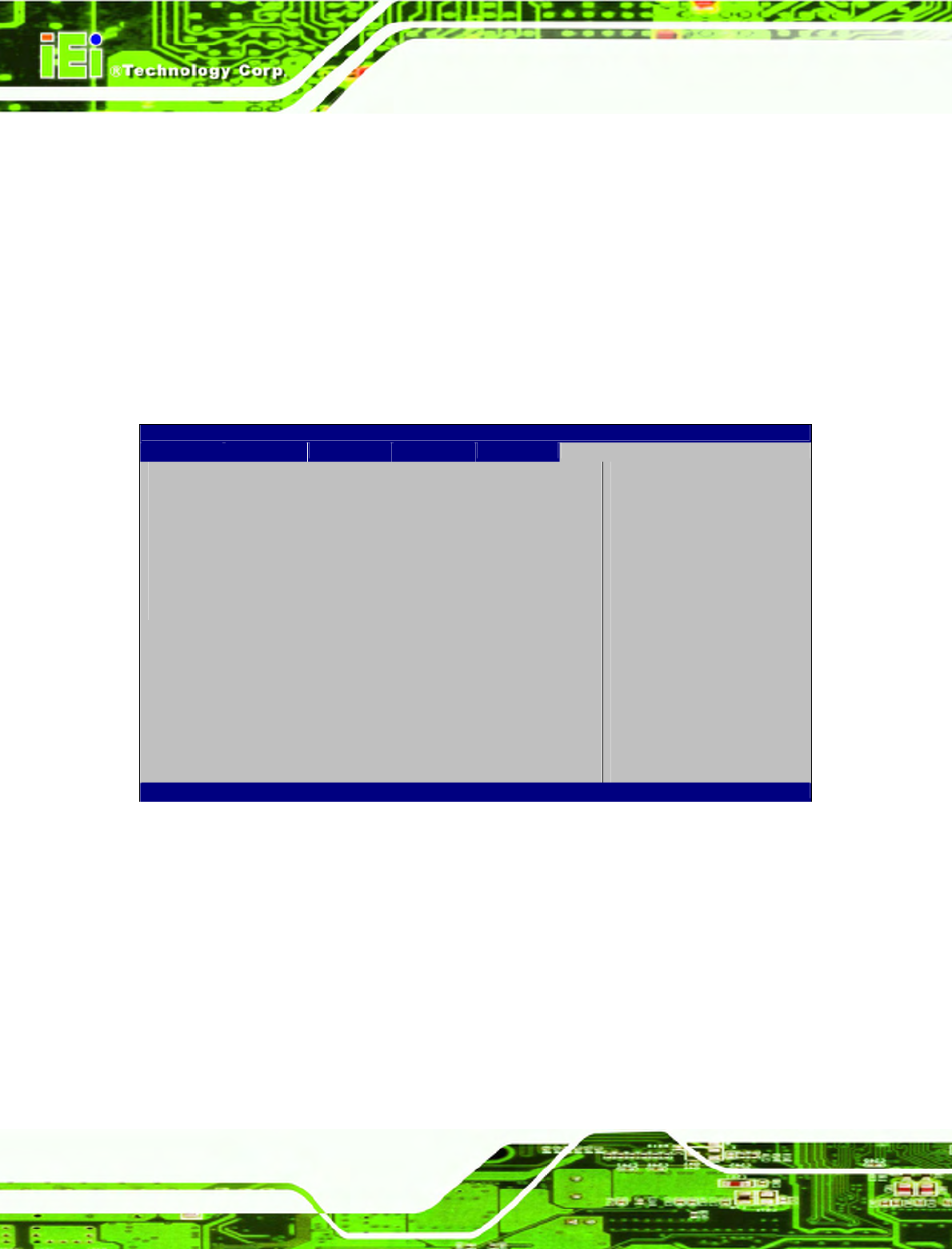
ICEFIRE-T10A Mobile Clinic Assistant
Page 82
Administrator Password
Use the Administrator Password to set or change a administrator password.
User Password
Use the User Password to set or change a user password.
6.7 Exit
Use the Exit menu (
441H524H
BIOS Menu 15) to load default BIOS values, optimal failsafe values
and to save configuration changes.
Aptio Setup Utility – Copyright (C) 2011 American Megatrends, Inc.
Main Advanced
Chipset
Boot Security
Save & Exit
Save Changes and Reset
Discard Changes and Reset
Restore Defaults
Save as User Defaults
Restore User Defaults
Exit system setup after
saving the changes.
---------------------
: Select Screen
↑ ↓: Select Item
Enter Select
F1 General Help
F2 Previous Values
F3 Optimized
Defaults
F4 Save
ESC Exit
Version 2.11.1210. Copyright (C) 2011 American Megatrends, Inc.
BIOS Menu 15:Exit
Save Changes and Reset
Use the Save Changes and Reset option to save the changes made to the BIOS options
and to exit the BIOS configuration setup program.
Discard Changes and Reset
Use the Discard Changes and Reset option to exit the system without saving the
changes made to the BIOS configuration setup program.
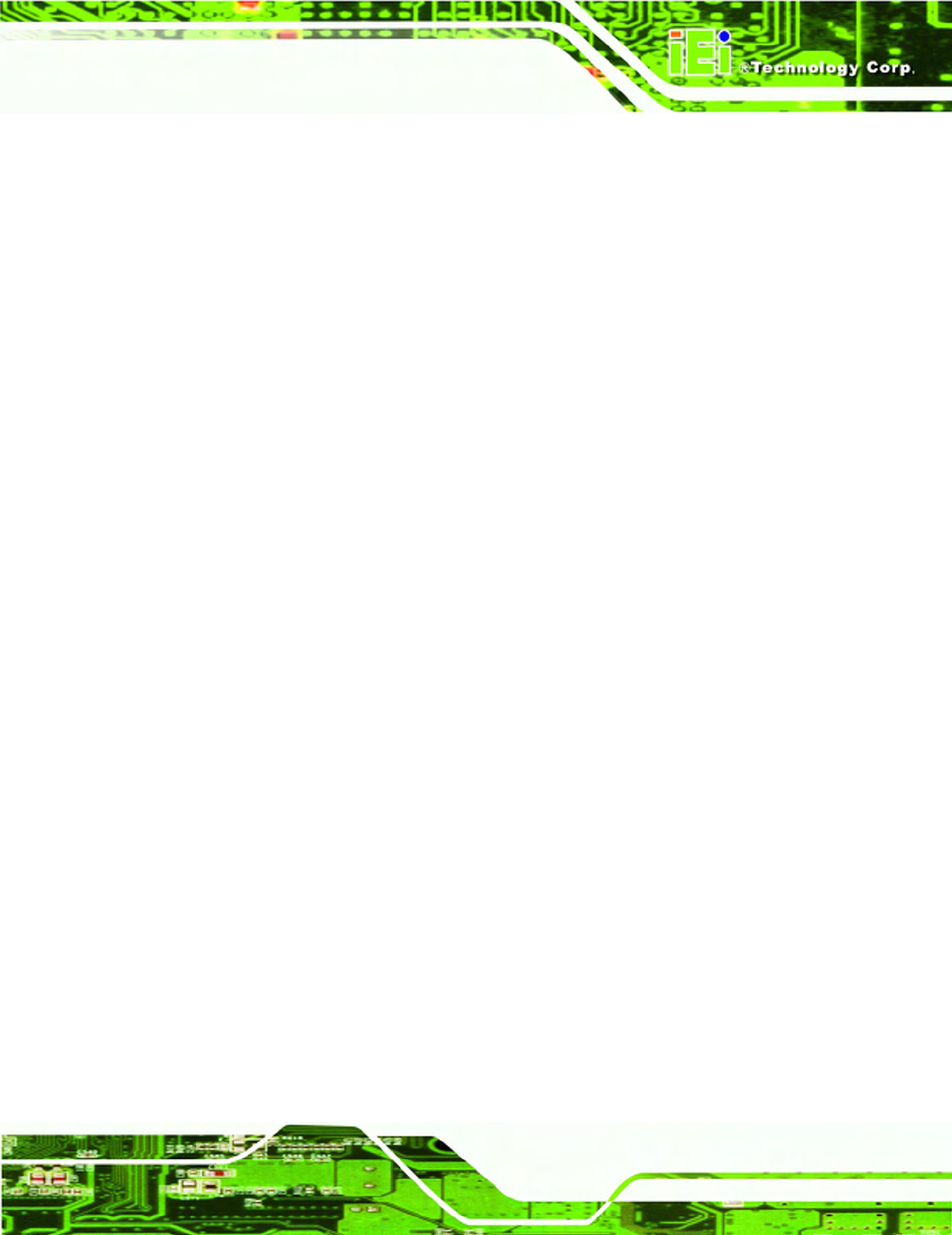
ICEFIRE-T10A Mobile Clinic Assistant
Page 83
Restore Defaults
Use the Restore Defaults option to load the optimal default values for each of the
parameters on the Setup menus. F3 key can be used for this operation.
Save as User Defaults
Use the Save as User Defaults option to save the changes done so far as user defaults.
Restore User Defaults
Use the Restore User Defaults option to restore the user defaults to all the setup options.
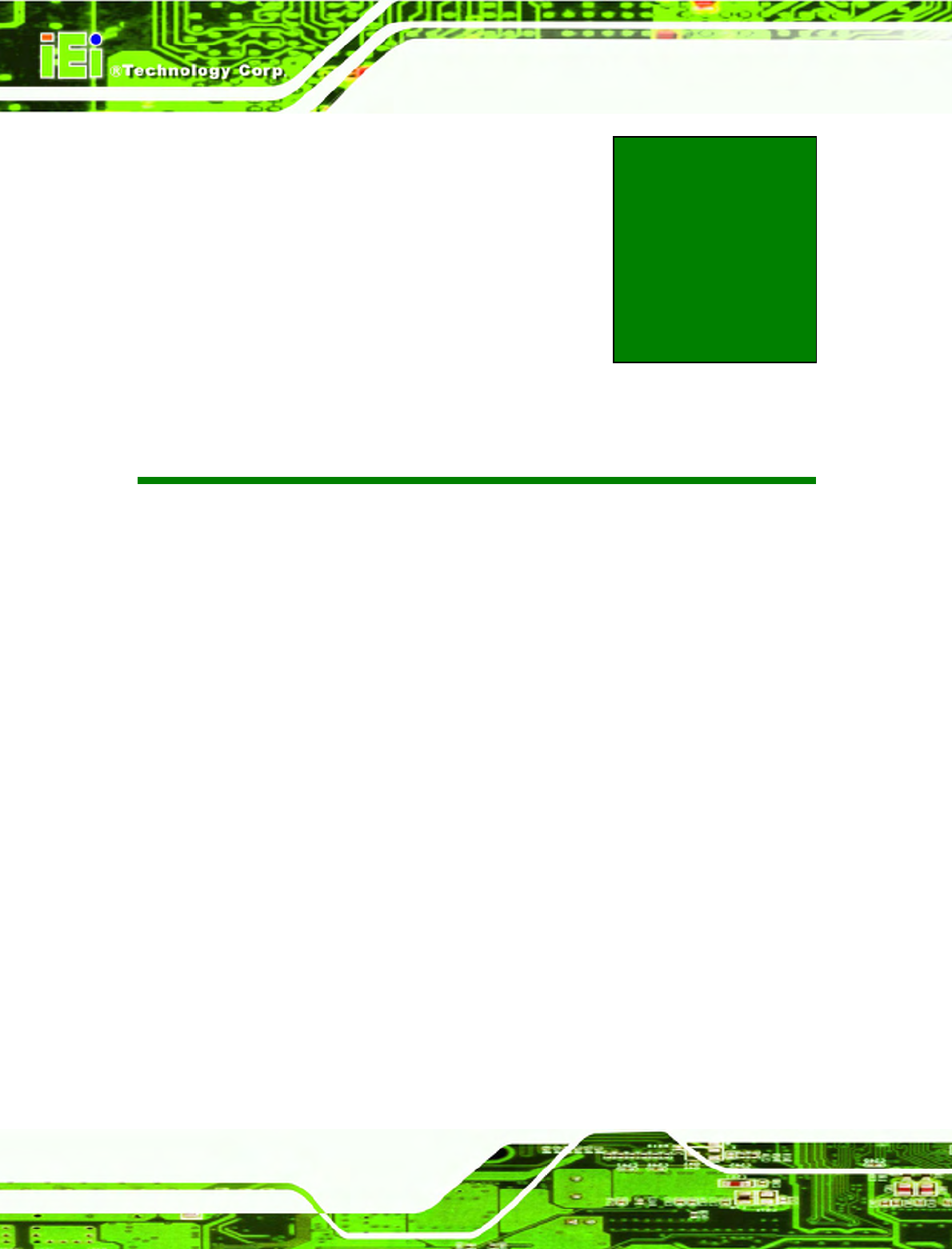
ICEFIRE-T10A Mobile Clinic Assistant
Page 84
Chapter
7
7 System Maintenance
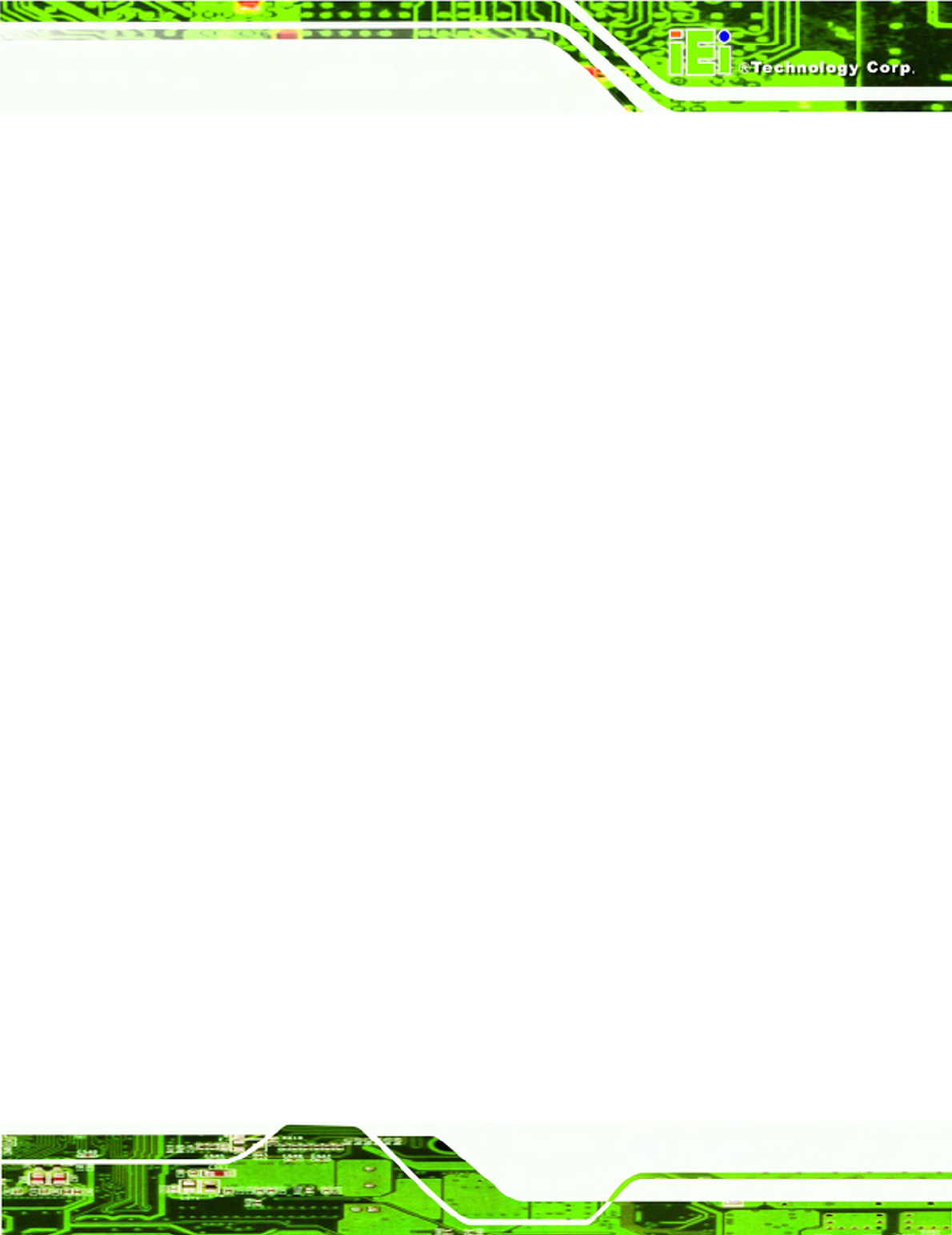
ICEFIRE-T10A Mobile Clinic Assistant
Page 85
7.1 System Maintenance Introduction
If the components of the ICEFIRE-T10A fail they must be replaced, such as the wireless
LAN module or the motherboard. Please contact the system reseller or vendor to
purchase the replacement parts.
7.2 Motherboard Replacement
In the case of motherboard failure, please contact an IEI sales representative, reseller or
system vendor. The motherboard is accessible after opening the rear cover.
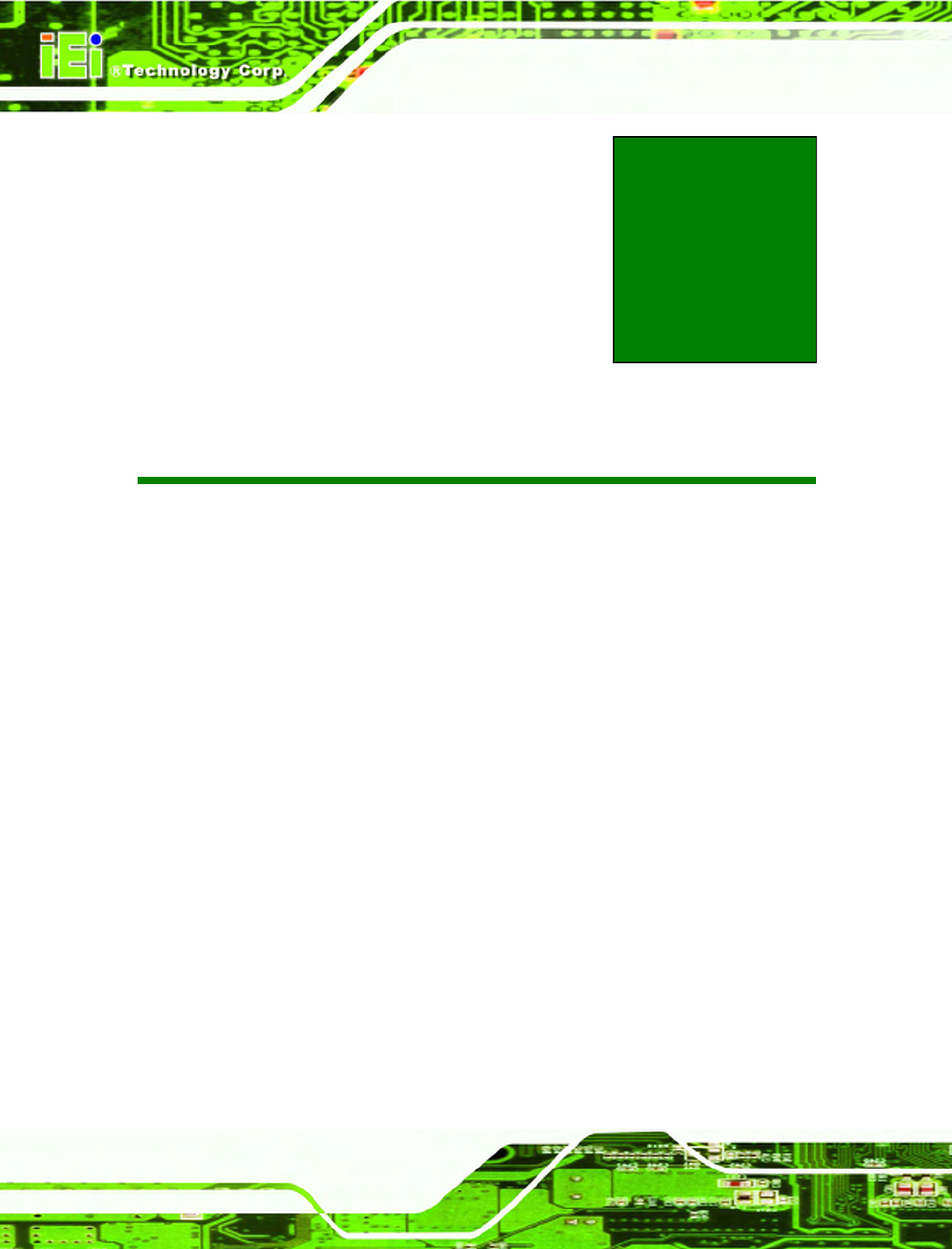
ICEFIRE-T10A Mobile Clinic Assistant
Page 86
Appendix
A
A Safety Precautions
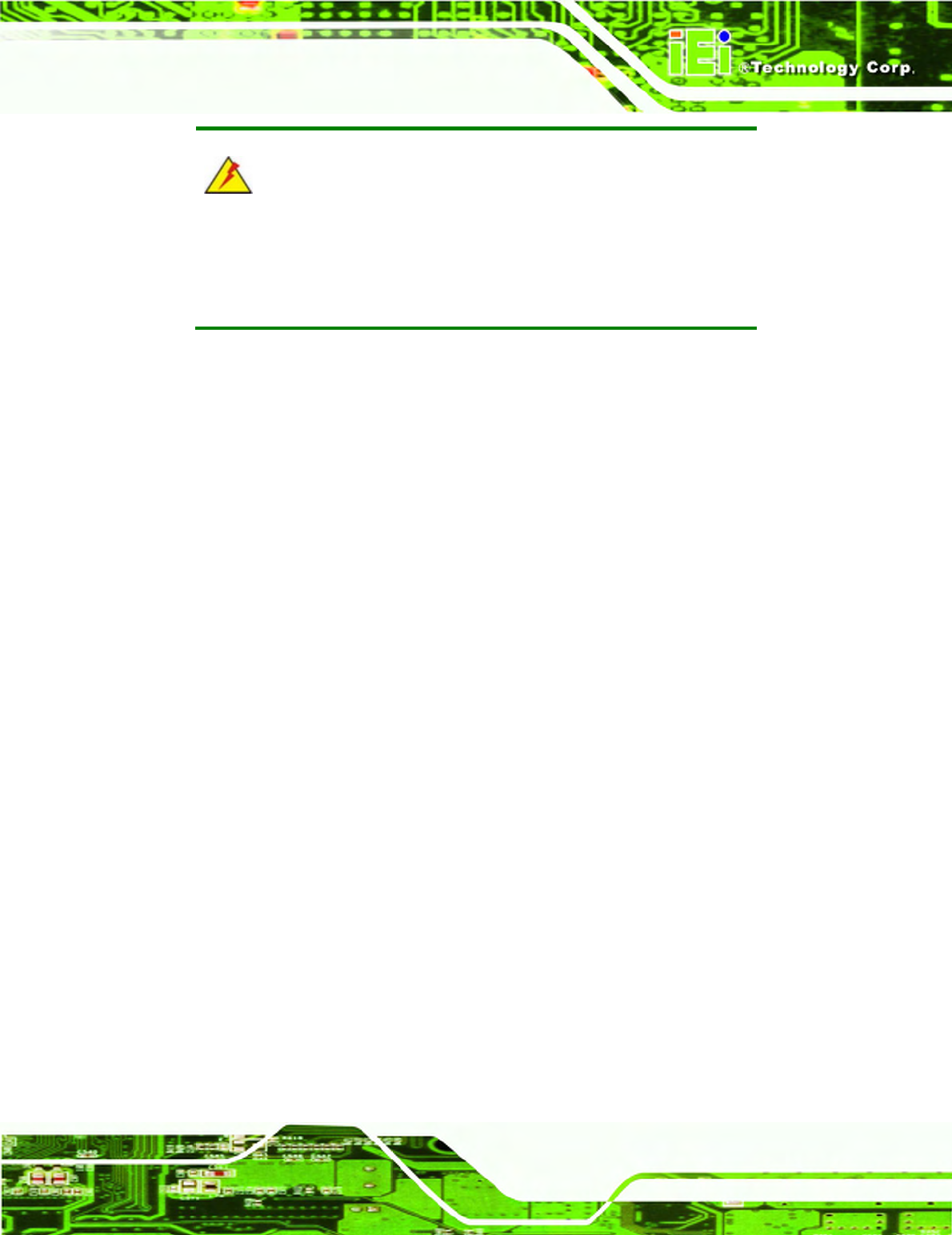
ICEFIRE-T10A Mobile Clinic Assistant
Page 87
WARNING:
The precautions outlined in this chapter should be strictly followed.
Failure to follow these precautions may result in permanent damage to
the ICEFIRE-T10A.
A.1 Safety Precautions
Please follow the safety precautions outlined in the sections that follow:
A.1.1 General Safety Precautions
Please ensure the following safety precautions are adhered to at all times.
Follow the electrostatic precautions outlined below whenever the
ICEFIRE-T10A is opened.
Make sure the power is turned off and the power cord is disconnected
whenever the ICEFIRE-T10A is being installed, moved or modified.
Do not apply voltage levels that exceed the specified voltage range.
Doing so may cause fire and/or an electrical shock.
Electric shocks can occur if the ICEFIRE-T10A chassis is opened when the
ICEFIRE-T10A is running.
Do not drop or insert any objects into the ventilation openings of the
ICEFIRE-T10A.
If considerable amounts of dust, water, or fluids enter the ICEFIRE-T10A,
turn off the power supply immediately, unplug the power cord, and contact the
ICEFIRE-T10A vendor.
DO NOT:
o Drop the ICEFIRE-T10A against a hard surface.
o Strike or exert excessive force onto the LCD panel.
o Touch any of the LCD panels with a sharp object
o In a site where the ambient temperature exceeds the rated temperature
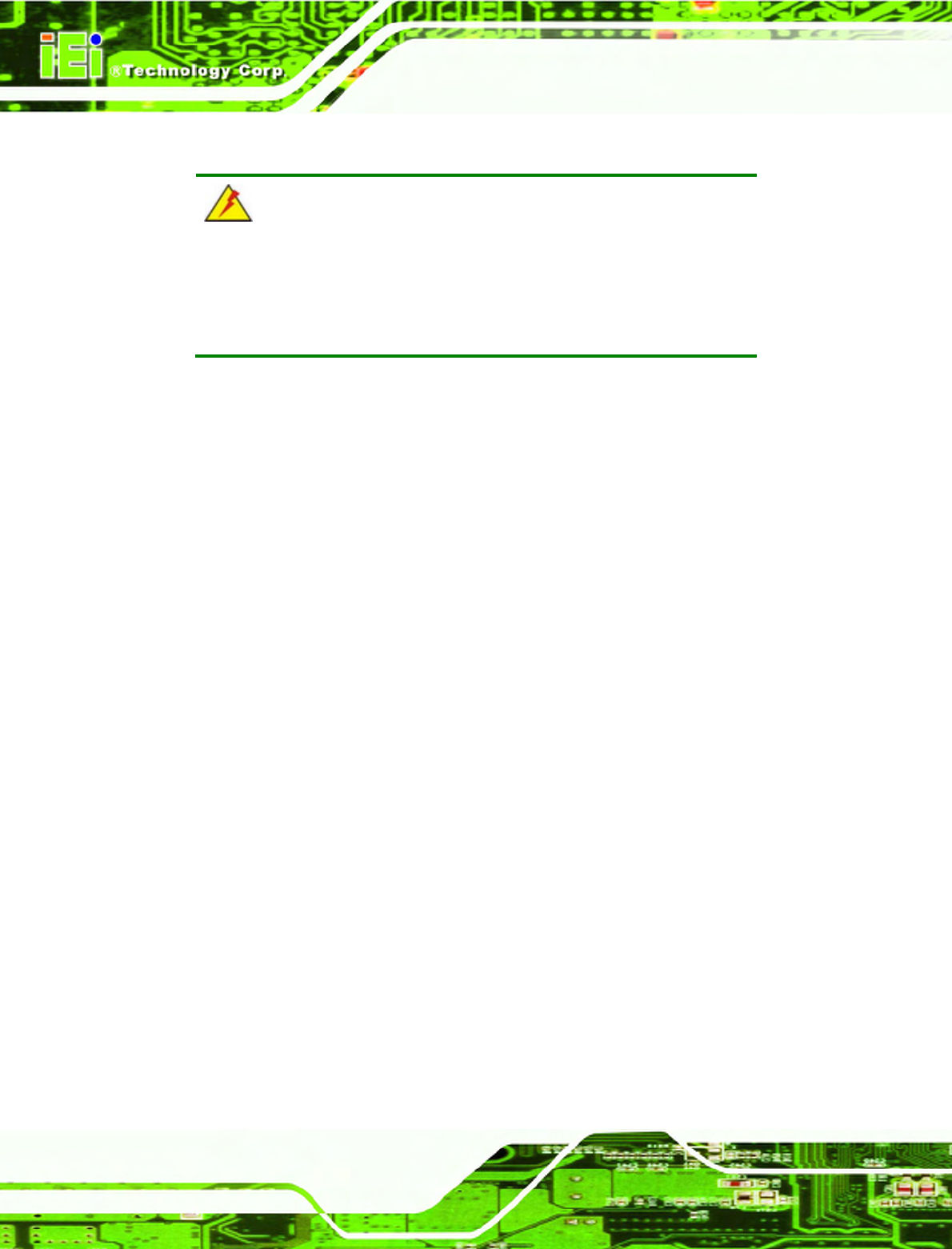
ICEFIRE-T10A Mobile Clinic Assistant
Page 88
A.1.2 Anti-static Precautions
WARNING:
Failure to take ESD precautions during the installation of the
ICEFIRE-T10A may result in permanent damage to the ICEFIRE-T10A
and severe injury to the user.
Electrostatic discharge (ESD) can cause serious damage to electronic components,
including the ICEFIRE-T10A. Dry climates are especially susceptible to ESD. It is
therefore critical that whenever the ICEFIRE-T10A is opened and any of the electrical
components are handled, the following anti-static precautions are strictly adhered to.
Wear an anti-static wristband: Wearing a simple anti-static wristband can
help to prevent ESD from damaging any electrical component.
Self-grounding: Before handling any electrical component, touch any
grounded conducting material. During the time the electrical component is
handled, frequently touch any conducting materials that are connected to the
ground.
Use an anti-static pad: When configuring or working with an electrical
component, place it on an antic-static pad. This reduces the possibility of ESD
damage.
Only handle the edges of the electrical component: When handling the
electrical component, hold the electrical component by its edges.
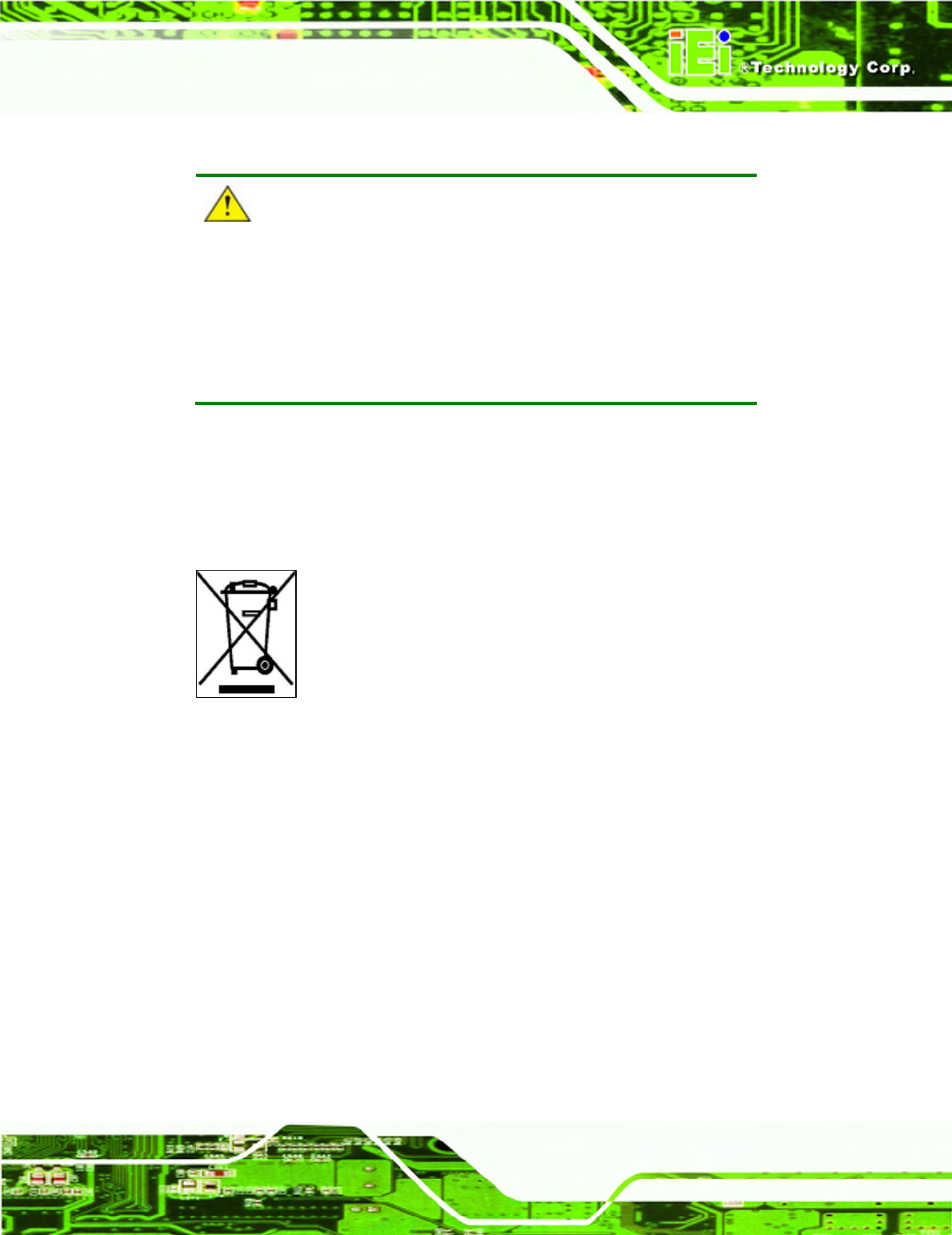
ICEFIRE-T10A Mobile Clinic Assistant
Page 89
A.1.3 Product Disposal
CAUTION:
Risk of explosion if battery is replaced by and incorrect type. Only
certified engineers should replace the on-board battery.
Dispose of used batteries according to instructions and local
regulations.
Outside the European Union - If you wish to dispose of used electrical and
electronic products outside the European Union, please contact your local
authority so as to comply with the correct disposal method.
Within the European Union:
EU-wide legislation, as implemented in each Member State, requires that
waste electrical and electronic products carrying the mark (left) must be
disposed of separately from normal household waste. This includes
monitors and electrical accessories, such as signal cables or power cords.
When you need to dispose of your display products, please follow the
guidance of your local authority, or ask the shop where you purchased the product. The
mark on electrical and electronic products only applies to the current European Union
Member States.
Please follow the national guidelines for electrical and electronic product disposal.
A.2 Maintenance and Cleaning Precautions
When maintaining or cleaning the ICEFIRE-T10A, please follow the guidelines below.
A.2.1 Maintenance and Cleaning
Prior to cleaning any part or component of the ICEFIRE-T10A, please read the details
below.
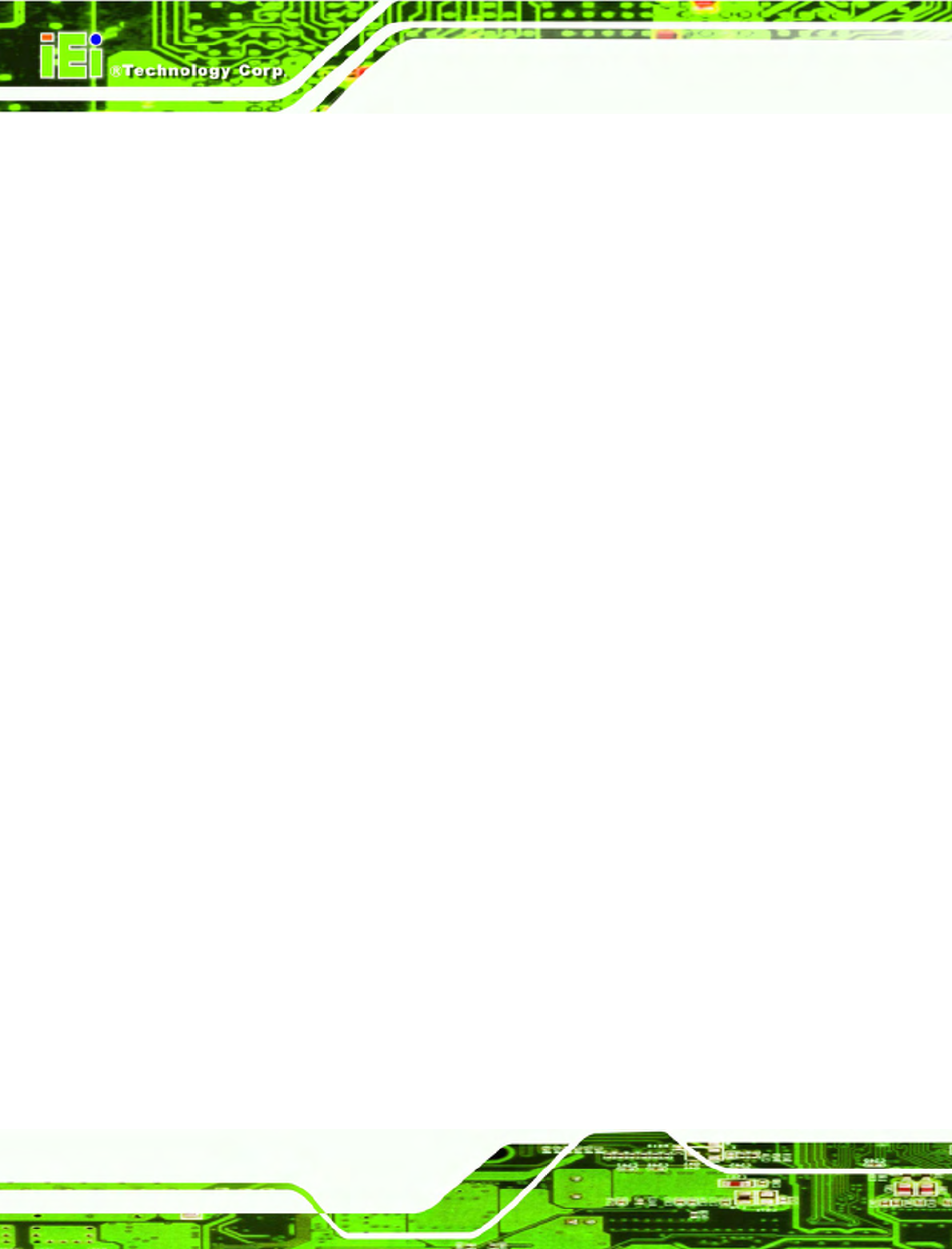
ICEFIRE-T10A Mobile Clinic Assistant
Page 90
Except for the LCD panel, never spray or squirt liquids directly onto any other
components. To clean the LCD panel, gently wipe it with a piece of soft dry
cloth or a slightly moistened cloth.
The interior of the ICEFIRE-T10A does not require cleaning. Keep fluids away
from the ICEFIRE-T10A interior.
Be cautious of all small removable components when vacuuming the
ICEFIRE-T10A.
Turn the ICEFIRE-T10A off before cleaning the ICEFIRE-T10A.
Never drop any objects or liquids through the openings of the ICEFIRE-T10A.
Be cautious of any possible allergic reactions to solvents or chemicals used
when cleaning the ICEFIRE-T10A.
Avoid eating, drinking and smoking within vicinity of the ICEFIRE-T10A.
A.2.2 Cleaning Tools
Some components in the ICEFIRE-T10A may only be cleaned using a product specifically
designed for the purpose. In such case, the product will be explicitly mentioned in the
cleaning tips. Below is a list of items to use when cleaning the ICEFIRE-T10A.
Cloth – Although paper towels or tissues can be used, a soft, clean piece of
cloth is recommended when cleaning the ICEFIRE-T10A.
Water or rubbing alcohol – A cloth moistened with water or rubbing alcohol
can be used to clean the ICEFIRE-T10A.
Using solvents – The use of solvents is not recommended when cleaning the
ICEFIRE-T10A as they may damage the plastic parts.
Vacuum cleaner – Using a vacuum specifically designed for computers is
one of the best methods of cleaning the ICEFIRE-T10A. Dust and dirt can
restrict the airflow in the ICEFIRE-T10A and cause its circuitry to corrode.
Cotton swabs - Cotton swaps moistened with rubbing alcohol or water are
excellent tools for wiping hard to reach areas.
Foam swabs - Whenever possible, it is best to use lint free swabs such as
foam swabs for cleaning.
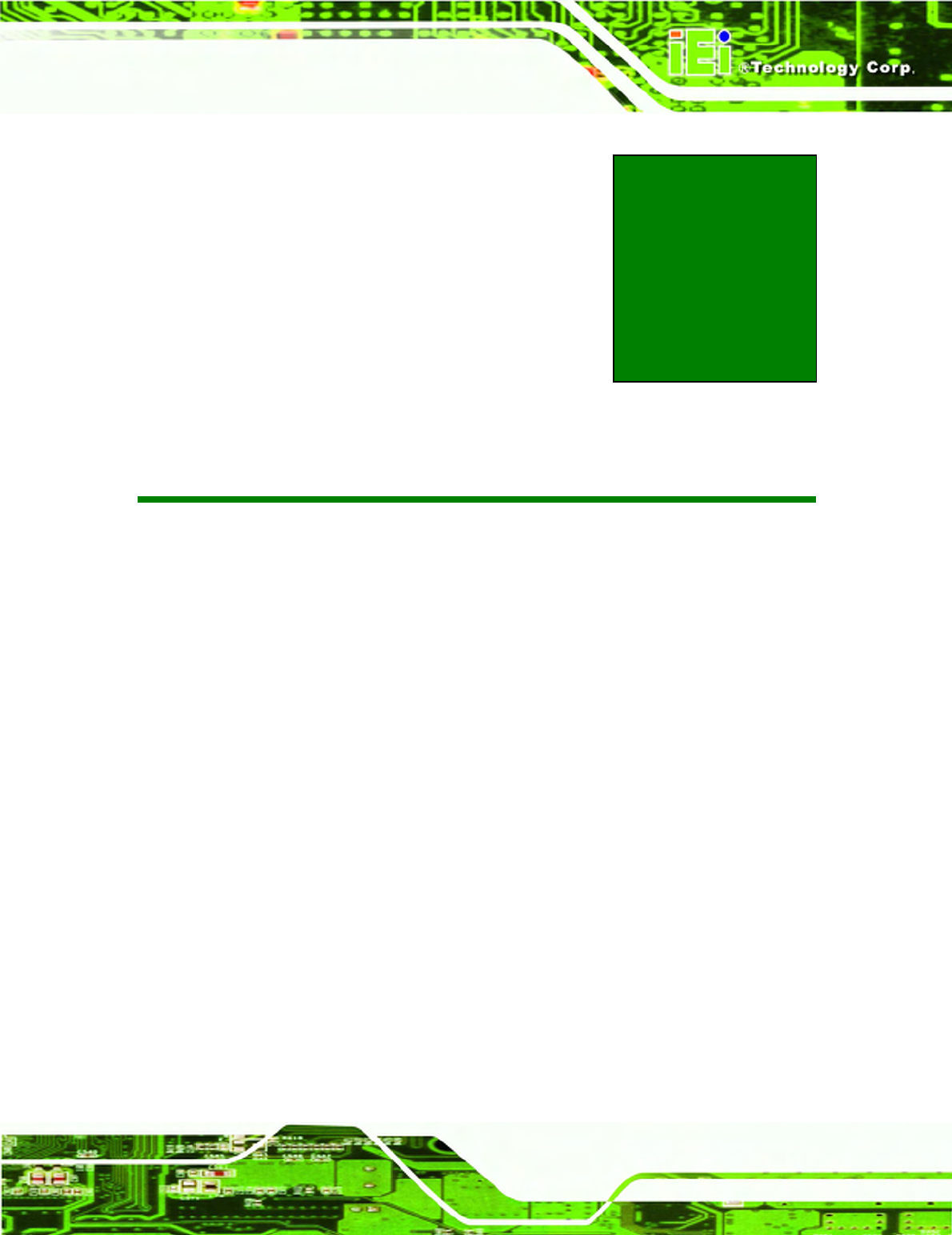
ICEFIRE-T10A Mobile Clinic Assistant
Page 91
Appendix
B
B One Key Recovery
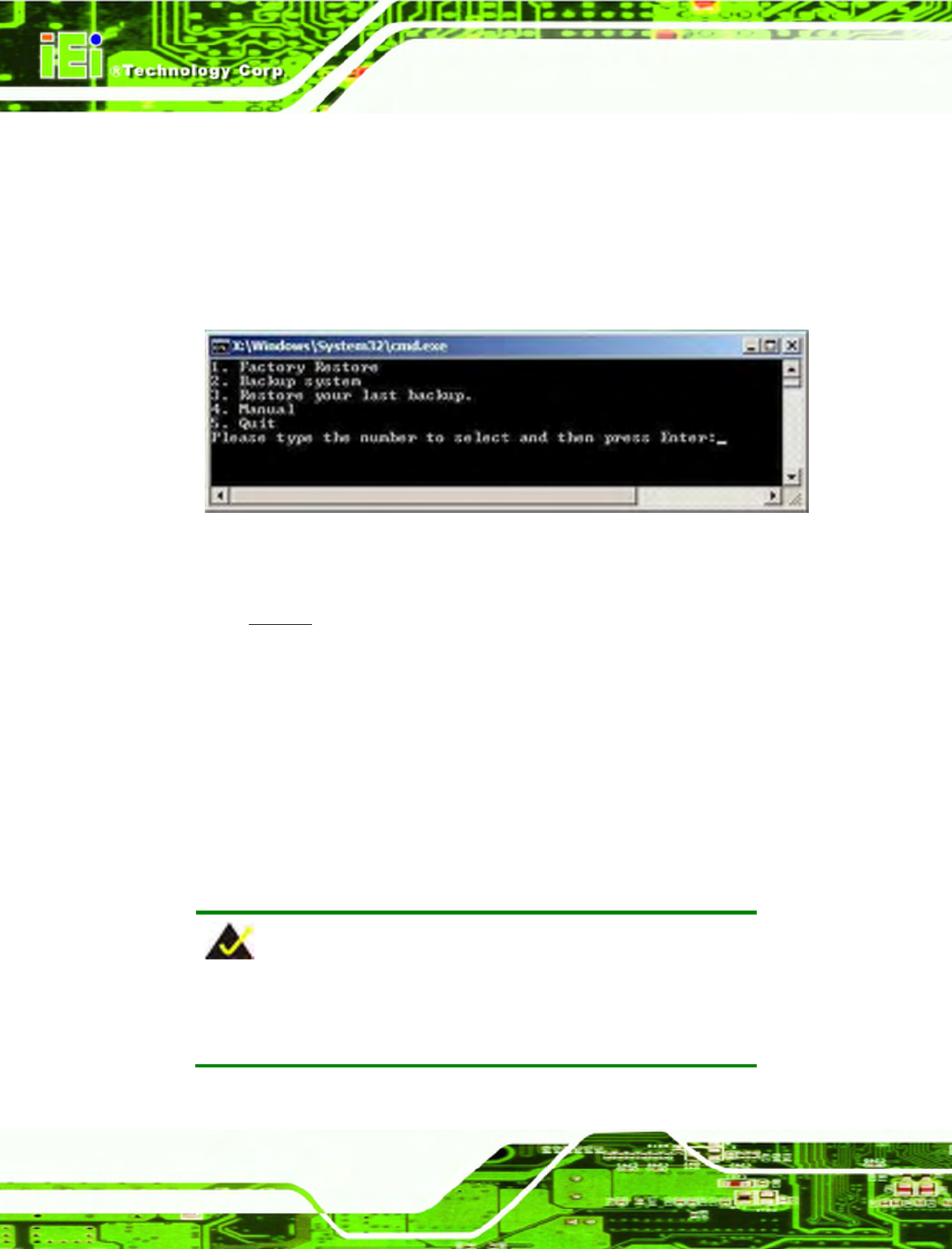
ICEFIRE-T10A Mobile Clinic Assistant
Page 92
B.1 One Key Recovery Introduction
The IEI one key recovery is an easy-to-use front end for the Norton Ghost system backup
and recovery tool. The one key recovery provides quick and easy shortcuts for creating a
backup and reverting to that backup or for reverting to the factory default settings.
The IEI One Key Recovery tool menu is shown below.
Figure B-1: IEI One Key Recovery Tool Menu
Prior to using the IEI One Key Recovery tool (as shown in
761H761H442H525H
Figure B-1) to backup or
restore Windows system, five setup procedures are required.
1. Hardware and BIOS setup (see Section
762H762H443H526H
B.2.1)
2. Create partitions (see Section
763H763H444H527H
B.2.2)
3. Install operating system, drivers and system applications (see Section
764H764H445H528H
B.2.3)
4. Build-up recovery partition (see Section
765H765H446H529H
B.2.4)
5. Create factory default image (see Section
766H766H447H530H
B.2.5)
After completing the five initial setup procedures as described above, users can access
the recovery tool by pressing <F3> while booting up the system. The detailed information
of each function is described in Section
767H767H448H531H
B.4.
NOTE:
The initial setup procedures for Linux system are described in
Section
768H768H449H532H
B.3.
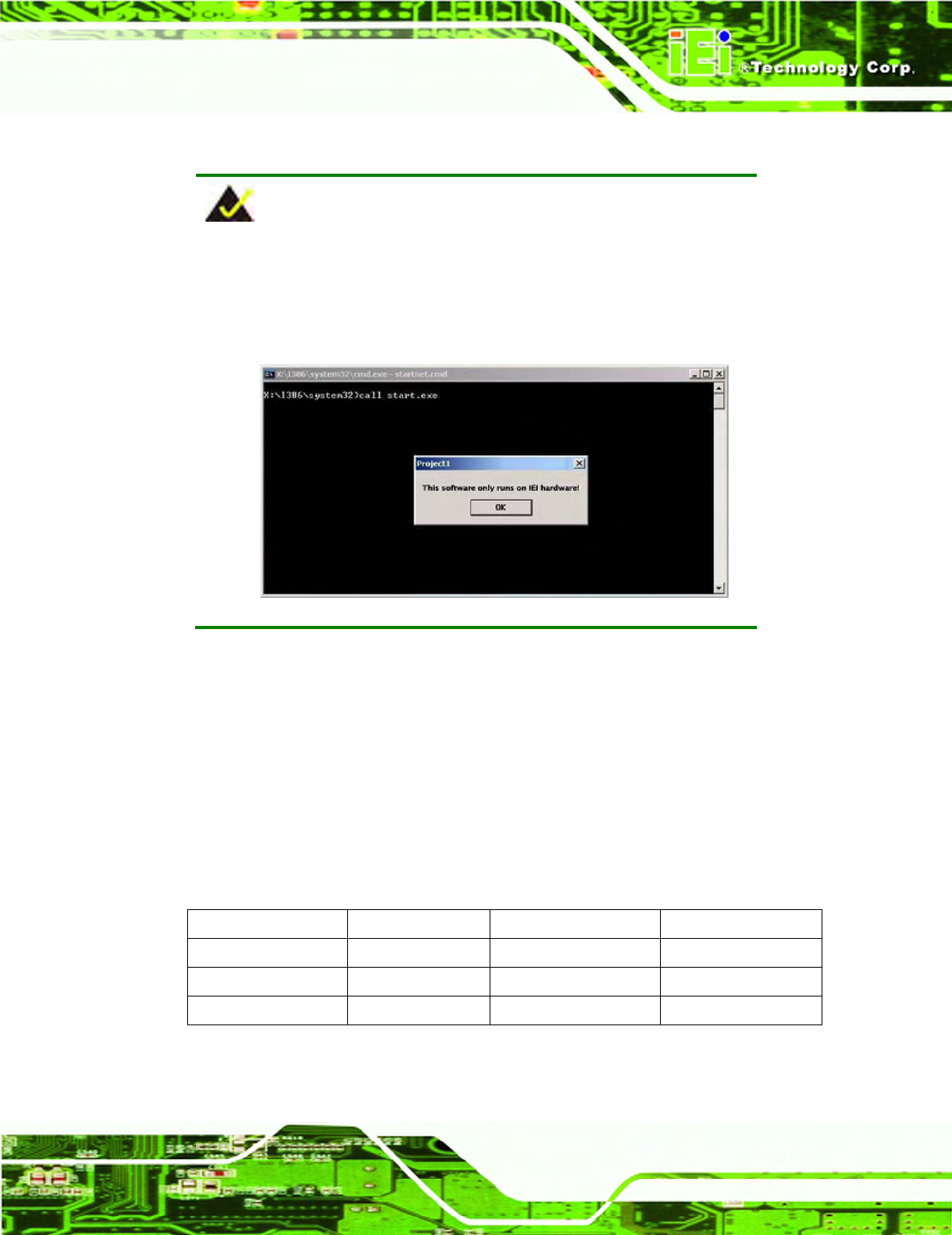
ICEFIRE-T10A Mobile Clinic Assistant
Page 93
B.1.1 System Requirement
NOTE:
The recovery CD can only be used with IEI products. The software will
fail to run and a warning message will appear when used on non-IEI
hardware.
To create the system backup, the main storage device must be split into two partitions
(three partitions for Linux). The first partition will be for the operating system, while the
second partition will be invisible to the operating system and contain the backup made by
the one key recovery software.
The partition created for recovery images must be big enough to contain both the factory
default image and the user backup image. The size must be calculated before creating the
partitions. Please take the following table as a reference when calculating the size of the
partition.
OS OS Image after Ghost
Compression Ratio
Windows® 7 7 GB 5 GB 70%
Windows® XPE 776 MB 560 MB 70%
Windows® CE 6.0 36 MB 28 MB 77%
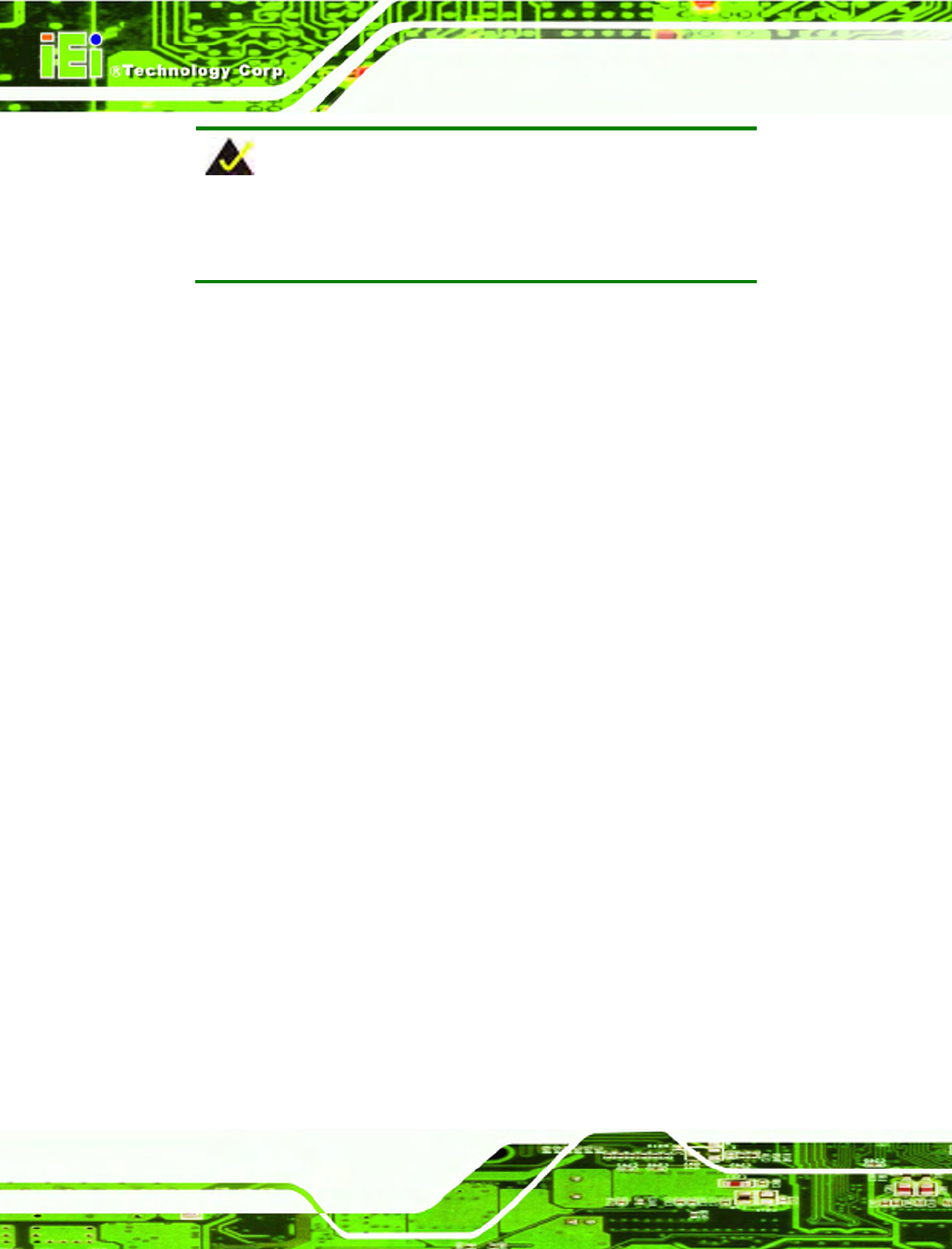
ICEFIRE-T10A Mobile Clinic Assistant
Page 94
NOTE:
Specialized tools are required to change the partition size if the
operating system is already installed.
B.1.2 Supported Operating System
The recovery CD is compatible with both Microsoft Windows and Linux operating system
(OS). The supported OS versions are listed below.
Microsoft Windows
o Windows XP (Service Pack 2 or 3 required)
o Windows Vista
o Windows 7
o Windows CE 5.0
o Windows CE 6.0
o Windows XP Embedded
Linux
o Fedora Core 12 (Constantine)
o Fedora Core 11 (Leonidas)
o Fedora Core 10 (Cambridge)
o Fedora Core 8 (Werewolf)
o Fedora Core 7 (Moonshine)
o RedHat RHEL-5.4
o RedHat 9 (Ghirke)
o Ubuntu 8.10 (Intrepid)
o Ubuntu 7.10 (Gutsy)
o Ubuntu 6.10 (Edgy)
o Debian 5.0 (Lenny)
o Debian 4.0 (Etch)
o SuSe 11.2
o SuSe 10.3
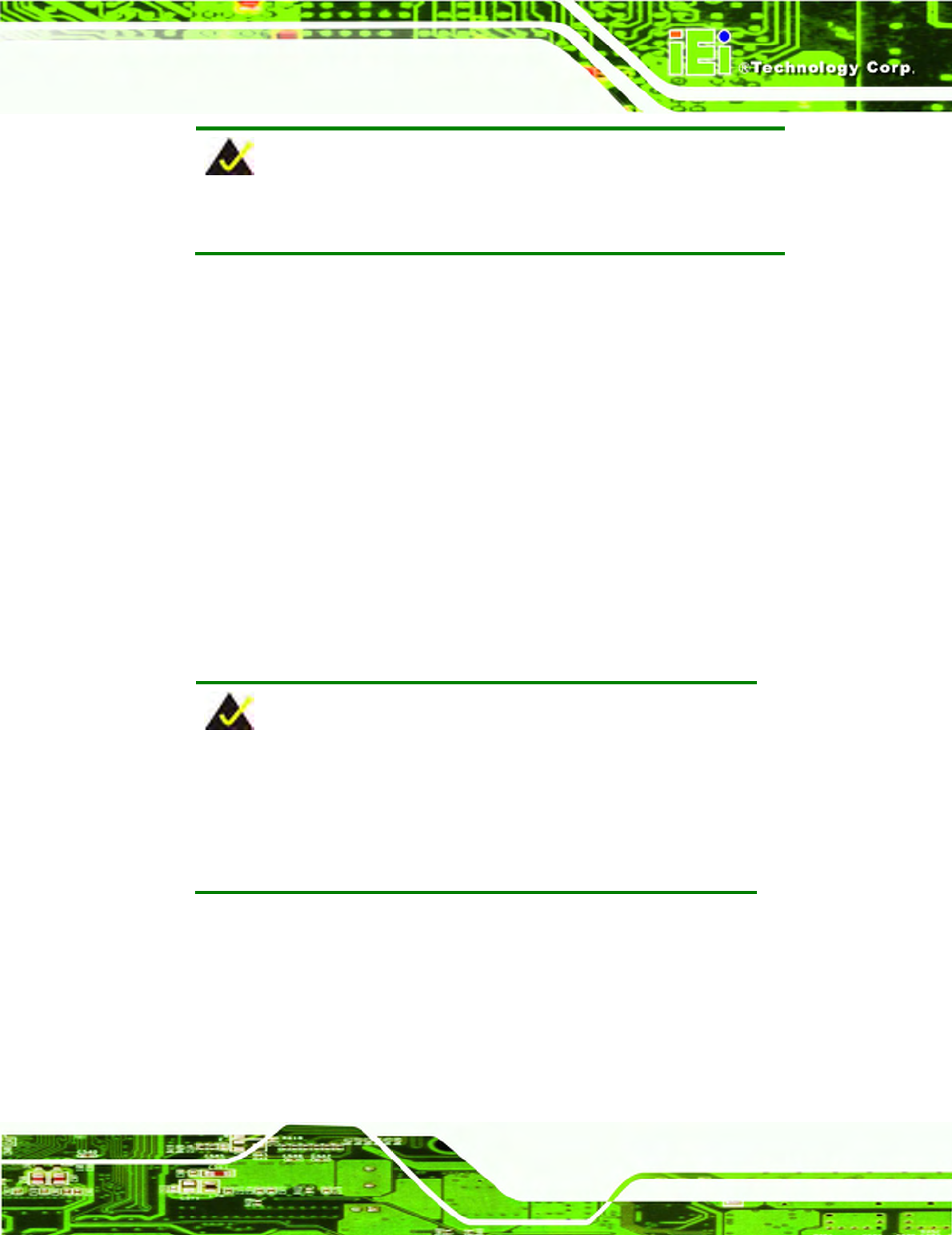
ICEFIRE-T10A Mobile Clinic Assistant
Page 95
NOTE:
Installing unsupported OS versions may cause the recovery tool to fail.
B.2 Setup Procedure for Windows
Prior to using the recovery tool to backup or restore Windows system, a few setup
procedures are required.
Step 1: Hardware and BIOS setup (see Section
769H769H450H533H
B.2.1)
Step 2: Create partitions (see Section
770H770H451H534H
B.2.2)
Step 3: Install operating system, drivers and system applications (see Section
771H771H452H535H
B.2.3)
Step 4: Build-up recovery partition (see Section
772H772H453H536H
B.2.4)
Step 5: Create factory default image (see Section
773H773H454H537H
B.2.5) Step 0:
The detailed descriptions are described in the following sections.
NOTE:
The setup procedures described below are for Microsoft Windows
operating system users. For Linux system, most setup procedures are
the same with Microsoft Windows except for several steps which is
described in Section
774H774H455H538H
B.3.
B.2.1 Hardware and BIOS Setup
Step 1: Make sure the system is powered off and unplugged.
Step 2: Install a hard drive or SSD in the system. An unformatted and unpartitioned disk
is recommended.
Step 3: Connect an optical disk drive to the system and insert the recovery CD.
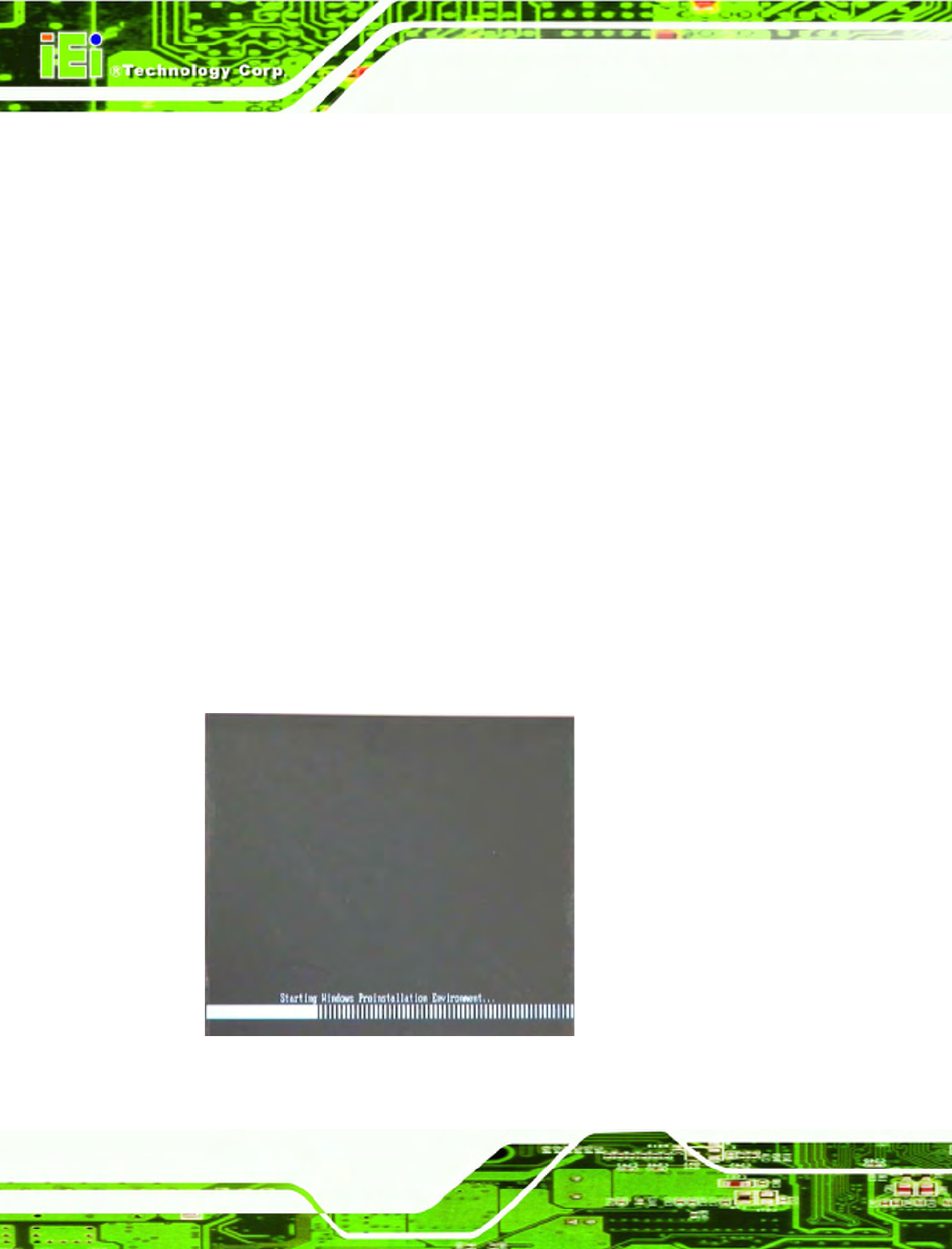
ICEFIRE-T10A Mobile Clinic Assistant
Page 96
Step 4: Turn on the system.
Step 5: Press the <DELETE> key as soon as the system is turned on to enter the BIOS.
Step 6: Select the connected optical disk drive as the 1
st
boot device. (Boot Boot
Device Priority 1
st
Boot Device).
Step 7: Save changes and restart the computer. Continue to the next section for
instructions on partitioning the internal storage. Step 0:
B.2.2 Create Partitions
To create the system backup, the main storage device must be split into two partitions
(three partitions for Linux). The first partition will be for the operating system, while the
second partition will be invisible to the operating system and contain the backup made by
the one key recovery software.
Step 1: Put the recovery CD in the optical drive of the system.
Step 2: Boot the system from recovery CD. When prompted, press any key to boot
from the recovery CD. It will take a while to launch the recovery tool. Please be
patient!
Figure B-2: Launching the Recovery Tool
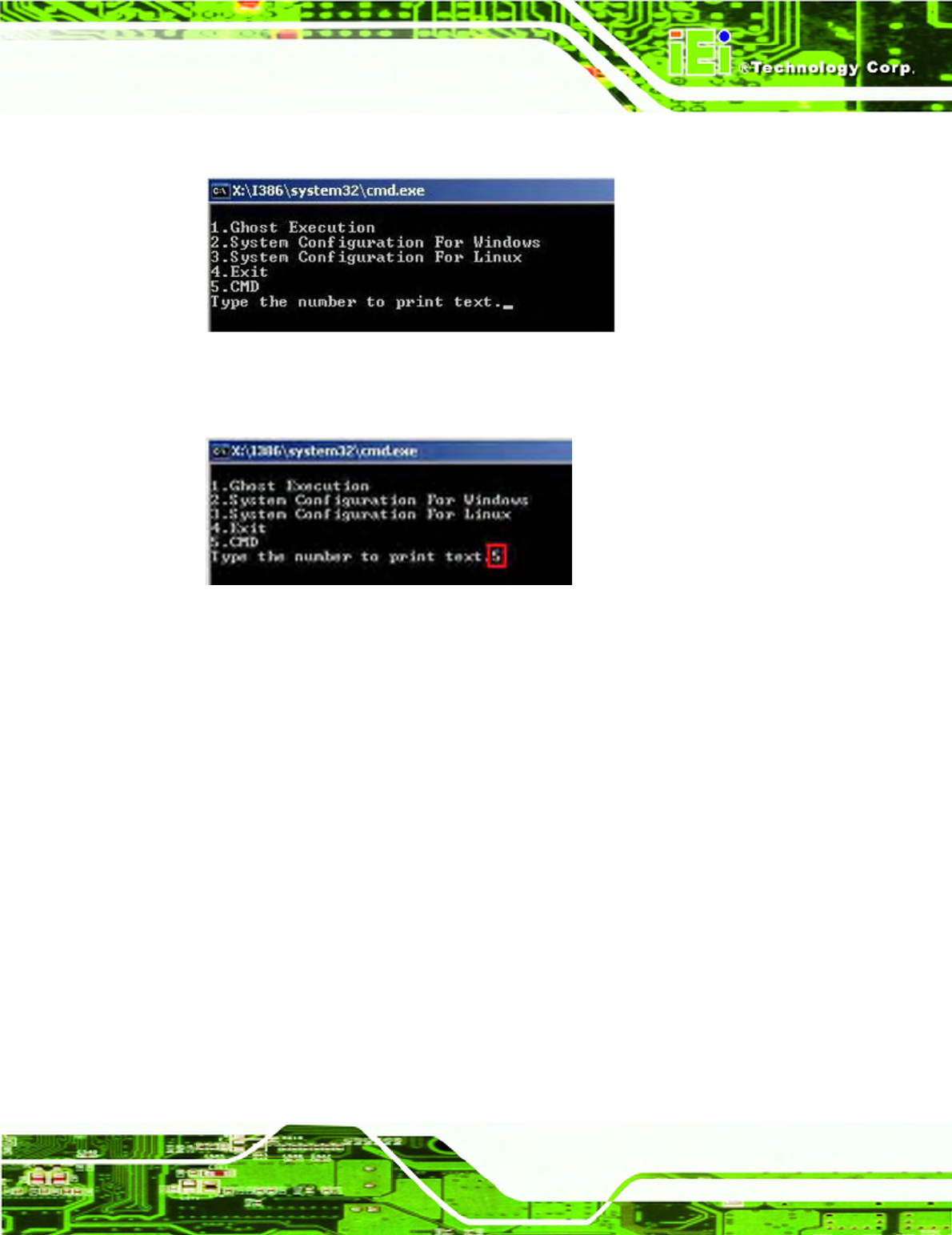
ICEFIRE-T10A Mobile Clinic Assistant
Page 97
Step 3: The recovery tool setup menu is shown as below.
Figure B-3: Recovery Tool Setup Menu
Step 4: Press <5> then <Enter>.
Figure B-4: Command Mode
Step 5: The command prompt window appears. Type the following commands (marked
in red) to create two partitions. One is for the OS installation; the other is for
saving recovery files and images which will be an invisible partition.
(Press <Enter> after entering each line below)
system32>diskpart
DISKPART>list vol
DISKPART>sel disk 0
DISKPART>create part pri size= ___
DISKPART>assign letter=N
DISKPART>create part pri size= ___
DISKPART>assign letter=F
DISKPART>exit
system32>format N: /fs:ntfs /q /y
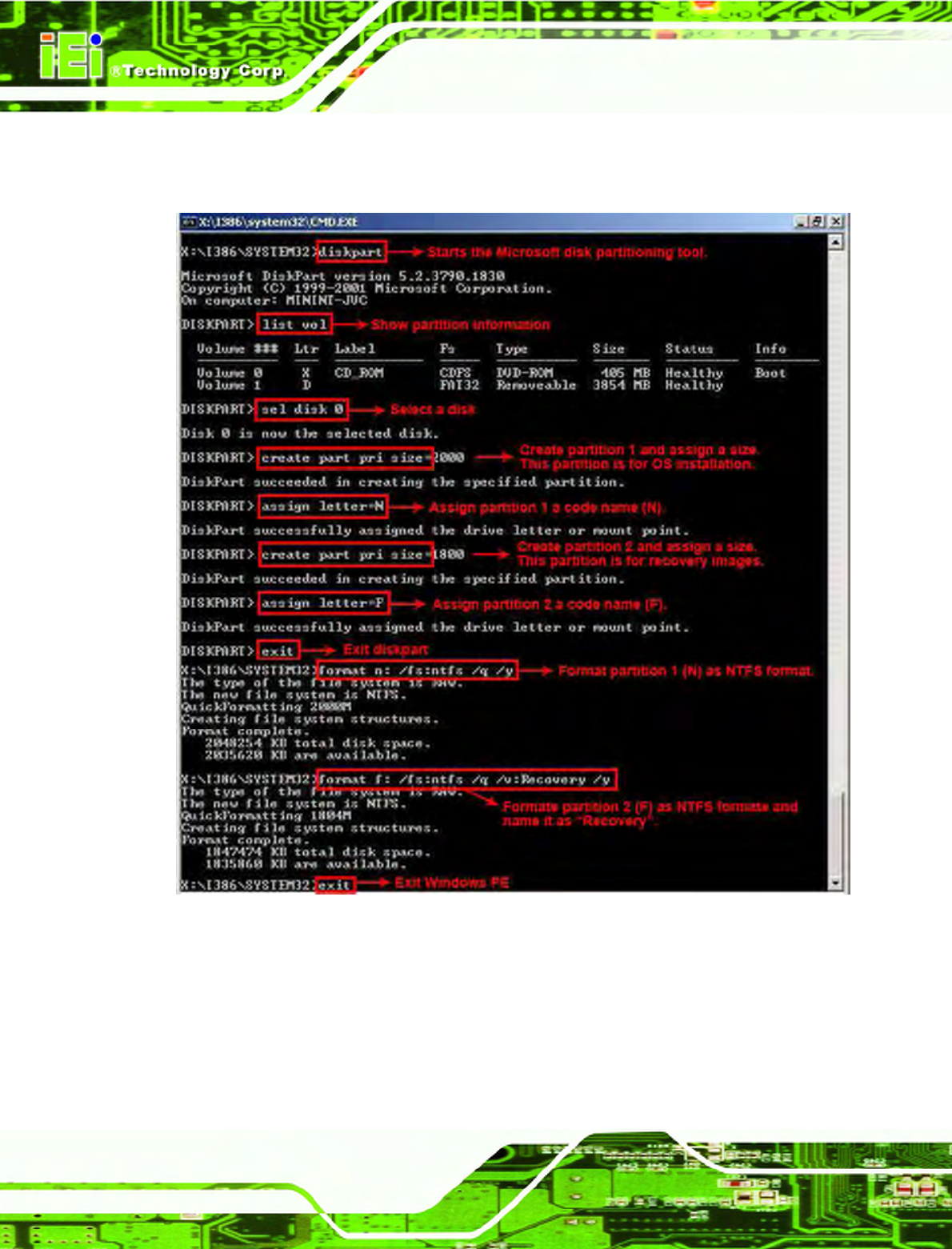
ICEFIRE-T10A Mobile Clinic Assistant
Page 98
system32>format F: /fs:ntfs /q /v:Recovery /y
system32>exit
Figure B-5: Partition Creation Commands
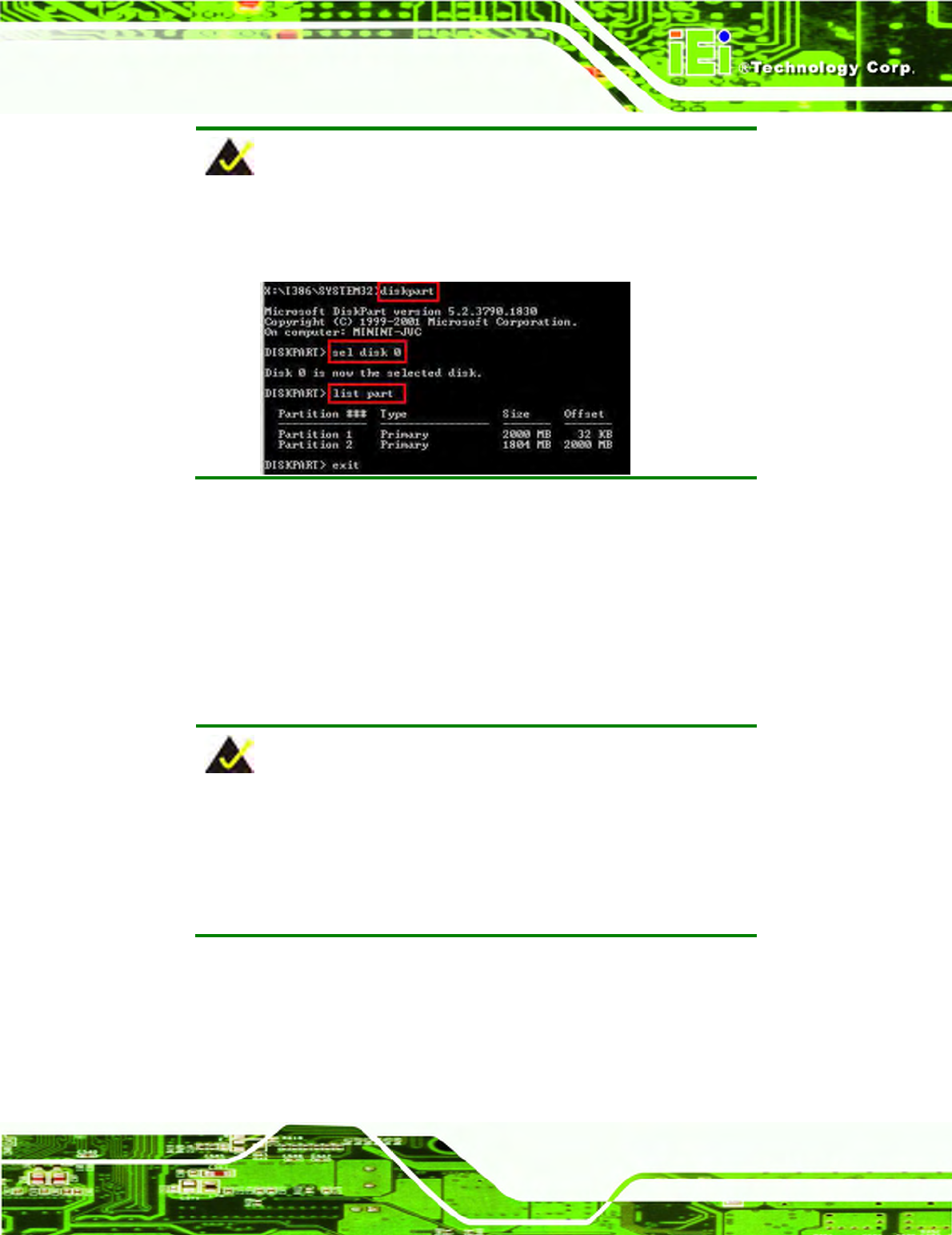
ICEFIRE-T10A Mobile Clinic Assistant
Page 99
NOTE:
Use the following commands to check if the partitions were created
successfully.
Step 6: Press any key to exit the recovery tool and automatically reboot the system.
Please continue to the following procedure: Build-up Recovery Partition.Step 0:
B.2.3 Install Operating System, Drivers and Applications
Install the operating system onto the unlabelled partition. The partition labeled as
"Recovery" is for use by the system recovery tool and should not be used for installing the
operating system or any applications.
NOTE:
The operating system installation program may offer to reformat the
chosen partition. DO NOT format the partition again. The partition has
already been formatted and is ready for installing the new operating
system.
To install the operating system, insert the operating system installation CD into the optical
drive. Restart the computer and follow the installation instructions.
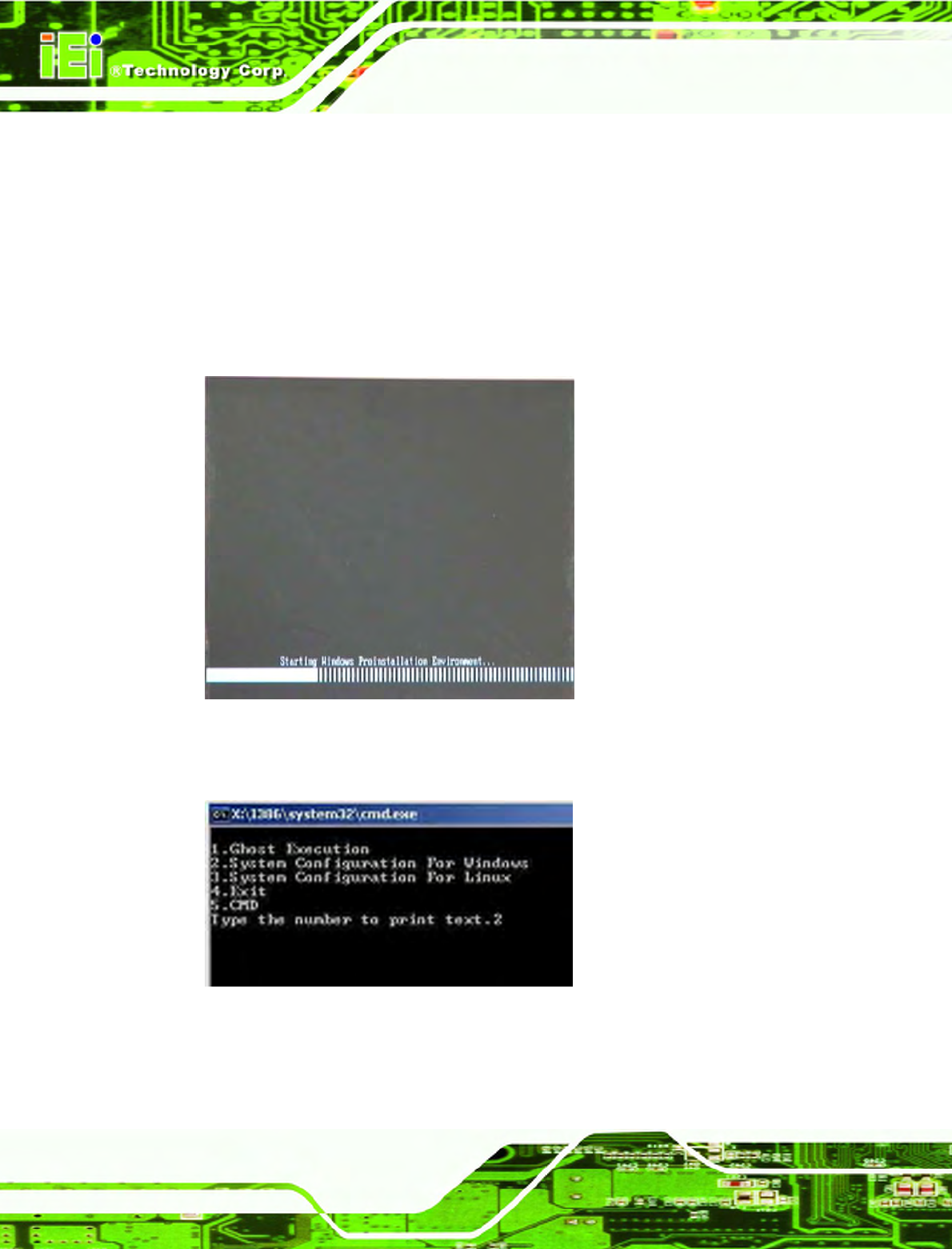
ICEFIRE-T10A Mobile Clinic Assistant
Page 100
B.2.4 Build-up Recovery Partition
Step 1: Put the recover CD in the optical drive.
Step 2: Start the system.
Step 3: Boot the system from recovery CD. When prompted, press any key to boot
from the recovery CD. It will take a while to launch the recovery tool. Please be
patient!
Figure B-6: Launching the Recovery Tool
Step 4: When the recovery tool setup menu appears, press <2> then <Enter>.
Figure B-7: System Configuration for Windows
Step 5: The Symantec Ghost window appears and starts configuring the system to
build-up a recovery partition. In this process, the partition which is created for
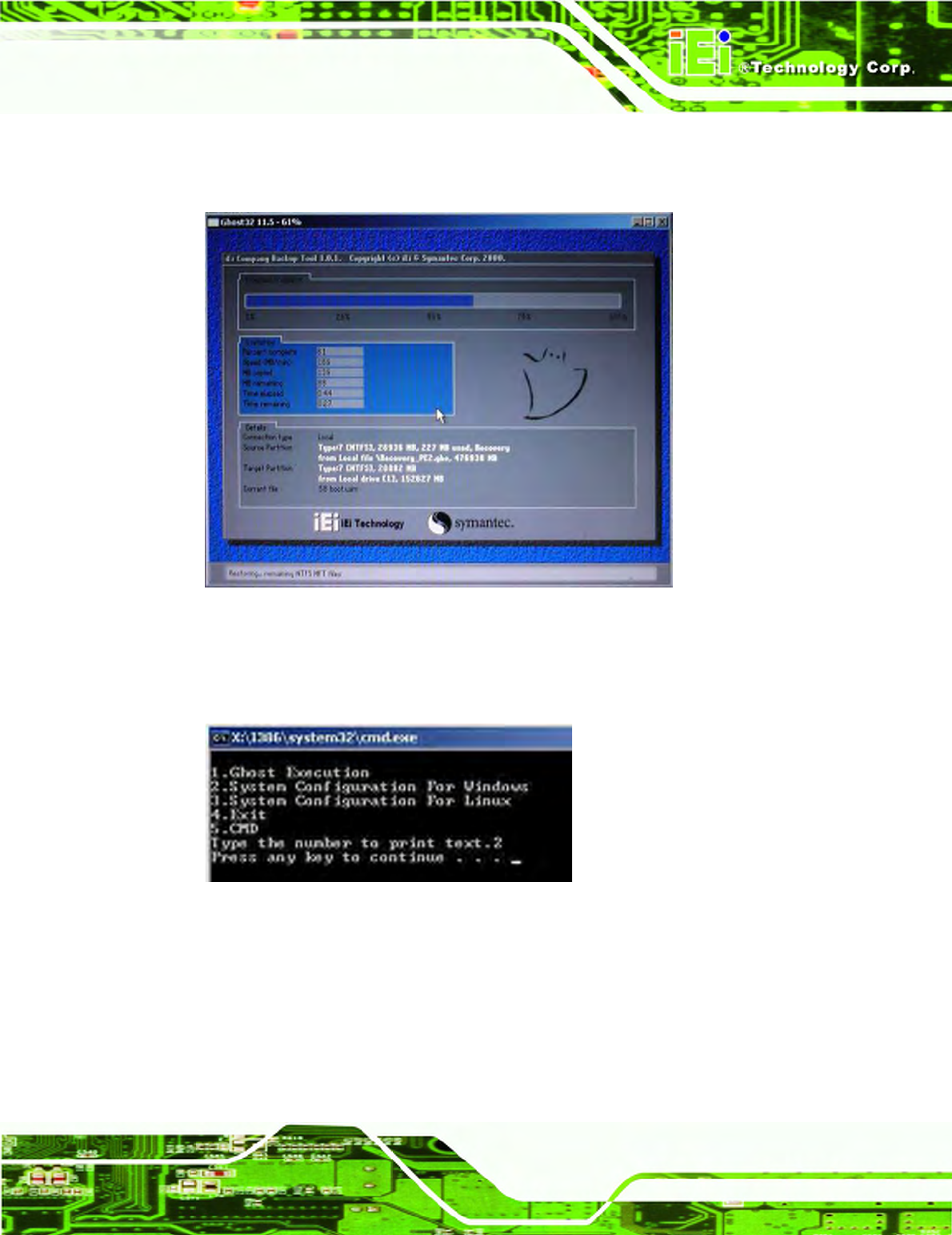
ICEFIRE-T10A Mobile Clinic Assistant
Page 101
recovery files in Section
775H775H456H539H
B.2.2 is hidden and the recovery tool is saved in this
partition.
Figure B-8: Build-up Recovery Partition
Step 6: After completing the system configuration, press any key in the following window
to reboot the system.
Figure B-9: Press any key to continue
Step 7: Eject the recovery CD. Step 0:
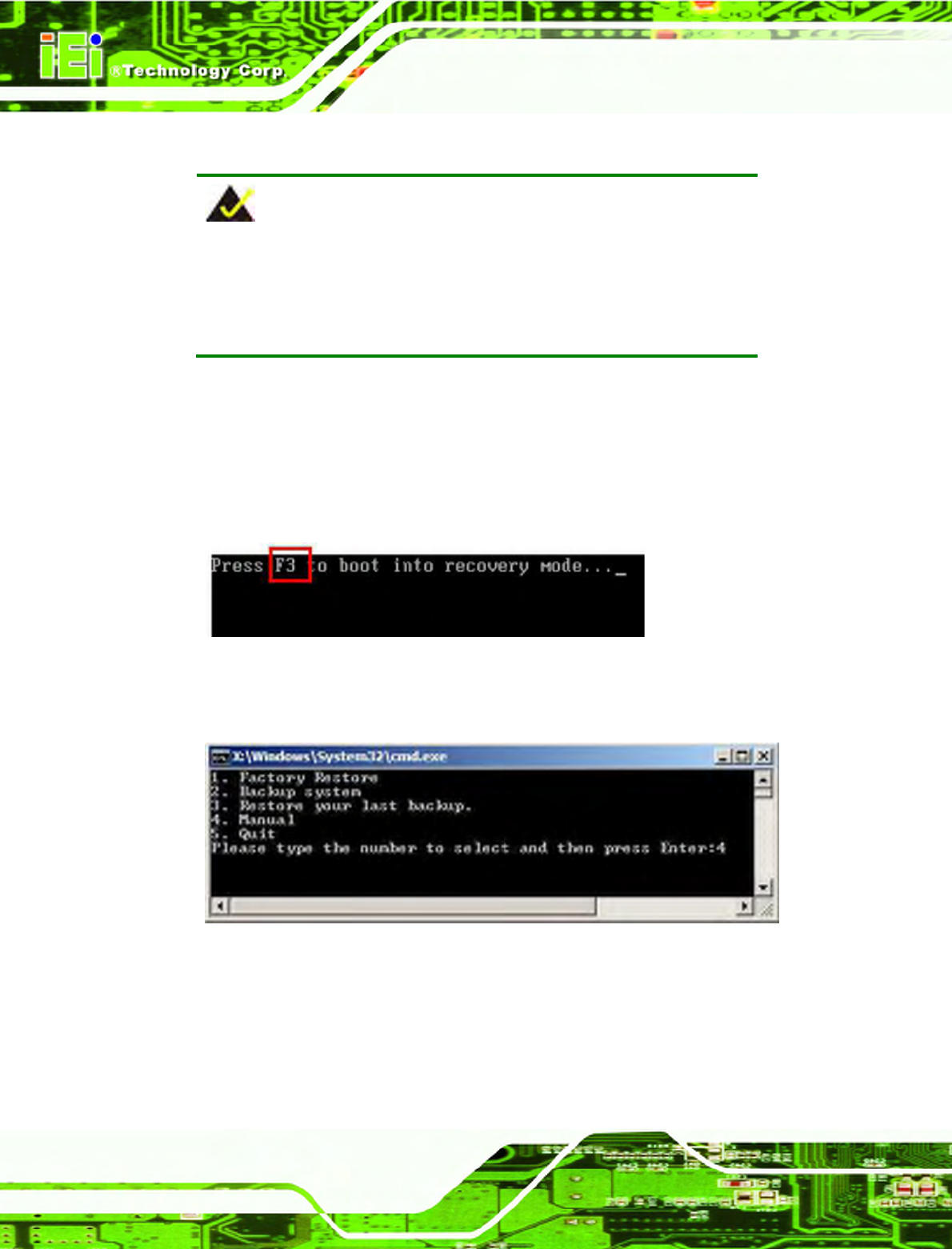
ICEFIRE-T10A Mobile Clinic Assistant
Page 102
B.2.5 Create Factory Default Image
NOTE:
Before creating the factory default image, please configure the system
to a factory default environment, including driver and application
installations.
To create a factory default image, please follow the steps below.
Step 1: Turn on the system. When the following screen displays (
776H776H457H540H
Figure B-10), press
the <F3> key to access the recovery tool. The message will display for 10
seconds, please press F3 before the system boots into the operating system.
Figure B-10: Press F3 to Boot into Recovery Mode
Step 2: The recovery tool menu appears. Type <4> and press <Enter>. (
777H777H458H541H
Figure B-11)
Figure B-11: Recovery Tool Menu
Step 3: The About Symantec Ghost window appears. Click OK button to continue.
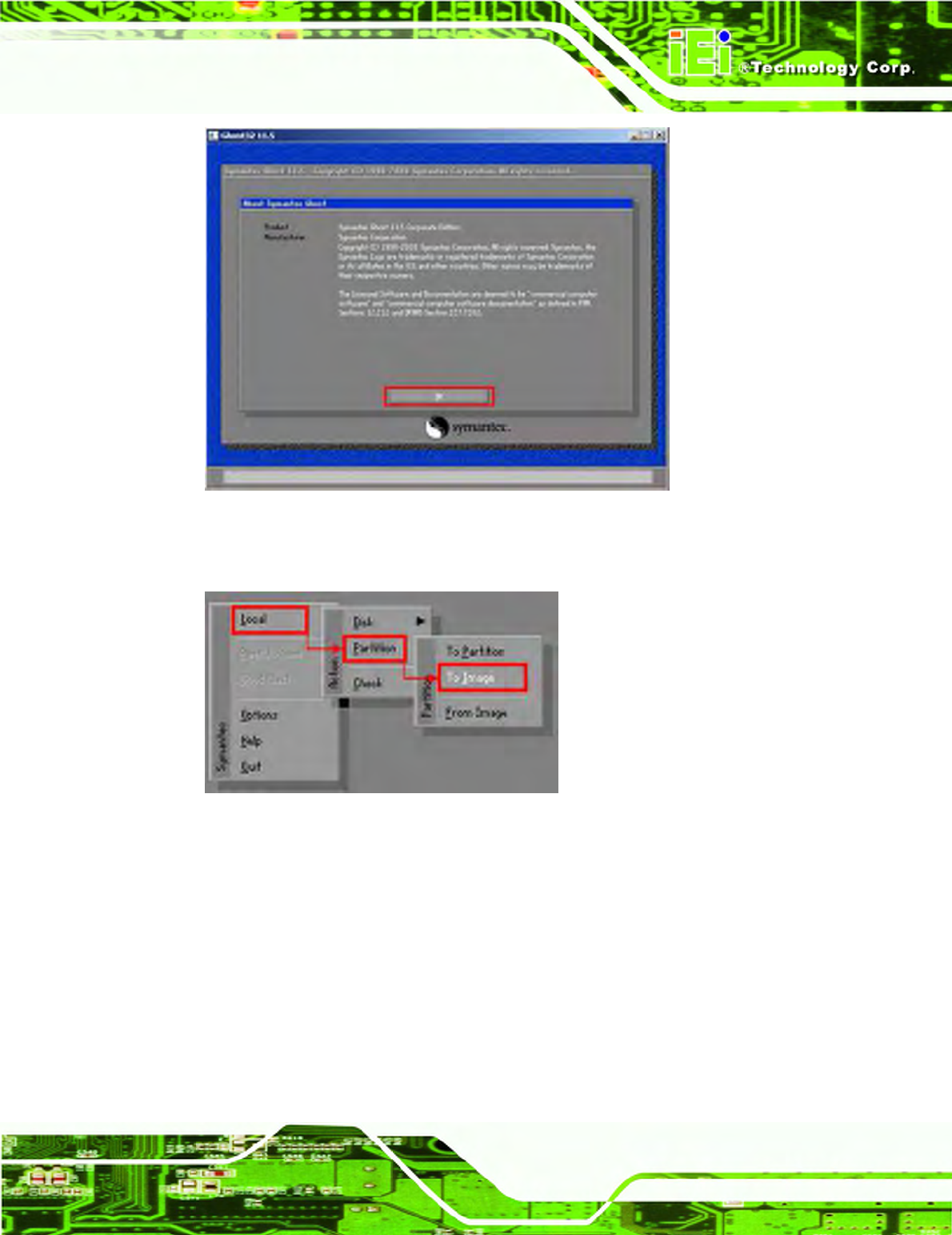
ICEFIRE-T10A Mobile Clinic Assistant
Page 103
Figure B-12: About Symantec Ghost Window
Step 4: Use mouse to navigate to the option shown below (
778H778H459H542H
Figure B-13).
Figure B-13: Symantec Ghost Path
Step 5: Select the local source drive (Drive 1) as shown in
779H779H460H543H
Figure B-14. Then click OK.
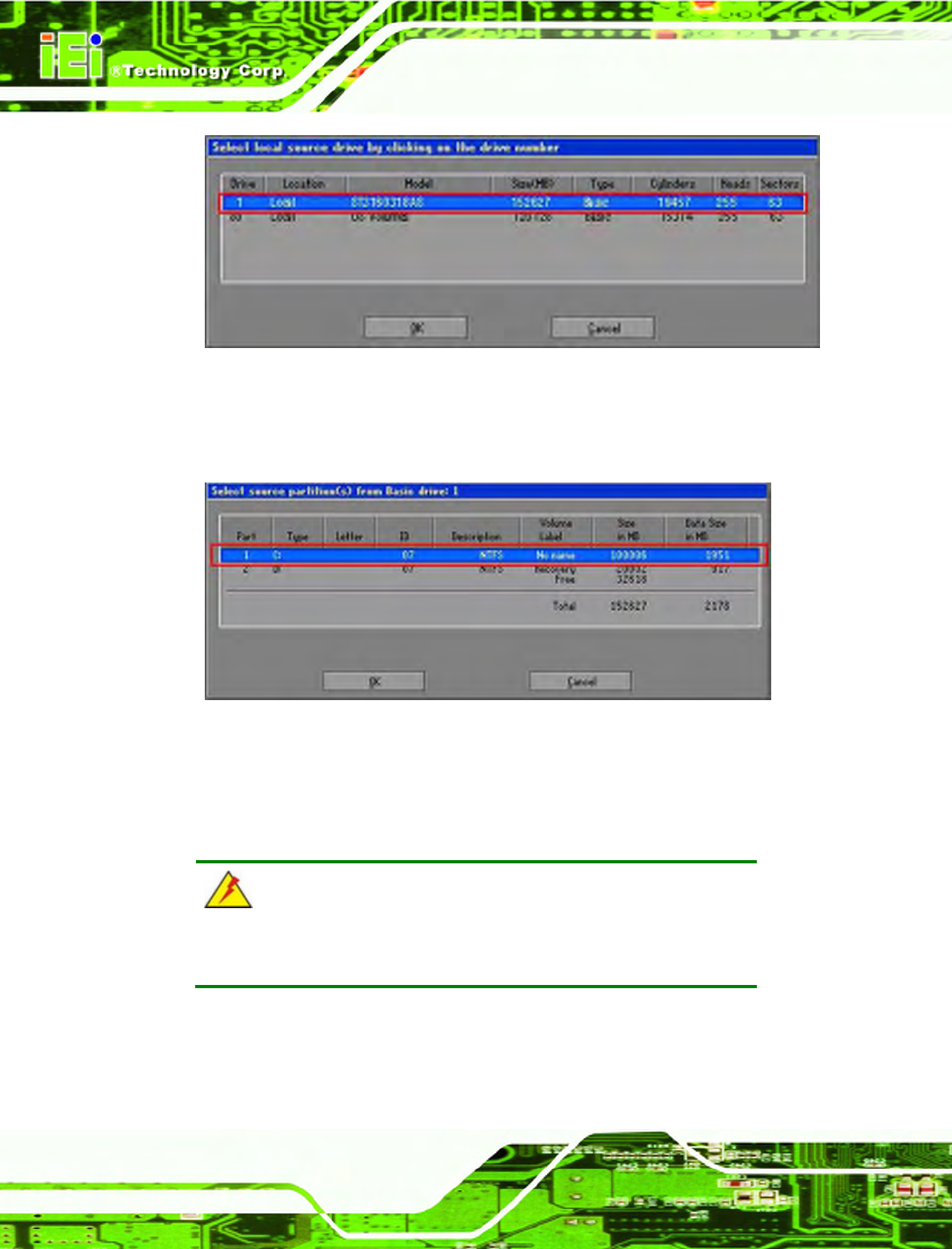
ICEFIRE-T10A Mobile Clinic Assistant
Page 104
Figure B-14: Select a Local Source Drive
Step 6: Select a source partition (Part 1) from basic drive as shown in
780H780H461H544H
Figure B-15.
Then click OK.
Figure B-15: Select a Source Partition from Basic Drive
Step 7: Select 1.2: [Recovery] NTFS drive and enter a file name called iei
(
781H781H462H545H
Figure B-16). Click Save. The factory default image will then be saved in the
selected recovery drive and named IEI.GHO.
WARNING:
The file name of the factory default image must be iei.GHO.
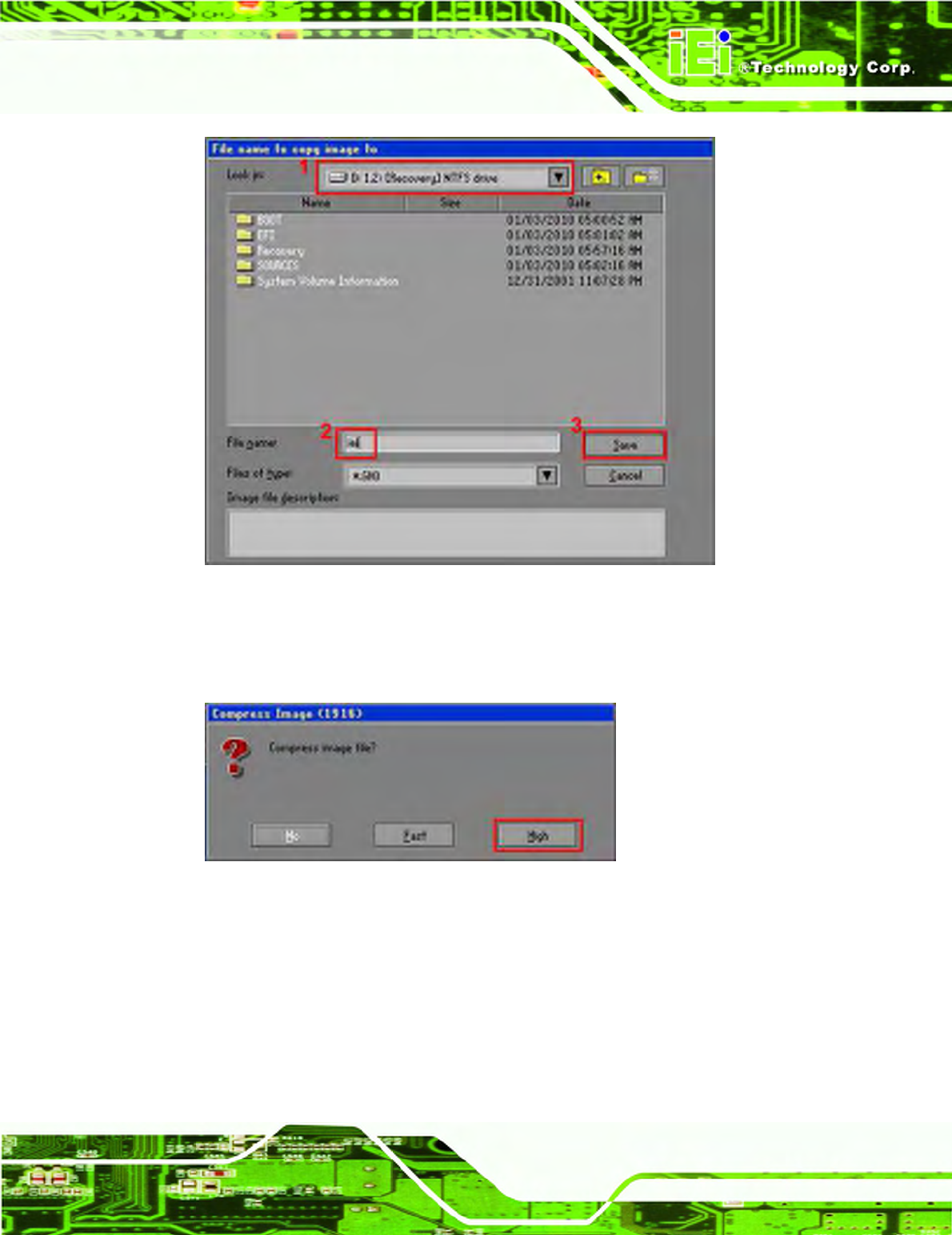
ICEFIRE-T10A Mobile Clinic Assistant
Page 105
Figure B-16: File Name to Copy Image to
Step 8: When the Compress Image screen in
782H782H463H546H
Figure B-17 prompts, click High to make
the image file smaller.
Figure B-17: Compress Image
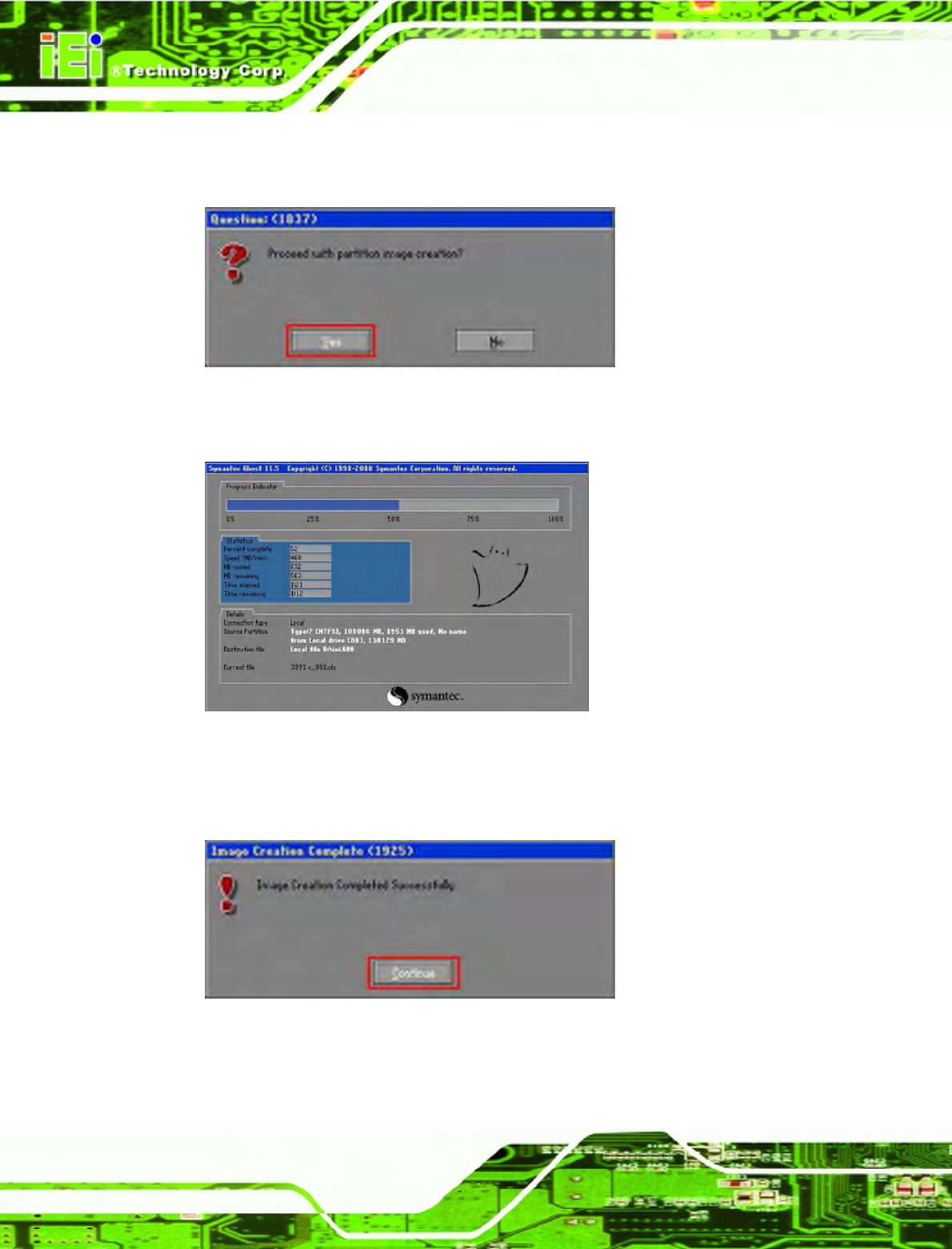
ICEFIRE-T10A Mobile Clinic Assistant
Page 106
Step 9: The Proceed with partition image creation window appears, click Yes to
continue.
Figure B-18: Image Creation Confirmation
Step 10: The Symantec Ghost starts to create the factory default image (
783H783H464H547H
Figure B-19).
Figure B-19: Image Creation Process
Step 11: When the image creation completes, a screen prompts as shown in
784H784H465H548H
Figure B-20.
Click Continue and close the Ghost window to exit the program.
Figure B-20: Image Creation Complete
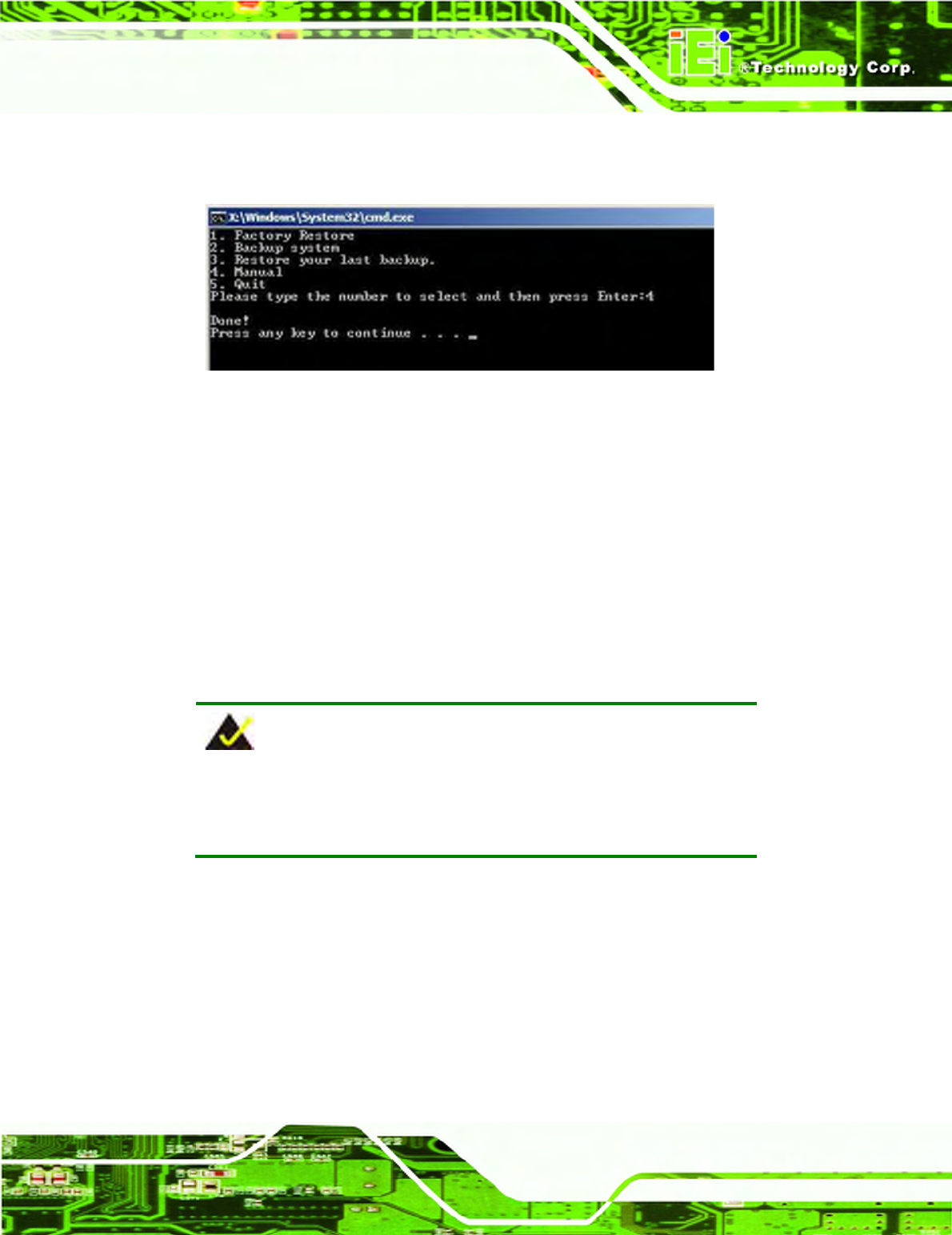
ICEFIRE-T10A Mobile Clinic Assistant
Page 107
Step 12: The recovery tool main menu window is shown as below. Press any key to
reboot the system. Step 0:
Figure B-21: Press Any Key to Continue
B.3 Setup Procedure for Linux
The initial setup procedures for Linux system are mostly the same with the procedure for
Microsoft Windows. Please follow the steps below to setup recovery tool for Linux OS.
Step 1: Hardware and BIOS setup. Refer to Section
785H785H466H549H
B.2.1.
Step 2: Install Linux operating system. Make sure to install GRUB (v0.97 or earlier)
MBR type and Ext3 partition type. Leave enough space on the hard drive to
create the recover partition later.
NOTE:
If the Linux OS is not installed with GRUB (v0.97 or earlier) and Ext3,
the Symantec Ghost may not function properly.
While installing Linux OS, please create two partitions:
Partition 1: /
Partition 2: SWAP
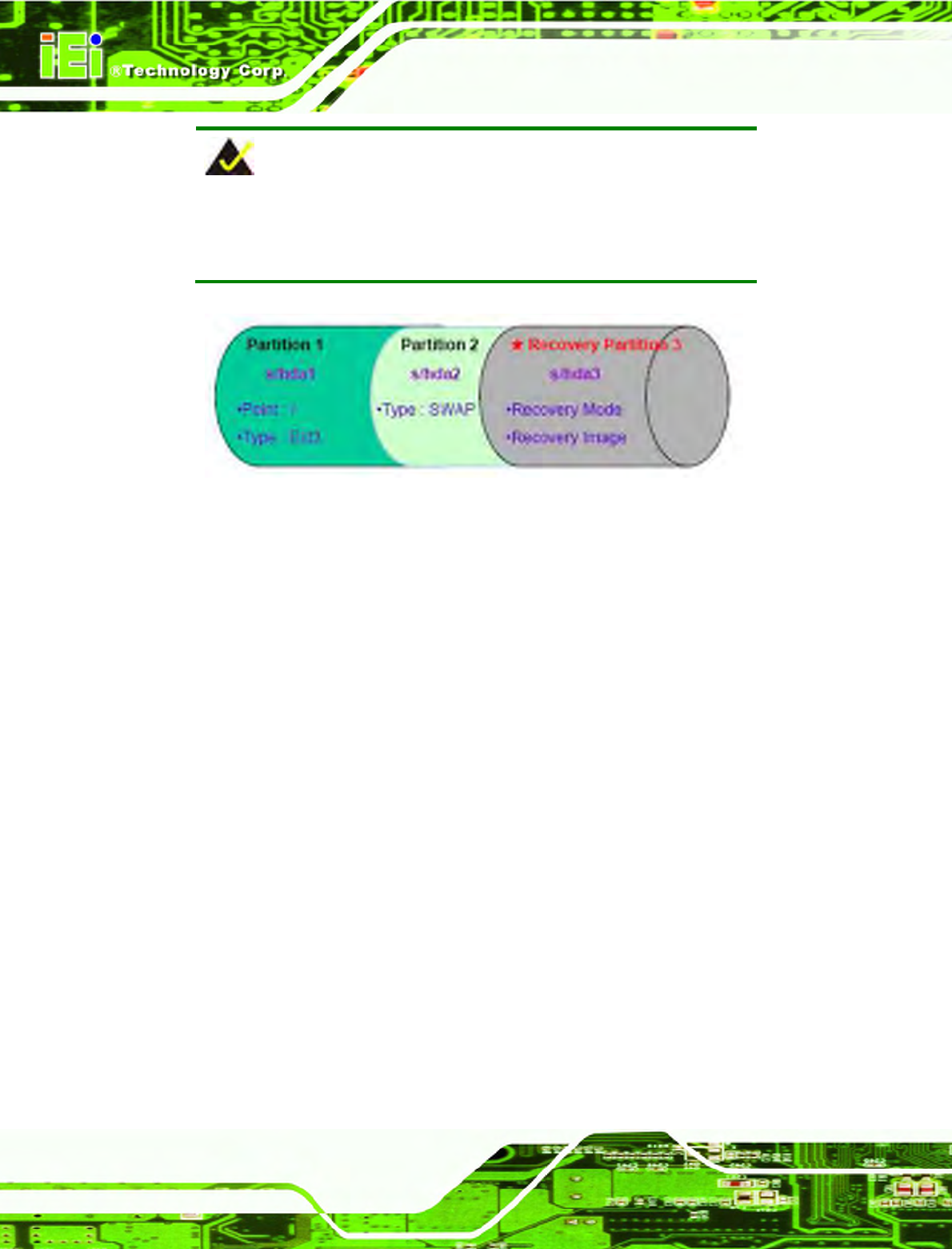
ICEFIRE-T10A Mobile Clinic Assistant
Page 108
NOTE:
Please reserve enough space for partition 3 for saving recovery
images.
Figure B-22: Partitions for Linux
Step 3: Create a recovery partition. Insert the recovery CD into the optical disk drive.
Follow Step 1 ~ Step 3 described in Section
786H786H467H550H
B.2.2. Then type the following
commands (marked in red) to create a partition for recovery images.
system32>diskpart
DISKPART>list vol
DISKPART>sel disk 0
DISKPART>create part pri size= ___
DISKPART>assign letter=N
DISKPART>exit
system32>format N: /fs:ntfs /q /v:Recovery /y
system32>exit
Step 4: Build-up recovery partition. Press any key to boot from the recovery CD. It will
take a while to launch the recovery tool. Please be patient. When the recovery
tool setup menu appears, type <3> and press <Enter> (
787H787H468H551H
Figure B-23). The
Symantec Ghost window appears and starts configuring the system to build-up a
recovery partition. After completing the system configuration, press any key to
reboot the system. Eject the recovery CD.
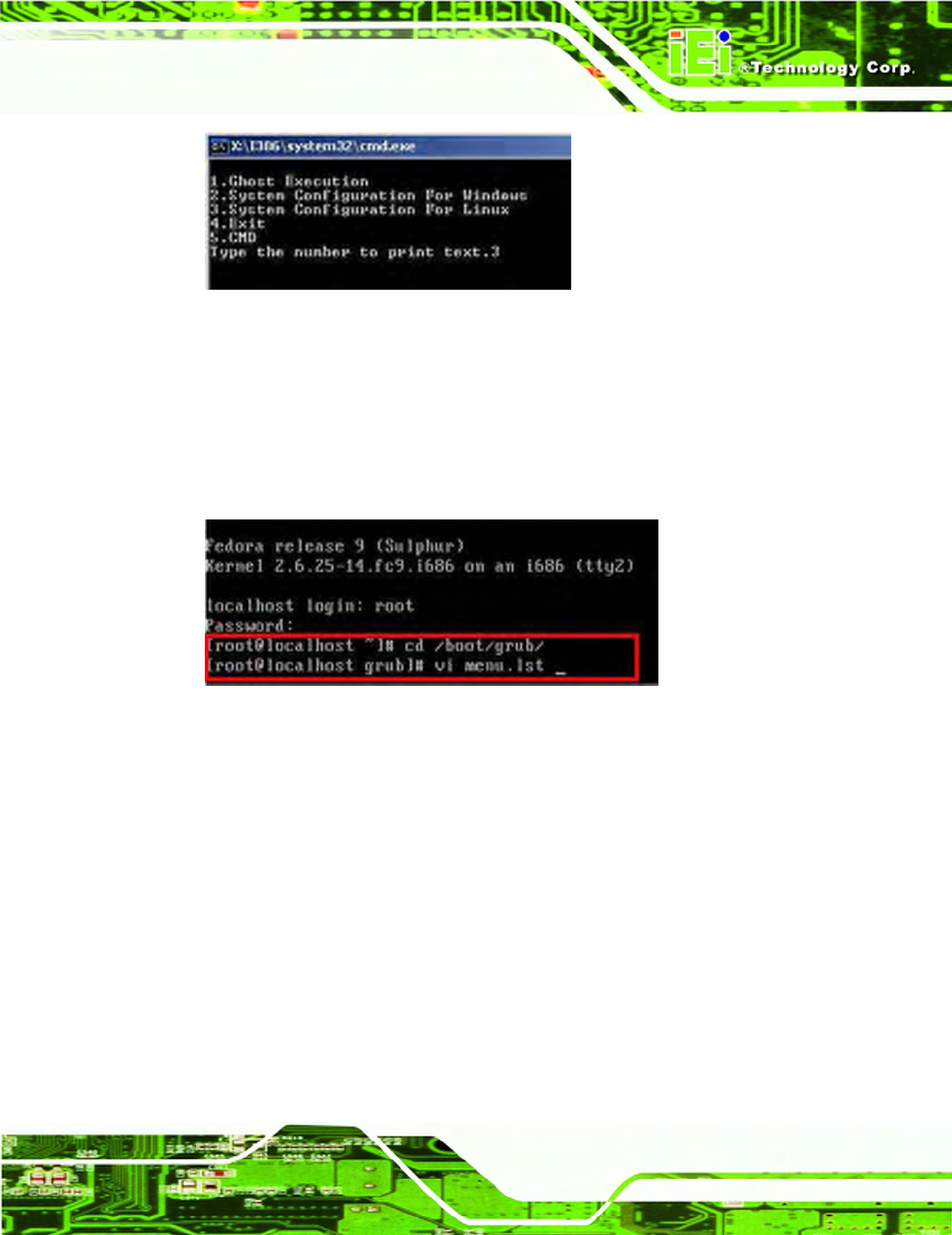
ICEFIRE-T10A Mobile Clinic Assistant
Page 109
Figure B-23: System Configuration for Linux
Step 5: Access the recovery tool main menu by modifying the “menu.lst”. To first
access the recovery tool main menu, the menu.lst must be modified. In Linux
system, enter Administrator (root). When prompt appears, type:
cd /boot/grub
vi menu.lst
Figure B-24: Access menu.lst in Linux (Text Mode)
Step 6: Modify the menu.lst as shown below.
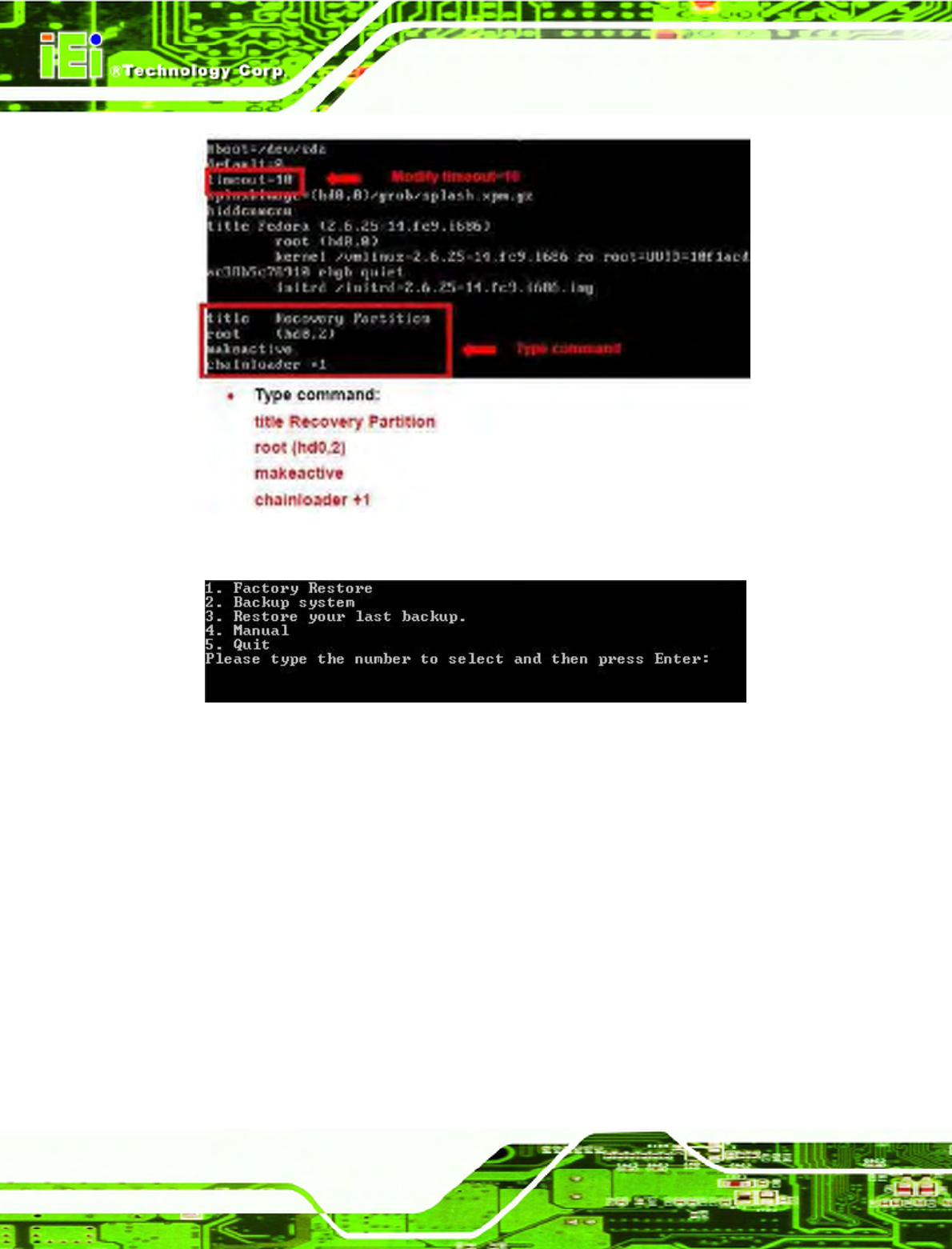
ICEFIRE-T10A Mobile Clinic Assistant
Page 110
Step 7: The recovery tool menu appears. (
788H788H469H552H
Figure B-25)
Figure B-25: Recovery Tool Menu
Step 8: Create a factory default image. Follow Step 2 ~ Step 12 described in
Section
789H789H470H553H
B.2.5 to create a factory default image.
B.4 Recovery Tool Functions
After completing the initial setup procedures as described above, users can access the
recovery tool by pressing <F3> while booting up the system. The main menu of the
recovery tool is shown below.
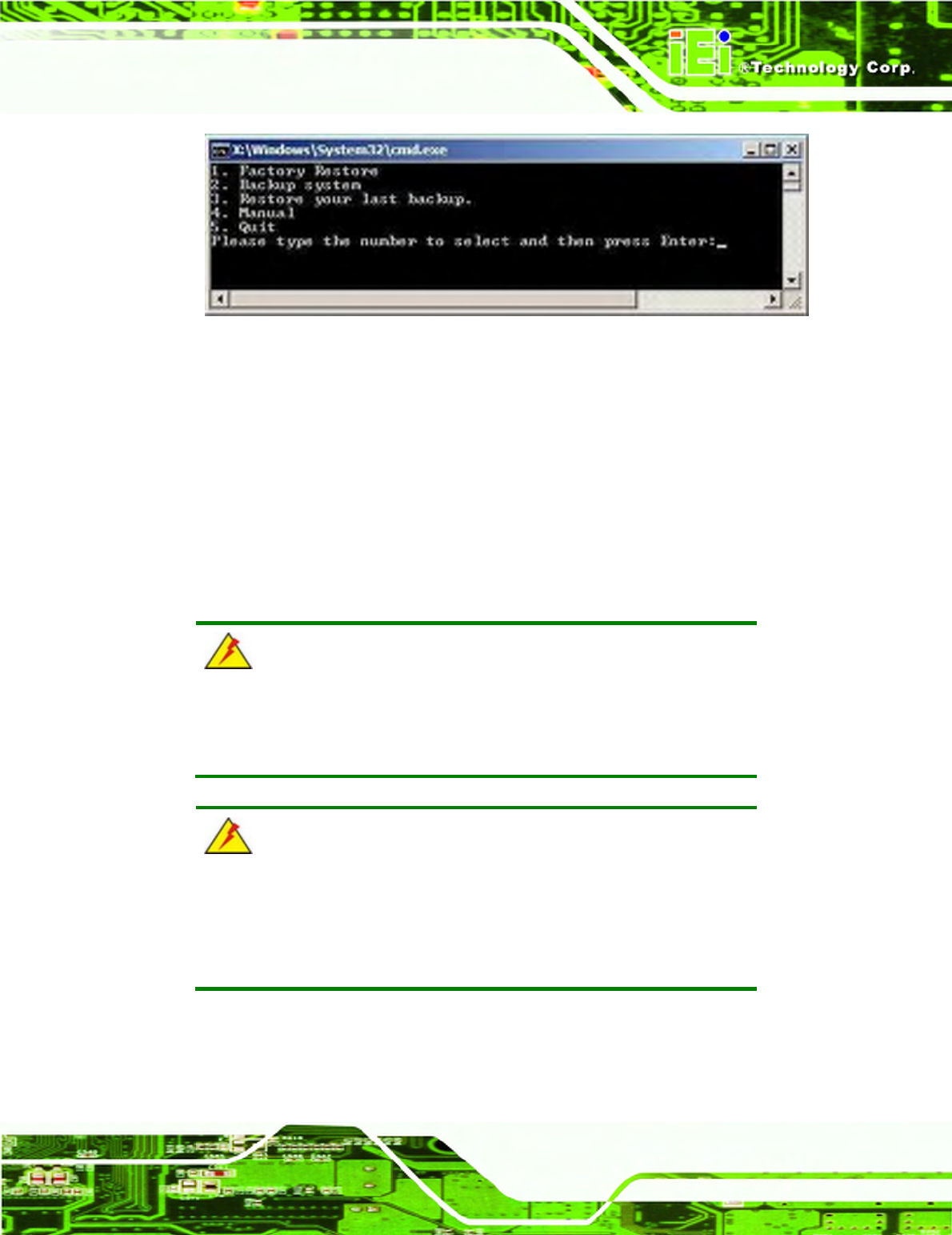
ICEFIRE-T10A Mobile Clinic Assistant
Page 111
Figure B-26: Recovery Tool Main Menu
The recovery tool has several functions including:
1. Factory Restore: Restore the factory default image (iei.GHO) created in
Section
790H790H471H554H
B.2.5.
2. Backup system: Create a system backup image (iei_user.GHO) which will be
saved in the hidden partition.
3. Restore your last backup: Restore the last system backup image
4. Manual: Enter the Symantec Ghost window to configure manually.
5. Quit: Exit the recovery tool and restart the system.
WARNING:
Please do not turn off the system power during the process of system
recovery or backup.
WARNING:
All data in the system will be deleted during the system recovery.
Please backup the system files before restoring the system (either
Factory Restore or Restore Backup).
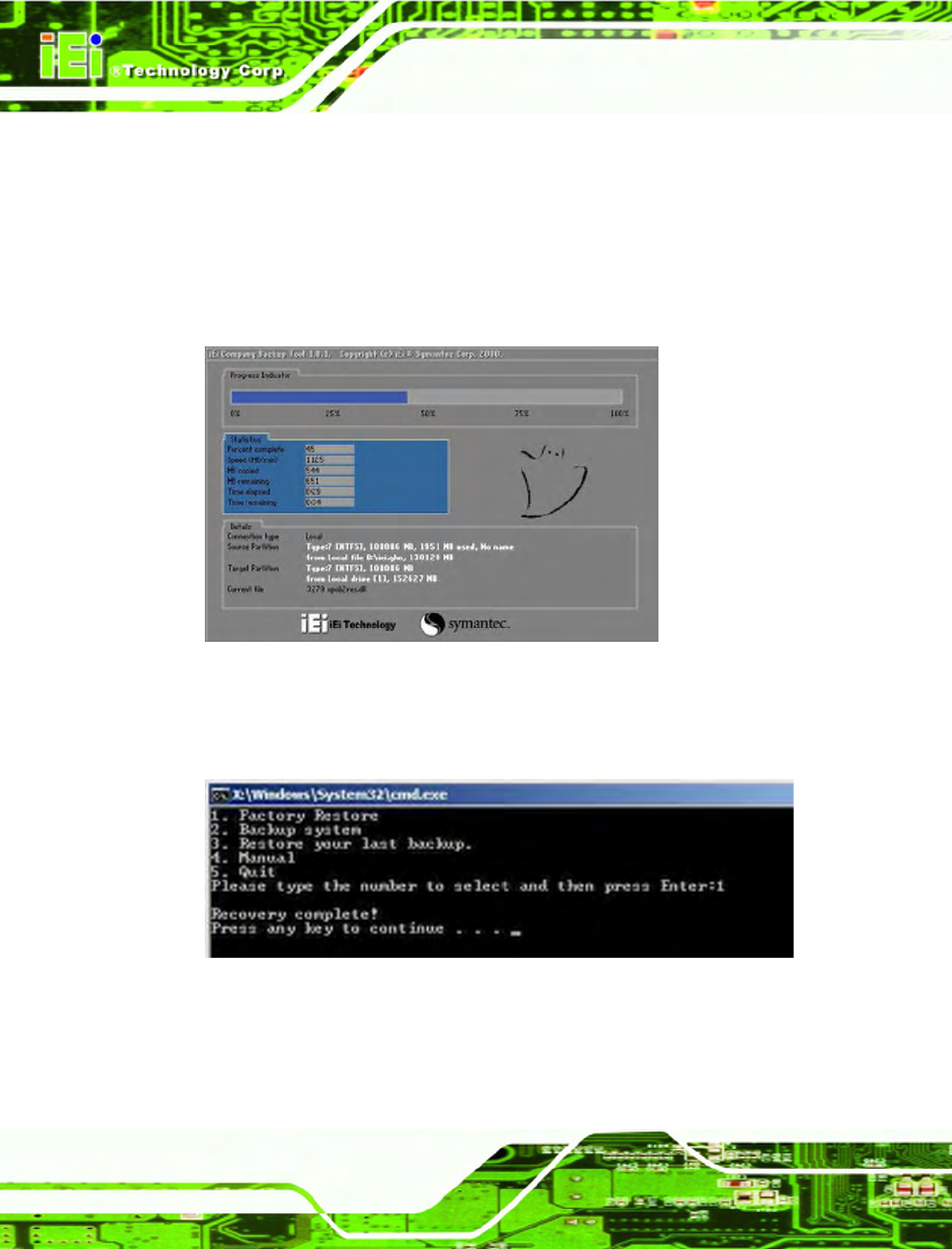
ICEFIRE-T10A Mobile Clinic Assistant
Page 112
B.4.1 Factory Restore
To restore the factory default image, please follow the steps below.
Step 1: Type <1> and press <Enter> in the main menu.
Step 2: The Symantec Ghost window appears and starts to restore the factory default. A
factory default image called iei.GHO is created in the hidden Recovery partition.
Figure B-27: Restore Factory Default
Step 3: The screen is shown as in
791H791H472H555H
Figure B-28 when completed. Press any key to
reboot the system.
Figure B-28: Recovery Complete Window
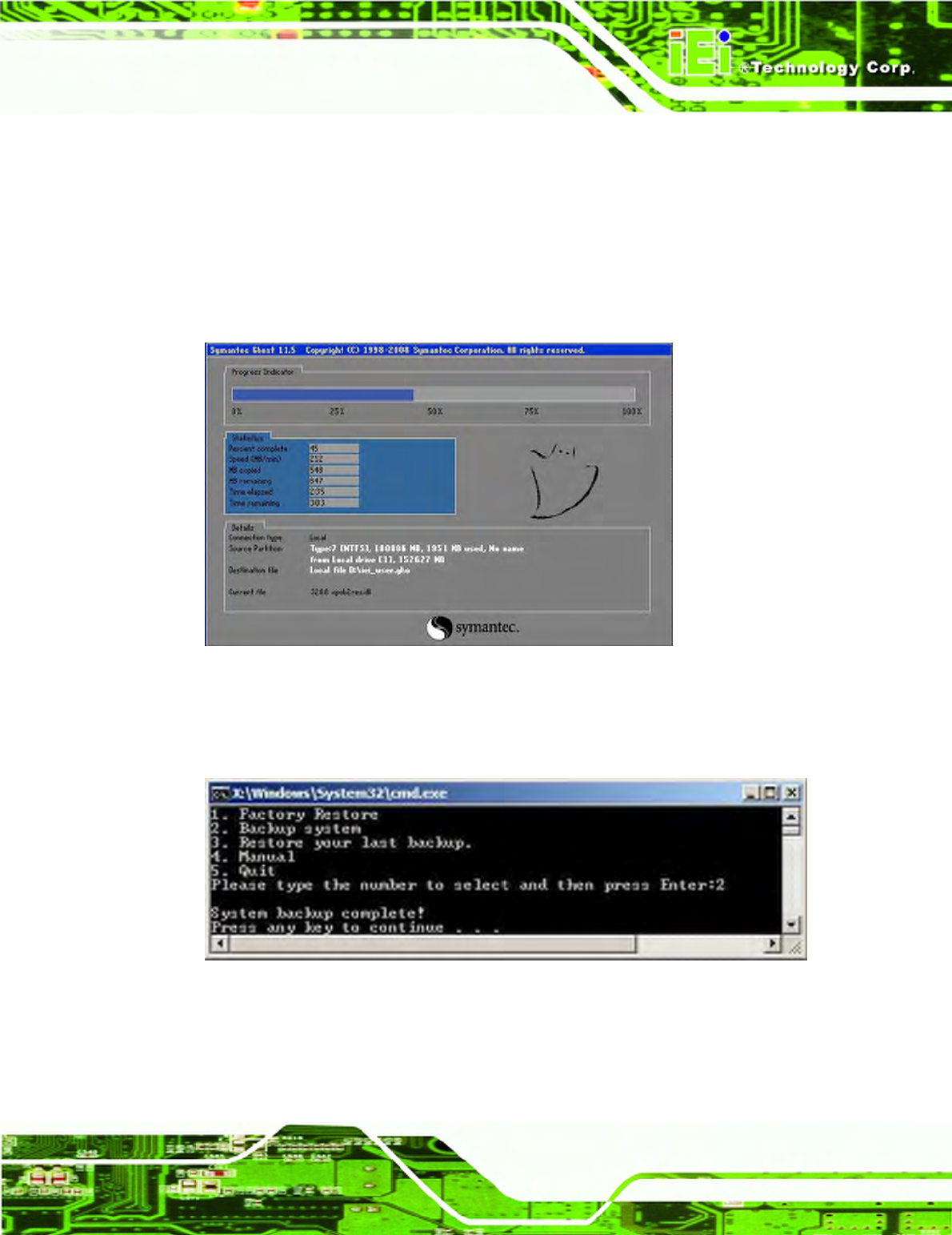
ICEFIRE-T10A Mobile Clinic Assistant
Page 113
B.4.2 Backup System
To backup the system, please follow the steps below.
Step 1: Type <2> and press <Enter> in the main menu.
Step 2: The Symantec Ghost window appears and starts to backup the system. A
backup image called iei_user.GHO is created in the hidden Recovery partition.
Figure B-29: Backup System
Step 3: The screen is shown as in
792H792H473H556H
Figure B-30 when system backup is completed.
Press any key to reboot the system.
Figure B-30: System Backup Complete Window
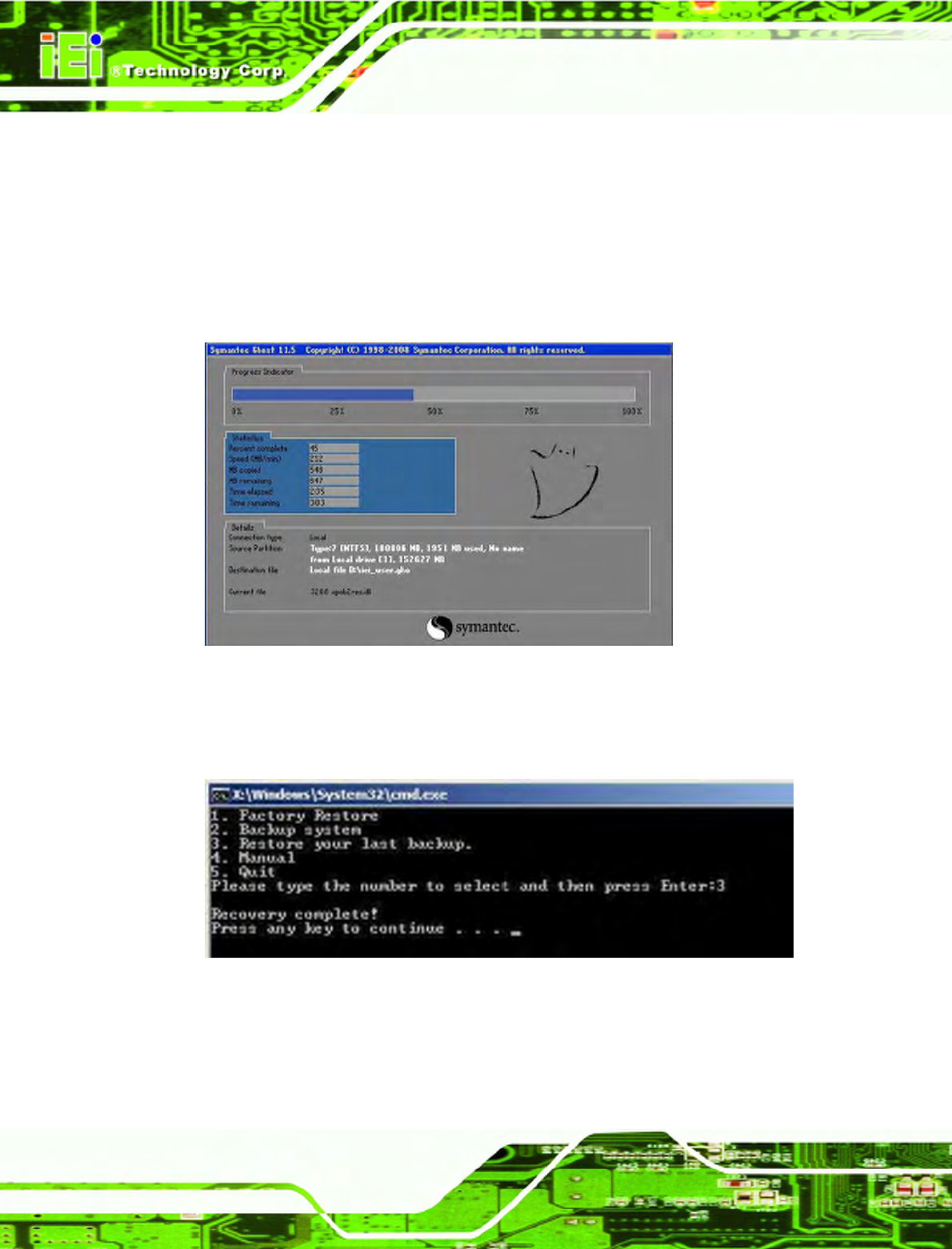
ICEFIRE-T10A Mobile Clinic Assistant
Page 114
B.4.3 Restore Your Last Backup
To restore the last system backup, please follow the steps below.
Step 1: Type <3> and press <Enter> in the main menu.
Step 2: The Symantec Ghost window appears and starts to restore the last backup
image (iei_user.GHO).
Figure B-31: Restore Backup
Step 3: The screen is shown as in
793H793H474H557H
Figure B-32 when backup recovery is completed.
Press any key to reboot the system.
Figure B-32: Restore System Backup Complete Window
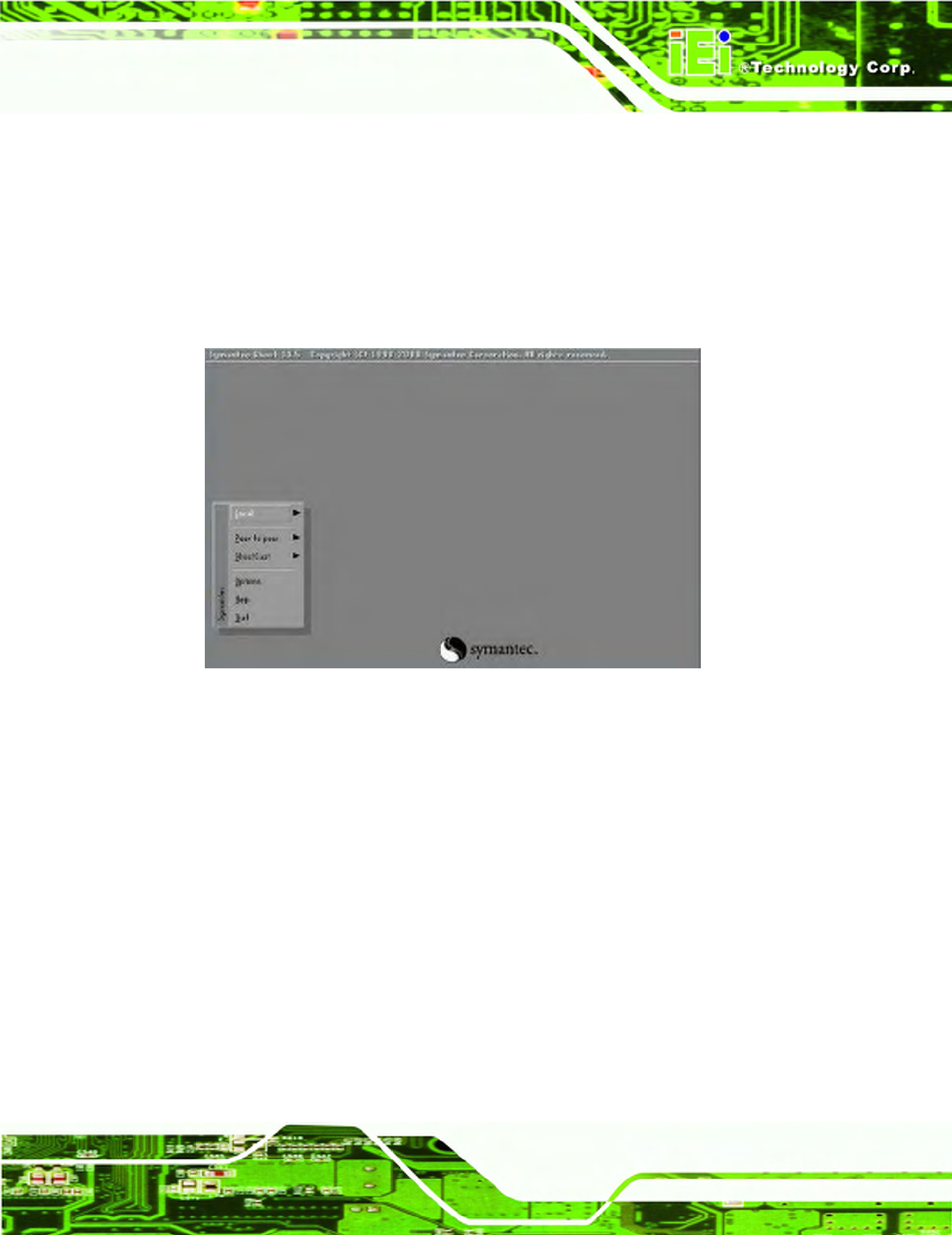
ICEFIRE-T10A Mobile Clinic Assistant
Page 115
B.4.4 Manual
To restore the last system backup, please follow the steps below.
Step 1: Type <4> and press <Enter> in the main menu.
Step 2: The Symantec Ghost window appears. Use the Ghost program to backup or
recover the system manually.
Figure B-33: Symantec Ghost Window
Step 3: When backup or recovery is completed, press any key to reboot the system.
Step 0:
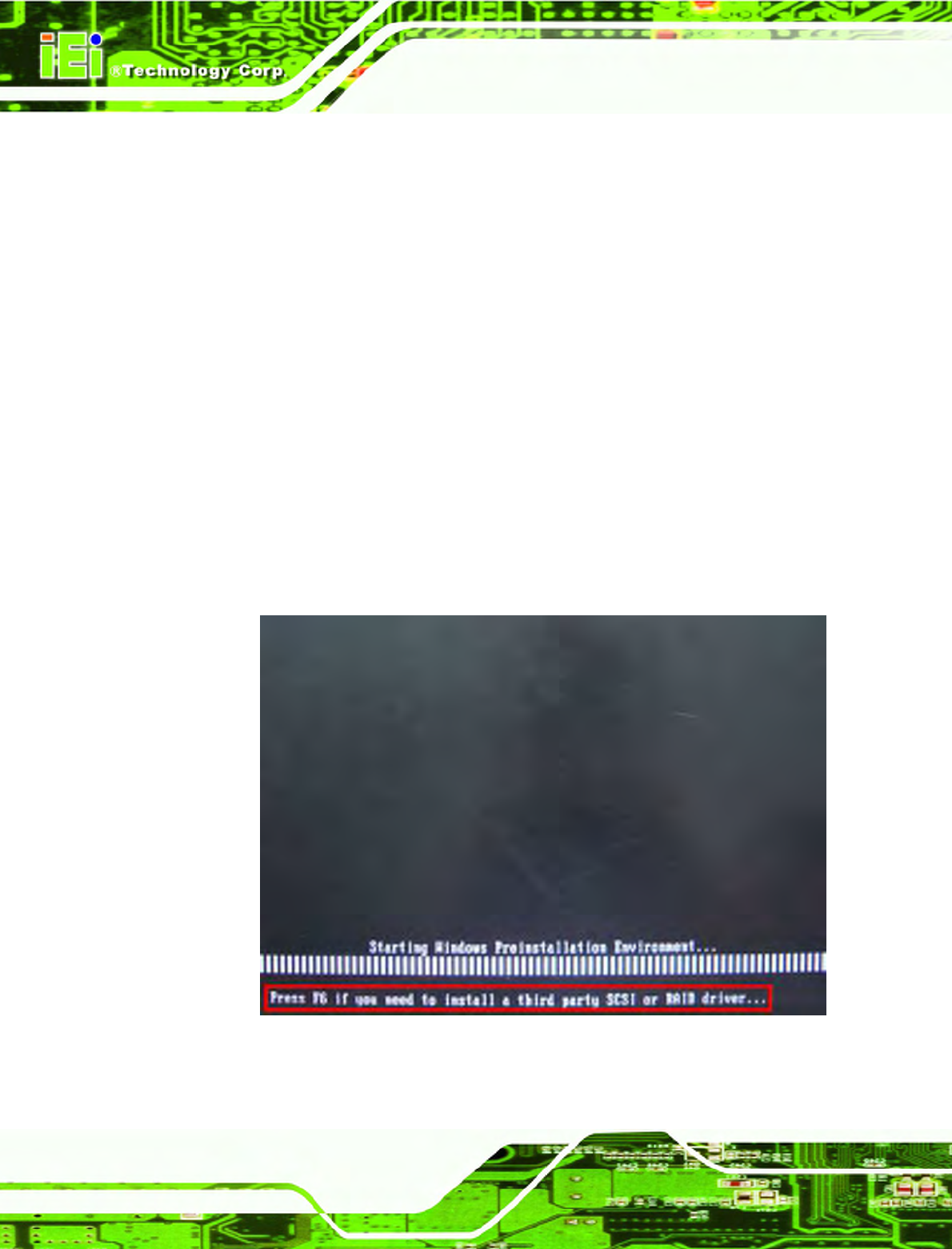
ICEFIRE-T10A Mobile Clinic Assistant
Page 116
B.5 Other Information
B.5.1 Using AHCI Mode or ALi M5283 / VIA VT6421A Controller
When the system uses AHCI mode or some specific SATA controllers such as ALi M5283
or VIA VT6421A, the SATA RAID/AHCI driver must be installed before using one key
recovery. Please follow the steps below to install the SATA RAID/AHCI driver.
Step 1: Copy the SATA RAID/AHCI driver to a floppy disk and insert the floppy disk into
a USB floppy disk drive. The SATA RAID/AHCI driver must be especially
designed for the on-board SATA controller.
Step 2: Connect the USB floppy disk drive to the system.
Step 3: Insert the One Key Recovery CD into the system and boot the system from the
CD.
Step 4: When launching the recovery tool, press <F6>.
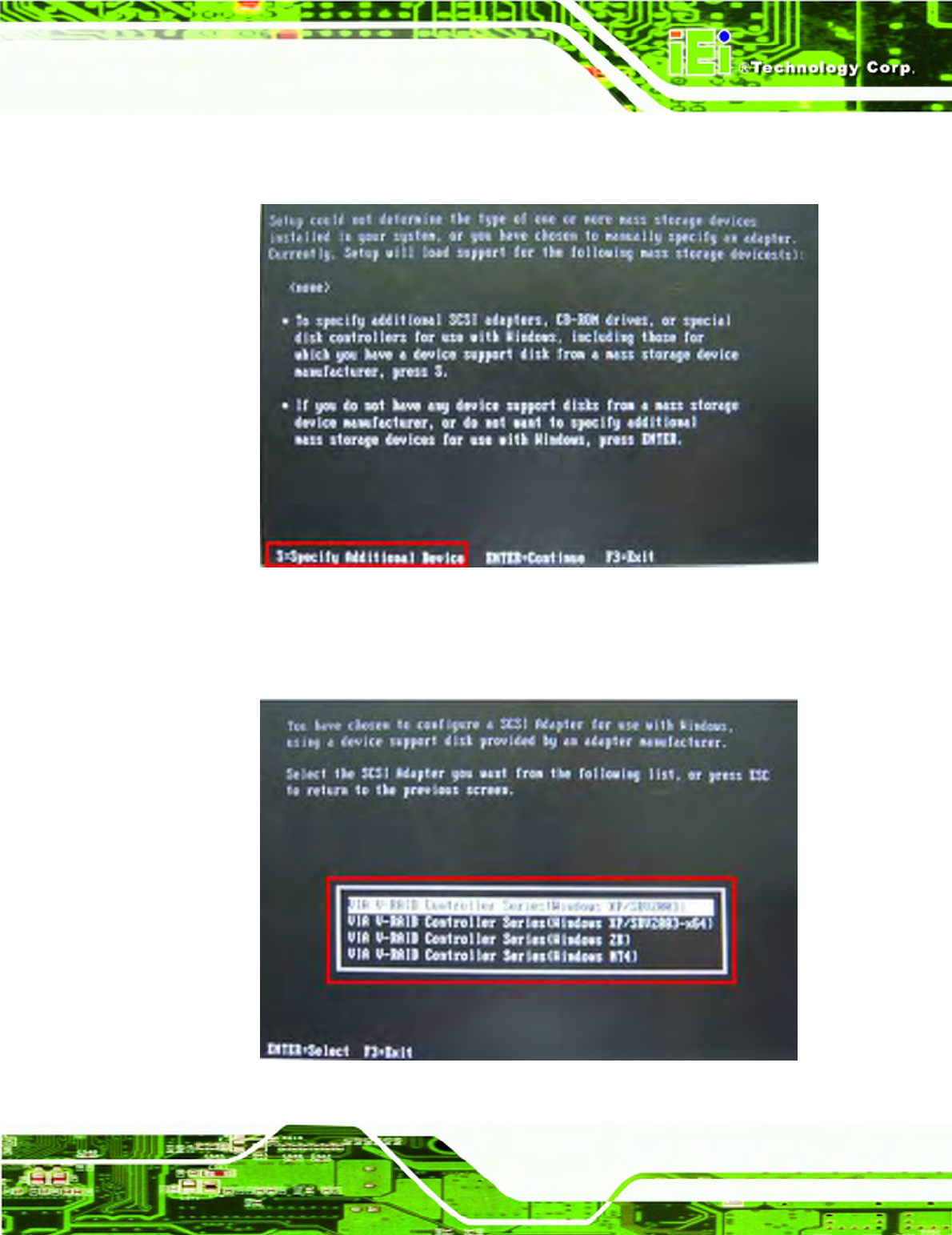
ICEFIRE-T10A Mobile Clinic Assistant
Page 117
Step 5: When the following window appears, press <S> to select “Specify Additional
Device”.
Step 6: In the following window, select a SATA controller mode used in the system. Then
press <Enter>. The user can now start using the SATA HDD.
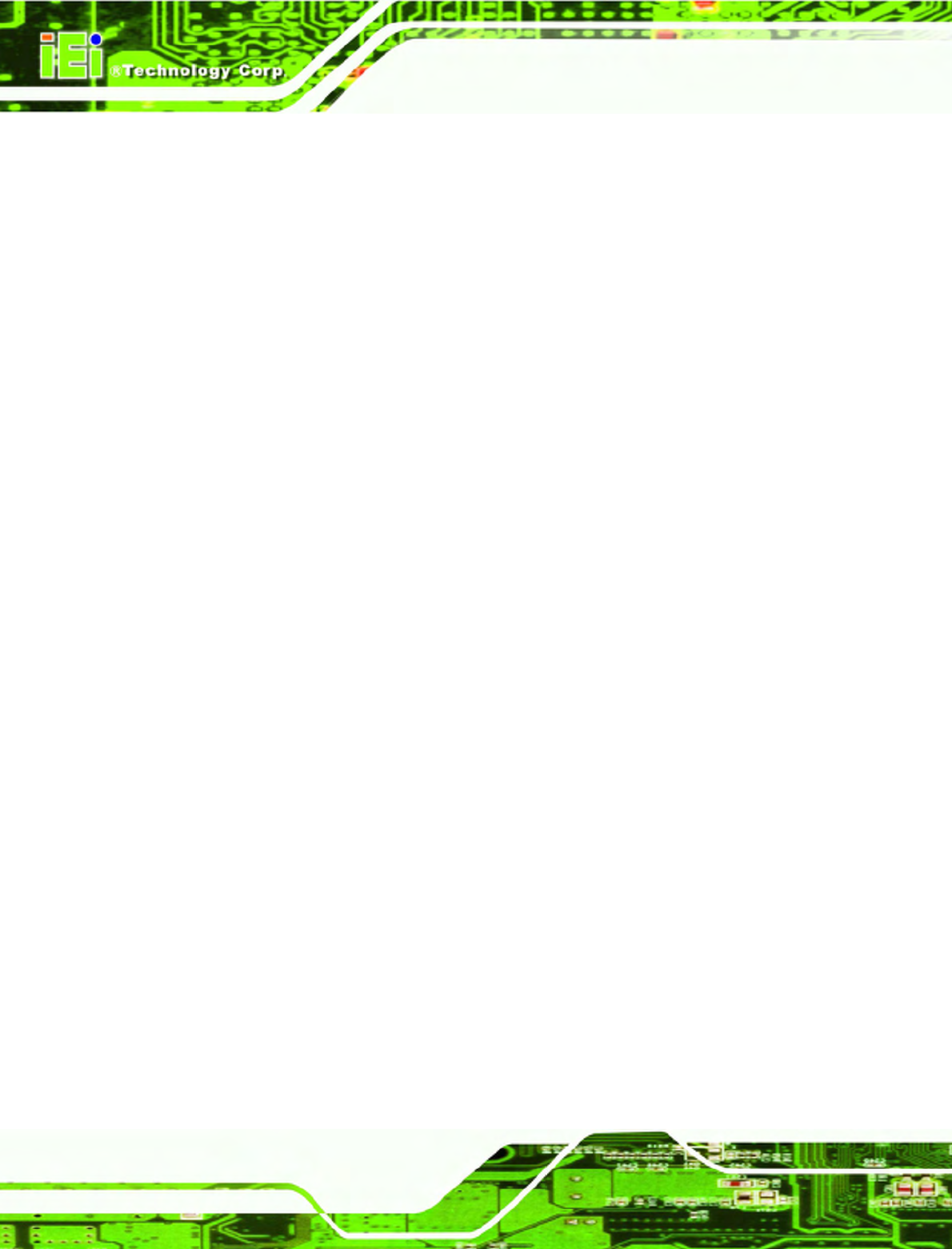
ICEFIRE-T10A Mobile Clinic Assistant
Page 118
Step 7: After pressing <Enter>, the system will get into the recovery tool setup menu.
Continue to follow the setup procedure from Step 4 in Section
794H794H475H558H
B.2.2 Create
Partitions to finish the whole setup process. Step 0:
B.5.2 System Memory Requirement
To be able to access the recovery tool by pressing <F3> while booting up the system,
please make sure to have enough system memory. The minimum memory requirement is
listed below.
Using Award BIOS: 128 MB system memory
Using AMI BIOS: 512 MB system memory.
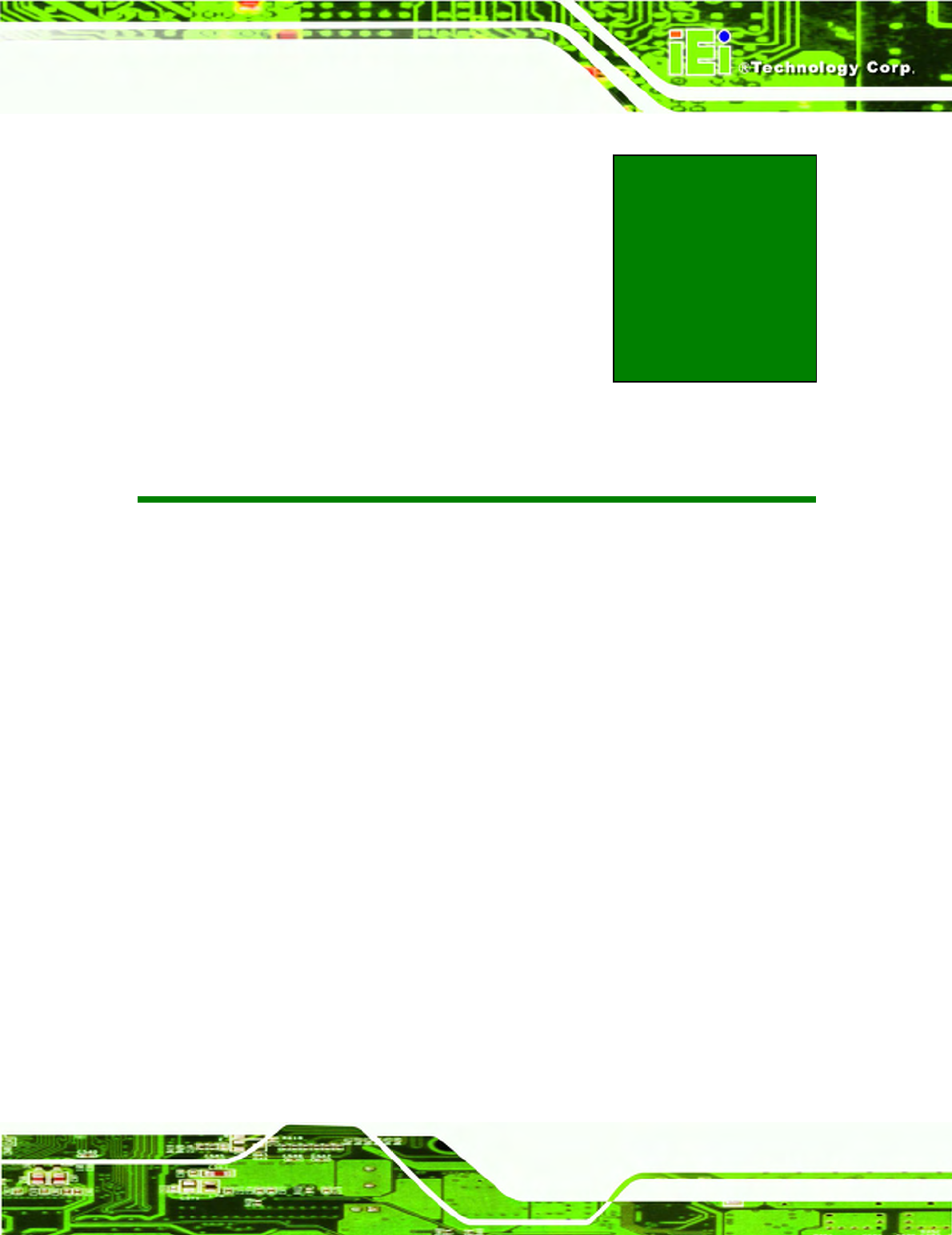
ICEFIRE-T10A Mobile Clinic Assistant
Page 119
Appendix
C
C BIOS Options
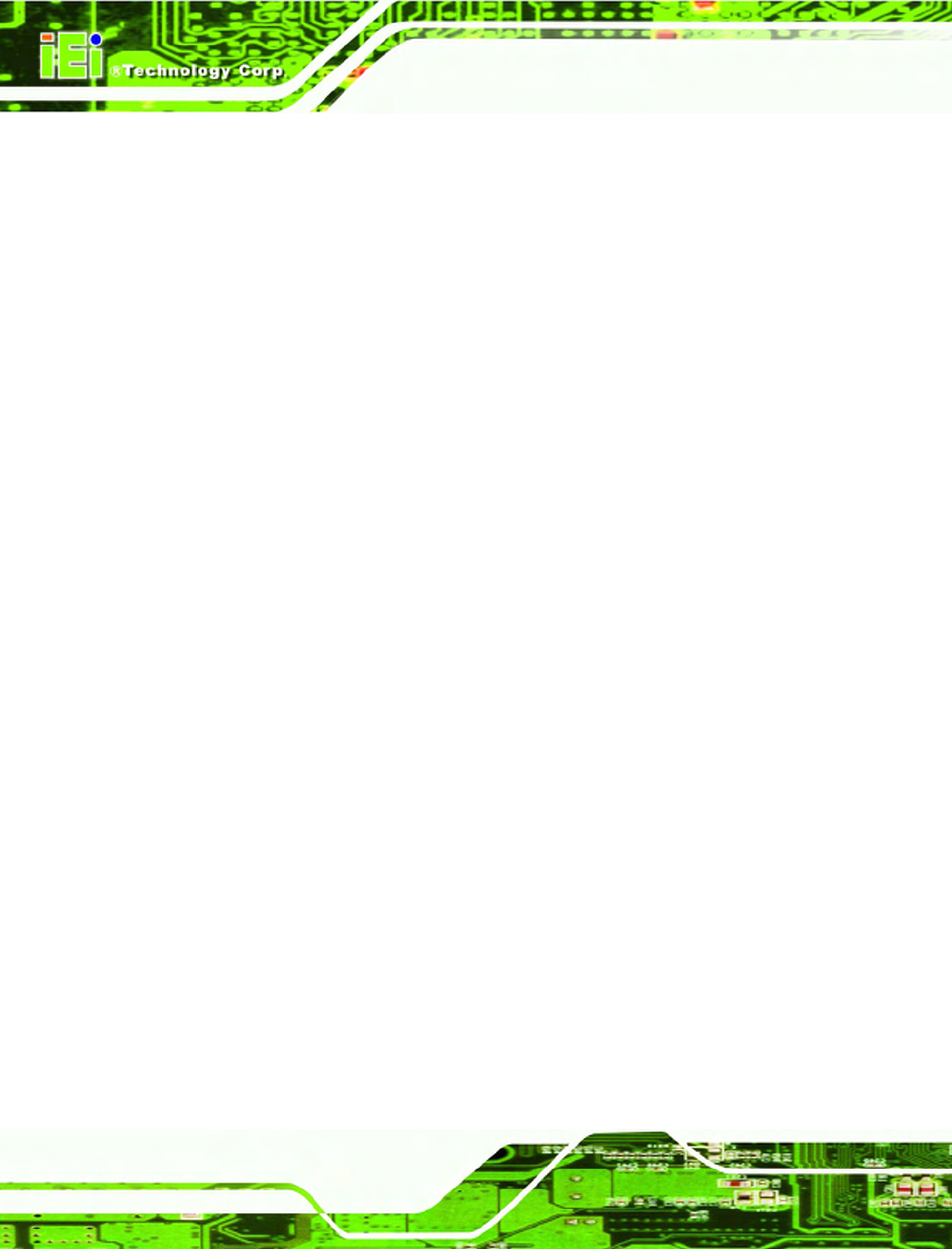
ICEFIRE-T10A Mobile Clinic Assistant
Page 120
Below is a list of BIOS configuration options in the BIOS chapter.
BIOS Information ............................................................................................................ 66
System Date [xx/xx/xx] ................................................................................................... 66
System Time [xx:xx:xx] .................................................................................................. 67
Hyper Threading [Disabled] ............................................................................................ 68
ATA Or IDE Configurations [Ehanced] ........................................................................... 69
Configure SATA as [IDE] ................................................................................................ 70
USB Devices .................................................................................................................... 70
Legacy USB Support [Enabled] ...................................................................................... 70
PC Health Status ............................................................................................................. 71
Mode Setting [Full On Mode] .......................................................................................... 72
Temperature of Start [070] .............................................................................................. 73
Temperature of Off [060] ................................................................................................. 73
Start PWM [100] ............................................................................................................... 73
Slope PWM [1 PWM] ....................................................................................................... 73
Auto Recovery Function [Disabled] ............................................................................... 74
RTL8102 PXE Boot [Disabled] ........................................................................................ 75
HD Audio Controller [Enabled] ....................................................................................... 77
USB Function [Enabled] ................................................................................................. 77
USB 2.0 (EHCI) Support [Enabled] ................................................................................. 78
Set Spread Spectrum Function [Disabled] .................................................................... 78
DVMT Mode Select [DVMT Mode] ................................................................................... 78
DVMT/FIXED Memory [Maximum] .................................................................................. 79
IGD - Boot Type [VBIOS Default] .................................................................................... 79
Bootup NumLock State [On]........................................................................................... 80
Quiet Boot [Enabled] ...................................................................................................... 81
Boot Option #1 [SATA: FiD 1.8 SATA…] ........................................................................ 81
Hard Drive BBS Priorities ............................................................................................... 81
Administrator Password ................................................................................................. 82
User Password ................................................................................................................ 82
Save Changes and Reset ................................................................................................ 82
Discard Changes and Reset ........................................................................................... 82
Restore Defaults ............................................................................................................. 83
Save as User Defaults ..................................................................................................... 83
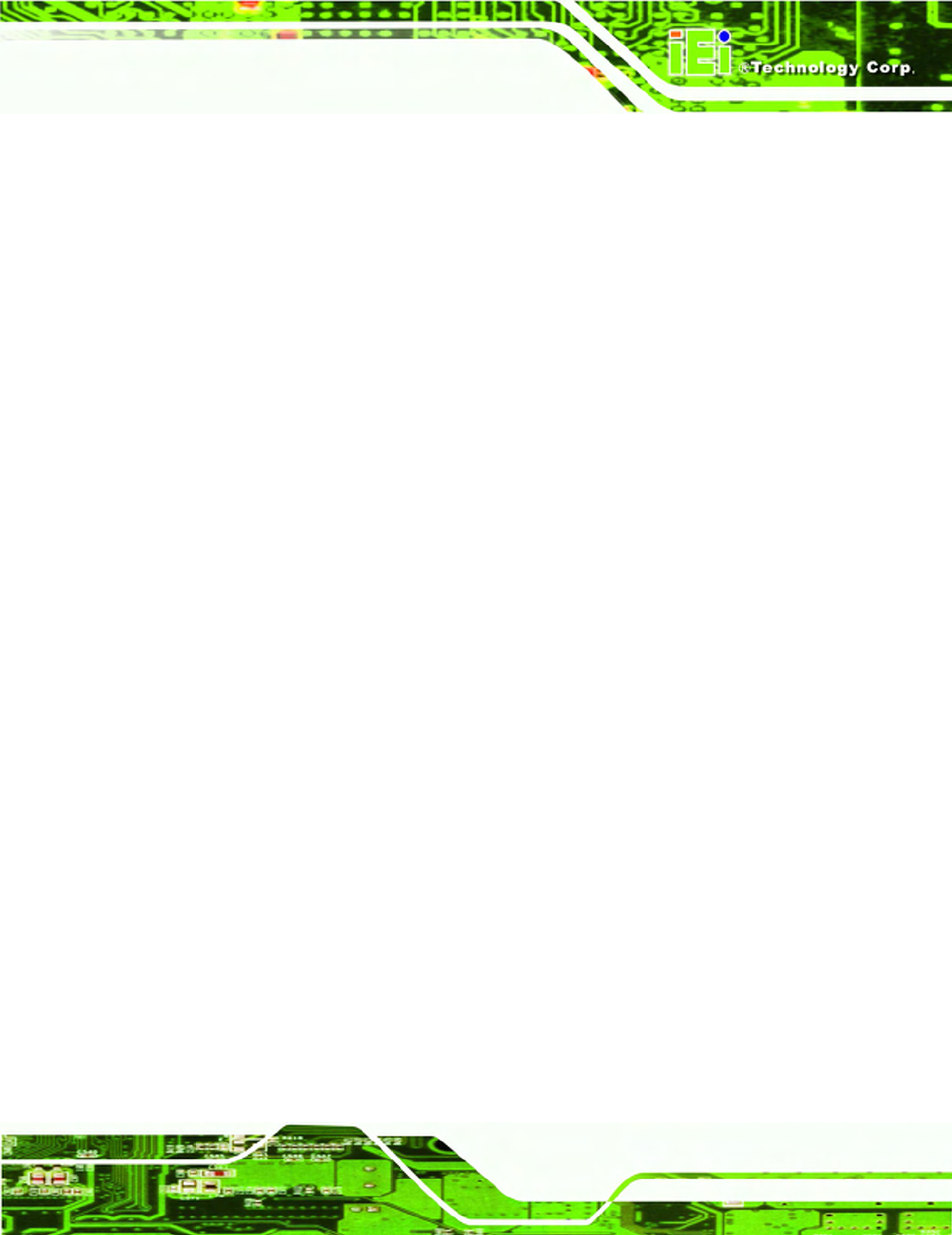
ICEFIRE-T10A Mobile Clinic Assistant
Page 121
Restore User Defaults ..................................................................................................... 83
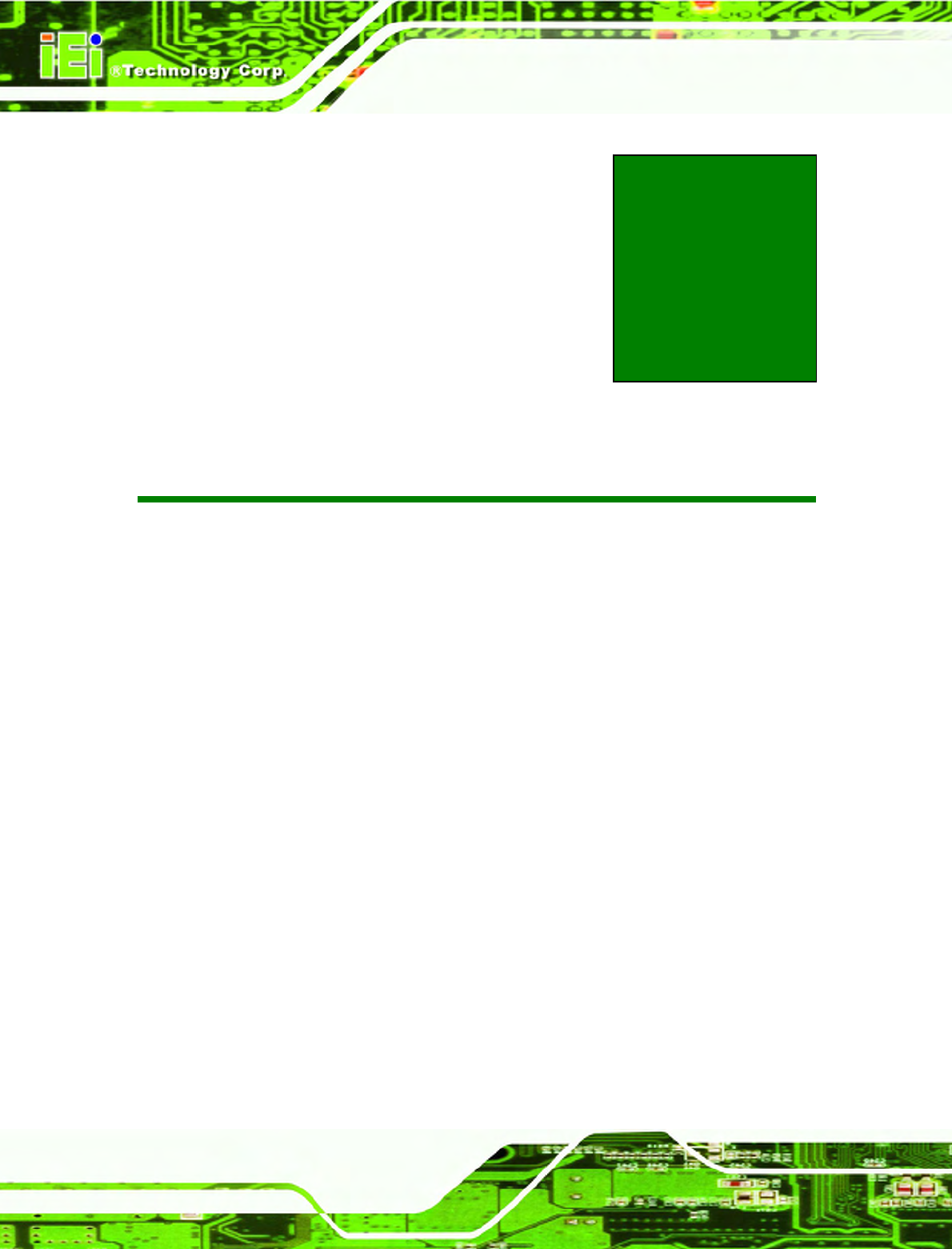
ICEFIRE-T10A Mobile Clinic Assistant
Page 122
Appendix
D
D Terminology
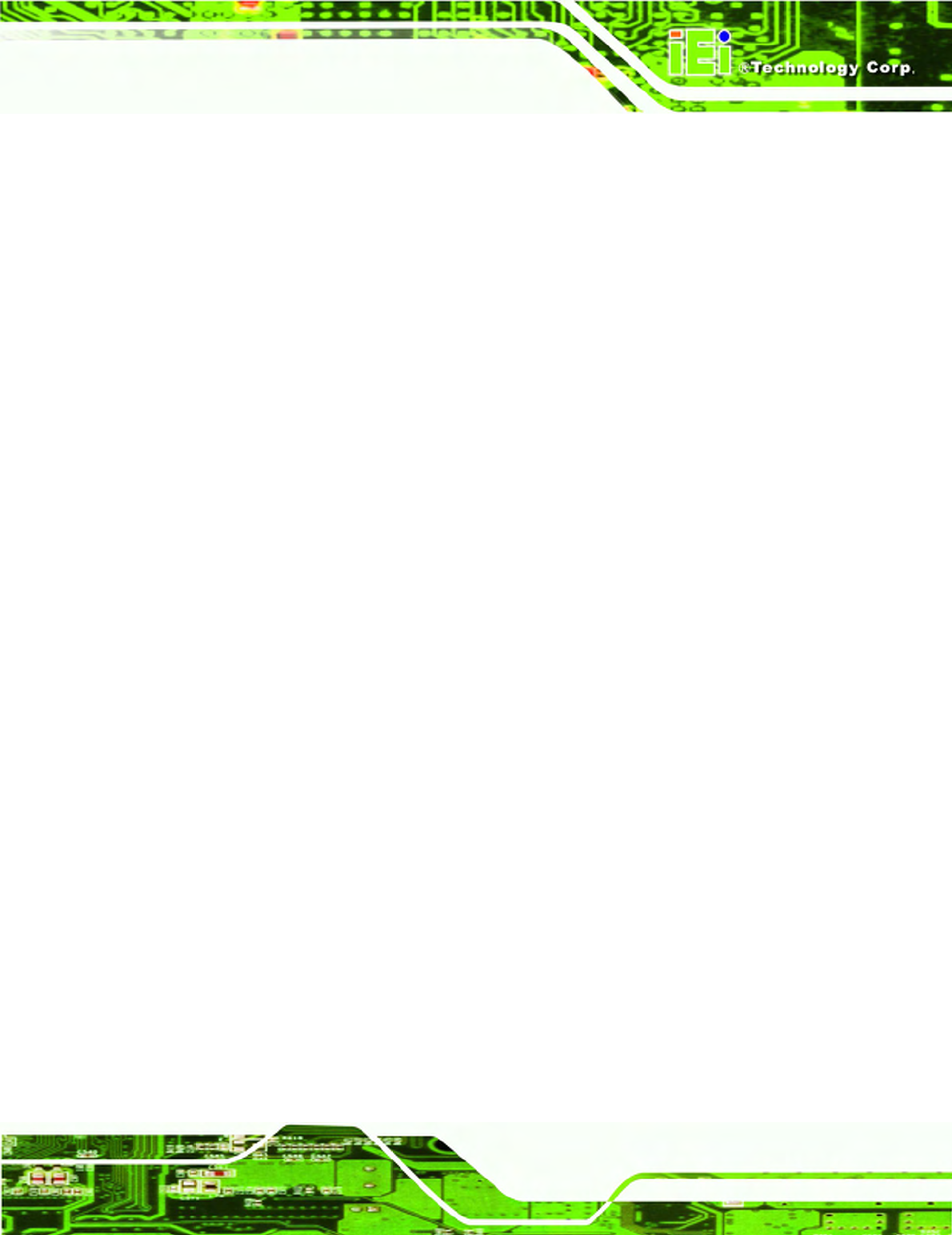
ICEFIRE-T10A Mobile Clinic Assistant
Page 123
AC ’97 Audio Codec 97 (AC’97) refers to a codec standard developed by Intel®
in 1997.
ACPI Advanced Configuration and Power Interface (ACPI) is an OS-directed
configuration, power management, and thermal management interface.
AHCI Advanced Host Controller Interface (AHCI) is a SATA Host controller
register-level interface.
ATA The Advanced Technology Attachment (ATA) interface connects storage
devices including hard disks and CD-ROM drives to a computer.
ARMD An ATAPI Removable Media Device (ARMD) is any ATAPI device that
supports removable media, besides CD and DVD drives.
ASKIR Amplitude Shift Keyed Infrared (ASKIR) is a form of modulation that
represents a digital signal by varying the amplitude (“volume”) of the
signal. A low amplitude signal represents a binary 0, while a high
amplitude signal represents a binary 1.
BIOS The Basic Input/Output System (BIOS) is firmware that is first run when
the computer is turned on and can be configured by the end user
CODEC The Compressor-Decompressor (CODEC) encodes and decodes digital
audio data on the system.
CompactFlash® CompactFlash® is a solid-state storage device. CompactFlash® devices
use flash memory in a standard size enclosure. Type II is thicker than
Type I, but a Type II slot can support both types.
CMOS Complimentary metal-oxide-conductor is an integrated circuit used in
chips like static RAM and microprocessors.
COM COM refers to serial ports. Serial ports offer serial communication to
expansion devices. The serial port on a personal computer is usually a
male DB-9 connector.
DAC The Digital-to-Analog Converter (DAC) converts digital signals to analog
signals.
DDR Double Data Rate refers to a data bus transferring data on both the rising
and falling edges of the clock signal.
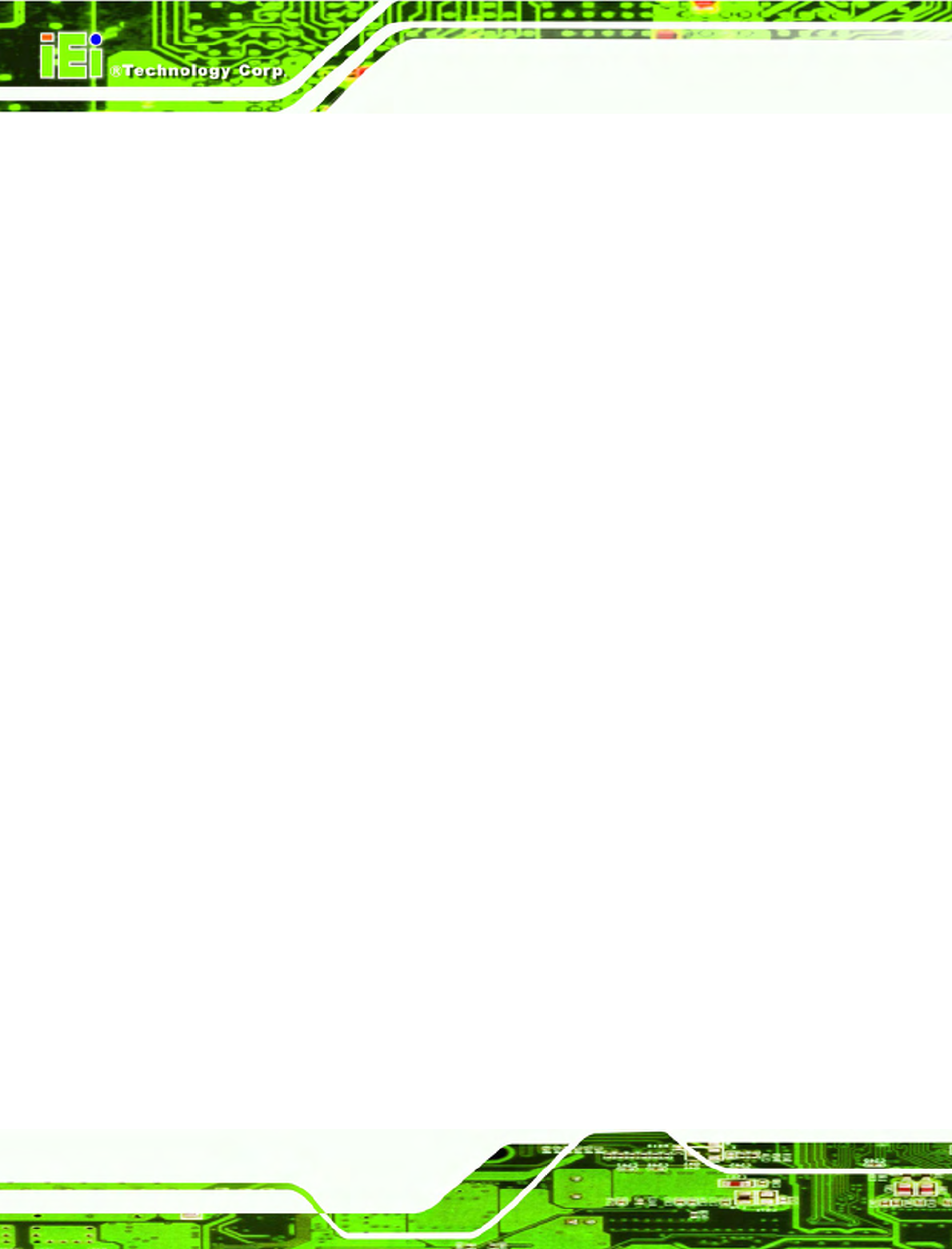
ICEFIRE-T10A Mobile Clinic Assistant
Page 124
DMA Direct Memory Access (DMA) enables some peripheral devices to
bypass the system processor and communicate directly with the system
memory.
DIMM Dual Inline Memory Modules are a type of RAM that offer a 64-bit data
bus and have separate electrical contacts on each side of the module.
DIO The digital inputs and digital outputs are general control signals that
control the on/off circuit of external devices or TTL devices. Data can be
read or written to the selected address to enable the DIO functions.
EHCI The Enhanced Host Controller Interface (EHCI) specification is a
register-level interface description for USB 2.0 Host Controllers.
EIDE Enhanced IDE (EIDE) is a newer IDE interface standard that has data
transfer rates between 4.0 MBps and 16.6 MBps.
EIST Enhanced Intel® SpeedStep Technology (EIST) allows users to modify
the power consumption levels and processor performance through
application software. The application software changes the bus-to-core
frequency ratio and the processor core voltage.
FSB The Front Side Bus (FSB) is the bi-directional communication channel
between the processor and the Northbridge chipset.
GbE Gigabit Ethernet (GbE) is an Ethernet version that transfers data at 1.0
Gbps and complies with the
216H251H
IEEE 802.3-2005 standard.
GPIO General purpose input
HDD Hard disk drive (HDD) is a type of magnetic, non-volatile computer
storage device that stores digitally encoded data.
ICH The Input/Ouput Control Hub (ICH) is an Intel® Southbridge chipset.
IrDA Infrared Data Association (IrDA) specify infrared data transmission
protocols used to enable electronic devices to wirelessly communicate
with each other.
L1 Cache The Level 1 Cache (L1 Cache) is a small memory cache built into the
system processor.
L2 Cache The Level 2 Cache (L2 Cache) is an external processor memory cache.
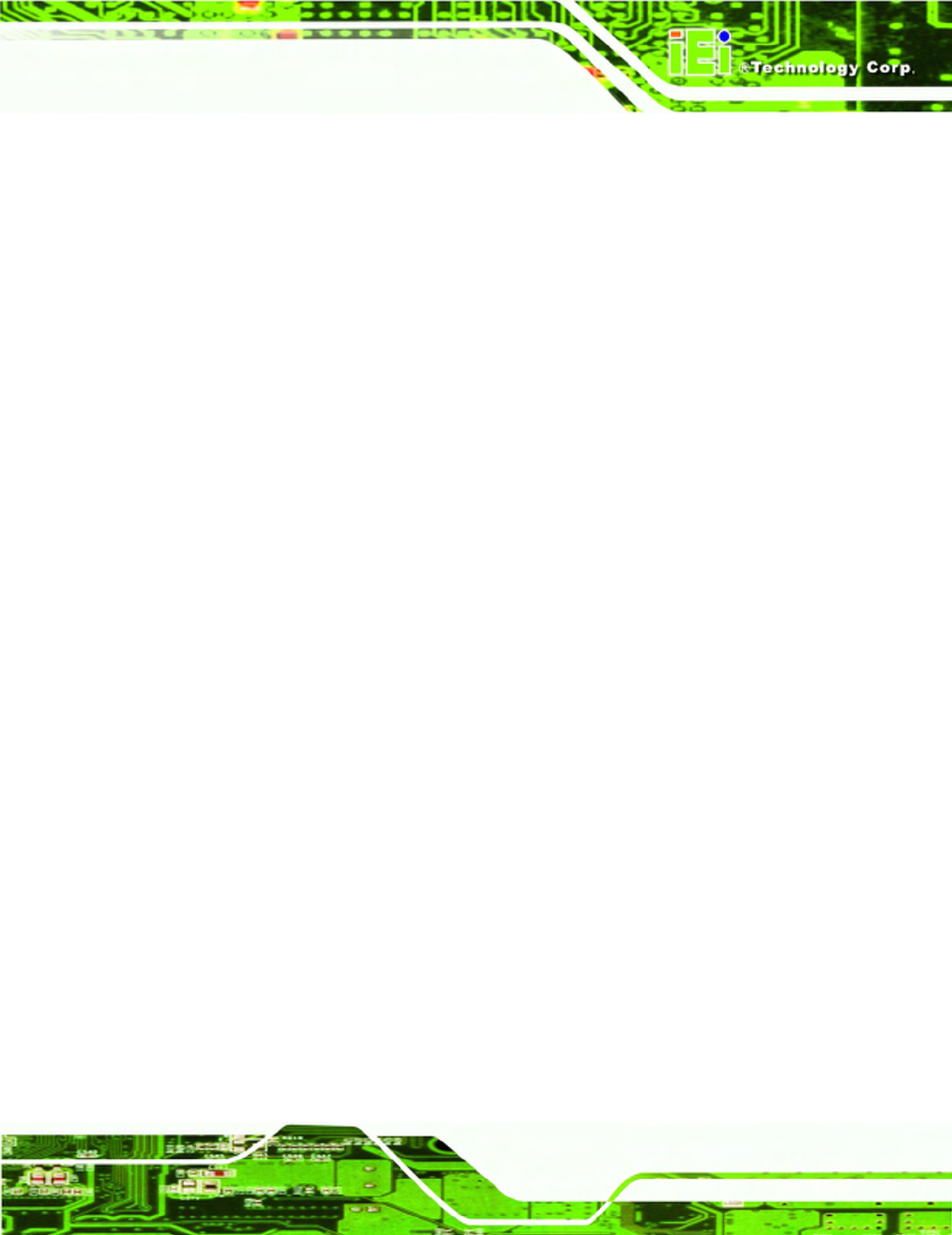
ICEFIRE-T10A Mobile Clinic Assistant
Page 125
LCD Liquid crystal display (LCD) is a flat, low-power display device that
consists of two polarizing plates with a liquid crystal panel in between.
LVDS Low-voltage differential signaling (LVDS) is a dual-wire, high-speed
differential electrical signaling system commonly used to connect LCD
displays to a computer.
POST The Power-on Self Test (POST) is the pre-boot actions the system
performs when the system is turned-on.
RAM Random Access Memory (RAM) is volatile memory that loses data when
power is lost. RAM has very fast data transfer rates compared to other
storage like hard drives.
SATA Serial ATA (SATA) is a serial communications bus designed for data
transfers between storage devices and the computer chipsets. The SATA
bus has transfer speeds up to 1.5 Gbps and the SATA II bus has data
transfer speeds of up to 3.0 Gbps.
S.M.A.R.T Self Monitoring Analysis and Reporting Technology (S.M.A.R.T) refers to
automatic status checking technology implemented on hard disk drives.
UART Universal Asynchronous Receiver-transmitter (UART) is responsible for
asynchronous communications on the system and manages the system’s
serial communication (COM) ports.
UHCI The Universal Host Controller Interface (UHCI) specification is a
register-level interface description for USB 1.1 Host Controllers.
USB The Universal Serial Bus (USB) is an external bus standard for
interfacing devices. USB 1.1 supports 12Mbps data transfer rates and
USB 2.0 supports 480Mbps data transfer rates.
VGA The Video Graphics Array (VGA) is a graphics display system developed
by IBM.
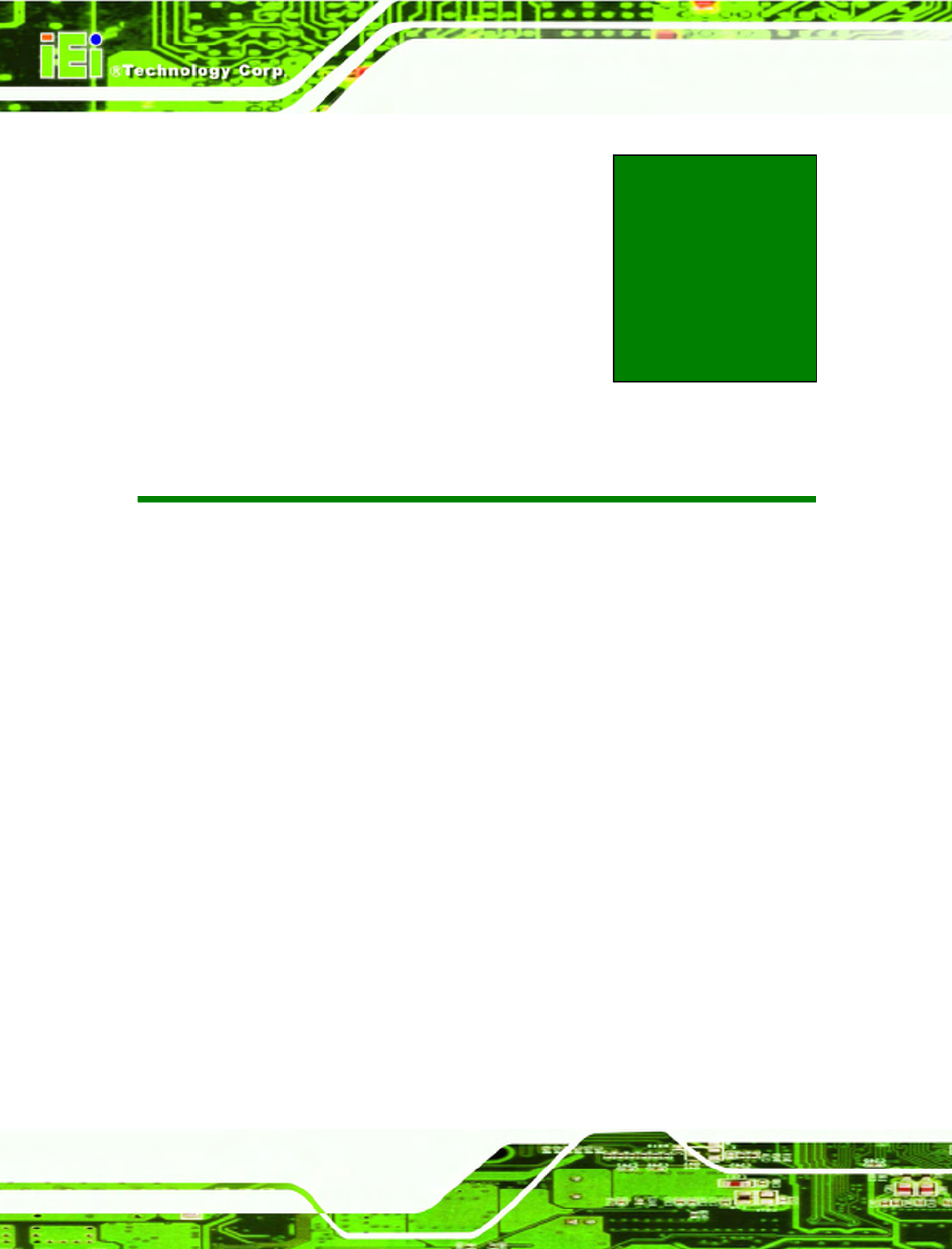
ICEFIRE-T10A Mobile Clinic Assistant
Page 126
Appendix
E
E Watchdog Timer
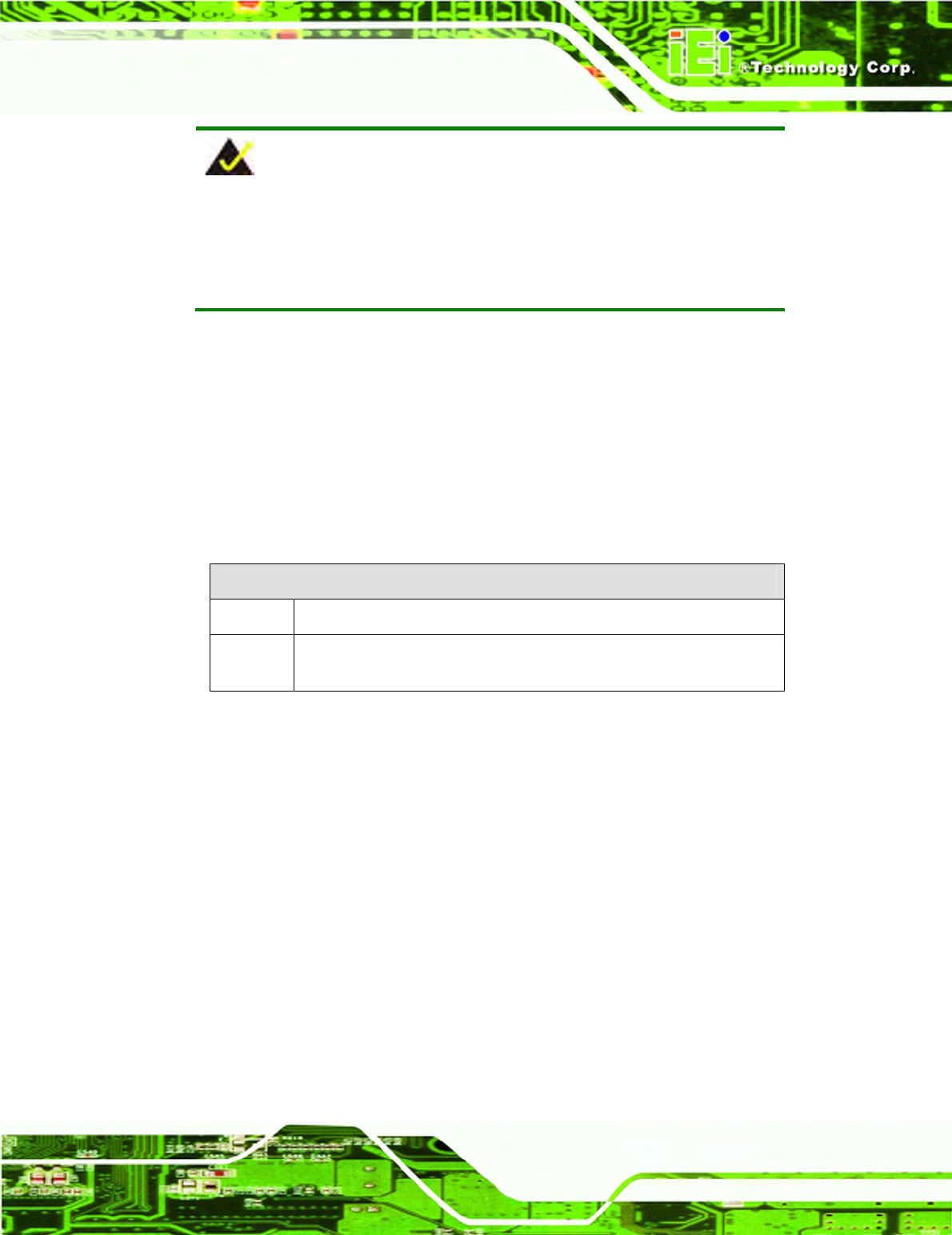
ICEFIRE-T10A Mobile Clinic Assistant
Page 127
NOTE:
The following discussion applies to DOS environment. IEI support is
contacted or the IEI website visited for specific drivers for more
sophisticated operating systems, e.g., Windows and Linux.
The Watchdog Timer is provided to ensure that standalone systems can always recover
from catastrophic conditions that cause the CPU to crash. This condition may have
occurred by external EMIs or a software bug. When the CPU stops working correctly,
Watchdog Timer either performs a hardware reset (cold boot) or a Non-Maskable Interrupt
(NMI) to bring the system back to a known state.
A BIOS function call (INT 15H) is used to control the Watchdog Timer.
INT 15H:
AH – 6FH Sub-function:
AL – 2: Sets the Watchdog Timer’s period.
BL: Time-out value (Its unit-second is dependent on the item “Watchdog
Timer unit select” in CMOS setup).
Table E-1: AH-6FH Sub-function
Call sub-function 2 to set the time-out period of Watchdog Timer first. If the time-out value
is not zero, the Watchdog Timer starts counting down. When the timer value reaches zero,
the system resets. To ensure that this reset condition does not occur, calling sub-function
2 must periodically refresh the Watchdog Timer. However, the watchdog timer is disabled
if the time-out value is set to zero.
A tolerance of at least 10% must be maintained to avoid unknown routines within the
operating system (DOS), such as disk I/O that can be very time-consuming.
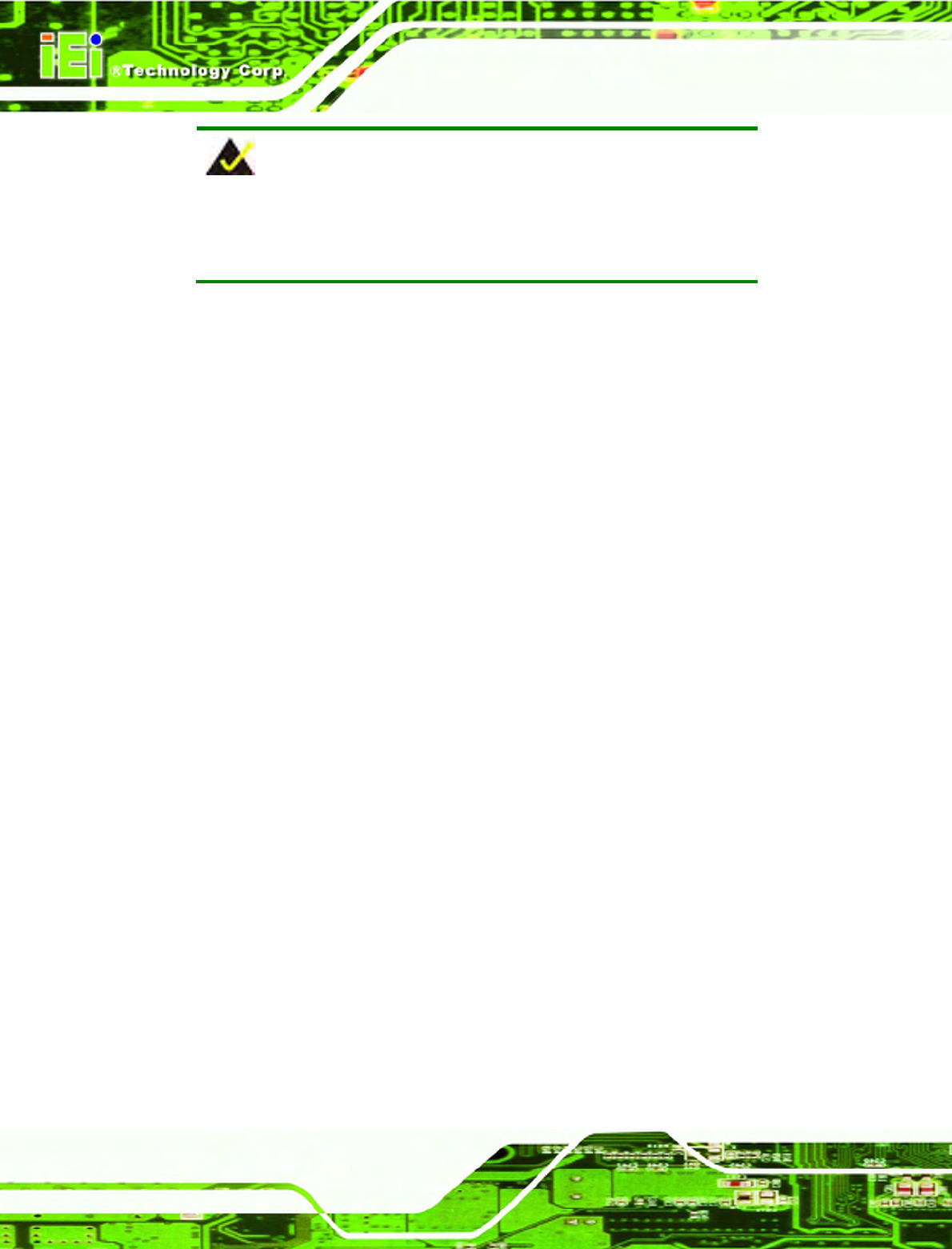
ICEFIRE-T10A Mobile Clinic Assistant
Page 128
NOTE:
When exiting a program it is necessary to disable the Watchdog Timer,
otherwise the system resets.
Example program:
; INITIAL TIMER PERIOD COUNTER
;
W_LOOP:
MOV AX, 6F02H ;setting the time-out value
MOV BL, 30 ;time-out value is 48 seconds
INT 15H
;
; ADD THE APPLICATION PROGRAM HERE
;
CMP EXIT_AP, 1 ;is the application over?
JNE W_LOOP ;No, restart the application
MOV AX, 6F02H ;disable Watchdog Timer
MOV BL, 0 ;
INT 15H
;
; EXIT ;
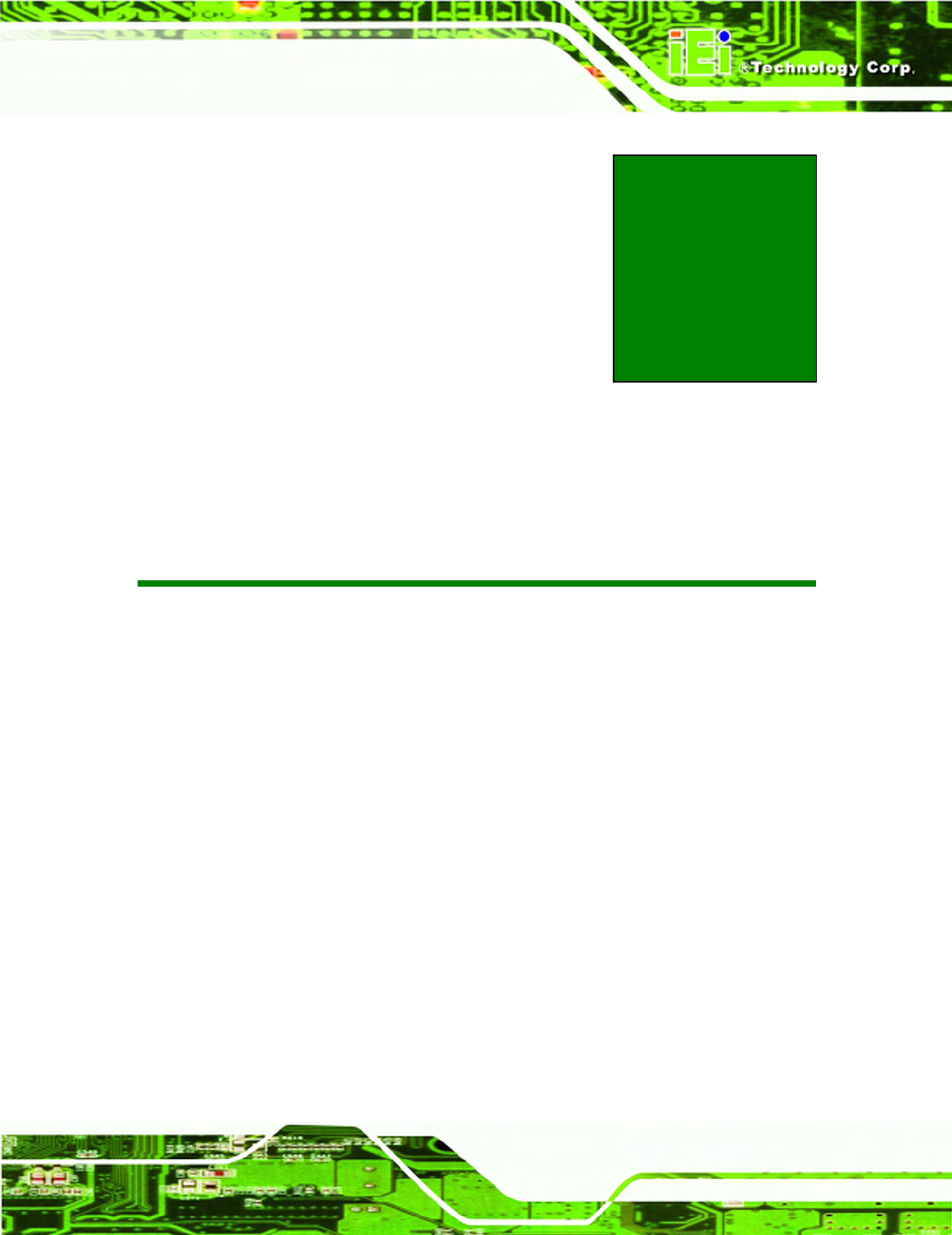
ICEFIRE-T10A Mobile Clinic Assistant
Page 129
Appendix
F
F Hazardous Materials
Disclosure
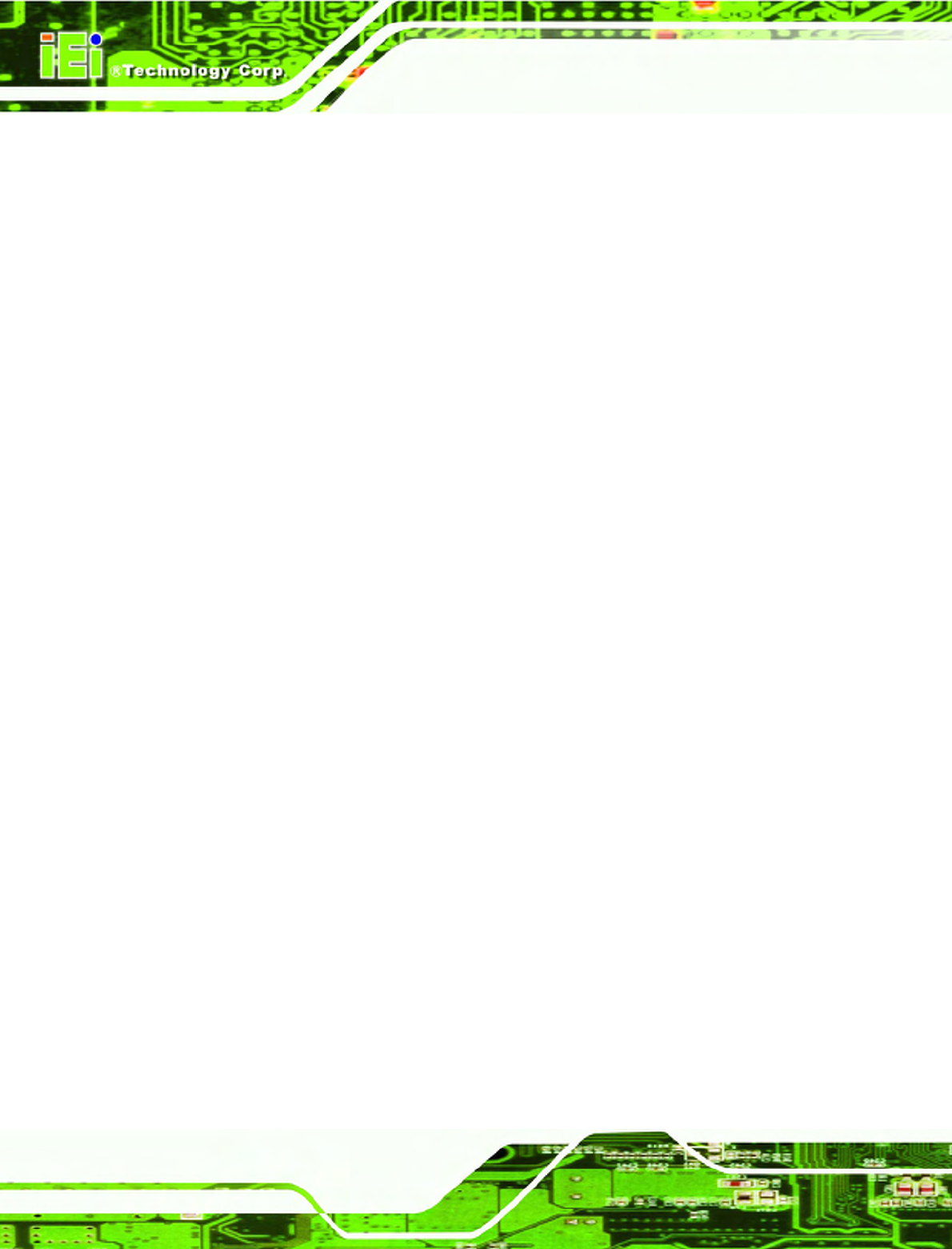
ICEFIRE-T10A Mobile Clinic Assistant
Page 130
F.1 Hazardous Materials Disclosure Table for IPB Products
Certified as RoHS Compliant Under 2002/95/EC Without
Mercury
The details provided in this appendix are to ensure that the product is compliant with the
Peoples Republic of China (China) RoHS standards. The table below acknowledges the
presences of small quantities of certain materials in the product, and is applicable to China
RoHS only.
A label will be placed on each product to indicate the estimated “Environmentally Friendly
Use Period” (EFUP). This is an estimate of the number of years that these substances
would “not leak out or undergo abrupt change.” This product may contain replaceable
sub-assemblies/components which have a shorter EFUP such as batteries and lamps.
These components will be separately marked.
Please refer to the table on the next page.
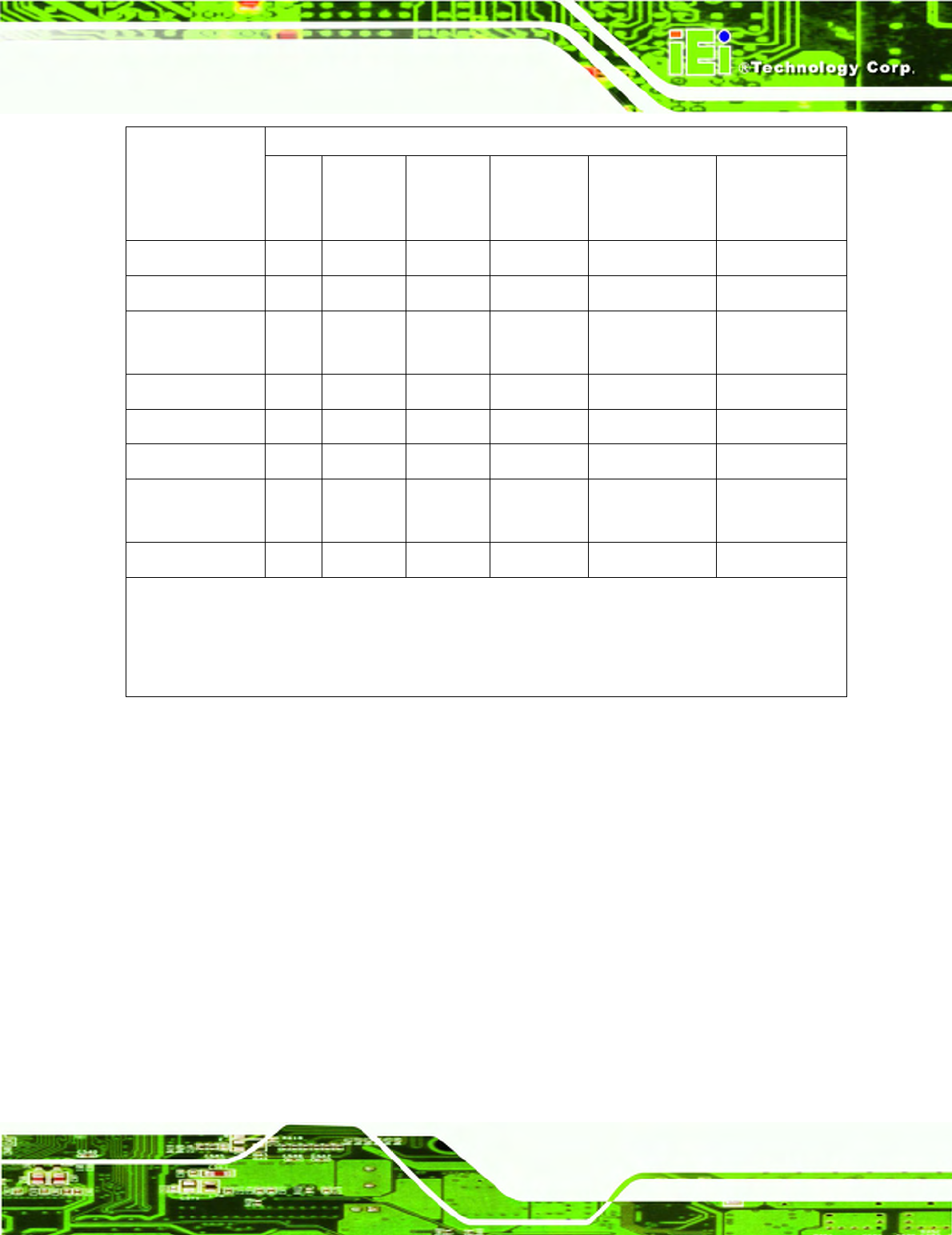
ICEFIRE-T10A Mobile Clinic Assistant
Page 131
Part Name Toxic or Hazardous Substances and Elements
Lead
(Pb)
Mercury
(Hg)
Cadmium
(Cd)
Hexavalent
Chromium
(CR(VI))
Polybrominated
Biphenyls
(PBB)
Polybrominated
Diphenyl Ethers
(PBDE)
Housing X O O O O X
Display X O O O O X
Printed Circuit
Board
X O O O O X
Metal Fasteners X O O O O O
Cable Assembly X O O O O X
Fan Assembly X O O O O X
Power Supply
Assemblies
X O O O O X
Battery O O O O O O
O: This toxic or hazardous substance is contained in all of the homogeneous materials for the part is
below the limit requirement in SJ/T11363-2006
X: This toxic or hazardous substance is contained in at least one of the homogeneous materials for
this part is above the limit requirement in SJ/T11363-2006
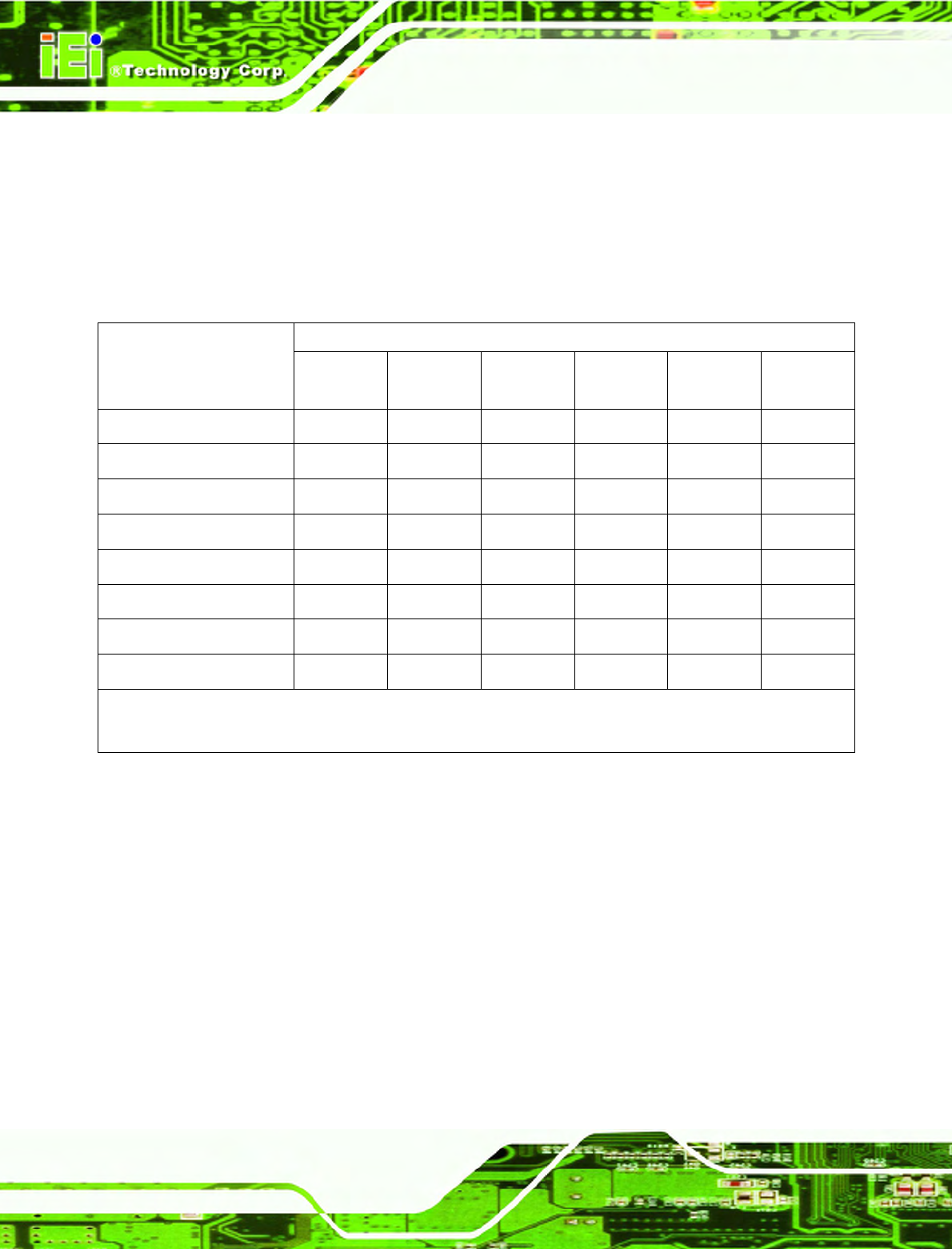
ICEFIRE-T10A Mobile Clinic Assistant
Page 132
此附件旨在确保本产品符合中国 RoHS 标准。以下表格标示此产品中某有毒物质的含量符
合中国 RoHS 标准规定的限量要求。
本产品上会附有”环境友好使用期限”的标签,此期限是估算这些物质”不会有泄漏或突变”的
年限。本产品可能包含有较短的环境友好使用期限的可替换元件,像是电池或灯管,这些元
件将会单独标示出来。
部件名称 有毒有害物质或元素
铅
(Pb)
汞
(Hg)
镉
(Cd)
六价铬
(CR(VI))
多溴联苯
(PBB)
多溴二苯醚
(PBDE)
壳体 X O O O O X
显示 X O O O O X
印刷电路板 X O O O O X
金属螺帽 X O O O O O
电缆组装 X O O O O X
风扇组装 X O O O O X
电力供应组装 X O O O O X
电池 O O O O O O
O: 表示该有毒有害物质在该部件所有物质材料中的含量均在 SJ/T11363-2006 标准规定的限量要求以下。
X: 表示该有毒有害物质至少在该部件的某一均质材料中的含量超出 SJ/T11363-2006 标准规定的限量要求。
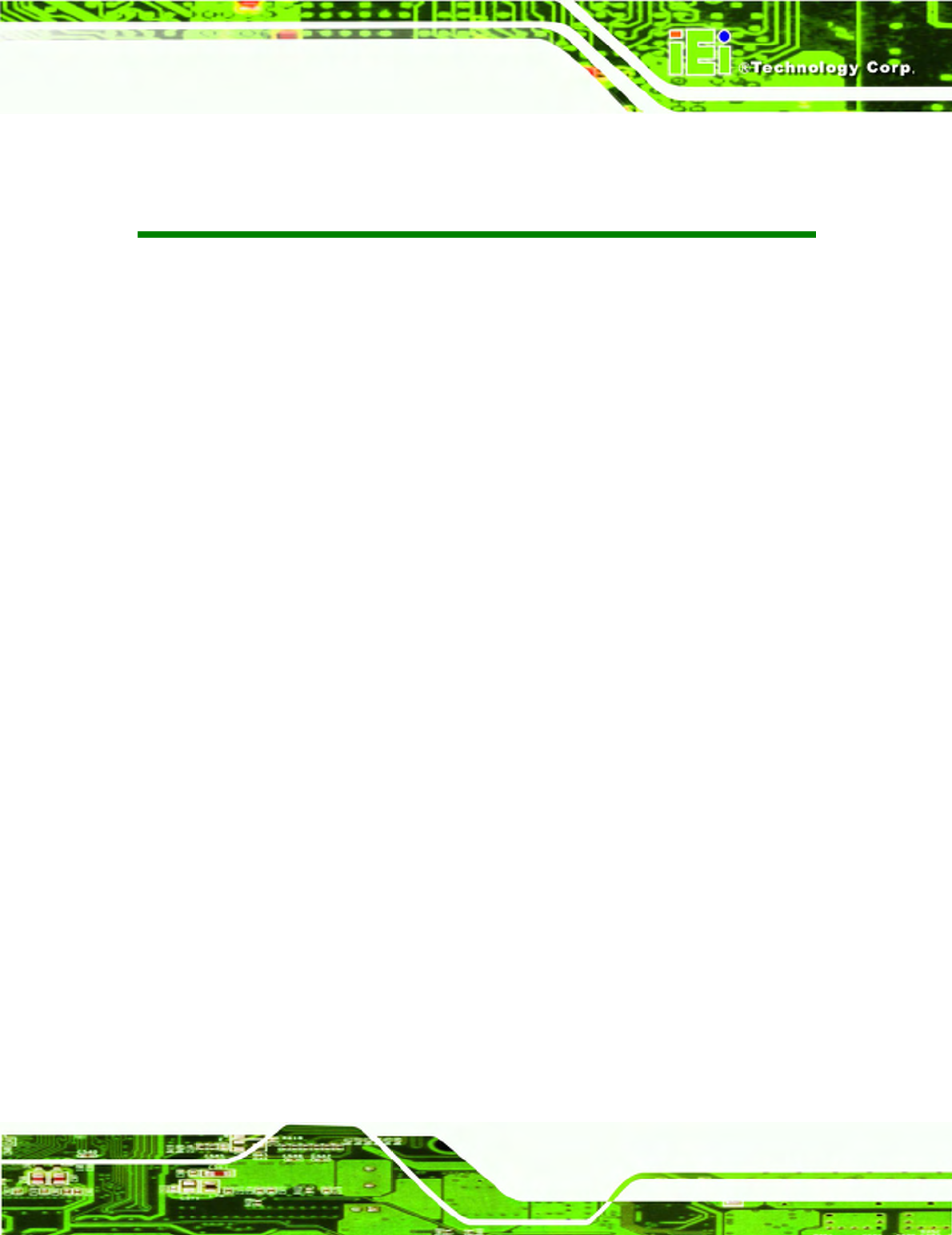
ICEFIRE-T10A Mobile Clinic Assistant
Page 133
Statement
This device complies with Part 15 of the FCC Rules. Operation is subject to the
following two conditions: (1) This device may not cause harmful interference, and
(2) this device must accept any interference received, including interference that
may cause undesired operation.
This equipment has been tested and found to comply with the limits for a Class B
digital device, pursuant to Part 15 of the FCC Rules. These limits are designed
to provide reasonable protection against harmful interference in a residential
installation. This equipment generates, uses and can radiate radio frequency
energy and, if not installed and used in accordance with the instructions, may
cause harmful interference to radio communications. However, there is no
guarantee that interference will not occur in a particular installation. If this
equipment does cause harmful interference to radio or television reception, which
can be determined by turning the equipment off and on, the user is encouraged to
try to correct the interference by one of the following measures:
- Reorient or relocate the receiving antenna.
- Increase the separation between the equipment and receiver.
- Connect the equipment into an outlet on a circuit different from that
to which the receiver is connected.
- Consult the dealer or an experienced radio/TV technician for help.
FCC Caution: Any changes or modifications not expressly approved by the party
responsible for compliance could void the user's authority to operate this
equipment.
This transmitter must not be co-located or operating in conjunction with any other
antenna or transmitter.
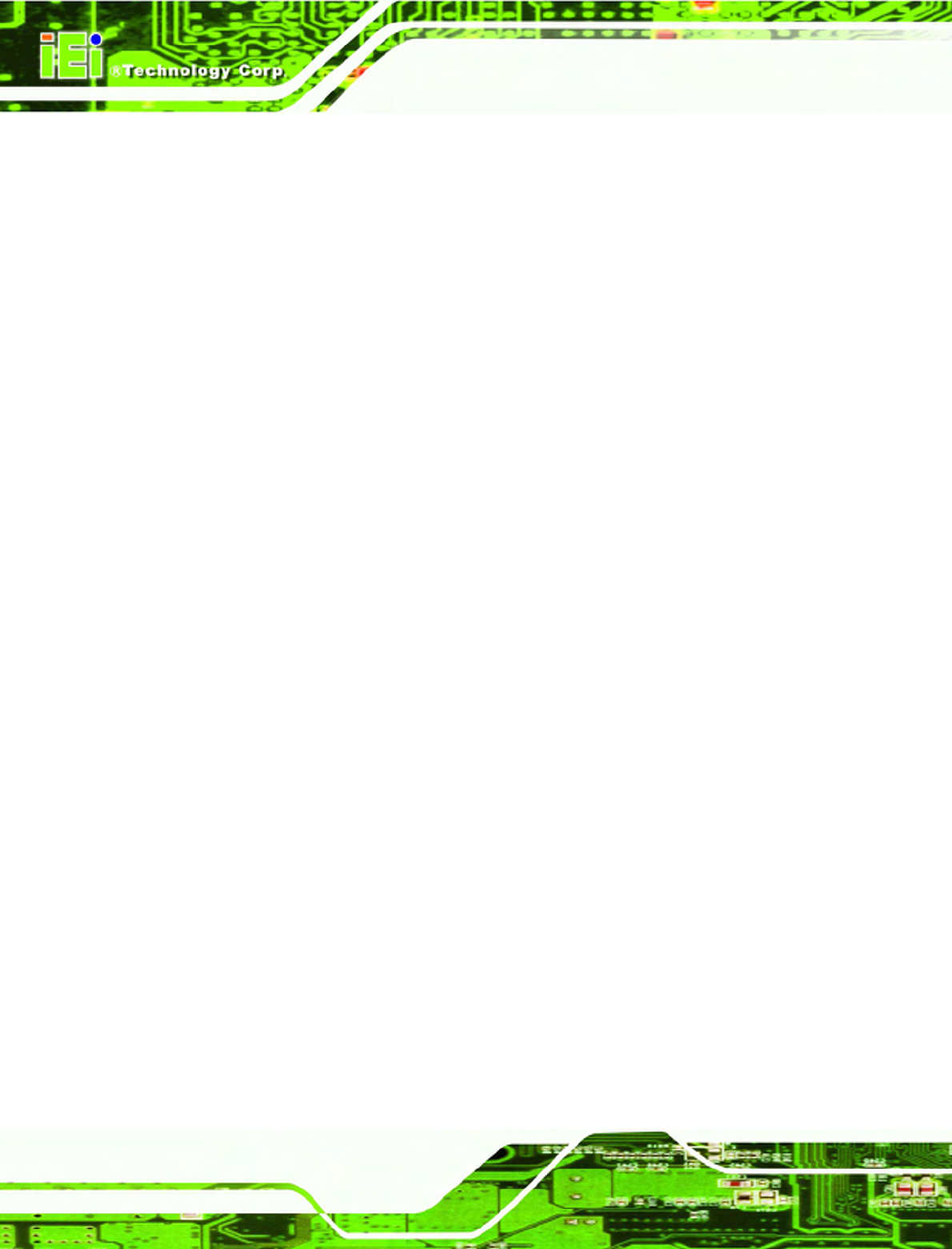
ICEFIRE-T10A Mobile Clinic Assistant
Page 134
Operations in the 5.15-5.25GHz band are restricted to indoor usage only.
Radiation Exposure Statement:
The product comply with the FCC portable RF exposure limit set forth for an
uncontrolled environment and are safe for intended operation as described in this
manual. The further RF exposure reduction can be achieved if the product can be
kept as far as possible from the user body or set the device to lower output power
if such function is available.
Note: The country code selection is for non-US model only and is not available to
all US model. Per FCC regulation, all WiFi product marketed in US must fixed to
US operation channels only.